

Road tripping through Europe with a campervan in 2024 (Itinerary)
With another eventful year behind us, where our trips were less wild and our adventures less spontaneous than they used to be. A year where we were constantly inspired by the beautiful pictures and crazy videos that our social media algorithms presented us.
Since we knew the roads would be calmer in November so we decided to follow our ‘Saved Instagram pictures’ and enjoy a wonderful autumn trip through Europe.
Our bucket list took us from the outskirts of Brussels to gorgeous medieval German castles, from the astonishing Dolomites to the picturesque Venice, and finally from fashionable Milan to the peaceful Strasbourg – How is that for an adventure?
In this itinerary, we’ve listed all the info you’ll need for a road trip through Europe with a campervan; what items to pack, how to rent a campervan, itinerary ideas, and finally: some tips for a fantastic adventure on the road.
Page Contents
Our road trip summarized in numbers.
- 1x stuck in the Italian snow
- Crossed 7 country borders
- 0 Speeding tickets
- … a thousand new adventures and stories to tell about
The roadtrip
After an earlier adventure in which we discovered the Dolomites with a campervan , we immediately knew that we wanted to travel the same way; through Europe with a campervan!
As we see it, this is the easiest solution to travel through various countries while still complying with all the COVID measurements and having a minimal risk for infection; we’d stay in our own bubble while still having all the comfort we needed: large beds, a small kitchen, and even a shower!
Our goal would be to drive from Brussels to Venice and back while discovering the most fabulous places we could find; after all, we had an immense amount of inspiration and a huge bucket list of places to visit.
Essentials for a road trip in a campervan
Are you planning to go on a campervan road trip, but want to make sure you have the essentials with you? We briefly listed the essentials that made sure our trip was a success.
Ecoflow River Pro Powerstation
As content creators, we’re always haunted by our fear of not having enough power, from the fear of being stranded in the middle of nowhere without a GPS to the fear of having a dying camera battery just when you’re about to shoot your favorite location.
Either way: We’ve all been there, so we all know these are valid worries! No wonder why one of Google’s top road trip-related searches is about finding or generating power. While there are various solutions, we found one that put our minds at ease before starting our road trip; The Ecoflow River Pro Powerstation !
In essence, the Ecoflow River Pro is a massive power bank with 2 AC power outlets and a few USB connections, generating enough power to charge our Macbook M1 Pro laptop 13 times, our smartphone 58 times, and our Sony A7III camera over 30 times. Due to its dimensions, the River Pro can usually last 8 hours, being a massive help for every road trip.
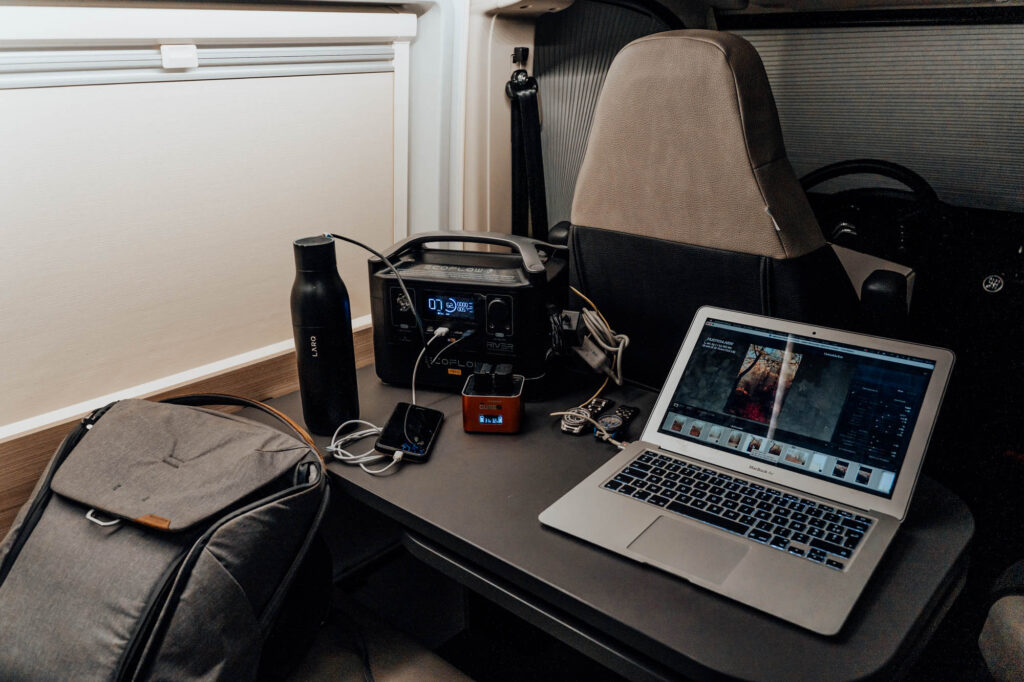
When you’re planning to cross various borders or wander around mountain passes, you’ll have to switch radio stations regularly, or you’ll end up with noise. Our trick? Make sure everyone has made their own Spotify playlist in advance! That way, you won’t be bothered by the noise and leave room for spontaneous singalong moments to occur.
Data Roaming
If you are located in Europe and are traveling through various countries, you’ll need to ensure that your data roaming is enabled on your phone to keep having an internet connection.
You shouldn’t worry about the amount of roaming you use, thanks to the European Union’s roaming regulations which say data providers can’t charge for roaming in the European Union. However, keep in mind: Switzerland is not included in this regulation! So don’t forget to turn off your Data Roaming when entering Switzerland.
What have we learned about road tripping through Europe with a campervan?
Our campervan trip through Europe confirmed something we already knew: that it’s very easy to travel between European countries. A 100 kilometers drive can bring you to a different cultural and diverse community.
Next to this, we had a few other learnings as well.
The ease of a camping site with decent facilities
While traveling in a sustainable campervan, you’ve got different options in terms of camping:
- You could visit an official campsite which has loads of facilities.
- You could park overnight at Highway stops.
- You could wild camp and stay at a new place every night.
Most European countries have different rules and regulations about camping, but generally, they (Switzerland, Italy,…) aren’t allowing wild camping … which makes it technically illegal. However, in most cases, overnight parking where you don’t set up camp or leave in less than 24 hours is allowed.
Our tip? Make sure you can drive off at any moment so that nobody can complain about it.
The thing is: If you’re on the road for over a week, you’ll need to clean your campervan and want a more luxury shower. Don’t hesitate to stop wild camping and pause at a camping site with decent facilities.
The ease of planning
Being prepared for your campervan trip ensures that you can switch gears faster and need to spend less time worrying. The things that helped us a lot were:
- Backup locations. Since we used our itinerary as a guideline, we had the flexibility to skip specific locations because of bad weather. Having backup locations made it less of a hassle to find hidden gems.
- Ecoflow River Pro . We knew we would probably wild-camp a lot, which meant not having the power to charge our electronic devices (laptop, camera,…). Luckily our friends at Dutchtravelshop.nl hooked us up with this mobile power station, which we didn’t have to recharge one single time during our 8-day trip.
The costs Tolls and Vignettes
Something we have underestimated is the fact that most European countries have toll roads, which can make your trip very expensive very fast. Luckily, there are exceptions, such as Germany, Netherlands, and Belgium.
Some countries such as Austria and Switzerland are working with a vignette, which is a prepaid motorway toll in the form of a sticker you typically purchase from petrol stations before you cross the border and which you stick on your windscreen.
Alternatively, you can always avoid tolls by picking alternative routes on Google Maps or Waze, but these will guide you through the smaller roads, resulting in a slower and longer route.
Our tip? If you have the time, save your money and go for the slower, more scenic route. If you’re in a hurry or have a tight schedule: go via the tollways.
Our road trip Itinerary
Since the lockdown started, we’ve been saving Instagram pictures of destinations that inspired us and deserved a place on our bucket list. We’ve added them all to a Google Maps collection and started planning the regions we wanted to visit.
From there on, we casually decided that we wanted to visit the Dolomites, Venice, and Milan. Because the beauty of a road trip in a campervan is that you can make up your itinerary along the way: when you’re experiencing bad weather, you can just start a few 100 km’s and adjust your itinerary as you go.
Additionally, once your start to post Instagram stories or timeline pictures of your trip, people will automatically start to recommend locations that weren’t on your bucket list to start with!
Remember that our style is to have a flexible road trip itinerary and adjust our planning accordingly. As a result, we’ll need an internet connection during our trip, which can’t always be found when traveling to rural destinations like the dolomites.
DAY 1 – Getting started
Our first day was mainly focused on picking up our campervan, unpacking the bags, and learning how to drive the campervan properly. Ultimately we already wanted to drive to our first location so that we could start our hike early!
Pickup Campervan in Brussels
We started our trip by picking up the campervan in Brussels in the afternoon, where we finally met the owners of the campervan face-to-face, received an extensive explanation of how the campervan functions, and finally managed the paperwork (for example; noting down the milage of the car, check for damages, etc).
After unpacking our bags and filling the drawers, we started driving towards our adventure! We left Brussels around 3 pm and drove straight to our first stop in Rheinland-Pfalz. Just when we crossed the steep hills of Malmedy, darkness fell over the highway, and fog started to appear.
Since the darkness prevented us from sightseeing opportunities, we quickly arrived at our first stopover and sleeping place – the “Wanderparkplatz” in Nothweiler on the German-French border . This parking is located in the middle of the woods, which explains why we came across some wild boars on our way to the parking spot.
Wegelnburg – Wanderparkplatz Nothweiler
After (wild) parking at Wanderparkplatz Nothweiler, we looked up at the sky and noticed how beautiful the stars were in the sky. We decided to unpack our Nanlite Pavotube II’s light tubes and used them to illuminate the (unlit) hiking trail, looking for the perfect spot to stargaze.
We decided to follow the winding hiking trail that crosses the German-French border until we found an open spot, which we used to capture the stars.
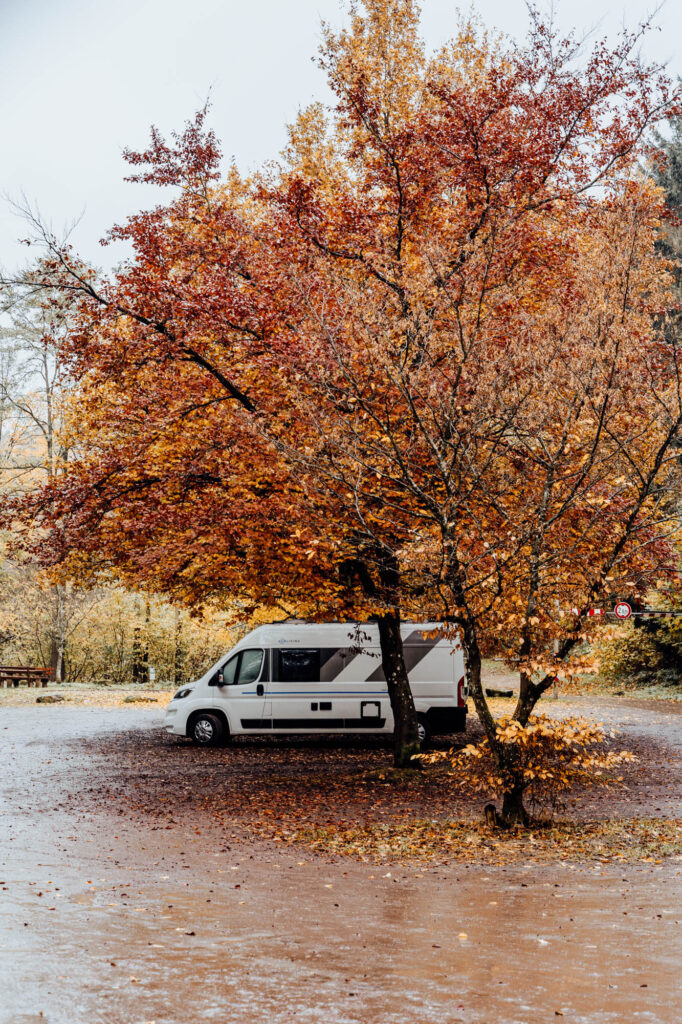
Day 2 – Chasing castles
We knew in advance that during our road trip to Venice, we had to pass through the German provinces of Rhineland-Palatinate and Baden-Württemberg. Both regions are known for their medieval castles, of which most have a panoramic view.
Our goal was to visit the most impressive castles on our route to Venice.
Wegelnburg, Germany
Wegelnburg , a ruined castle located in a forest on the French-German border, is best known for its panoramic view and incredible sunrise.
We wanted to witness that specific 7 am sunrise, so to observe this, we had to start our hike at 6 am, where we followed the zigzagging hiking trail to the Wegelnburg. This took us 5 kilometers, regularly crosses the German-France border, and passes by several other ruins on its way. The hike was covered in darkness since the sun was still about to set, making it an authentic experience. However: seeing the sunbeams roll over the mountains with such a fantastic panoramic view was just … unreal.
Be aware tho: the entrance of Wegelnburg is surrounded by fencing, so at first, we thought it was closed to visitors, but nothing could be further from the truth!
We found a shorter hiking trail on our way back, which brought us directly to the village, only 200 meters walk to the Wanderparkplatz Nothweiler.
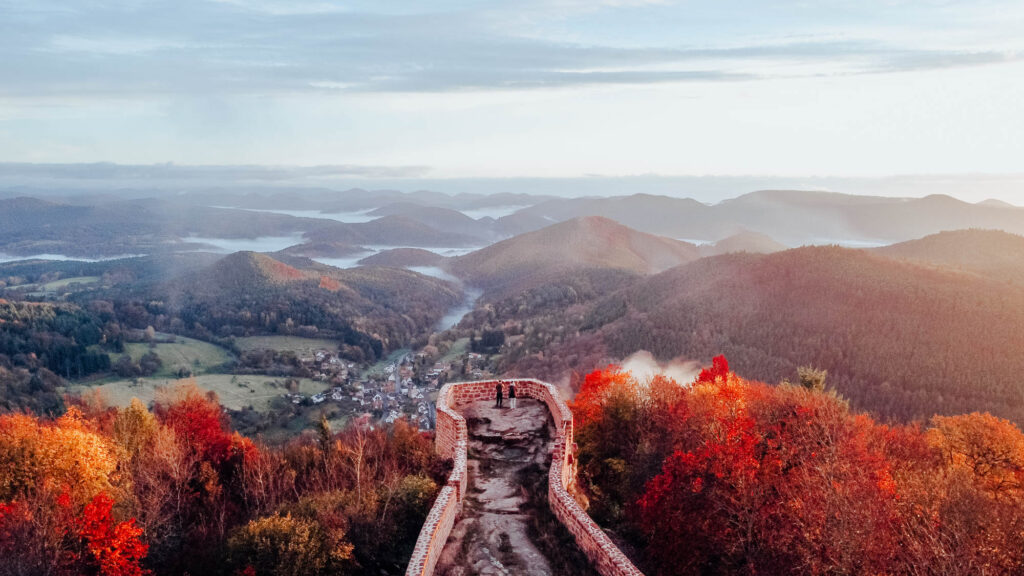
Schloss Lichtenstein, Germany
To make our route to Venice even more interesting, we aimed to visit interesting stopovers every 2 to 3 hours (+- 200 to 300 km). In this instance, we drove towards Schloss Lichtenstein : a 12th-century fortress built on top of an 800-meter high cliff.
We noticed that the castle was managed from a commercial point of view, where everything involved a cost: parking, entering the courtyard, etc.
Nevertheless, the panoramic view over the valley and the fantastic color palette of the surrounding trees, hills, and valley made it worthwhile. It also struck us how beautifully everything had been restored and how detailed they had for their sculptures.
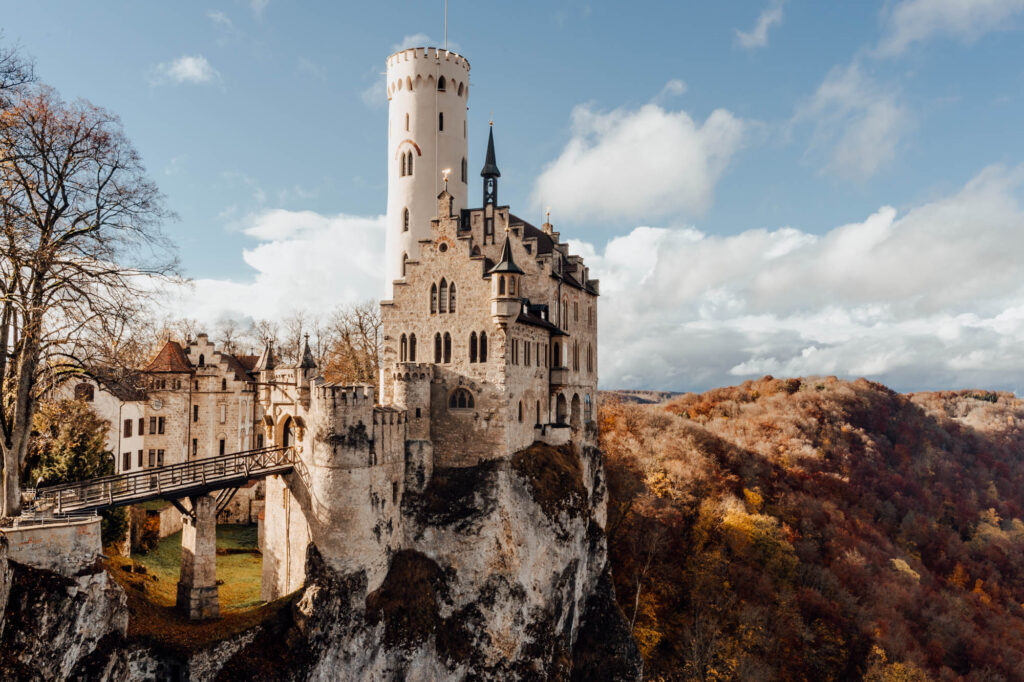
Hohenzollern Castle, Germany
Located less than 40 kilometers from Schloss Lichtenstein, you can find Germany’s most visited castle: Hohenzollern Castle! The castle has been known as “The Crown of all Castles” ever since 1267. Reason enough for us to visit it and admire it with our own eyes!
Our tight itinerary wouldn’t allow us to stop by the Hohenzollern Castle for an extended visit, so we decided to admire the castle from Zeller Horn’s legendary viewpoint ; It’s the mountain range located about 1.5 kilometers away, at the same height as the fortress. As a result, you have the best view of the castle and the surrounding area.
We have to be honest tho: it took us a while to find the exact location of the Zeller Horn viewpoint, but once we found it … we loved it! You can judge for yourself …

Plansee, Austria
While we had already discovered some of the most amazing places, we decided to push our luck: our goal was to visit Plansee lake, located just beyond the Austrian border, and search for its very instagrammable viewpoint that looks down over the lake.
Unfortunately, a combination of traffic jams and mandatory stops (buying our Highway Vignette to enter Austria) caused us to arrive just after sunset. We learned during our road trip through the mountains that as soon as the sun has set, it’ll be pitch dark in a matter of minutes. The same goes for our visit to the Plansee lake: as soon as we crossed the bridge, we couldn’t move without using our Nanlite lights.
After our short stop at the lake, we decided to continue our journey to a place to sleep for the night: the legendary Innsbruck city.
Innsbruck city
We’ve visited Innsbruck city numerous times, and we may even say that it’s our favorite city in Austria. This is because of its beautiful mountain background, architectural gems, alternative culture, and Innsbruck’s importance on the winter sports community.
Once we arrived, we decided to head downtown to reminisce memories from the past and see how the historic buildings (such as the Liberation Monument on Landhausplatz and the building with the golden roof) are lit up at night.
We decided to end our evening at the Hard Rock cafe to explore the same downtown area the next day after dawn before the shops opened.
Day 3 – Arriving in the Dolomites
During our previous road trip, we visited the Dolomites and missed out on a few of our bucket-list locations. Since the Dolomites were only a slight detour from our route to Venice, we decided to give some of these places a second chance … but not before we wandered around Innsbruck first!
Innsbruck, Austria
Imagine the feeling of waking up, opening the doors of your campervan, and looking out across the streets of Innsbruck with their impressive mountains as a backdrop. Well, that’s precisely how we woke up!
After a quick shower in our campervan, we decided to wander around the city again and rediscover the same historic buildings, but this time using daylight.
Another reason why we stayed in Innsbruck is that we’ve been following Holzkern Watches on Instagram for ages and noticed we could visit their shop in Innsbruck. We made an appointment, and were welcomed by their store manager Stefan who explained to us more about Holzkern’s philosophy and lifestyle, showed us how an automatic watch works and how to replace the chains of a wristband.
During our visit to the store, we fell for the charms of the La Concorde watch and the Intergalactic watch , which we took home as a reminder of our road trip.
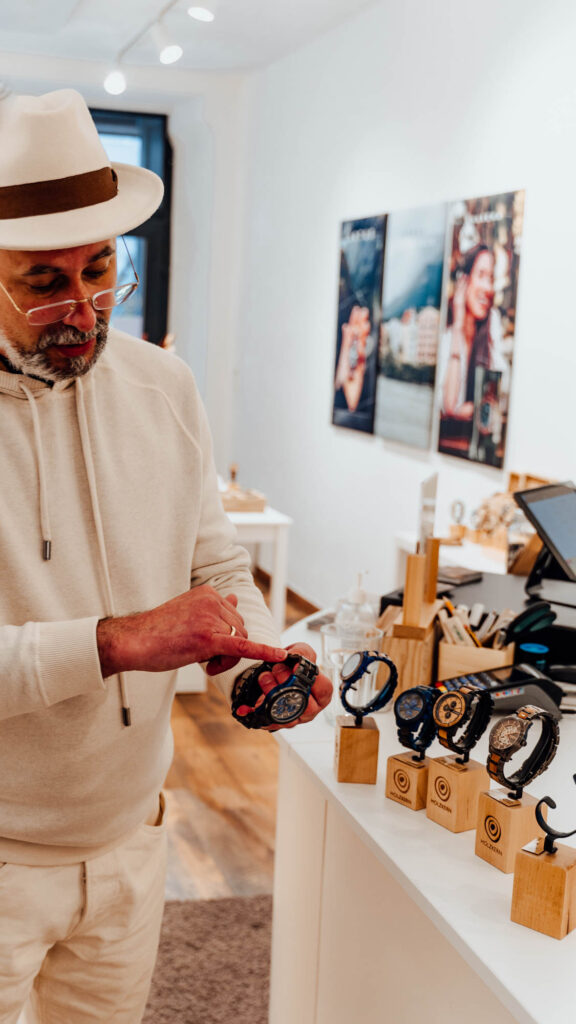
MMM Corones
Since we visited the Dolomites last year, the MMM Corones (being designed by Zaha Hadid) have been on the top of our bucket list. When we entered the region around the Dolomites, we noticed that the lakes weren’t frozen and the roads were not covered with snow … so our first reaction was to visit MMM Corones.
Unfortunately: the ski lifts were closed because the season hadn’t started yet, and the roads were now permanently closed and accompanied by prohibition signs. So one thing is sure: MMM Corones can only be visited in a dignified manner when the ski lifts are open.
With pain in our hearts, we had to make a cross over our visit from MMM Corones, but luckily there are plenty of other places to visit in the region … so we decided to drive to the legendary Lago di Braies .
Lago di Braies
Lago Di Braies – also known as Pragser Wildsee – is the biggest lake in the Dolomites and is known as the most beautiful lake of the Alps because it’s surrounded by beautiful pine forests, towering limestone peaks, and included a unique boathouse. As a result, most people know it as (“Lago di Instagram”).
The last time when we visited the lake, it was totally frozen and covered in snow. This setting certainly had its charm, but we also wanted to visit Lago di Braies before the snow fell. Unfortunately, there was so much fog that we still couldn’t admire the lake in its best condition. Next time!
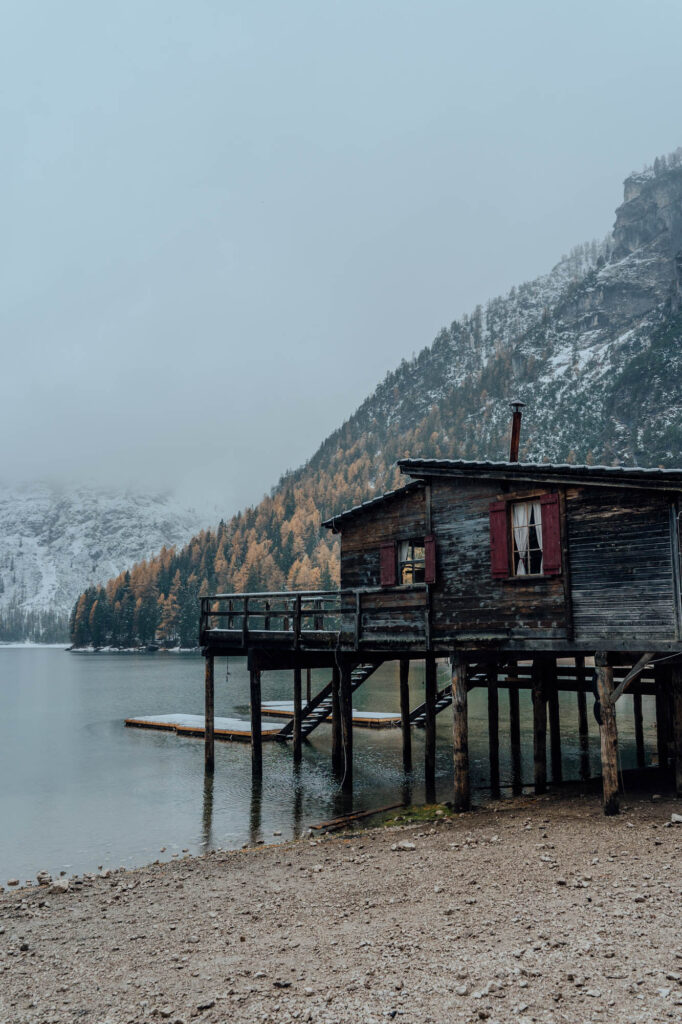
St. Johann church in Villnostal
Noticing that the sunset was approaching fast, we decided to revisit one of the most legendary sites in the Dolomites: St. Johann in Ranui Church in Val di Funes, Villnostal.
While driving over the winding roads, we noticed that the weather conditions would be utterly different from our previous visit: there wouldn’t be any snow, but the church and its surroundings were covered in fog.
Unfortunately, we didn’t notice too much of the sunset since the fog blocked all the sunbeams. By the time we left the church, it was already pitch dark.
Alpe di Siusi & Earth Pyramids Renon
We decided to drive up to Compatsch to experience the sunrise at Alpe di Siusi to save some time. Last time, we missed this view since it’s located in a nature resort and has a curfew for cars: no-one can drive by between 9 am and 5 pm.
This time, we could access the road to Compatsch, but while we were driving up the mountain, it started to snow, almost to the level of a snowstorm. When we arrived in Compatsch, our van got stuck, and a local farmer had to pull us out of the snow.
According to the local weather forecast, it would snow for the entire night, and we would miss the sunrise anyway since it would be covered in fog. In fear of getting stuck, we decided to go back down the mountain and skip our visits to both Alpe di Siusi and the Earth Pyramids of Renon.
We ended up spending the night at a truck stop next to the road.
Day 4 – The road to Venice
We knew it wouldn’t be the shortest route to Venice, but we decided to drive via Santuario Madonna Della Corona and Lake Garda since it captured our imagination.
Santuario Madonna Della Corona
What’s more astonishing than an ancient place of worship, located 800 meters into the side of a cliff? We wanted to experience it, so we drove towards Santuario Madonna Della Corona, only a 15 minutes drive from Lake Garda (the Italian part)!
We parked at Localita Santuario 1 in Spiazzi, on a parking lot that usually wouldn’t allow campervans and mobile homes, but we decided to risk it since it was empty. The reason for this might be the thick fog that stood over the mountain, on the fact that it’s not the most touristic period to visit Santuario Madonna Della Corona.
Although we could not fully admire the Santuario Madonna Della Corona due to the thick fog, the location continued to impress us. We also had the opportunity to check our fitness by climbing the steep stairs to access the sanctuary.
After arriving, we learned that this sanctuary is a place of pilgrimage that already existed before the year 1000! We’ve listed our findings in this specific destination article about Santuario Madonna Della Corona .
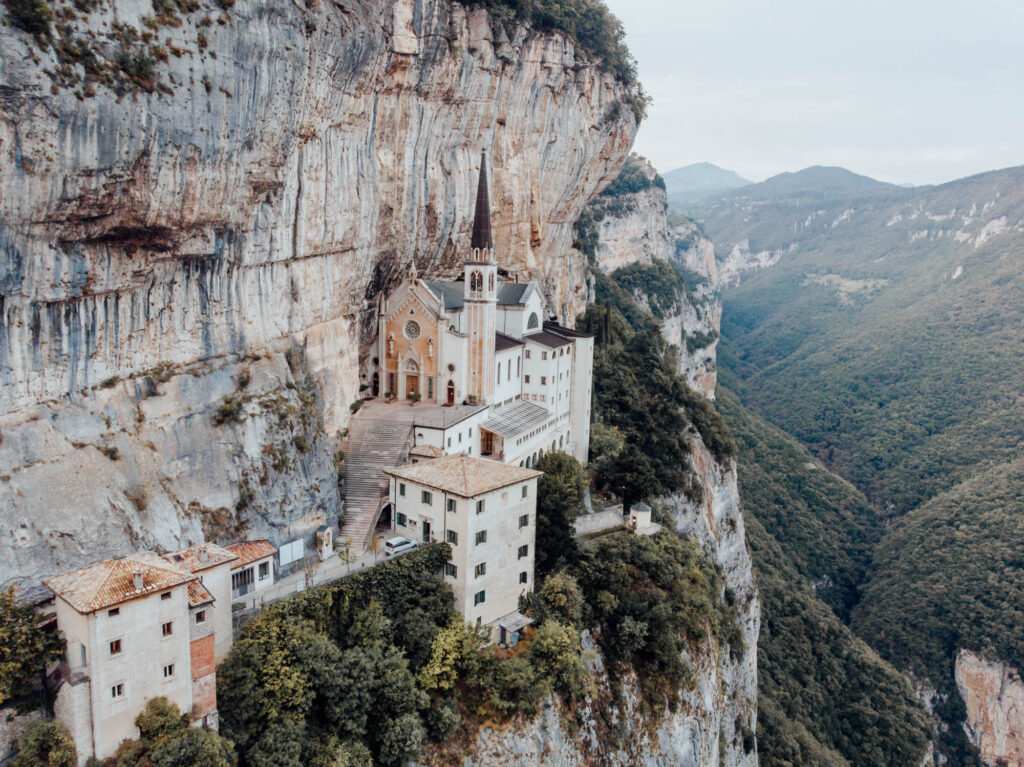
Lagi di Garda
In less than 24 hours, we went from a small snowstorm in the Dolomites to a 20-degree summer breeze at Lake Garda.
The small town was quite dead, considering the tourist season was already over here, so we just briefly wandered through the city. Our goal was to catch the sunset in Venice before 5 pm anyway, so we quickly left the lake.
Venice City
Where we spent the past few days in quiet or remote regions, with endless possibilities to park and wild camping … Venice would be a bit more crowded and strict. That’s why we decided to spend the night at the campsite of Venezia village, which had some fantastic facilities: decent showers, an elegant restaurant, and a clean swimming pool.
An additional advantage was that there is a bus stop in front of the campsite, with busses that go directly to Venice. The ride to the city takes no longer than fifteen minutes and drops you off at Piazzale Roma.
By 4 pm we arrived at the tourist center, where we were overwhelmed by history and architecture! Strolling with our camera in hand, we followed the small corridors of the city, arriving at a (relatively empty) San Marco square just after sunset.
Unfortunately, The darkness brought in some shady types, from aggressive salespeople who punched us on the shoulder to get our attention to pickpockets popping up from sketchy streets and following us until we noticed them. As a result, we decided to skip the rest of the city and return the following day.
Pro-tip; Gelateria il Doge’s ice creams are known as the best in the old town.
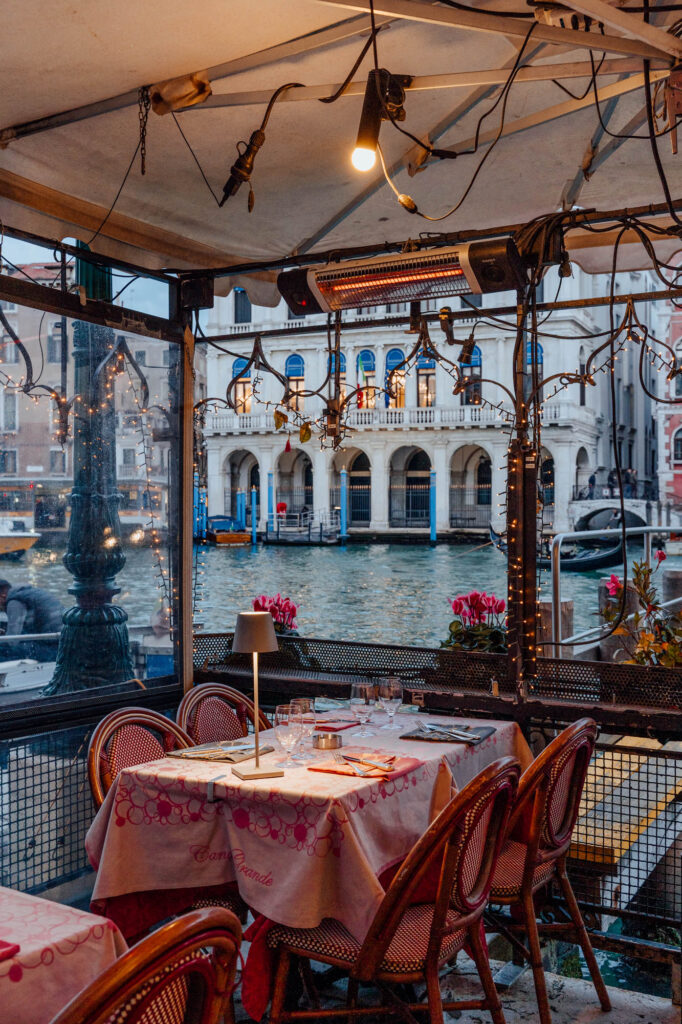
Day 5 – From Venice to Milan
By now, our road trip was already halfway through, so after enjoying Venice’s charms in the morning, we had to start on our way back. This time we chose to spend the night in the city of Milan since we wanted to discover some of their ancient buildings as well.
Be aware: Something we didn’t realize before going on this trip is how many toll stops you can find in Italy, especially between Venice and Milan.
Venice, the city of canals
Since we ended our wanderings around Venice early the night before, we decided to sleep in first… and then head back into the city!
This time we parked our campervan in Venezia Tronchetto Parking because we were only planning to stay in the city for a few hours. Ultimately, we stayed for 4 hours and realized that we had paid more for this parking spot (without any facilities except) than staying an extra night in the camping Venezia Village. Yikes!
Unlike the previous evening, where we walked to San Marco square via Basilica S.Maria Gloriosa dei Frari, we now had the time to take a different route: via Basilica di Santa Maria della Salute.
Milan and its impressive Duomo di Milano
Since we took our time to wander around Venice, we arrived in Milan during rush hour and had to endure several traffic jams before arriving in “Camping Village city of Milan.”
The campsite’s reception was already closed, but luckily google maps had a function that allowed us to know perfectly see what public transport connections would lead us to the Duomo di Milano. Our trip was a bit more delicate since we needed to transfer from the bus to the metro, in a place we had never visited before. Luckily we had google maps to fall back on.
Since this route to the center of Milan took almost an hour commute, we only found the time to discover the illuminated cathedral and the neighboring streets. To make it easy for us, we also made a quick McDonalds stop here.
Day 6 – From Milan to Strasbourg
We had less than two days to cover 1000 kilometers and go from Milan to Brussels. This gave us enough time to visit the center of Milan and then leave for Strasbourg in the afternoon.
Milan, Italy
Since Milan is such a beautiful city accompanied by ancient architecture, a sense of fashion, and art … we made a small “bucket list” of locations that we had to see during our visit to the city center.
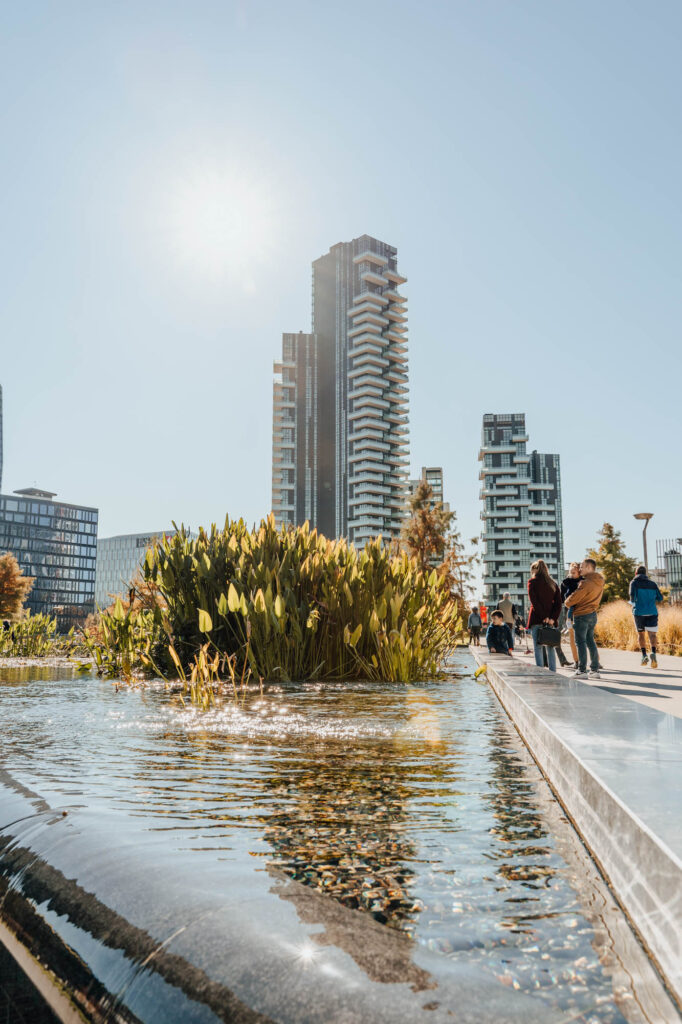
Castello Sforzesco
Castello Sforzesco – also known as Sforza Castle – is a fortress that was built during the 14th century.
Over the centuries, the fortification was destroyed in various wars, by the troops of Napoleon and during World War II. It was extensively rebuilt in 2005 and currently houses several of the city’s museums and art collections. That’s why it’s currently one of the most famous landmarks in Milan.
Arco della Pace
Arco della Pace is a huge triumphal arc located where the ancient Romans built their city gate. The gate is called “The Porta Sempione” and refers to the district it was located in.
While the origin of the arc can be found in 1807 when Napoleon was in command of the city, the construction of the “Arch of Peace” was paused when the city of Milan fell under the control of the Austrian Empire. The construction of the Arch was resumed in 1826 and was finally completed in 1838.
Bosco Verticale
The Bosco Verticale – or Vertical Forest – are two residential towers built in 2014 and are already known as the most iconic and most recognizable buildings of the last decade in Milan.
Pictures of the building often surface on Instagram and Pinterest, as it is iconic for its pioneering incorporation of a vertical forest.
Duomo di Milano
The Milan Cathedral, known as Duomo di Milano, is without any doubt the most known building in Milan.
It is logical too since they started the constructions in 1386 and only finished working on it more than six centuries later: in 1965! What’s even more impressive is the fact that the cathedral contains over 3400 different statues.
Strasbourg, France
As mentioned: Milan is still a 1000km drive from Brussels, so we had to keep going if we wanted to back on time! We decided to pass via Switzerland, which meant buying a new vignette when crossing the border and disabling our roaming data.
Once we arrived at Strasbourg, we parked at Parkplatz Friedhof since it was close to the city center, and parking on a Sunday would be free of any charge.
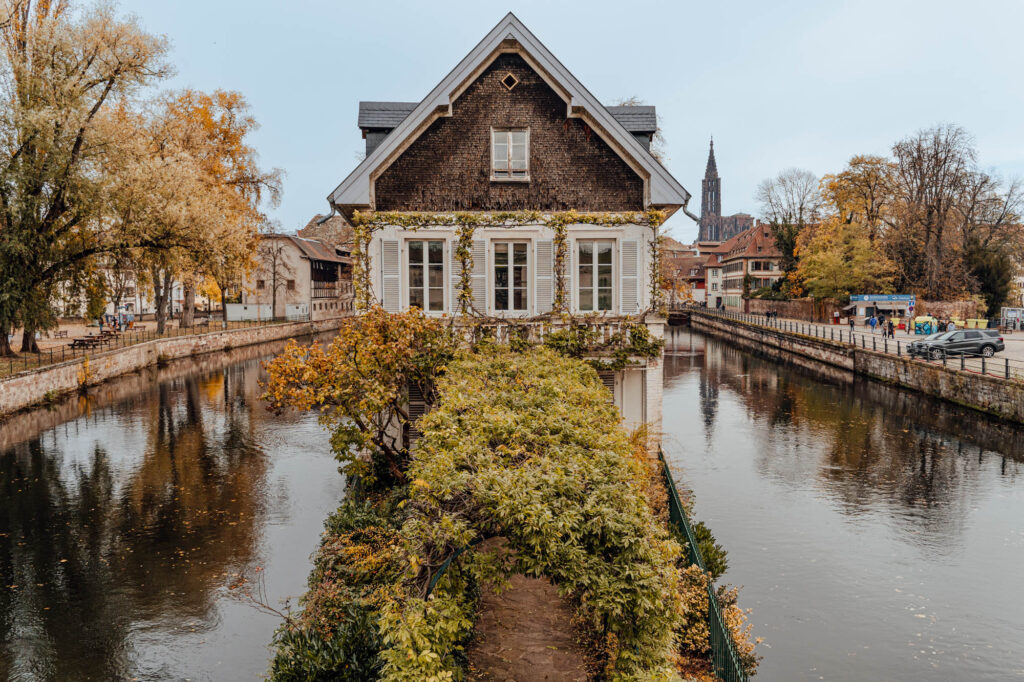
Day 7 – Back to Belgium
Every fairy tale comes to an end, and unfortunately, ours too. It was the last day where we were actually on the road; we wanted to enjoy it until the end. That is why we chose to discover Strasbourg in the morning and pass quickly via Veves Castle in the afternoon.
Being a university city on the border of France and Germany, Strassbourg is a very characteristic and cultural city, with enormous history. Proof of this is the street art that can be found all around the city or the ancient buildings scattered around the city (such as their cathedral).
We had some help from some locals; we were advised to discover the part of the city known as “Le Petit Paris.”
Vives Castle
What’s a better way to end our trip than to visit a 12th-century castle? We arrived rather last-minute: 10 minutes before the castle closed, so we didn’t have the chance get to explore it from the inside … but the sunset made up for it!
If you don’t know about Veves Castle yet, make sure to read the extensive guide we wrote, it contains the history of the castle, the legends around the castle and how to reach it.
A fascinating part about the castle is that the same family has owned it for the last 800 years, and that is classified as an exceptional heritage by the region of Wallonia. As a result, the castle is referred to as Sleeping Beauty’s castle.
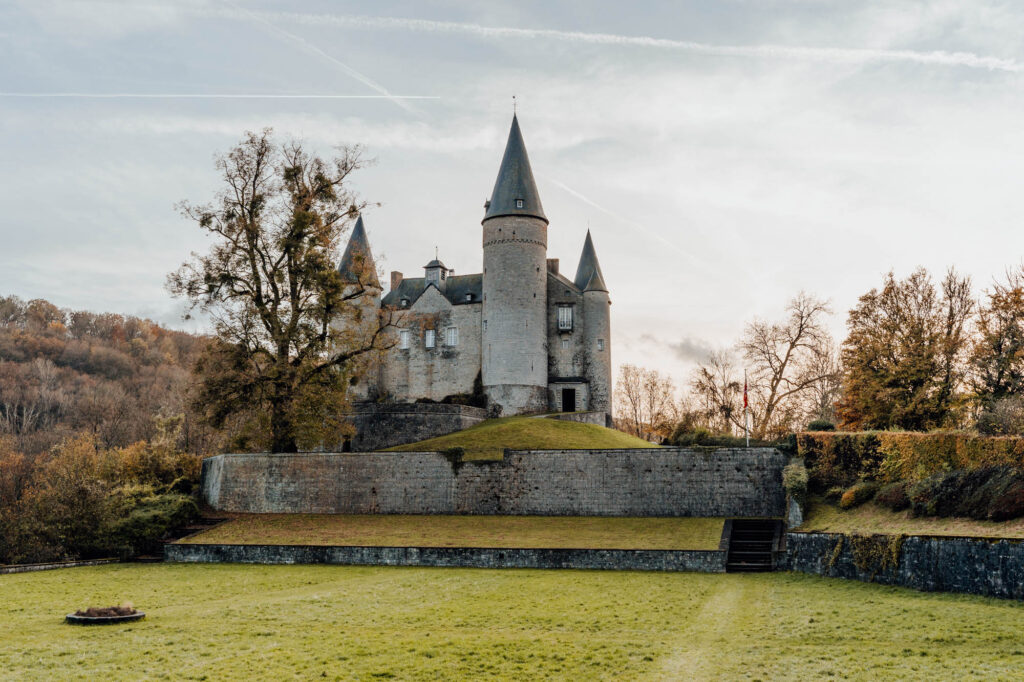
Day 8 – returning the campervan
Our last day was mainly focused on bringing back the campervan, where we had to pack our bags, clean the campervan in a self carwash, and ultimately fill in the paperwork again ( check for damages, note the number of kilometers we’ve driven,…).
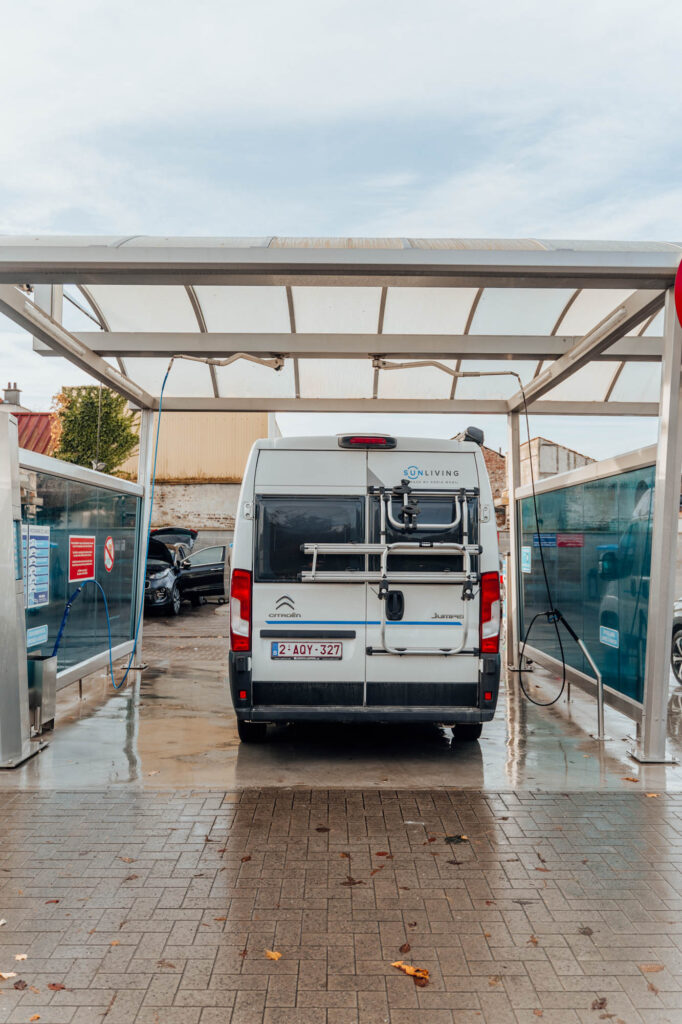
Save to Pinterest
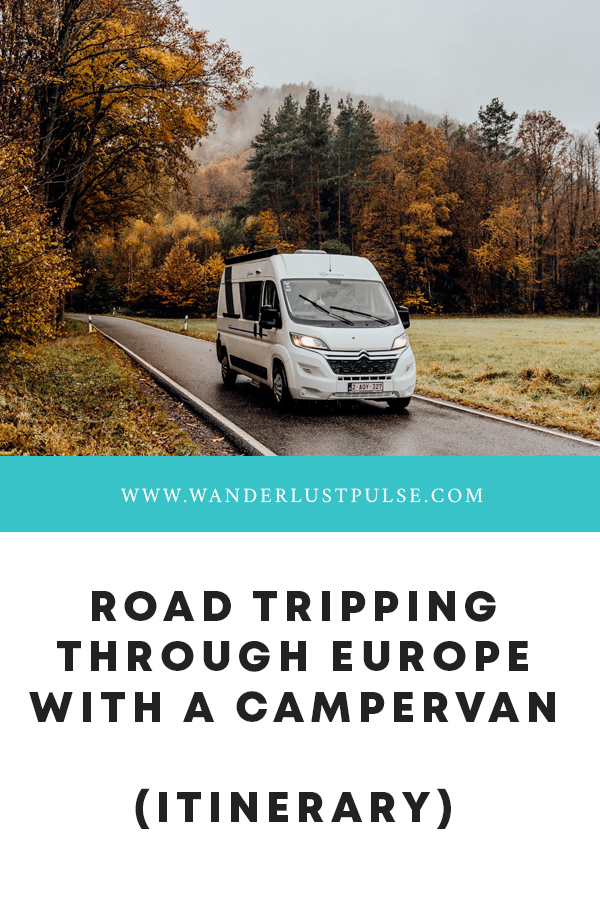
Share this:
Hey there! I'm Elliot Clennam, a passionate photographer based in Brussels, Belgium. My love for capturing the essence of my surroundings has led me on countless adventures, from exciting road trips to bustling city escapes.
Similar Posts
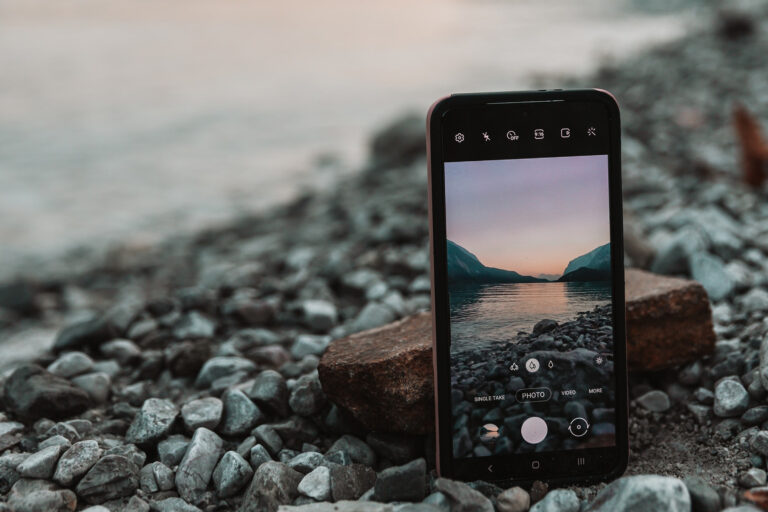
65 Dolomites captions for Instagram (Puns, Quotes & Short Captions)
The Dolomites mountain range in northeastern Italy is a true natural wonder, with its towering peaks, picturesque valleys, and…
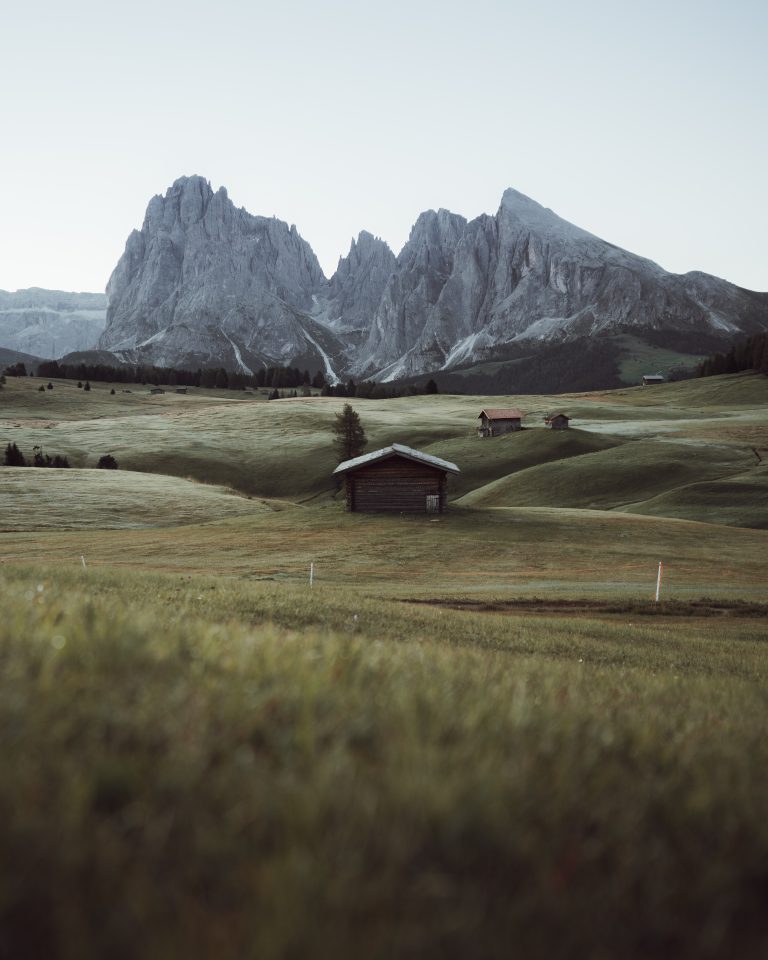
Alpe Di Siusi, housing the most known cabins in the Dolomites
The Alpe Di Siusi – also known as Seiser Alm – is one of the most known mountain plateaus…

The ultimate guide to traveling to the Faroe Islands
Never heard of the Faroe Islands before? You’re not alone; most Europeans don’t even realize it exists! While a…
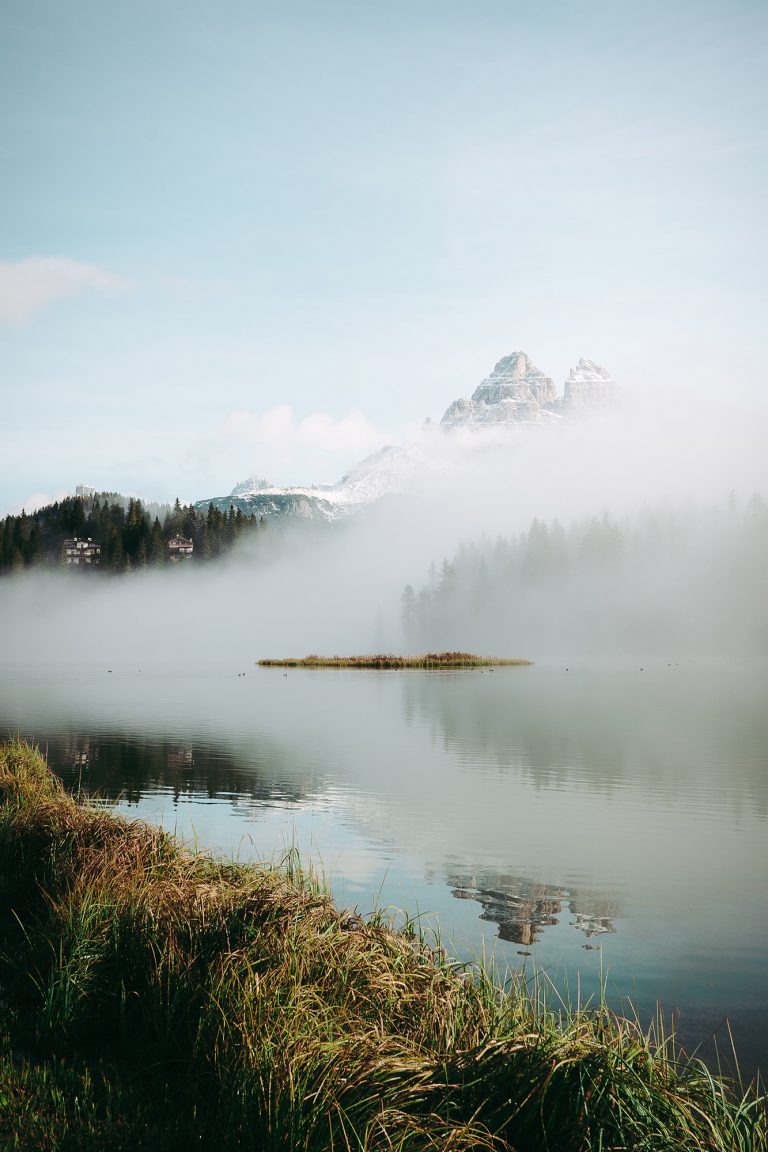
Lake Misurina, possessing the purest air in the world
Lake Misurina – known for its special microclimate – is an amazing place to hike around. Here is everything…
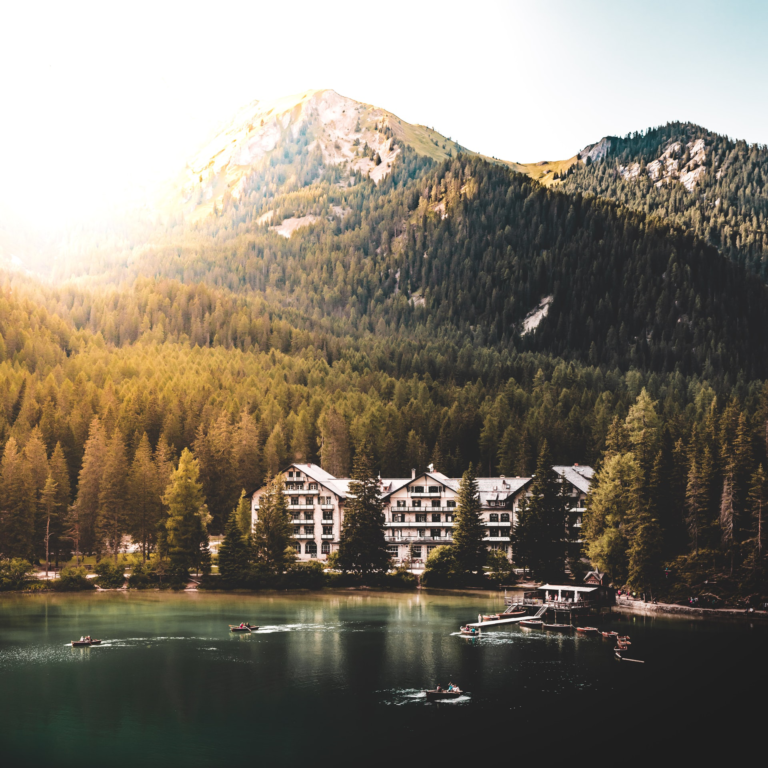
Lago Di Braies: a mysterious lake in the Dolomites
Lago Di Braies is a legendary lake located in the Dolomites, which still contains many mysteries. We visited the…
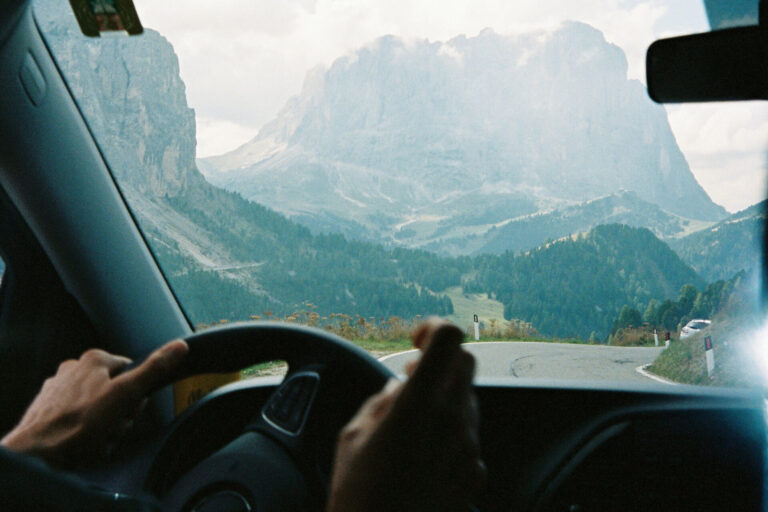
The ultimate Dolomites road trip playlist (Reels and TikTok sound suggestions)
The Dolomites, with their towering peaks, rugged cliffs, and breathtaking landscapes, are a haven for travelers seeking adventure, beauty,…
- Adventure Travel
- Solo Travel
Join our Adventure: Get all my insider tips for motorhoming & road trips
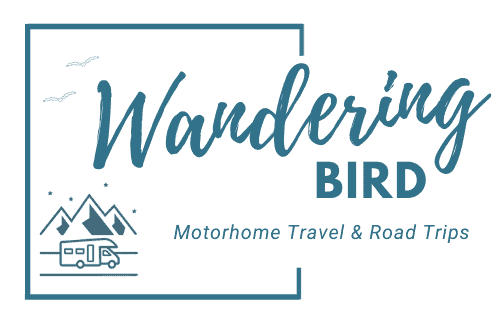
How to tour Europe in a Motorhome-the ULTIMATE guide
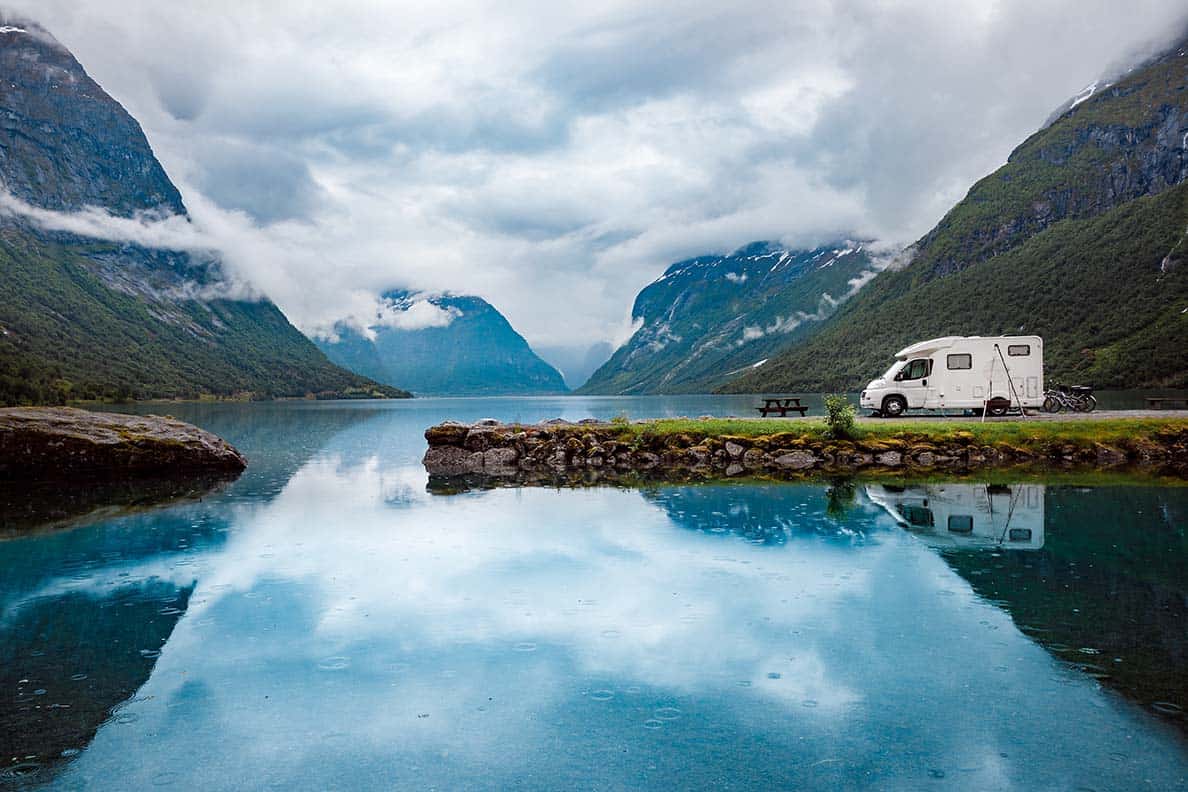
Want to tour Europe in a motorhome or campervan? Feeling a little overwhelmed and not sure where to start? Here’s everything you need, from what kit to pack, what paperwork you need to carry, how to prepare your van, European road trip itinerary ideas and tips for life on the road.
Don’t forget to grab your free Europe motorhoming checklist below.
*We work hard to make this the best motorhome travel blog and road trip website possible, full of helpful content for you. The website is supported by our readers, so if you buy through links on this site we may earn a commission- at no extra cost to you. All opinions remain our own .
If you find this post useful, you can also treat us to a coffee – we promise to enjoy it while creating more useful content like this- we might even indulge in a biscuit (or two!)
JUMP AHEAD TO...
Touring Europe in a motorhome blog- our story
I remember the first time we took our motorhome to Europe. There were SO MANY rules and things to pack and what the heck are aires and how do I book one and what route should we take and do we need…
To say I was daunted was an understatement. Everywhere I looked for advice had totally contradicting information. I spent the first few days of our Europe road trip feeling exhausted and terrified that I’d forgotten something vitally important.
If you’re also feeling intimidated by the idea of travelling Europe in a motorhome, camper van or even a caravan, don’t panic. Since that first trip, I quit my job so we could explore Europe by motorhome as often as possible (let’s just not talk about 2020…)
We’ve travelled nearly 60,000 miles and visited 17 countries. We have made many MANY mistakes… but we’ve also learnt a lot about vanlife in Europe and what NOT to do. And I’m going to share that with you today.
I promise- it’s not as scary as it feels right now.
Today I’ll walk you through the various steps you need to take to plan your own motorhome road trip to Europe and, hopefully, you’ll feel much more confident by the end of it.
Don’t forget to grab your free printable Europe motorhome travel checklist , which will help you remember everything you need.
Unsure what you need for your Europe road trip? Worried you’re missing something important?
Grab your FREE Europe Road trip Checklist NOW- everything you need: essential kit, paperwork and useful gear to take.
This form subscribes you (free!) to the Wandering Bird mailing list. We share tips, itineraries, and helpful guides like this for road trippers and motorhomers.
We never spam (yuck) and you can unsubscribe at any time.
How to Tour Europe in a Motorhome, campervan or RV – where to start
Let’s start with the basics. Before you can head off to Europe in a motorhome, you need a motorhome or camper van! You can either buy one or hire one and there are pros/ cons to both.
TOP TIP: If you’re planning a 3 month or more trip to Europe, definitely buy a motorhome- it will be MUCH cheaper. Here’s our complete motorhome buyer’s guide to choosing the camper for you.
If you don’t already own a motorhome and are considering getting one, hiring a motorhome or campervan for at least a weekend, preferably a week, is the perfect way to know if motorhome life is for you, before you spend a lot of money on one.
Also, if you are looking to buy a motorhome for the first time , hiring one is a great way to learn what layouts work for you, what you like and dislike and what you’re looking for in your own vehicle.
Having said that, we bought our first motorhome with no experience and no planning and set off to tour around Europe after only 15 days… So do whatever feels right for you.
Want to rent a vehicle for your road trip?
These might help:
- Discover incredible deals for motorhome/ camper rentals
- Find the best deals for car rental
READ: 10 essential questions to ask before you rent a motorhome
Motorhoming in Europe- 25 Essential things to know
Watch this video for 25 things you need to know about touring with a motorhome or campervan in Europe:
We hope you found the video useful. If you did, we’d love it if you followed us on Youtube . New videos with tips for motorhoming and campervanning in the UK and Europe are released weekly.
Motorhome Touring in Europe- where to stay?
Once you’ve got a vehicle to tour around Europe in, the next thing to consider is how do you want your trip to Europe to be and where are you going to camp/ park overnight?
- Do you want to stay at a campsite with pitches for motorhomes, campervans and caravans which has loads of facilities and activities for the kids to do?
- Would you prefer to wild camp in your motorhome and stay at a new place each night, far from crowds and cities?
- Do you want to use aires/ free overnight parking spots in Europe and stay 2/3 nights in a place before moving on?
Deciding the type of holiday you want to have will make planning your motorhome trip a lot easier. Here’s a bit more information about the types of motorhome parking available in Europe to help you decide.
Motorhome campsites in Europe
Campsites in Europe are very similar to ones in the UK; you arrive, are given or can select a pitch with or without electric (depending on what you booked) and that’s it. Often, you will need to provide ID when you arrive and some places even keep hold of your passport while you stay.
Campsites often have great facilities- like swimming pools or a beach on a lake, watersports, play area, restaurants, fresh bread delivery, shop etc. Dogs are normally always welcome, but there isn’t always a dog walk/ run where they are allowed off lead.

European motorhome travel in the school holidays- or not?
If you’re travelling in the school holidays, you’ll want to book up the campsite (if you’re using one) asap- the best ones get booked up months in advance.
If you’re NOT travelling during the school holidays, you might want to consider getting an ACSI camping card – you’ll save a lot of money on campsite charges.
Aires in Europe
For us, we prefer to travel around Europe in our motorhome and explore different places during our trips instead of staying in one area. We generally stay only one night in a place (unless we’re planning to ride the motorbikes, in which case we find somewhere for a few nights.)
There are two types of motorhome overnight parking options instead of campsites. The first are approved Motorhome parking places, which are called Aires in France , Stellplatz in Germany and Sostas if you’re campervanning in Italy . They’re all pretty much exactly the same!
Motorhome Parking Tips for Aires
You cannot pre-book Aires- they operate on a first-come basis. We found people tended to move on about 10-11am and most were parked up by 4pm, so try and move within that window for the best chance of finding a space. When we toured Italy, we left a little earlier (around 9ish) and aimed to be parked for lunchtime-ish, which we think helped us get in where we wanted without problems.
We like aires, as we feel happier leaving our motorhome if we want to go off an explore, and don’t want to deal with the noise or expense of a European campsite. We tow motorbikes behind our motorhome and love being able to use them without worrying if the van is ok.
You can find more on how to use aires and find motorhome parking around Europe here.
Wild camping with a motorhome or campervan in Europe
The other option for overnight motorhome stopovers in Europe is wild camping, which is staying somewhere that’s not an ‘approved’ place overnight and then moving on the next morning.
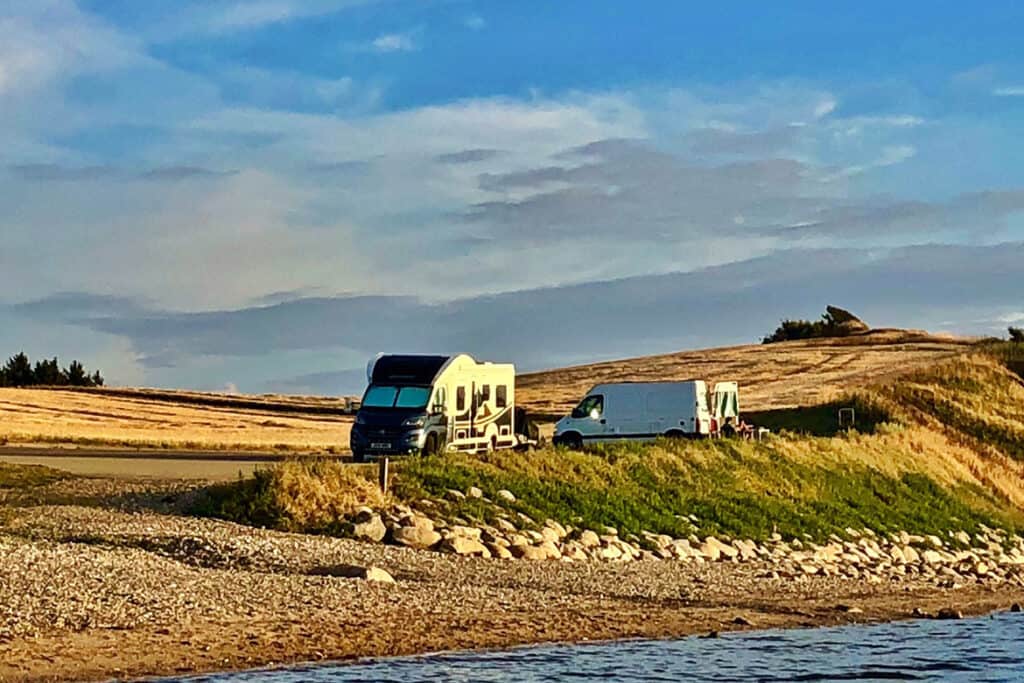
Rules for wild camping with a Motorhome in Europe
There are many different rules and different stories about motorhome wild camping across Europe. Wild camping is technically illegal in many countries, such as Switzerland – but we’ve stayed off-grid in our motorhome hundreds of times without any trouble at all. Heck, it was a night wild camping in the Alps in Switzerland in our motorhome which made us decide to change our lives and go motorhome travelling (almost!) full-time!
Wild camping in France in a motorhome or campervan is tolerated, as long as you’re not near the coast or in a restricted area. Find out more about motorhome wild camping in France.
My advice is to research the rules for the country you’re visiting, and then check out Park4night. Don’t park if it says ‘No Overnight Parking’. Also, always trust your gut. If you’re not sure and not happy, move on to an approved Motorhome stop point, so you can get a good nights sleep without worrying about being woken up for parking illegally.
You can find everything you need to know about how to wild camp with a motorhome or campervan here.
How to find free/ cheap Motorhome Parking spots in Europe
So, HOW do we find these overnight stopovers in vans in Europe? There are three apps we use. They’re all great but work in slightly different ways.
Park4night is what we mainly use when motorhome touring in Europe- and it is BRILLIANT. It’s both an app and a website- we tend to use the app most while travelling. There is a small annual fee but it’s well worth paying for.
This is how we use it:
- Drive to somewhere we want to explore- or a place en-route if we’ve got a long route planned.
- As we get closer, open up the app on my iPad or laptop (read more about getting internet in a motorhome )
- Put in the area you are heading for into Park4night and filter your options.
- Look at photos and comments to remove any with bad reviews, or which are too small for your motorhome to fit into.
- Check to make sure the place is open! A lot of places close between Oct- Apr.
- Then I tend to go on gut feel. I might have two or three options at this point but if I’m honest I’ll know which one of those three I like the idea of most, and that’s the one we head for first. If we get there and it’s full/ closed/ turned into a building site (has happened twice to us!!) then we have other options we can fall back on and we can head to those next.
We use Park4night as it tends to have the most options for places to stay in Europe. However, there are some other good choices too.
Planning to take your motorhome to Europe?
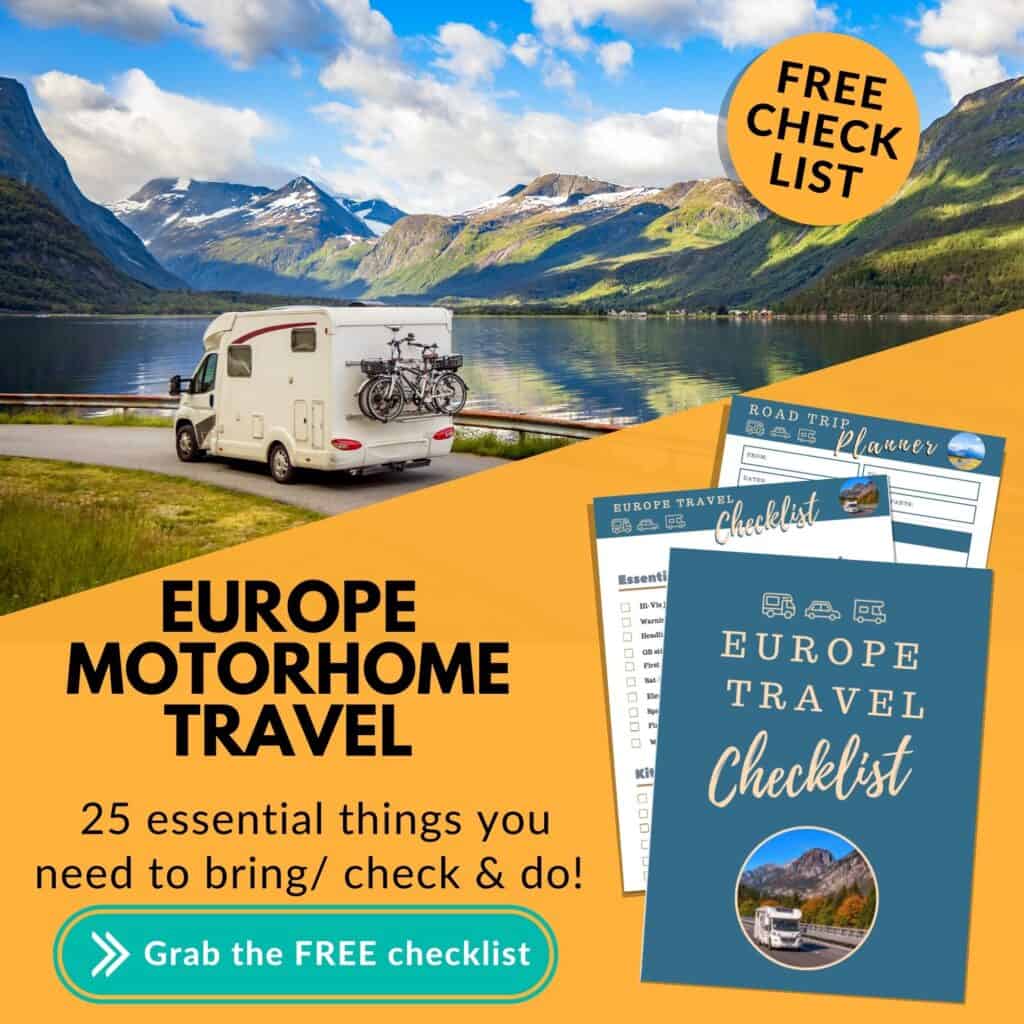
GUIDE: Stop the overwhelm with our step-by-step guide. Contains eBook, checklists and more. Complete Europe Motorhome Travel Toolkit
CHECKLIST: Don’t forget to grab your FREE Europe motorhome travel checklist HERE
GEAR – If you need any motorhome gear for touring Europe, here’s what we recommend.
Camper contact
Camper Contact works in a very similar way to Park4night, however, the BIG thing it offers which we love is you can remove all parking spaces which aren’t suitable for longer motorhomes. We love this feature when we are towing a trailer behind our motorhome and want to make absolutely sure it’s suitable for a longer vehicle.
Camper contact is free on the website but the app requires payment, which is another reason we prefer Park4night.
Searchforsites
Search for sites is another motorhome parking app but is better for in the UK. Again, it’s a really useful site and well worth checking as occasionally there are different places on here than on the other two. Pretty much all the reviews on here seem to be in English, which can help when you want to read what people thought!
Between the three of these motorhome parking apps, we’ve travelled around Europe without any problems. Once, in Italy in August, our preferred Aire was full, so we had to move on elsewhere and a few times the place we’ve been heading for no longer exists!
If you find out of date information, please take the time to update the app so other motorhomers don’t do the same thing. They are all great resources and, without them, motorhome road trips in Europe wouldn’t be nearly so easy.
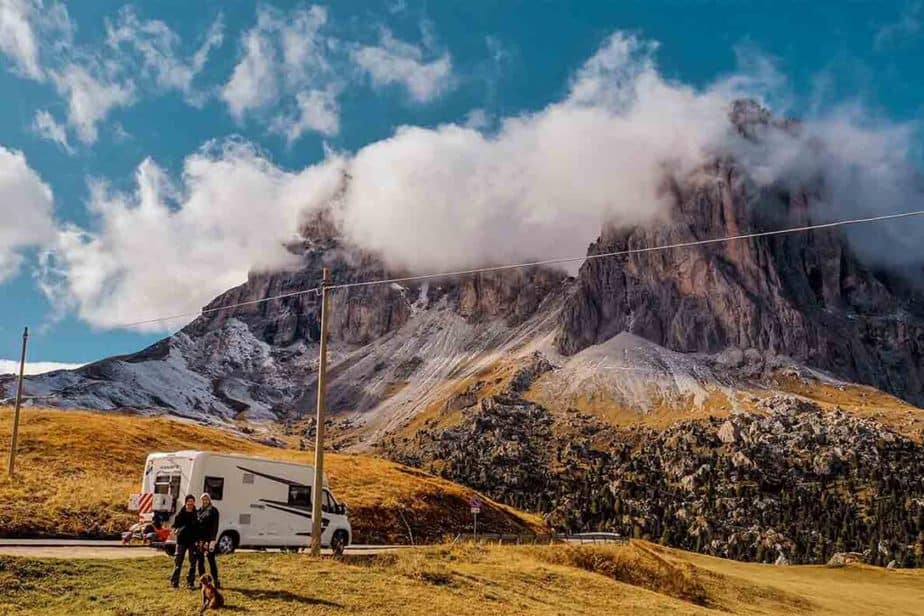
Other parking schemes in Europe
In Europe, there are several schemes similar to Britstops as a great source of free overnight parking stops for motorhomes. In France, France Passion is a similar set-up, and there are others around Europe.
You can find a list of all the motorhome overnight parking schemes and how to find them here.
Motorhome Route Planning for Europe trips
Once you’ve decided where you’re staying, you can start planning a motorhome route in Europe . Obviously, if you’re just travelling to one campsite and back again, then the route will be fairly straightforward.
However, if you’re planning to use aires or wild camping, then you can decide where you want to visit, what you want to see and if you’re going to be using toll roads or not.
One thing to note is that we rarely plan an actual road route until we’re driving. or just setting off for the day. I don’t plan the roads in advance- just the places we want to visit during our trip. Everything else I do as we travel. If we want to visit a specific aire or campsite, I’ll note that in our plan. You can grab our free road trip planner and use that to help you plan your route and things to do.
The other thing you’ll need to plan is how you’re going to get to Europe. If you’re in the UK, will you take the ferry or use Eurotunnel ? There are pros and cons of both but it’s worth deciding quickly so you can book in advance and hopefully save some money.
TOP TIP: If you want some ideas for where to visit, here are some of the best Europe road trip itineraries for motorhomes and campervans.
Tolls in Europe
Many people are concerned about tolls in Europe and like to plan their routes to avoid them. There are pros and cons to this. Tolls occur in nearly every European country which doesn’t insist on a vignette. If you’re motorhoming in Germany you can enjoy some free autobahns (same if you’re motorhoming in Holland .)
When you plan a route in a country without a vignette, you have two options:
- The quick way (which uses tolls roads when necessary)
- The cheap way (which doesn’t!)
There is no right answer- it’s whatever’s best for you. If you only have a week for your motorhome holiday , many people will want to get to their destination asap, which means using toll roads.
If you have more time, you may want to save money and take the slower, but usually prettier, back roads. Do whatever’s right for you.
If you want to get an idea on how much a toll route might cost, use the website https://www.viamichelin.com/
This site will tell you the approximate driving costs for your trip, both in fuel consumption and tolls. The fuel setting is annoying as you can’t select for a motorhome/ camper, although you can select the appropriate mpg, but the toll charges & vignette costs (as long as your motorhome is under 3.5 tonnes and 3m tall,) are very accurate.
Motorhoming in Europe- paperwork you need to carry
So, you’ve got a vehicle, a plan for overnight stays and the beginnings of a route. Now it’s time for the paperwork you need to carry, both for your motorhome/ campervan and also for you.
Nobody likes this bit, because it’s pretty boring, but it’s also essential. We’ve been stopped twice, both times in France and both times near the ferry at Caen. The police seem to love waiting there and pouncing on Motorhomers and campervanners who might have forgotten something.
In France, fines for speeding or incorrect paperwork must be paid in cash on the spot, or else you’ll be escorted to the nearest police station- not the most welcoming start to your holiday! However, if you have all the following, there’s nothing they can do except wish you a ‘bonne journee’ and see you on your merry way.
READ MORE: Essential advice for motorhome touring in France
Complete list of paperwork needed to tour Europe in a motorhome
Here are your next steps for paperwork and staying organised (don’t forget you can download our FREE Europe motorhome travel checklist to keep organised)
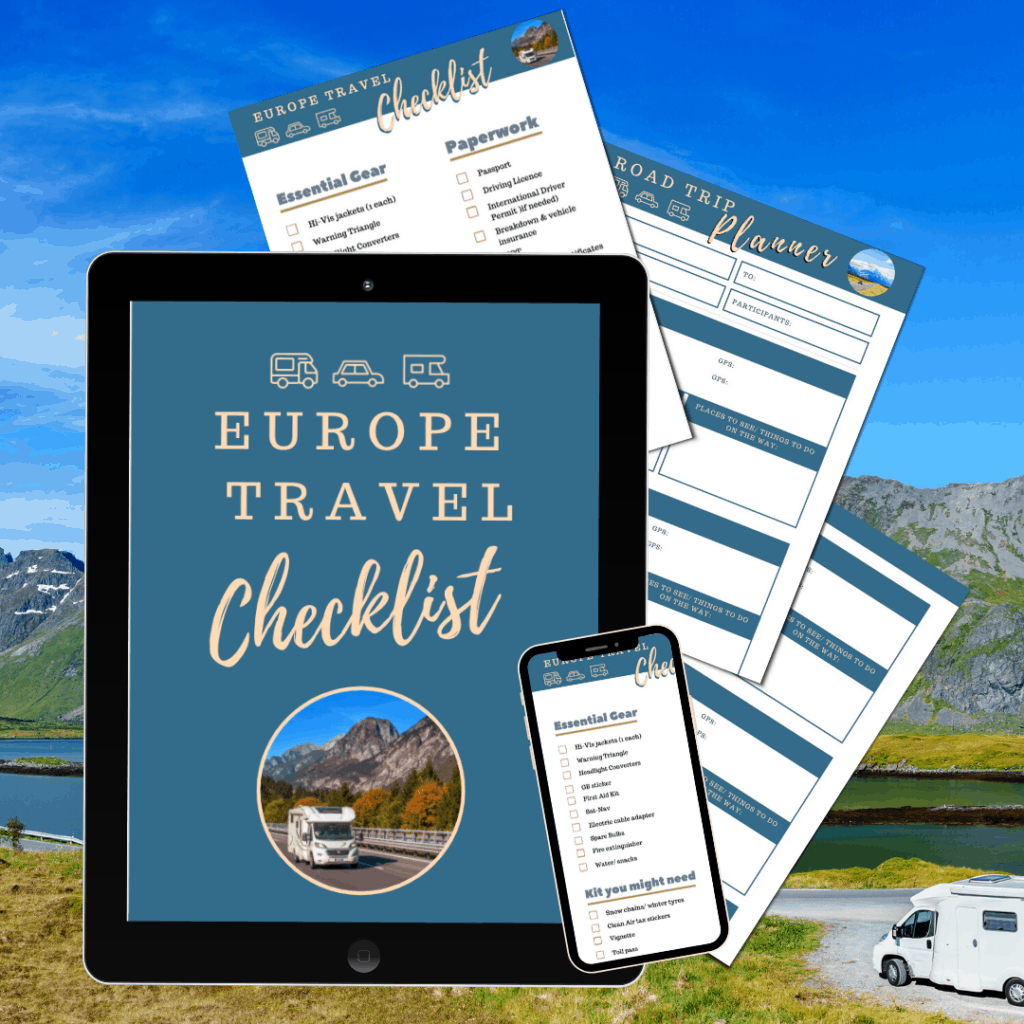
Want to head to Europe with your motorhome?
Grab your FREE (printable) checklist and discover 25 things you NEED to take with you when you travel in Europe. Make your life easier today.
- Make sure your passport is in date (with 6 months left)
- Make sure your motorhome insurance covers Europe travel
- Read the rules for driving in Europe after BREXIT
- Get a green card (if required- check with your insurer)
- Motorhome logbook (the REAL one- not a copy)
- If the vehicle is company-owned, hired or leased, you need a letter from the company stating their permission for the vehicle to go to Europe.
- MOT (date of)
- Driving licence- yes, your UK driving licence is legal in Europe but you might need an International Driving Permit .
- MOTs & logbooks for any other vehicles you are taking (like our motorbikes)
- Trailer EU certification if necessary
- Animal health certificate for pets (read about how to take a pet to Europe after BREXIT )
- Personal Travel insurance
- Drone Insurance (read our review of the best travel drones here)
- Put together an EPIC road trip playlist
- Do your last minute vehicle checks
- Details of ferry/ train bookings
- For larger motorhomes visiting France, you might need blind spot warning stickers
Motorhome Insurance
You need motorhome insurance which covers travel in Europe (and other places like Morocco if you’re planning to venture further afield). You also might want to get Breakdown cover which includes recovery to Home- just in case the worst happens. Bring your original certificate with you, not a photocopy.
Health Insurance
The rules for health cover for UK residents in Europe have changed after BREXIT. You now MUST have travel insurance. Make sure you read the conditions carefully- many ‘cheap’ policies don’t cover you for more than a week or two at a time, so if you’re planning on going away for longer you’ll need to find an appropriate insurer. Ideally, get repatriation cover to the UK- just in case.
Europe Motorhome Travel- Essential items you need to carry
Unlike in the UK, there are some things you legally NEED to carry in your motorhome, campervan or car when you’re touring Europe. These essentials Europe travel accessories include:
- UK vehicle sticker or UK on your reg plate- with the British flag, not an EU circle
- First aid kit – did you know it is illegal to NOT stop at an accident in France and many other places in Europe?
- Warning Triangle
- Hi-vis jacket which must be easily reached without leaving the vehicle (or getting off a motorbike!) We recommend carrying one per person, including for toddlers.
- Spare light bulbs for vehicle
- Headlight deflectors as our UK headlamps are pointing the ‘wrong way’ for European roads-
- Radar detectors are forbidden EVERYWHERE in Europe.
- Motorhome speed stickers for some vans
- NO- you do not need a breathalyser.
- You might also need a red/ white striped reflective board if you have bicycles or a motorhome storage box.

Useful kit for travelling Europe in a Motorhome or camper
Assuming your van is already packed with these essential motorhome accessories , there are a couple of things which will make your life easier when touring Europe in a camper.
Motorhome Wi-Fi
Is wifi in a motorhome an essential? For us it is- we work from the road, so we need a reliable way to contact the outside world (and upload blog posts like this!) Our life just wouldn’t work if we didn’t have a decent Internet connection.
For years, we had a wifi dongle in our motorhome and, quite seriously, it’s BRILLIANT. We’ve travelled all around Western Europe and it didn’t let us down once. Oh ok, it’s failed to get a signal just once and we were parked on the top of a mountain in the Swiss Alps at the time- I’m not sure I can blame it for that!!
We use data SIMS with Vodafone, 3 and EE and we find EE and 3 to have the best coverage across Europe. You can buy Prepaid SIM cards of data from Amazon ( like this one ) or take out a monthly contract (which is what we did)
More recently, we’ve installed this internet system in our van and it has been equally good, although we haven’t been able to travel much to really test it out.

Data Roaming in Europe
If you are travelling outside your home country, you need to make sure that data roaming is enabled on your phone AND that you have a plan which allows you to use data in other countries cheaply.
You will also need to know how to avoid paying high charges for data roaming in Europe.
Also, be aware that the data limit you have at home will probably NOT be the same as your allowance abroad- so be cautious with how much you use. It’s hard to track data usage, but things like using maps, watching TV in your motorhome , streaming videos or putting photos on Facebook can all use up a LOT of data very quickly.
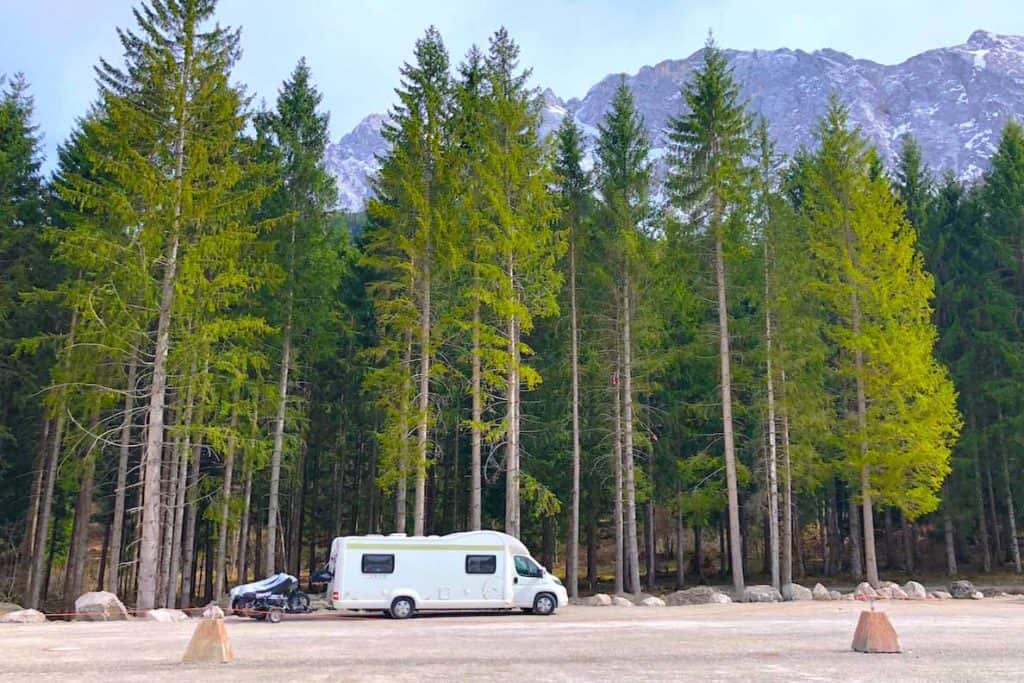
We highly recommend investing in a proper motorhome sat-nav before your start driving around Europe, especially if you have a larger motorhome, RV or campervan. You want something you can put your vehicle dimensions into and be able to avoid narrow roads, low bridges or weak crossings.
Here are some of the best motorhome and campervan sat-nav systems on the market- have a look and make sure you know how to use it before you set off.
Never, ever rely entirely on the sat-nav; keep an eye out for road signs and height restrictions as well. I also use my personal iPad or phone to find us an alternative route should we hit a traffic jam- both of those have ‘traffic’ setting enabled on them so we can see where the traffic is and how to get around it.
I often end up navigating our motorhome down tiny country lanes in the middle of nowhere- after all, it’s not a proper adventure unless there’s grass growing in the middle of the road!
Also, be careful where you mount your sat nav, especially if you’re using an ipad. Many countries now say it’s illegal to have the satnav mounted on the windscreen or blocking the driver’s view. We use this mount and mount our iPad on our dashboard, where it’s low enough to not cause any problems.

Campervanning in Europe – POWER!!!!
One of the joys of touring Europe in a Motorhome is the freedom that you can find on the continent which you just can’t get in the UK. Being able to stay off-grid in our van gives us that freedom. But, in order to do that, we need to manage our motorhome power requirements.
The solution to this is an inverter (and possibly a power pack, depending on how power-hungry you are!) We are VERY power hungry- we have two laptops, two iPads and 4 phones! ( Don’t ask!! Yes, I know there are only 2 of us!!)
We charge as much as we possibly can whilst we are driving the motorhome, including the laptops. We do this by running the invertor as we drive. The inverter is connected directly to the motorhome leisure battery and then we added a 2-plug extension lead, which allows us to charge our laptops on a drive, saving our precious battery power while we’re camped.
We fitted and love this inverter but there are many other options out there if you need a different size/ power output.

I didn’t want a generator on our motorhome . I didn’t want to be THAT van with the generator going all evening, ruining everyone else’s peace and quiet. But, as my husband said, if we’re going to camp in the middle of nowhere for days at a time, we need an alternative power source ‘just in case’.
We’ve agreed that we will NEVER use it except in an emergency or for servicing, and we did a lot of research to find the best one for us in terms of noise levels and size. I have to say we’re really pleased with this one . It’s small enough to fit in a tiny cupboard under our seats and I can lift it with one hand.
We’ve used it several times of the past couple of years, including while touring Norway and Austria. We’re really impressed at how quiet it is and how well it works even after months of not being started!

12v Hairdryer
Whilst we’re on the subject of power, both Jade (our daughter) and I have long hair. We love letting it air dry on hot summer days, but if we’re motorhoming in winter it’s essential for us to have a hairdryer.
RELATED: Planning winter motorhome living or a trip? Read this first…
Believe it or not, we actually carry TWO hairdryers onboard (much to my husband’s ‘delight’…)
One is a good, powerful but lowish wattage one we use when we have electric hookup, and the other is a 12v one , which plugs into a cigarette lighter socket in the cab. Honestly, it’s not the best hairdryer we’ve ever tried, but better than nothing on a cold winter’s day.
Alternatively, a rechargeable hairdryer .

Solar Panel
We do have a solar panel onboard our motorhome- we believe it’s an essential motorhome wild camping accessory. It keeps the battery topped up whilst we’re camping and allows us to stay off-grid for a little while longer- at least if it’s sunny!
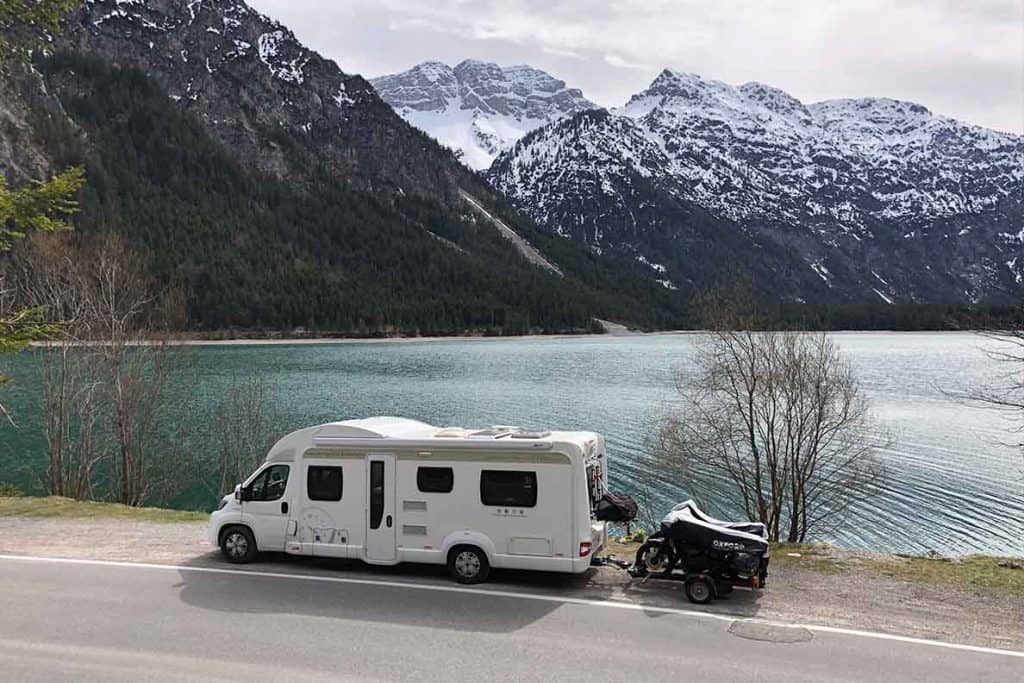
One of our very first motorhome trips to Europe almost ended after 2 days due to…err… gas. Or rather, a lack of it and an inability to get any more! There are some important lessons we learned and things you need to know about how to find LPG (gas) in Europe .
To combat that ever happening again (we hope!!) , we fitted Gaslow refillable bottles . These went easily into our existing motorhome gas locker and we were able to fit them ourselves. We used them for the first time last week and we’re really happy with them. Filling took a little while to figure out- turns out you need to TWIST the nozzle clockwise, but so far, so good! We’ve now had these installed for a year and wouldn’t switch back- refillable gas is SO MUCH cheaper and easier while travelling Europe in a motorhome.
Motorhome Touring in Europe – Other items which might be useful
ACSI is a scheme you can buy a membership to (like a motorhome club ), which then gives you massive discounts on campsites for motorhomes, campervans, RVs and Caravans- as long as you travel outside the peak seasons.
We LOVE our European toll pass. It’s sooooooo satisfying being able to sweep past all the huge queues at some of the tolls and go through the automated toll pass lane in France. It also works if you’re motorhome touring in Spain & Portugal. The best bit for us is not having to worry to find the change at each toll- it just sends you a bill at the end of the month which is paid automatically by Direct Debit so its one less thing we need to worry about!
We bought ours at Sanef Tolling, although they have now changed their name to Emovis-tag.
Tyres & Snow chains
If you are planning to go motorhome skiing or tour Europe in a motorhome in the Winter, think about your tyres and snow chains . It’s compulsory in most countries with Mountains (France, Germany etc) to have winter tyres fitted and to carry snow chains which will fit onto your tyres. This is usually enforced between 01 November and 15 April. This list by the AA gives a great guide for you.
Red and White reflective warning backboard for motorhomes/ campers
If you have anything extending past the back of your motorhome/ camper (like a bike rack or a tow bar), you MUST have a red and white striped backboard on the back. Make sure it’s the aluminium one, not the cheap version- the cheap version is not legal in Italy.

Travelling Europe in a Motorhome or campervan- Safety
Here are some important things to know about travelling in Europe
Emergencies
112 can be dialled anywhere in Europe in an emergency, accident or distress situation.
Security and theft
We have several things we do to protect our vehicle and our possessions whilst we’re travelling. We also have several things we do to safeguard ourselves if we’re back in the UK preparing for our next trip. Be sure to grab our FREE guide to motorhome security.
We have been lucky to have never been the target of theft, but it does happen. Most thefts are opportunistic- if you leave something outside unattended there’s a chance it will be taken- just like in the UK. Also, if you park in busy, built-up areas, there is more chance of ‘unsavoury types’ spotting the van and taking their chances- just like in the UK.
We strongly believe that touring Europe in your motorhome is no more dangerous than touring in the UK, but common sense should be used. We’ve chosen to fit an additional motorhome door lock which can be locked from both the outside and the inside.
Try and get your Euros in advance as you’ll get a better rate than if you use the ferry/ tunnel. You can get money out of cash machines abroad- but, of course, there are charges for that.
Also, don’t forget that not every country in Europe uses Euros . Here are some popular ones which might catch you out!
- Bulgaria – Lev
- Croatia – Kuna
- Czech Republic – Kurona
- Denmark – Krone
- Hungary – Forint
- Norway- Krone ( See how expensive our trip to Norway was !)
- Poland – Zloty
- Romania – Leu
- Switzerland – Swiss Franc
There are others in the East as well- make sure you check in advance- but nearly everywhere has a cash machine so you can always get money out if you need to.
We think it’s sensible to carry a spare set of keys for the motorhome with us. We hope we will never need them, but a spare set is going to be completely useless sitting back in the UK. So we decided to bring them with us and keep them well out of the way.
Make sure you’re carrying enough Medication for you and any pets you have. We always carry a little more than necessary- just in case! Be prepared to explain your medication and prove what it is with a doctor’s note or something similar- just in case customs question you.
Mobile Phones
Using a phone whilst driving is illegal in many countries. It is also illegal in some countries (such as France) to use a headset with an earbud whilst driving. Your phone must be completely hands-free.
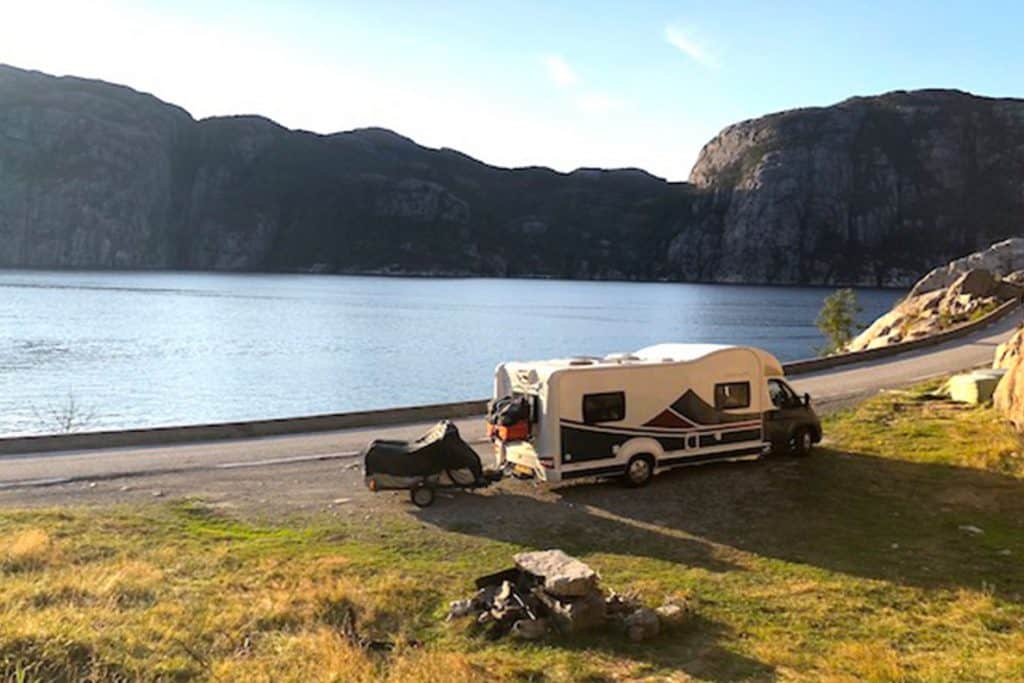
Driving in Europe- what to do in the event of a road traffic accident
You should have a European Claim Form provided by your insurer before you leave. In the event of an accident, all parties complete and sign the form at the scene and then send a copy to your insurer for assessment.
What to do at the scene:
- Stop your vehicle immediately but safely- out of the flow of traffic if possible.
- If a vehicle is blocking the road, use hazard lights and put the red warning triangle 30 metres from the scene to warn approaching traffic
- Name and address of all the people involved in the accident
- Vehicle registration numbers of all parties
- Insurance company details of all parties
- Take photos of damage using a camera, GoPro or phone
For more details, read our step-by-step guide on dealing with a road traffic accident in Europe
Motorhoming in Europe- Other Things to know
Sidelights must be switched on in the following countries at ALL times: Croatia , Denmark, Italy, Norway, Sweden & Switzerland
Daytime lights MUST be switched on for Motorbikes at ALL times in all conditions in ALL countries. Ours are wired so they automatically come on with the engine- saves us forgetting!
On-the-spot fines are common in all countries, although if you’re campervanning in Ireland the Police are not authorised to collect fines. Some places, like Croatia, give you 8 days to pay. Other places, such as if you go touring in Portugal , equip their police officers with an ATM to ensure fines are paid immediately!!
Be careful of low-emission zones and areas which require a congestion charge or something similar, such as Paris and London. These places are often clearly signed but it can be worth Googling requirements before you visit an area. Also, don’t forget you need a Vignette for Motorways/ toll roads in Switzerland and Austria. For a complete list of rules in each country, here’s the AA.
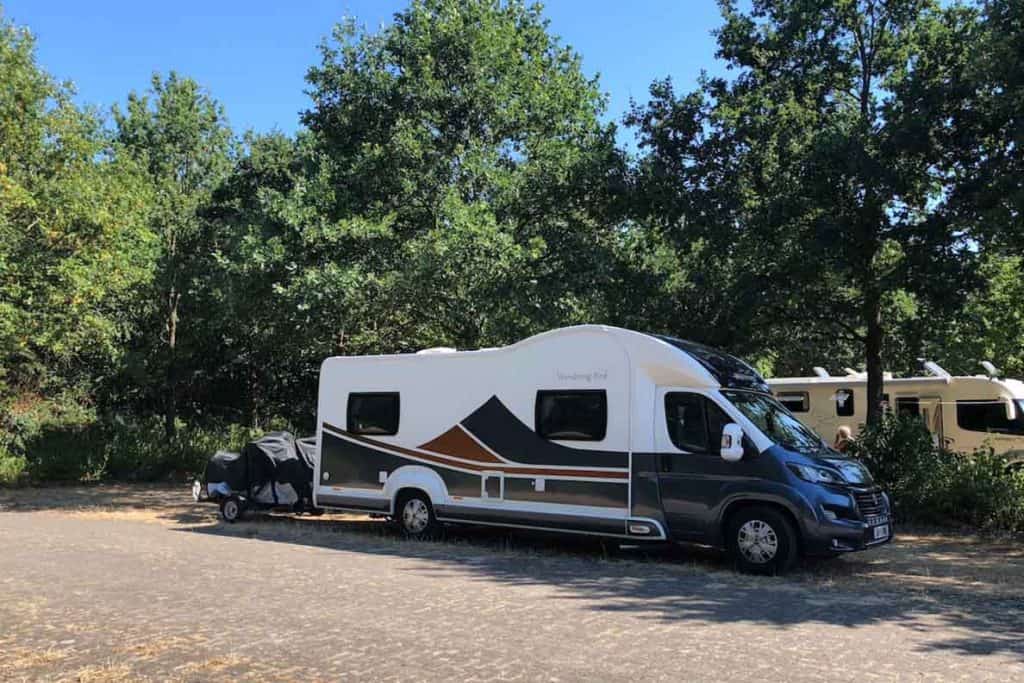
Touring Europe in a Motorhome – Final thoughts
Phew!!! There is a LOT of information in this post- and at first glance it can be overwhelming. None of it is ‘difficult’, but it will take up a bit of your time as you get it all organised. Here are some final tips to help you make the most of your big adventure!!
- Driving on the right is not as terrifying as it seems! Don’t forget- all the roads are set up for it- you don’t have to remember to go around the roundabout the wrong way- it naturally happens as that’s the way the road system works.
- Learn a little of the language. In France, Germany, Belgium and Holland, English is widely spoken, but they love it if you make an effort. After al, you are in their country and if you show a little respect to them they will really help you when you need it.
- Accept that you are a tourist- you will make mistakes and probably look like an idiot. But that’s part of the fun of travelling!
- Learn to ‘slow travel’- travelling by van is about the journey as much as the destination . This can be hard when you’re on a tight schedule, but try not to overbook your time so much that you can’t relax a little or explore random things that you find along the way- like an ice cave we randomly found in France…??!!
- Having said that, do a little research as you travel so you don’t miss some amazing places. We like to pick an area and then Google it to see what great adventures are waiting for us.
New to motorhome or camper travel in Europe? You might find these posts helpful:
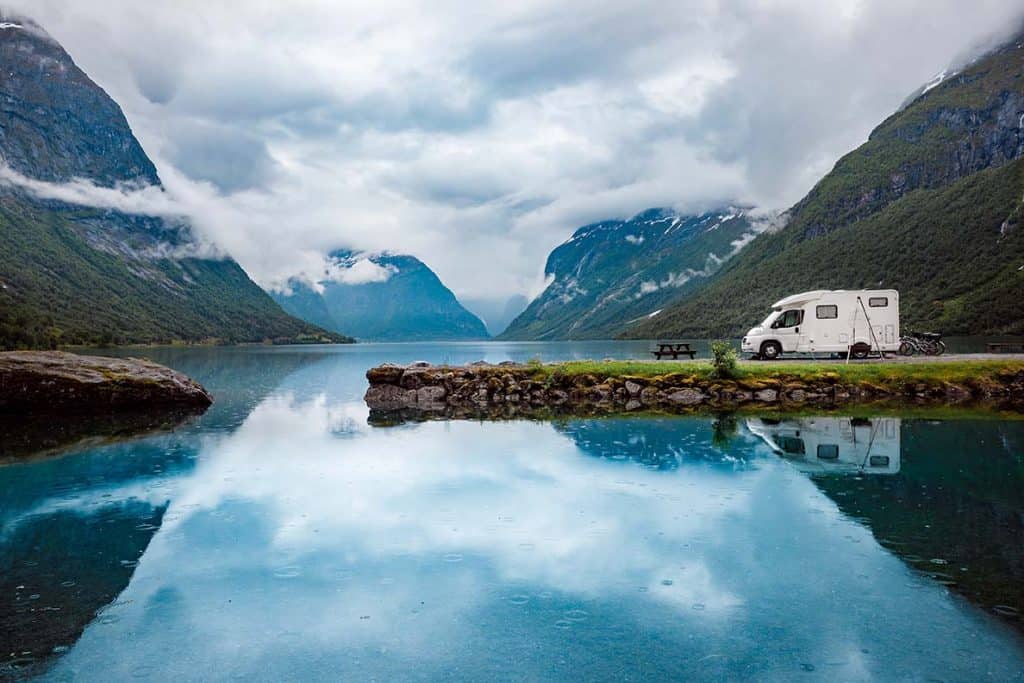
See all our Europe motorhoming posts here
NEED GEAR? If you need any kit or essentials for motorhoming in Europe, here’s what we recommend and where to find it
I hope you have the BEST adventures- be sure to tag me in your posts and show me where you end up! Let me know what you think of the guide in the comments below- I’d love to hear your thoughts.
Want to save this list for later? Here’s the pin. Enjoyed this post? We’d love it if you shared it on Facebook, Twitter or Pinterest. Thank you!
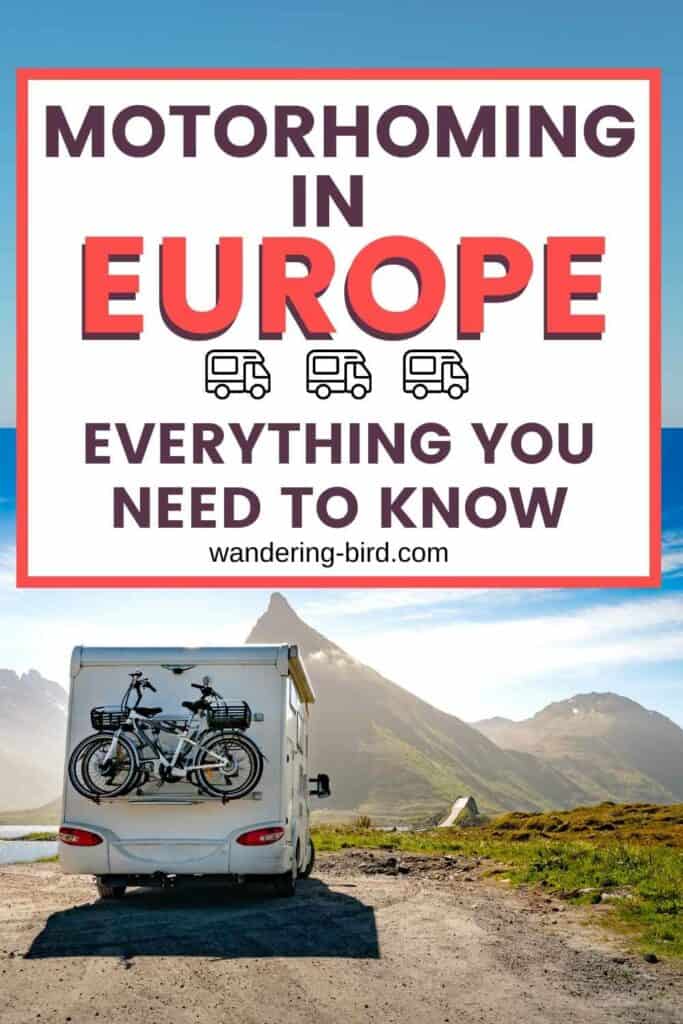
Kat never planned to buy a motorhome. She also never planned to quit her job as an air traffic controller, go touring around Europe in said motorhome, start one of the UK’s largest motorhome travel websites… or get a cocker spaniel.
Find out how she went from stuck in the rat race to being a digital nomad and inspiring thousands of people to have their own epic adventures here.
If you’d like to connect with Kat, send her an email or follow her adventures on social media.
Last update on 2024-08-27 / Affiliate links / Images from Amazon Product Advertising API
Sharing is caring!
Similar Posts
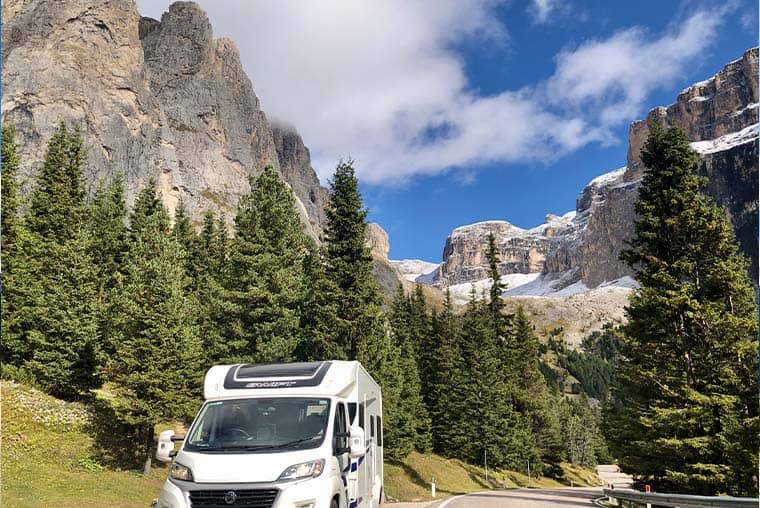
Dolomites with a Motorhome | Itinerary, Route & travel blog
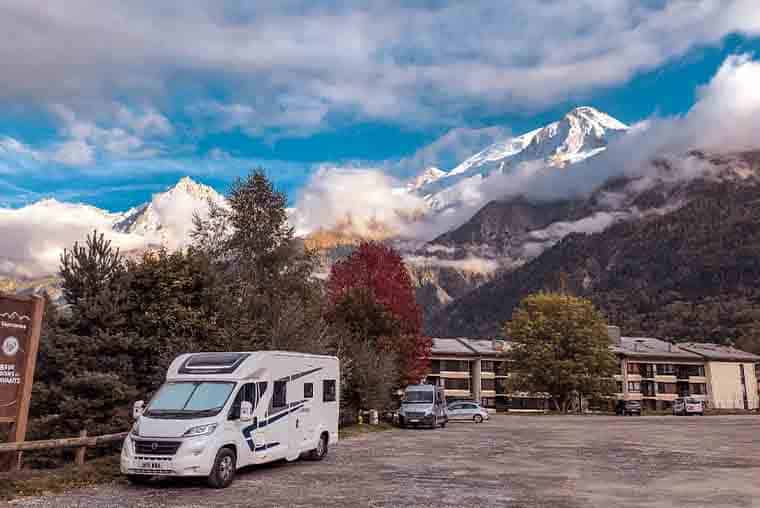
French Aires- everything you need to know about free motorhome stopovers in France
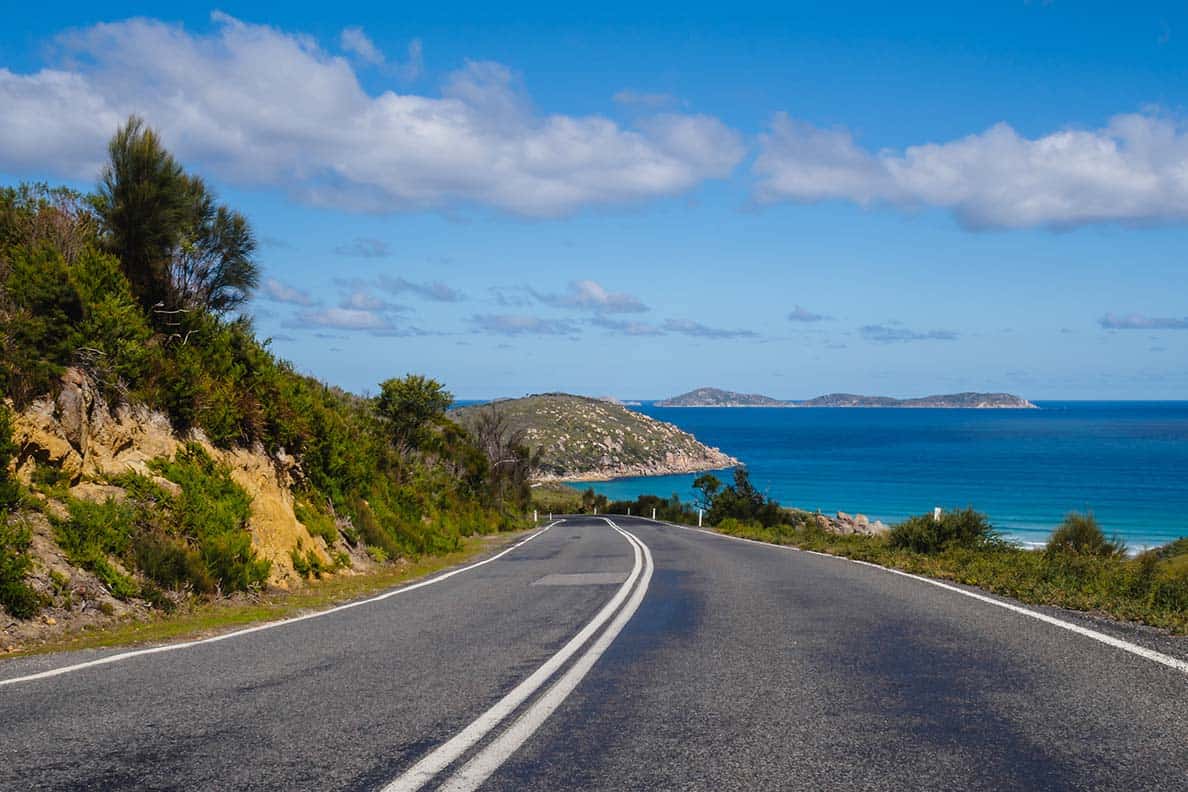
12 Unmissable European Road Trip ideas for every itinerary

15 essential Europe road trip tips you need to know
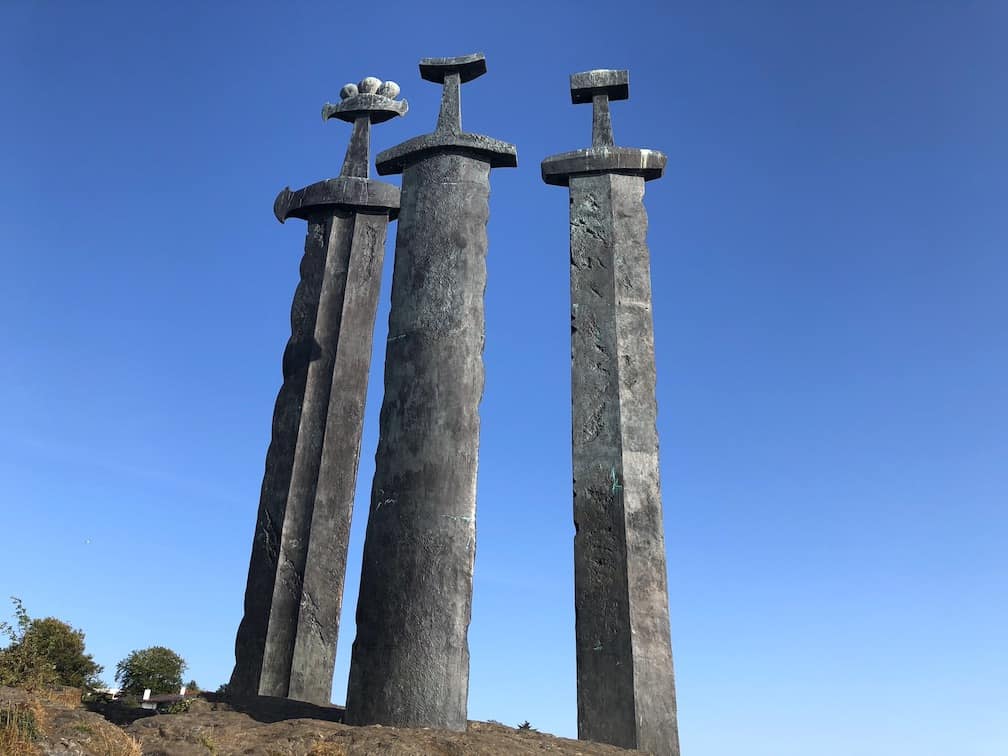
Sverd i fjell – Swords in the Rock
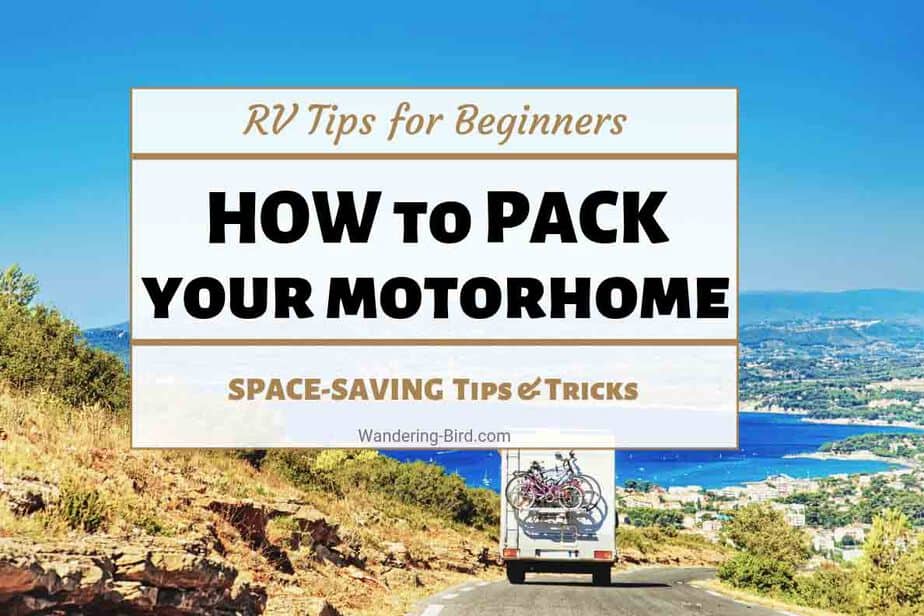
The Ultimate Motorhome & campervan packing guide (with list)
55 comments.
Lots of great info there. Thank you. 🙂
You’re very welcome! Hope it helps with your upcoming adventures!!
This is fatastic Kat and very timely. We are travelling in September to France & Switzerland in a hired van (before we buy our own yipeeee) so we were just starting to get our heads around all the planning. This is perfect as you have done all the work for us, so thank you so much for that. You are a star 🙂 x
Great information – thanks! When you were wild/free camping, did people have much camping stuff out in the off-season? As we’re going to be in a fifth wheel it’ll be a bit cramped if we can’t push a slide or two out!
People happily sit outside and enjoy a campfire and dinner, but don’t get awnings and things out when they’re wild camping. Those places are more designed to be a one night stop. I think you’ll be fine with the slides, though I admit we haven’t seen any fifth wheels on our travels- you’ll probably have loads of people wanting to come and have a look inside!! 🙂 I think as long as it looks like you’re not planning to stop for a week, you’ll be fine. Of course, if you end up somewhere really remote,you won’t have a problem as no one will see!!
Yes, we’re basically hoping that in the off-season it’ll be quiet enough to pop the slides out and the support legs down. We’re thinking that keeping the truck attached will make us a bit more ‘ready to go’ should the need arise on the aires – though as you say, if we’re somewhere remote and out the way we might stay a bit longer 🙂
Thank you for sharing this journey with us! We would love to pack up and head off in an RV but were hesitant with (coming up) teenage children – I can’t wait to follow your journey and see how you go 🙂
Hi Ange- thanks so much for reading and commenting. Honestly, if I had my time again I’d take my daughter out of school at 12/13 or maybe even a few years younger and travel with her- I think it’s such an amazing way for them to learn and grow. Hope you enjoying following our travels. 🙂
We are from Port Elizabeth, South Africa. My family (me, wife two kids 11, 9) will be hiring a camper for 20 days in December in Munich and plan to drive the black forest route and down to Rome via Switzerland and back to Munich. Do you have any experience of the cold in that time and how hired campers hold up? Will we find sites open that time of the year and do you know if there will be any exciting activities for the kids, with exception of viewing architecture and views? Any other advice?
Thanks for the awesome info!
What an exciting adventure you have planned! Funnily enough, we’re going to Munich in December too! 🙂 As you probably guessed, your experience is going to completely depend on the weather and how much snow has fallen so far. You will DEFINITELY need a camper with heating, so make sure your rental has that fitted (you’d be surprised how many don’t!) You will also need snow tyres/ snow chains- even if it hasn’t snowed. This should be provided- but please check. Also, do you know that most hire campers don’t come with bed linen/ towels and sometimes not even pots & pans? It depends entirely on your rental company of course, but it’s something to check.
If it’s a relatively modern camper with heating, you should be just fine in the cold. You are right that many campsites shut, but if you check out the sites I listed, you’ll be able to find the ones which stay open. Regarding activities for kids, it depends what kind of things they like. Our daughter is quite happy sitting in the van, listening to her music and watching the world go by. There will be plenty of walks- just be careful with the weather. Also, places like swimming pools, leisure centres and bowling alleys will all still be open, as will most theme parks- but please check in advance. You might find many roads in the mountains have been shut but there should always be an alternative route which is open. Hope that helps! Have a great time. 🙂
So just a report back. We didn’t see you In Germany but what an adventure we had. Munich, Black Forest, rhine falls, Lucerne, Italy all the way to Rome and back up to Venice, finishing in Rome. 3300km.
Your advice re the heating was spot on. I can recommend Indie Campers to your readers. They were amazing and friendly. The episode on the parking apps was a game changer. We used Park4night- amazing for piece-of-mind.
Come tour South Africa! It’s great here. It’ll blow your mind!
Keep on camping!
Peter, Susan and kids
AMAZING! Thank you so much for giving me an update- it’s so fun to hear it’s all gone well. So glad you had a great experience. We would LOVE to tour South Africa- what’s the best time to visit to see big cats (a dream of mine!) Take care x
No real best time, they are always around but June, July, August is great for Kruger Park (dry season) which is a must do. It’s a huge reserve which requires at least a week or two to properly see. There are many many sanctuaries though, where they have rescued cats and cubs (cheetahs and lions). Good opportunity to cuddle little hand-reared cubs. If you go camper vanning here, and you have the time, I would begin and end in Cape Town.
Our Neigbours also offer a lot in spectacular views and wildlife. Namibia ?? , Botswana ?? , Zimbabwe ??, Mozambique ?? , not to mention the kingdoms of Lesotho ?? (incorporating the beautiful Drakensburg mountains) and Swaziland ??
We live in Port Elizabeth which has amazing beaches and lovely world class private game reserves and is the gateway to the garden route which takes you back to Cape Town.
I’m presently researching camper hire beacause I haven’t even seen a lot of what I’ve just described to you. I imagine a full round trip would require between 6000 and 10000 km so not for the faint hearted. We drive on the lefthand side (previously a British colony). Van Hire options seem limited (bobocampers, and Maui seem the best) and strangely more expensive than Europe.
If we do take on the endeavor, I’ll let you know.
Great info, thanks for the effort. Lots of details still for us to consider and heating has now become an important one for me.
I assumed the dashboard heater was the only one available and would require you to be driving or idling. What kind of heating is generally available which I should insist upon? Like fuel pellets or gas?…or electric heater to use when plugged in?
Most motorhomes have gas heating and this is preferable if possible. If you have electric heating you won’t be able to use it unless you are plugged in at a campsite- and not all campsites with electric will be open at that time of year. The dashboard heating at the front won’t be enough to heat the back so the kids will freeze- and it will be COLD in December. Like, really cold. I assume the rental company has modern (ish) vans, so they should all have heating throughout. Make sure you have the appropriate attachments to be able to refill with gas in the various countries you are going to- each country in Europe seems to need a different attachment!!
last week i make a tour of europe and get guideline throgh this channel. that is best way. so here i will recommend to others also that before travel please read this article.
Thank you Bella- I’m so pleased to have helped you! How did you enjoy your tour??
Thanks for this Kat – we are traveling from Paris to Rome in October. Our family (2 adults and 2 children who will be 8 and nearly 7) are flying in from Australia and renting a van from Indie campers. We want to stay at the cheaper aires in both France and Italy but we will need power/water, as the van only has 50L of water in it, and we’ll have our iPads and phones to charge and no inverter as we are traveling from overseas, is this possible? Can you suggest in particular?
Hi Heather- that sounds fun! You’ll find many aires/ sostas have fresh water available. Also, you can always pull into one during the day to refill, then drive off again. If you’re careful, 50L might last a couple of days- you may want to buy bottled water to drink. You should be able to pick up a cheap 12v phone/ipad charger- maybe from a garage or hardware shop- this should allow you to charge phones etc as you drive- leaving you free to camp wherever you like! Hope that helps!
Hi, just a brilliant article for all all first timers. You covered everything that one needs to be aware of and I’m extremely grateful. Thank you. One thing though, what is the ‘approximate’ cost of taking this trip? I maybe missed this, so apologies if this was the case. Best of wishes and happy trails for 2019.
Hi Amanda- I’m glad you found the post useful. Costs are difficult to predict as they can include/ not include a variety of things. I broke down our costing for a 2-week trip here- https://wandering-bird.com/cost-tour-europe-motorhome/ which you might find useful. 🙂
Great blog… we plan to travel with 4 young kids for a year around Europe but scared we need a biig vehicle and don’t think it would take well to the roads in Europe
Do you have any experience with American style winnebagos over 8m in length and if we could still get around without too much trouble?
Hi Devon. I don’t have any personal experience with Winnebagos but we have seen a few whilst touring. You’ll need to be very careful where you stop. Length isn’t an issue (we’re over 9m with our trailer), but width might be a problem at aires and even on some campsites. Also take into account toll costs- if you are over 3m in height it increases the toll costs considerably. Good luck!
What’s up to all, because I am truly keen of reading this web site’s post to be updated daily. It consists of good information.
Where the best place to buy the motorhome?
Hi Shon- check out our post on advice to buy a motorhome- you’ll find that helpful.
Hi Kat , It’s me again ….picking your brains ! We are touring for a year but doing it in 4 and 3 month chunks , coming back for 3/4 weeks inbetween each chunk for Xmas and to see elderly parents and sons , grandkids , really struggling to find travel insurance for this type of tour , can you recommend a company that could accommodate us ?
Hi, Really enjoyed reading the advice. We are planning a trip late summer 2020. What is the protocol/experience with a Motorhome for large cities. Where do you park, is it safe to leave at a campsite all day, should you find a campsite near a train station. Is this easy to do, or am I complicating the planning? Thanks
Hi! So pleased you enjoyed the article. We recommend not trying to drive your motorhome into a city (we did that in Edinnburgh- it wasn’t pretty!) Instead, find a campsite (or aire if in Europe) which is near a bus or train station and go in that way. Campsites are generally safer than aires, but take your valuables with you, including passports. We’ve left our motorhome in both campsites and aires all day without any problem whatsoever. Have a great trip!
great blog thanks for sharing.
Thanks for all the info, really helpful. I am planning a trip through Europe August 2020 for my parents and I and we are planning on getting a campervan, we have one here in NZ so we are comfortable with the set up and all that. Just wondering what you think would be best for going into the bigger cities with a Camper, is it best to find a spot outside a city (Rome, Paris etc..) and then train/bus in to sightsee for the day of is it not too difficult to navigate and find parks in the city centres? I figure if we do this we would need to pay for a campgroud so the campervan would be secure while we are sightseeing…???
Hi Kelly! Absolutely- we try to avoid driving into cities at all costs. We went into Edinburgh with our motorhome and trailer… it was not pretty! Most cities in Europe have a campsite nearby or near a train/ bus station. In Europe you can probably find an Aire, where the van should be fairly safe (of course, nothing is guaranteed and read the reviews of the Aire first.) In the UK, you’ll probably need a paid campsite as there aren’t many aires sadly. I hope you have a wonderful time! Let me know how it goes!!
This is so helpful to someone inexperienced (like me). Can you please tell me if winter tyres and/or snow chains are necessary to travel through France and down through Spain leaving before Brexit and returning in March? I am so confused.
Hi Debra, I think I already answered this in an email to you, but if you need more help please feel free to ask. 🙂
Looking forward to planning a year out around Europe in 2020/2021 and have already learned so much from your extensive information, thank you. Now planning to buy a motor home and will be taking all your advice. This will be our travel Bible.
Thanks Erick- let me know how it goes!
This has been a long read but very helpful, informative read it all dont skim through it. Brilliant every thing you need to know this is my first time , going to France I am 74 so have no worries now. Thanks.
Fantastic Keith. You will love France! Let me know how it goes!!
Hey there! We’re about to embark on our first campervan trip in March driving from Tuscany through Italy and France to England. We were going to just use google maps, but do you think a sat nav would def be better? We live in Australia and have done lots of campervanning in Oz and NZ – but never in Europe / UK!
Hey- great question! I think it depends on the size of the campervan. If it’s a small van, no higher than 2m, then you should be fine with a normal car sat-nav or Google maps. If you want to avoid low bridges and tight roads, a proper sat nav is essential- especially in Italy where roads can be a bit… crazy!! Have an amazing trip!!
thanks so much for all this info, we’ve been on the road now for a few weeks and really enjoying it! Would you have any tips for insurers please? We’re currently on our basic insurance that allows us to go abroad for three months but we’re looking for an insurance to cover us for a year or more. We’ve tried Adrian Flux already, which didn’t work. Thanks 🙂
Loved reading this and was hoping to get some help as you guys are pros . In a few months its tge euros football finals and I’d like to do so e of it by campervan. Passing through countries I never would before and watching random games to . Any thoughts on how to plan my route.
I’m guessing get dates of games and do it that way but you might have a better idea,
Thank you any help would be great
this is amazing post thanks for haring information with us
You’re very welcome- glad you enjoyed it
Thanks for this. Great post- I learnt a lot
What’s your opinion on motorhomes that have a place to store a motorcycle vs pulling a trailer?
I think I’d love one… except that we’d lose our end lounge, which we love and also there’s no way we could fit ours bikes inside- they’re both 900’s and way too heavy for the van. But if you’re happy with a smaller, lighter bike and a garage, it’s a great option.
I have been reading several articles on this topic for a while now but the points on which you have built this post are totally awesome. Thanks for that.
Hi, loads of great information which is really helpful to anyone setting out on the great adventure. We started out in 2011 and spent nine years full-timing in our Dethleffs Alpa (rear lounge and a garage!). There’s a couple of things which I think might be helpful. You don’t mention the Efoy system when talking about generators and off-grid power requirements. The Efoy is a silent running 12v generator which is completely “green” and runs on methanol. It’s an expensive initial outlay (about £3,500) but it’s a life-saver and allows indefinite off-grid living. Second thing is, open a Euro bank account with Credit Agricole. It’s called “Britline” and has English speaking helpers. If you don’t want to do that, use a UK credit card which doesn’t charge for foreign transactions. We use Nationwide. Of course, everything’s changed now with Brexit and the “90 in, 90 out” rule which will greatly affect people like us who want to spend most of the year travelling in Europe. If you’re interested in my way of avoiding this restriction just let me know.
Your advices for tours in Europa are very good. We are from Germany and I think you have absolutely nothing forgotten in your guide.
Thank you- glad you enjoyed it. We love Germany 🙂
Great article, we are following a very similar path to yours (living on a narrow boat, I have finished work and my husband is still working for now). Have you any thoughts on the 90 days in 180 rules post Brexit? We “were” planning to leave and not come back for a very long time!
Giving up my job in London in April 2024 to re-start my life with my wife and our dog Dougal, i’m so depressed and need to escape. The work starts now clearing the house out for rental, saving as much money as possible and finding the right camper to buy, we might start off in the UK, travel up though Scotland and then hit Europe for the winter. Our parents are 70-80 and the thought of not being near them when they need us and been holding us back but I have to do it for my own sanity. Thanks for all the tips, I have a lot more reading to do!
Good luck to you! Let me know how it goes 🙂
Leave a Reply Cancel reply
Your email address will not be published. Required fields are marked *
Save my name, email, and website in this browser for the next time I comment.
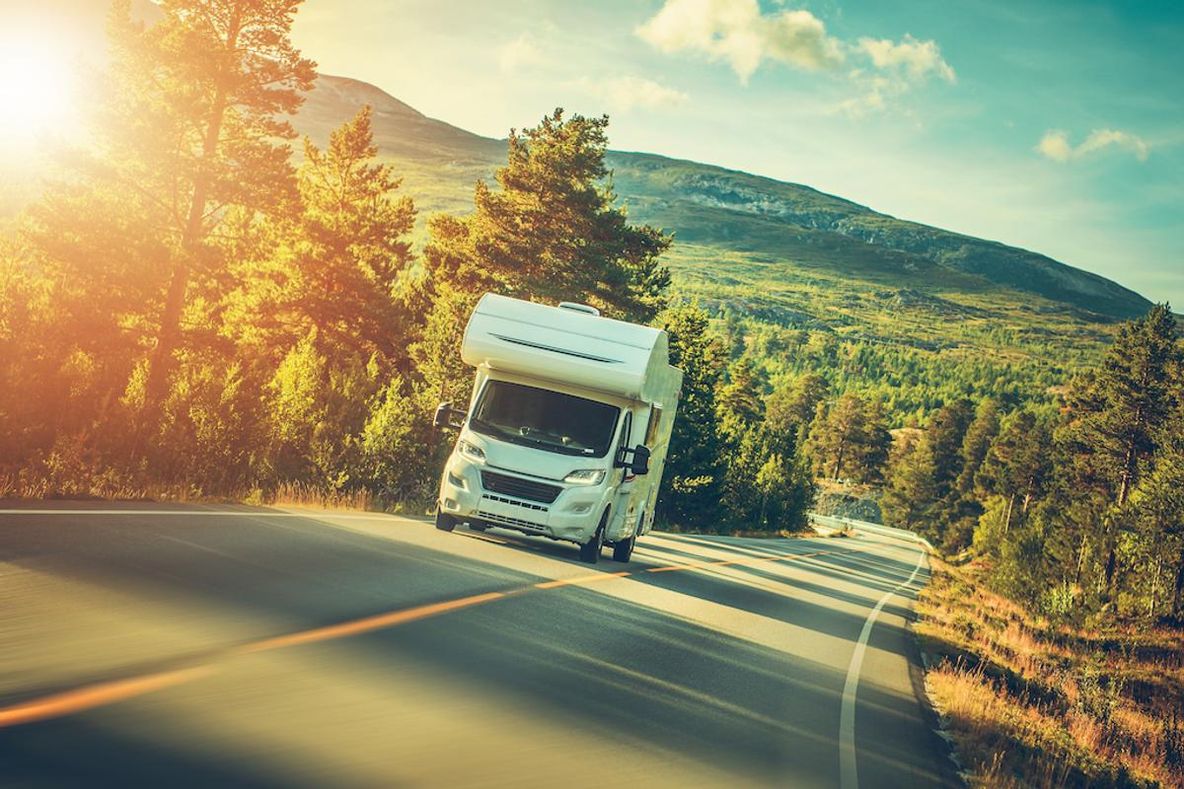
10 Incredible Routes for a Motorhome Road Trip Through Europe
Is there anything more freeing or more exciting than heading out on a motorhome road trip? You don’t have to drive along the Great Ocean Road or Route 66 to get that feeling though: There are amazing tours hidden all across Europe, too. As a bit of inspiration for your next adventure, we’ve put together this list of incredible motorhome routes across Europe.
1. Follow the Nibelungs through Germany
The Rheinische Sagenweg is one of Germany's most spectacular tourist routes. It follows the Rhine river, traversing around 580 km between Dusseldorf and Mainz . The almost melodramatic natural scenery, such as the Lorelei and the Laacher See lake, have inspired many artists’ tales and legends, and these places haven’t lost any of their mystical charms over the centuries. With around 100 sightseeing attractions across nearly 50 different places, you’ll be whisked away on a trip through history.
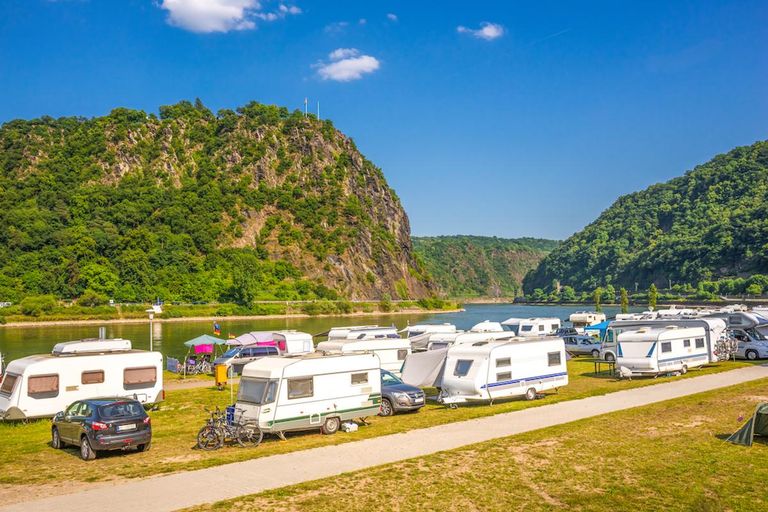
Camping near the Lorelei in the Middle Rhine Valley
Discover German campsites
2. Atop Italy’s Peak
The Passa dello Stelvio (or Stelvio Pass) is Italy’s highest paved mountain pass. It connects the South Tyrolean town of Bormio in Lombardy with the municipality of Prato allo Stelvio . This route is one of the most impressive scenic mountain roads in the Alps: In addition to the beautiful mountainscape, the Piz de las Trais Linguas (“peak of the three languages”) and the roaring Saènt waterfall , there are numerous challenging curves that passionate motorhome drivers are sure to love.
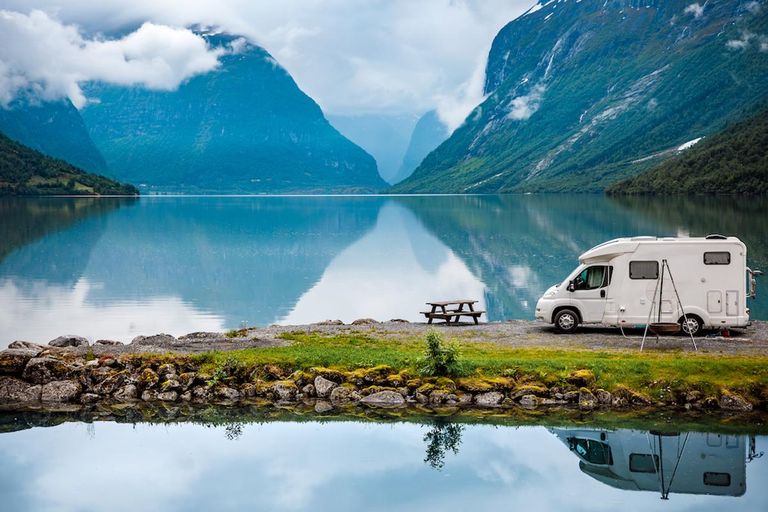
Camping in the mountains
Find campsites in Italy
3. Over French Mountains and Past Palm Trees
The most famous French motorway connects Thonon-les-Bains on Lake Geneva with Menton on the French Riviera. The Route des Grandes Alpes traverses 16 alpine passes and ascends about 1 6,000 metres until finally, after about 700 km, you arrive at your final destination on the sunny Mediterranean coast. Some of the highest peaks in the Alps are part of this route’s imposing mountainscape, including Col de l’Iseran , which stands at an impressive 2,764 metres tall. Depending on the season, you can even watch the Tour de France cyclists from your motorhome.
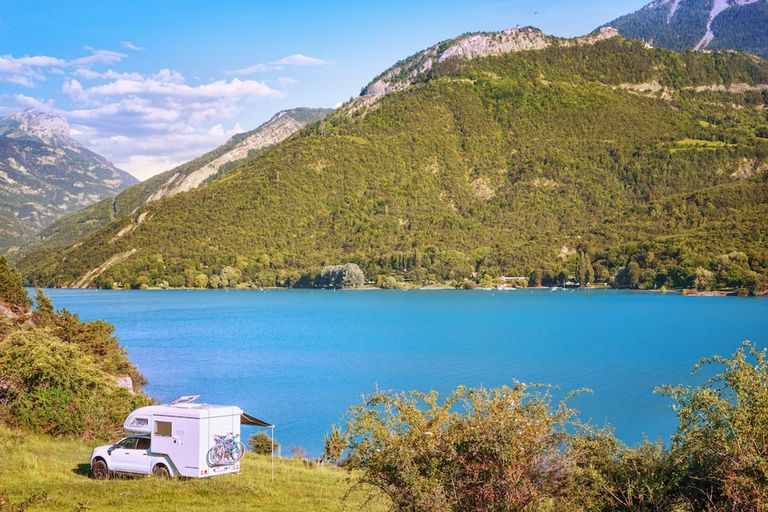
A tranquil spot by the Lac de Serre-Ponçon
Find your favourite French campsites
4. A Trip Across Northern Europe
One of the oldest scenic routes in Scandinavia , the King’s Road has always been Northern Europe’s most important east-west connection. From the Norwegian mountains all the way to Saint Petersburg , Russia , this route travels via Oslo , Stockholm , the Swedish Åland islands and the Finnish capital of Helsinki . Thanks to the variety in scenery — from the capital cities to the diverse landscapes — you’ll never get tired of travelling along the route’s nearly 1,450 km long Scandinavian section.
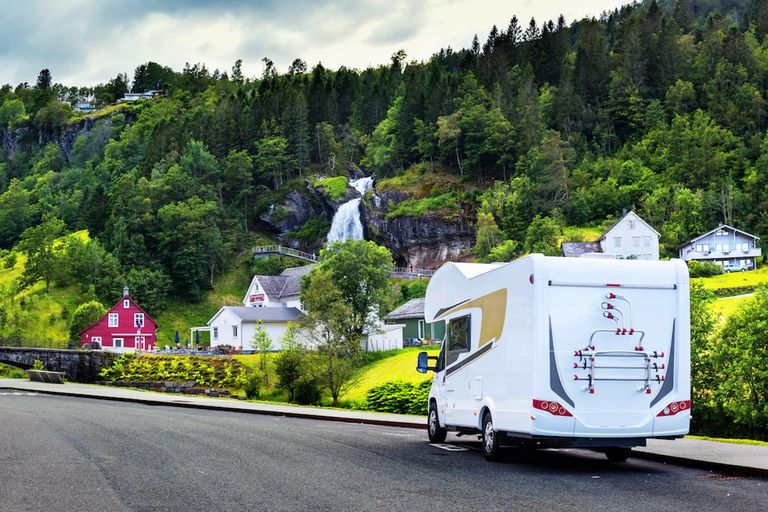
A motorhome near the Steinsdalsfossen waterfall
Discover campsites in Norway
5. Iceland: Under the Northern Lights
You can drive around all of Iceland in about 14 hours via the Ring Road , but if you take your time travelling the 1,300 km route and make plenty of stops along the way, you’ll discover the most impressive sightseeing attractions that Iceland has to offer. Numerous spectacles of nature, like the roaring waterfalls Gullfoss and Seljalandsfoss , and the capital city, Reykjavik , await you here. In the months around the solstice, particularly along more rural sections of the route, you may even get to see the colourful Northern Lights dancing in the sky.
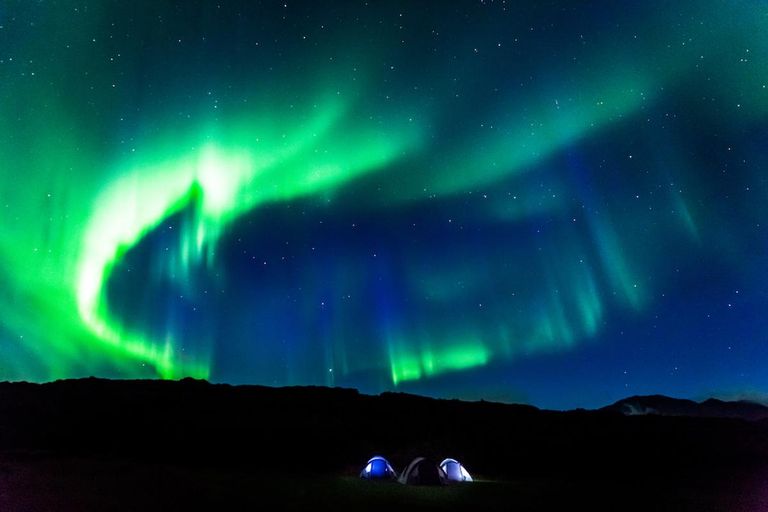
The Northern Lights in Iceland
Find campsites in Iceland
6. Spain’s Street of White Villages
The Ruta de los Pueblos Blancos crosses the Andalusian mountains from Arcos de la Frontera via the Sierra de Grazalema Natural Park and the municipality of Zahara de la Sierra . This circular route leads you through about 30 snow-white villages with an Arabian style of architecture, nestled in the mountains amid lush greenery and gnarled olive trees. The Pueblos, like Benaocaz, for example, tell the stories of their Moorish builders and give visitors a glimpse of ancient Spain .
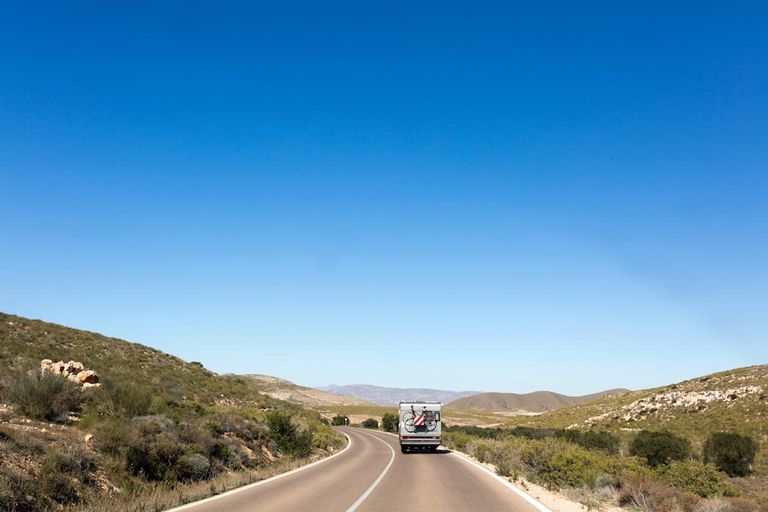
Driving through the Cabo de Gata-Níjar Natural Park
Discover Spanish campsites
7. Following the Path of Empress Elisabeth of Austria
One of Central Europe’s most majestic routes, the Straße der Kaiser und Könige (The Route of Emperors and Kings) connects medieval Regensburg in Germany to the Hungarian spa town of Budapest . Unlike those travelling by boat, when you travel by motorhome, you’ve got the advantage of being able to stop anywhere along the Danube river . In addition to seeing cultural highlights like Passau , Linz , Vienna and Bratislava , you should make sure your itinerary includes long walks through the river valley’s gorgeous landscapes .
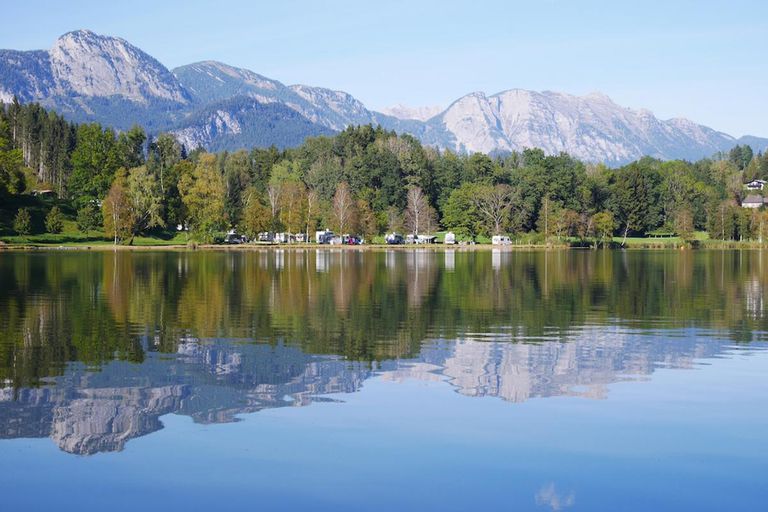
Pristine nature along the Austrian lake, Putterersee
Find your perfect pitch in Austria
8. The Croatian Pearl of the Adriatic Sea
The Croatian Adriatic Highway from Opatija to Dubrovnik is a mountainous coastal path. With medieval cities, like Zagreb and Split , and the Plitvice Lakes National Park along the route, you have plenty of opportunities to take long breaks. With the mountains on your left, the azure-blue Mediterranean Sea on your right and countless curves, motorhome drivers will have a great time driving this route.
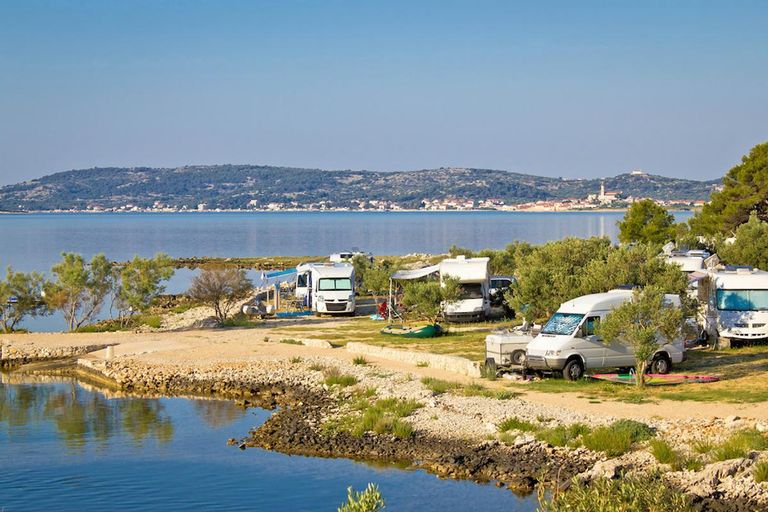
Gorgeous sea views in Croatia
Explore Croatia's campsites
9. A Tour of Ireland’s Coast
Covering more than 2,500 km from Derry in the north to Kinsale in the south, the Wild Atlantic Way is one of the world’s longest designated coastal roads. Ireland’s shores greet you with steep cliffs and narrow roads that wind their way through the green scenery. Formed by the awesome power of the Atlantic Ocean , bays like Ashleam Bay or Malin Beg are always worth a detour. Feeling adventurous? We dare you to take a dip in the icy Atlantic waters!
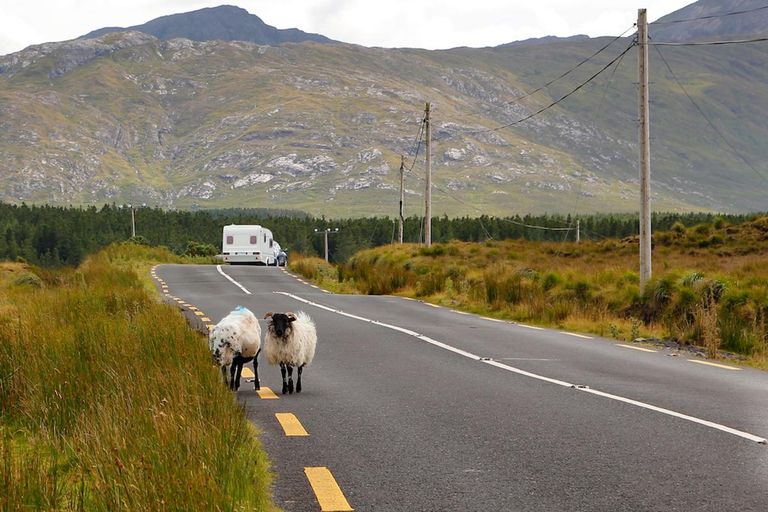
Experience Ireland's natural beauty from your caravan
Find campsites in Ireland
10. Through the Highlands
The West Highland Way is one of the first long-distance paths to cross the Scottish mountainscape, and it is a dream for all walkers and hikers. But you don’t have to be on foot to make your highland dreams come true: From Glasgow , you can drive your motorhome north to Fort William (about 180 km) via the A 82 motorway. The road passes by shaggy sheep and the legendary Loch Lomond , and it takes you through the famous Glen Coe.
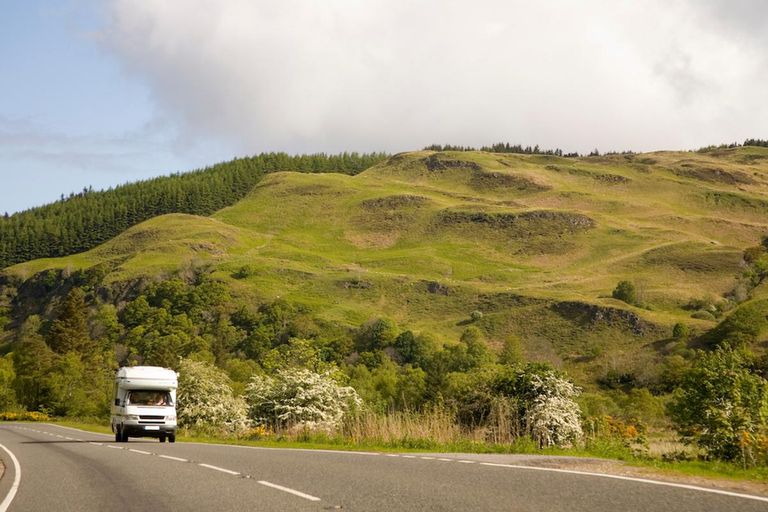
The Scottish Highlands
Discover campsites in Scotland
Did you know that camping.info has hundreds of campsites you can book online? Here are the campsites you can book online.
16 Best Campervan Journeys In Europe

Your changes have been saved
Email is sent
Email has already been sent
Please verify your email address.
You’ve reached your account maximum for followed topics.
5.4 Magnitude Earthquake Wakes Up Lisbon Early Monday Morning
Torch lake sandbar: the good, bad, and ugly, no beating the heat: 7 cities that could soon be uninhabitable with high temps, read update.
Best Routes For A European Campervan Journey
- Campervan journeys in Europe offer a low-cost way to explore scenic destinations and beautiful landscapes, away from the city streets.
- Routes like Slovenia & Croatia, Transfăgărășan Highway in Romania, and the Wild Atlantic Way in Ireland are worth adding to your European itinerary.
- From the French Riviera to the North Coast 500 in Scotland, there are plenty of options for campervan road trips that provide flexibility, affordability, and unforgettable experiences.
While the “Vanlife” craze is taking off in North America, campervan journeys around Europe have been a popular way to see the continent at a low cost for years. Spend 1-2 weeks or a couple of months roaming Europe in a cozy campervan while taking in the beautiful landscapes travelers often miss when sticking to the city streets.
UPDATE: 2023/08/22 12:29 EST BY NICHOLAS MAYAMBA
Europe is home to numerous scenic destinations worth checking out, and campervan journeys present an exciting option to explore them without breaking the bank. In this updated list, find out more road trips worth adding to an adventurer's to-do list during a European itinerary.
Related: Road Trip Enthusiasts: Here Are The 10 Countries With The Best Road Trips In The World
16 Slovenia & Croatia
Slovenia is overlooked by many travelers in Europe in favor of nearby Croatia or Austria. However, Slovenia and Croatia together are the perfect route for a European road trip with beautiful historic cities and beaches on the Adriatic Sea. For a 10-14 campervan journey, pick up a vehicle in Dubrovnik and spend three days on the coast , appreciating the scenery and exploring filming locations for Game of Thrones . Then, drive north to Split and Zadar before continuing to the scenic Plitvice Lakes National Park.
Cross the border into Slovenia and explore the Julian Alps and scenic Lake Bled. Rent a canoe in the early morning and paddle out to the center of the lake for the best views. Finally, explore the capital of Slovenia, Ljubljana.
15 Transfăgărășan Highway, Romania
Romania doesn’t get much attention from international travelers, but it should. This vast Eastern European country has a beautiful capital city but also expansive, lush green landscapes and highways that are easy to travel to. Rent a campervan for pickup at the Bucharest airport before embarking on the epic Transfăgărășan highway drive. This road takes travelers through the Carpathian Mountains. The road is nearly 100 km long and is one of the most iconic in Europe, twisting and turning through the rolling terrain of Romania. Plan to make stops at Balea Lake, Capra Tunnel, Vidraru Dam, and Poenari Citadel along the way.
14 Wild Atlantic Way, Ireland
The Wild Atlantic Way is Ireland’s most famous driving route and can easily be driven in 5 days to 1 week, starting from Dublin. However, for travelers who want to take their time and spend more than one night at a destination along the way, turning this into a 2-week adventure is a more relaxing choice. The route is 2500 km from County Donegal to County Cork and takes travelers along the best sights of Ireland’s West Coast, including the Cliffs of Moher, Kylemore Abbey, and Slea Head.
Related: 10 Places You Should See In Ireland During A 7-Day Trip
13 The Fairy Tale Road, Germany
Germany is one of the largest countries by area in Western Europe, so exploring it in a campervan is a great way to see the natural beauty usually missed when sticking to cities like Berlin or Munich. Rent a campervan and drive the Fairy Tale Road in Germany, which starts in Frankfurt. The quiet road runs through the countryside and charming German towns like Steinau, Marburg, Kassel, Gottingen, Hamelin, and Bremen. From Bremen, travelers can easily continue onto Hamburg and venture north to Denmark.
12 The Ring Road, Iceland
Iceland’s Ring Road is the best drive in the country, taking travelers around the island’s perimeter in just 7-10 days. While it’s possible to do this trip in a rental car and book Airbnbs or hotels, choosing to do the journey in a campervan offers the flexibility to stop at any campsite and stay immersed in the otherworldly landscapes of the Land of Fire and Ice. Top sights to see along the way include Skogafoss, Jökulsárlón Lagoon , and Diamond Beach.
Related: The 10 Most Beautiful Stops Along Iceland's Ring Road
11 The French Riviera, France
Get away from the busyness of Paris and embark on a romantic campervan journey through the South of France on the French Riviera. In just one week, travelers can easily stop at beautiful cities like Nice, Eze, Cannes, Cote d'Azur, Monaco, and Antibes while spending the night in their campervans to save money on accommodation. This is a fantastic way to see the South of France on a budget and with the freedom to wake up in a new spot every morning.
10 The North Coast 500, Scotland
The North Coast 500 is named for the 516-mile route around the Northern coast of Scotland. It’s possible to drive this route in just five days but lengthening the trip permits travelers to make more stops and appreciate the scenery in various parts of the country. Some top spots to pause along the way are Falls of Shin, Coldbackie Sands, Smoo Cave, and Handa Island. The route is so popular it has attracted more than 29,000 visitors since its inception, but there’s still plenty of room for everyone on the road.
9 Algarve Coast, Portugal
Travelers looking for a budget-friendly campervan trip in Western Europe can skip Italy’s coast and head to the South of Portugal instead. Most international travelers will arrive in Lisbon, where it’s easy to pick up a rental van from the airport. Then, drive south on the E1 to Lagos, which takes between 2.5 and 3 hours . From Lagos, travelers can choose to spend time camping and swimming along the Algarve Coast for a few days before continuing the drive to Faro. If time permits, cross into Spain and spend a few days in Seville before returning to the campervan and heading home.
8 La Route Des Grande Alpes, Switzerland
This route takes travelers through the French Alps between the French Riviera and Lake Geneva. Visitors will drive their campervan through the Alps from North to South or South to North, depending on which side they start the route from. The road has 16 passes, some of the highest in the Alps and spans 684 km from Thonon-Les-Bains to Menton. The journey takes at least 2-3 days by car, but travelers can spend much longer exploring the historical monuments and Alpine villages along the way.
7 Whitehaven To Silloth, The Lake District, United Kingdom
There are plenty of scenic road trip routes through The Lake District in the UK, but travelers who want to drive their campervan along the coast will love the journey from Whitehaven to Silloth. The drive is 26.7 miles long and follows the A595 and A596 along the Solway Coast from Whitehaven. Travelers will pass through the quaint town of Maryport and can stop off at the picturesque Allonby's Beach before arriving in Silloth.
6 Finland Up To Nordkapp
One of Europe's most scenic caravan journeys is arguably traveling up through Finland to Norway. This route takes one through the boreal forests of Northern Europe and even through Santa's North Pole Village in Lapland . Along the way, visitors see sprawling forests where the roadsides are populated by reindeer as one penetrates north into Lapland. Mountains don't appear until one approaches the northern border with Norway, and from there, one can keep on going to Nordkapp - the northernmost point of Europe .
5 Travel Down The Coast Of Norway
Norway is arguably the most stunning road trip possible in Europe. Travel down Norway's pristine and stunning coastline and explore many of the world's most picturesque and dramatic fjords. Keep in mind that Norway is expensive, but it is also legal to camp almost wherever one likes (if one would like to save on camping fees). Be sure to detour to see Troll's Tongue while traveling in Norway .
4 Andorra & The Pyrenees
The Pyrenees are one of the great mountain ranges of Europe, and they form the border between Spain and France. One of the fun things to discover while exploring the Pyrenees is the tiny alpine country of Andorra (it is basically a country that is a collection of ski resorts). The Pyrenees are not as dramatic as the Alps of Switzerland, France, Italy, and Austria, but they are stunning and should be on anyone's bucket list.
Turkey is sometimes counted in Europe, and it is a top destination to go for a campervan journey. The country is just bursting with attractions to see and explore (think about endless Roman ruins, ancient Greek ruins, Pamukkale, crusader castles, some of the Mediterranean's best beaches, and some of the oldest manmade settlements known. Turkey has a great highway network and is a very rewarding place to explore.
2 Switzerland & Northern Italy
Starting in the mountains and ending at sea, this lovely European campervan journey takes travelers through exciting destinations. From Switzerland's biggest city, Zurich, drive through the country to the towns of Lucerne and later Bern before crossing to the Italian city of Turin. Admire the impressive architecture in the city and sample its eclectic cuisine, then continue with the journey to the fashion capital of Milan . Find something cute to buy and drive off to Bologna's historic town before wrapping up the trip in Venice, where so many attractions await .
Related: 10 London To Rome Road Trip Stops That Reveal Ancient History And Breathtaking Scenery
1 Italy Roundtrip
Italy's is among Europe's top destinations, and going around the country explores campers to beautiful cities with a rich history, unique culture, and exotic destinations. Starting in Milan, this exciting road trip will last 2 to 3 weeks, depending on how much there is to see and do along the way. Drive the van to Genoa, check out the beautiful harbors, then head to Pisa through Cinque Terre. Continue towards Florence to admire its majestic art pieces, continuing to Siena and Rome. Afterward, he's to Naples and cap off the Italian itinerary on the Almafi Coast.

Europe Motorhome Tour – 6 Countries in 3 Months
Are you planning a motorhome trip to Europe, but don’t know where to start?
We’ve got the perfect Europe motorhome tour and itinerary for you! Whether you’re in a motorhome, campervan or even a car with a tent, our flexible three month European itinerary will take you on an incredible road trip around the continent.
From dramatic mountains, the Adriatic and Mediterranean seas, crystal clear lakes, lively and cultured cities and some spectacular driving roads, this journey will share breathtaking landscapes, exciting adventures and iconic sights as you tour Europe.
What you get with this tour and flexible itinerary;
- 44 detailed pages covering 87 days , including what to do and see, and where to go along the route + packing tips , trip notes , Schengen info and checklists .
- A 6300km route between campsites and attractions.
- 31 recommended campsites and aires suitable for motorhomes.
- 200+ attractions and points of interest along the route.
- Ready to use interactive Google Map with route, campsites and attractions detailed .
- Twelve insider tips that you won’t find in guide books.
- Five scenic driving roads plotted into your interactive map.
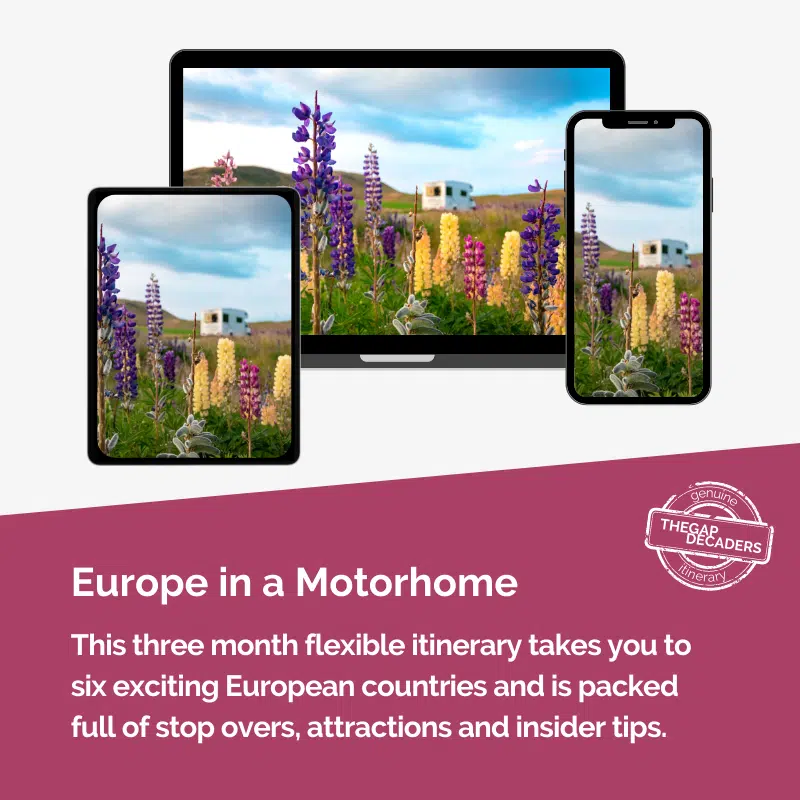
Europe Motorhome Tour & Itinerary
No time to research? Don’t worry, we’ve got that sorted!
Grab our three month flexible itinerary, packed with campsites, attractions and insider tips.
Go on tour knowing your route and stops are planned, with driving routes and campsites marked out for you on your interactive map.
Make the most of your holiday and let us do the planning for you.
+immediate download + read on any device + free lifetime updates
Price £24.99
Where Are You Going?
Germany – austria – slovenia – croatia – italy – france.
This itinerary starts in medieval Trier and heads south through beautiful Germany, taking in the Black Forest and Bavaria, before crossing the border into Austria and the Alps.
Taking in a couple of high Alpine passes, you’ll meander into Slovenia for stunning rivers and lakes, perfect for water sports or just messing about on the water.
Slovenia gives way to gorgeous Croatia, where you can grab some beach time and visit the picture perfect islands which are dotted along the stunning coastline.
Cross the Adriatic from Dubrovnik to Bari in Italy, and wend your way north visiting Rome and a couple of iconic Italian landmarks before reaching Tuscany, possibly one of the most breathtaking places in Europe, and its’ cultured and historic cities.
Next up is France, where you’ll visit lakes, gorges, rivers and beau villages before heading home.
Along the route, you’ll find suggestions for how to spend your time – whether you’re a history and culture vulture or an adventure seeker, you’ll find plenty to keep you busy with our itinerary.
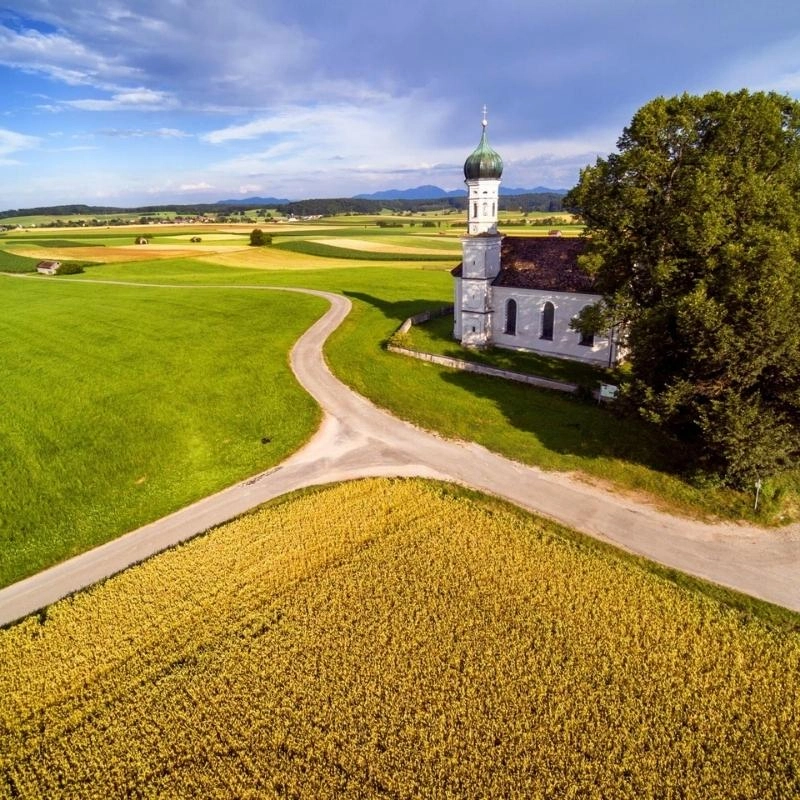
You May Also Like…
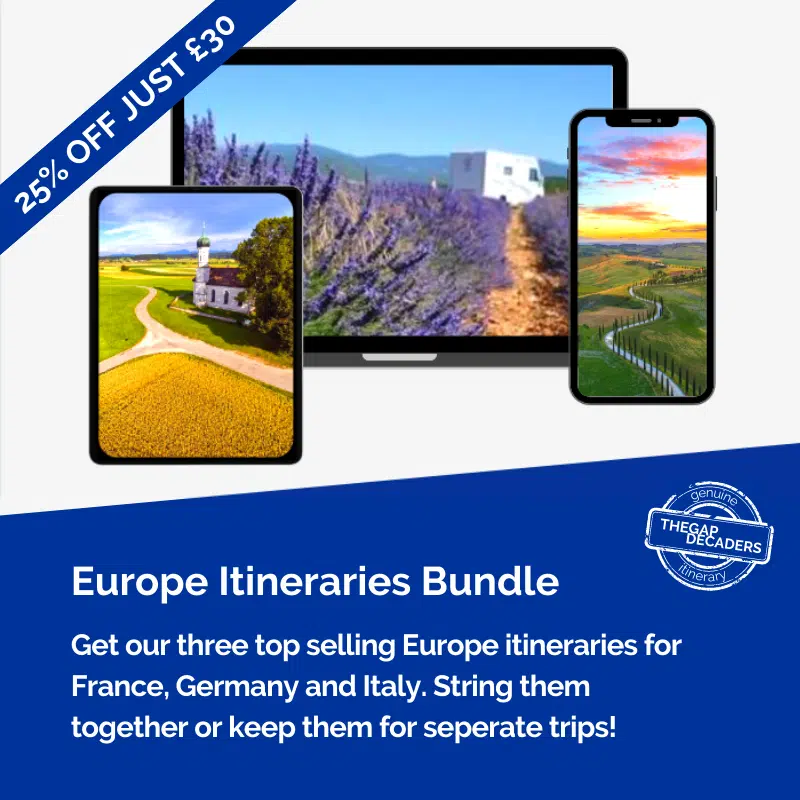
Why Buy Our Itineraries?
- We have years of experience camping, caravanning and motorhoming in the UK and Europe. We’ve also lived in our motorhome full-time for three years…meaning we’ve visited LOTS of places and have gathered lots of information and insider knowledge.
- As well as visiting all the places we write about, our itineraries are extensively researched to ensure they are accurate and provide up to date information.
- Our itineraries come in PDF format that can be viewed on any device, just download and get reading.
- All the links in our itineraries are clickable, meaning you can check up on a particular campsite or view the map directly from your phone or tablet.
- We offer free lifetime updates. No catch, completely free, forever. Whenever we update an itinerary, you will be offered the chance to download the new version free of charge.
- Our site and payment gateway is 100% secure. You can pay safely and risk free with a debit or credit card or use Paypal.
- If you are not satisfied with your itinerary, we offer an uncomplicated, no questions asked refund within 7 days.
Frequently Asked Questions
What happens when i check out.
- You will be taken directly to our secure payment gateway, where you are asked to enter your email and payment details.
- If you want to receive automatic updates, tick the box and you will receive an opt-in email.
- Once this information is entered and your payment is accepted, a download button will appear on your screen.
- Click this if you are using the same device on which you will view and use the itinerary. If that’s not the case, don’t worry, you’ll also be receiving an email within a few moments of purchase with a download link.
- You have three attempts to download your itinerary. If you need more attempts, please email us .
What happens when I download the itinerary?
When you download the itinerary, it will appear on your screen in a web browser, such as Chrome or Safari. Select the share button and save to your phone, tablet, laptop or computer.
Can I print the itinerary?
Yes, but it will use quite a lot of ink as our itineraries also include images.
What if I’m not happy with my purchase?
We want you to be 100% satisfied, but if you’re not, drop us an email and we’ll sort a refund for you.

Travel | Explore | Inspire

The Ultimate Guide to Travelling Europe in a Campervan

Disclaimer: Some of the links in this post are affiliate links, meaning that if you click through & make a purchase, I will receive a small commission at no extra cost to you.
Has it been a dream of yours to travel Europe in a Campervan? Then look no further – this comprehensive blog post is FILLED with tips and advice on how to have the best van adventure ever.
We spent 8 months living in our beautiful Ford Transit campervan conversion exploring Europe, and now you can too with the help of this guide. We get asked a lot about how we did it and what it costs so we are sharing our experiences, the good and bad with you!
So if you are curious about what it takes, already have a camper van or want to add a road trip through Europe to your bucket list – dive right in. We are not leaving any details out, it’s stuff like this we wish we had known before we left on our trip.
Why Travel Europe in a Campervan?
How much does it cost.
- What to Consider Before Buying a Campervan?
Converting Your Van
Our route through europe, where to camp in europe, the best campervan resources, our van essentials – must have items, departure checklist.
- Petrol, Tolls and How to Avoid Them
Mobile Data
- Our Favourite Free Camping spots with GPS Co-ordinates
Location Highlights
Our whole route in detail.
- Freedom! Whether you buy a used motorhome or decide to build your own, we think the freedom that this gives you when travelling is the best feeling in the world!
- Being able to sleep wherever you want- next to amazing beaches, mountain views and lakes. You name it – having a van allows you to park and sleep in places that you never could do on a normal trip.
- Choose how long you want to stay and where, while having your own home to sleep and cook in also saves money.
- You can take everything you need with you for your favourite activities – we took surfboards, bikes, skateboards and snorkelling kits. Always be prepared for an adventure!
- Outdoor living and camping life with all the home comforts! We loved how homey and comfortable our van was.
- Travel for longer, spending less money.
Our daily budget was approximately £25 per day. This meant for 8 months we had a budget of £6000 for food, gas, petrol, tolls, parking/camping and sightseeing between the two of us. This budget for us, was super easy to stick to. We were in it for the long haul and once you are on the road you realise how little you actually need to spend in order to have an incredible time.
Our camper van cost us about £6500 to purchase and convert. This might seem like a big investment including the daily budget, but once you sell your van you get that money back. Think how much money you would be spending on transport and hotels, the hours wasted on public transport and not being able to stay in some of the most insanely beautiful locations in Europe.
What to Consider Before Buying a Campervan
- Can you stand up in it?
Phil is 6ft 6 so this was a tricky one but most High Top/Roof vans have exactly that amount of headroom. This will make your time in your van much more comfortable. Medium Roof vans also work for some people. If you plan on spending a long time travelling in your van you will 100% want to be able to stand up.
- Reliability !
We spent hours researching the pros and cons of various types of vans and which models might suit our needs. Try and get something with a good service history and ask a garage to give it a once over. Is it easy to get replacement parts abroad, how many miles on the clock etc.
- A good night’s rest
A comfy night’s sleep was high on our list as we were planning to be in the van every day for 8 months. Luckily building our own van allowed us to plan our bed layout and what mattress we wanted. We loved our double memory foam bed so it was worth the effort researching!
- How self-sufficient do you need to be?
We wanted to be able to go fully off-grid for a few days at a time without having to fill up on water, empty our toilet and get supplies. So we had a fridge, large water storage, solar energy and running tap to keep us sustained.
- Do you want to live off-grid?
How much electricity will you use or need – will you go solar and be a true off grid explorer? Getting a leisure battery that runs separately from your van’s battery will give you so much extra power, you get even more time to be off-grid by having solar panels.

It took us about 2 months working 6 days a week to do our Ford Transit campervan conversion! There are so many resources out there about how to plan and do the conversion. We loved using Pinterest for inspiration on designs, watching YouTube videos for how-to guides and reading blog posts. Anyone who can use a few tools can get started from home once you have your van or motorhome. I had never used many of the tools before and built an entire kitchen from scratch.

We started off by catching a ferry from Poole in the UK to Cherbourg in France and decided on a clockwise route of Western Europe. Our plan was to drive a maximum of 1-3 hours a day between locations. This worked out pretty perfectly for the length of our trip. We stayed in some places for just one night and the ones we liked we stayed more. For example, we stayed in Paris for 3 nights and Rome for 5 nights but stops in between may only be for one night. To determine our route we would get out our resources ( Camperstop book, Park4Night app and Google) and see where looked good, had good camping spots and was within driving distance.
Looking for inspiration – discover the Ultimate Southern France Road Trip Itinerary here!

When you travel Europe you can park in places called Aires, also known as Motorhome stops. These are dedicated campervan parking spaces with varying facilities. Run by the town municipalities or privately owned they are often free or cost a couple of Euros per night. Some of the privately owned ones can have more facilities and will charge more (Up to £20 depending on where they are located.)
If you are looking at camping somewhere that has a lot of facilities then a Campsite will suit you. Things like showers, toilets, washing machines, swimming pools, scenic camping spots etc.
- Free Camping
Europe is very well suited to free camping. This is where you park somewhere that is not a designated Aire or campsite. You are parking your van in a space that allows overnight parking and has to be self-sufficient. These could be side roads, beach car parks etc. You will have no facilities and can generally park for free for a night or two. The rules change from country to country and you must respect the local authorities. Most importantly, in order for free camping to remain allowed in Europe you must always leave no trace , never leave rubbish behind and be respectful of noise.

Camperstop Europe Motorhome Guide
This was such a great resource for us when we were on the road. Camperstop is a book you can purchase that has over 8000 of the Aires in Europe listed with GPS coordinates. You will find that certain countries have more aires than others so you may have to mix up the types of places that you stop.
If you are going to buy one resource- let it be this o ne .
Campercontact
Campercontact is a website and app that is run by volunteers. You can search for Aires all over Europe just by searching by location. There are photos, reviews and GPS coordinates.
When we were in Germany, about 3-4 weeks into our trip we met someone at an Aire who happened to mention the app Park4Night. From that moment on it became one of the best resources we had for our trip in finding free camping. The information on the app is user-generated, with people stating GPS coordinates of where they managed to stay for free! People can then rate these locations for future users. These locations range from side roads with free parking to cliff sides overlooking incredible beaches. It saved us an incredible amount of money and allowed us to stay in some of the most insanely beautiful locations that you would not normally be able to stay.
Ensure that you get a good GPS device with up-to-date maps for all of the countries that you are going to visit. As most of the information for where to stay is given in GPS coordinates this makes it a lot easier navigating than using maps on your mobile phone. You will also be able to see where there are toll roads (and there are a lot) and how to avoid them. It will also inform you of the local speed limits for each country.
Big Road Atlas – Europe
We also found it incredibly useful to have a paper map. As our route was not set in stone, we would only plan where we wanted to visit a few days to a week in advance. You can plot your route on the paper map, which is also a lot of fun. It also becomes handy if for some reason your GPS device stops working and you need to go old school.
Get your Big Road Atlas he re .
A great place to start to get your design ideas is Pinterest – there are thousands upon thousands of boards where you can get ideas. We had a particular style in mind as we needed space for our bikes and surfboards inside the van. It served as a great resource for us and helped in the planning process greatly. Every van design is so unique to each owner and it’s incredibly inspiring to see everyone’s camper van hacks.
Fellow Travellers
Ask other people who have done this before for their advice. If you don’t know anyone personally there are plenty of blogs, forums, and Instagram pages all dedicated to #vanlife. Like this one for example. Don’t forget to pin this to Pinterest for reading later.
Where to Shop for Food
Without a doubt the best place to shop for food in Europe is Lidl. This supermarket is in practically every country, has large car parks and cheap and delicious food.
Portable Toilet for Campervan
We debated this essential a fair bit before we decided to get one. Phil didn’t think we needed one and I did. In the end, we realised it was a must-have and enabled us to have a lot of off-grid camping experiences. It is easy to build into the framework of the van so it stays hidden. It is super easy to empty and clean. We would never do this trip again without one.
Get the Portable Toilet we used he re .
Portable Electric Camping Shower
There are many different ways that you can have a shower in a van these days, no matter the size. Our shower was an outdoor one we plugged into the back of our van using the power generated from our leisure battery. When the back doors to our van opened we simply placed a curtain rod with a shower curtain between the doors for privacy.
Get the Portable Electric Camping Shower we used her e .
Campervan Fridge
Something we also debated whether to get because they cost quite a bit of money, was a fridge. Deciding whether to get one depends on how long you are going to be travelling for. As we were going for 8 months we deemed it necessary, we especially appreciated it in the summer heat wave enjoying our cold beers. There are several things that you have to take into account when getting a fridge. Does it need a flat surface, will its temperature remain low enough for the country you are visiting, we recommend doing a lot of research.
We absolutely loved our campervan fridge – this is the model that we got he re .
Solar Panels for Campervan
We fitted 2 of these to the roof of our van and it kept our leisure battery charged long enough for us to be able to camp off-grid for quite a few days. If you want to reach some off-the-beaten locations and not rely on plugging your van into electricity at campsites then we highly recommend fitting these. We did not need to plug in our van to external electricity sources our entire trip.
Your Vans Security
Van theft in Europe is quite common in certain areas and something you should definitely be aware of. Especially if you are keeping all your worldly belongings inside.
We fitted a sliding bolt lock to the inside of our back doors as an extra precaution. You will also want to consider where you park your van and always carry your important belongings with you (passport etc).
We unfortunately had our van broken into when we were in Portugal. They broke open our side door window and climbed in taking the closest belongings they could find. This unfortunately happened to be my empty leather bag I treasured which had my wedding ring inside, my backpack with our DSLR camera, our hard drive with 6+ years of travel photos and our wash bags. These just happened to be left inside on this day when we visited the beach for just 1 hour. When we visited the local police station they were not surprised this had happened as it was very common in that area.
All we could have done was park somewhere more populated and not have left our belongings inside. We parked in a beach car park but right at the back because we wanted to camp there in the evening. Luckily for us, there was a campervan shop close by so we could fix our window easily. But always be sensible, park in busy places when leaving your van and look after anything important.
A Good Mattress
One of the best purchases we made was getting a proper memory foam mattress. As Phil is quite tall we wanted to sleep lengthways and you can purchase shortened memory foam mattresses designed for boats which fit perfectly in a camper. When you don’t have a huge amount of living room this makes your time in the van so much more comfortable.
Mosquito Net
Having a mosquito net is definitely worth investing in. If you plan to travel when it is warm outside then you will more than likely want to have your windows open or even your doors. We had a mosquito net built into our window but would have loved one for our doors.
At dusk the mosquitos love to invade your van if you have the doors open – imagine your van being 40-50 degrees inside and you want to cool it down. Once you settle down to sleep, that is when you will spend all night irritated by buzzing noises flying past your ears every few minutes. Take heed of this advice, many nights were ruined by mosquitos invading our van.
Ventilation
Temperatures during summer in your van can get particularly high. The hottest our van reached was over 50 degrees inside during the peak of summer. We had a roof window installed which helped but what made a huge difference was having a fan that we attached to the wall. We didn’t manage to get the fan until halfway through the trip, a huge mistake not having it before we started.
Get a fan like the one we used her e .
Collapsible Table and Chairs
Grab a couple of collapsible camping chairs and a table to complete your alfresco dining situation. The chairs can be used for multiple purposes and just extend your living space. A collapsible table also means you don’t need a permanent fixture inside and creates more space.
Get the table and chairs like we used here. For the table click here and for the chairs click h ere .
Power Source
So, you can go down two routes when designing your van. The simple DIY route is where you just use battery-powered lights and will charge your devices when you are driving using the cigarette lighter socket. The more advanced route is to have a leisure battery that supplies electricity to your lights, fridge, shower and electrical sockets so that you can charge devices when the engine isn’t on. Combine this with solar panels and you won’t need to charge the battery by driving much.
Gas for Cooking
We debated about what type of gas supply to get for our cooker for quite some time. For you, it will depend on how long you are travelling.
If you are planning on going on a short road trip, anywhere up to 1-2 months then I would say that you can buy a normal camping gas cooker and canisters.
If however, you are planning on a longer journey, as we did, then you might want to consider purchasing a refillable LPG canister. Many of the European petrol stations have LPG pumps designed for filling up cars and you can buy the appropriate canister adapters for each country. It is a lot cheaper and lasts a long time, we only had to fill up twice in 8 months. Be warned though, if you convert a camper van, filling these LPG canisters can be tricky if they are located inside your van. This is because some petrol stations deem it dangerous to do so.
Van Insurance
Ensure that you have comprehensive campervan insurance before you depart. If you plan to travel for an extended period of time outside of your home country then you will most likely need to purchase a specialised insurance policy.
It gets quite tricky determining if you need a campervan insurance policy or a normal van insurance policy if you have converted your camper. The way that this is determined is dependent on what permanent fixtures your van has in place and then the DVLA classify your vehicle. If you have an accident and your van is not insured correctly this can cause problems when it comes to claiming. So you have to ensure that your policy covers you.
We used Adrian Flux as they were the only company that would cover us for the length of time that we needed in Europe. They were also the only company that offered us a policy for a campervan IN conversion (i.e. not completed).
This may be different if you are from the UK now due to Brexit so it is worth shopping around and getting quotes on who will cover you. People often will get a camper van insurance policy over a normal one because it is a little cheaper. Obviously, if you have a standard RV then it will be a much simpler process than insuring a self-built camper.
You can find details for classifying your vehicle type with the DVLA here .
Breakdown Cover
We cannot rate this product highly enough. For a couple of hundred pounds for an 8-month journey, this cover paid for itself. Let me tell you why…
Unfortunately for us, just 3 weeks before we were due to return to the UK our van broke down in Northern Spain. Yes, we managed to travel for over 7 months across the whole of Western Europe without a problem and then on the home stretch, it went kaput!
Luckily we had European Breakdown Cover and it honestly saved the rest of our trip. They provided a week’s worth of accommodation for free, and a hire car for the entire duration that our van was at the mechanics, which was several weeks! They also provided flights home AND picked our van up from the mechanics and shipped it back to our home address.
Unfortunately, the van could not be fixed in Spain, not only were they quoting an insanely overpriced bill, they didn’t get around to inspecting the van for 2 weeks. It was on the advice of our breakdown cover rep that we get it fixed in the UK to save money. Needless to say, we think this is worth investing in. You just never know what is going to happen and it can cost thousands to either fix your van and/or ship it home.
Travel Insurance
As with any trip, it’s super important to get a travel insurance policy for the duration of your trip. As someone who has had to claim on travel insurance policies in the past, I can attest to their worth and importance.
European Driving Kit
Most countries in Europe will require that you have a driving kit in your car at all times. These will include things like First Aid Kits, Visibility Vests, and Warning Triangles. You may also need to apply headlamp stickers when driving in certain countries. Check what you need for each country you are planning on visiting and then buy the kit that has everything you need.
Get your European Driving Kit her e .
Petrol and Tolls
Petrol in europe.
This will be one of the biggest outgoings on your budget. Since you will most likely be travelling long distances, the cost of petrol does add up and takes a huge chunk out of your daily spending. Prices vary from country to country with the cheapest we found to be in the tiny country of Andorra (it is tax-free there).
These are temporary tax discs that you need to purchase before you enter certain countries. You can purchase them from lots of petrol stations before you cross the border and they are valid for varying amounts of time depending on how long you plan on being in each country. We had to purchase Vignettes for Slovenia and Austria on our route (see below for a full list of countries we visited).
2024 Update: Popular places in France (such as Paris) now have low-emission zones and if you plan to drive within these you will need to purchase in advance a Crit-Air sticker. These cost just 4.61 Euros and need to be posted to you before you travel abroad. The type of sticker you get depends on your particular car – read more about the stickers here .
Toll Roads and How to Avoid Them
Lots of the roads in Europe have tolls to pay and it is worth doing a bit of research before you embark on your route to see if you can avoid them. They can often make a journey far quicker but it is worth weighing up the prices versus time spent saved. Prices can be anywhere up to 50 euros depending on how long the route is.
For example, if you plan on using the Mont Blanc tunnel to Chamonix it costs almost 50 euros, just to travel through the tunnel! The alternative route over the mountains is not even worth considering.
However, if you take these tolls into account on your route it can help with your budget before you depart. Your GPS device will be able to tell which routes have toll roads and you can find out the costs online. You can then use your map to check if the alternative non-toll roads are much slower. Often they can be much more scenic and only a little slower.
Currently, you can use a UK sim card in Europe as if you were at home, but most mobile providers will have a cap on the data you can use. If you plan on travelling for a long time or your data runs out, then we 100% recommend using Air alo .
Airal o allows you to purchase an eSIM (digital SIM card) for over 200 countries/regions and gives you instant access to data without excessive roaming charges. We have used them in France, Canada, the United States and Mexico and it is so convenient and affordable. As the sim cards offer just data, we use Facebook/Whatsapp etc to message/call friends and family.
Get your Airalo eSIM here !
Before Airalo existed, we purchased local SIM cards in some countries as they were pretty cheap. If you encounter problems with your SIM cards it can be difficult to rectify if you cannot speak the local language. Local SIM cards are the simplest and cheapest route to take – that’s why we recommend Airalo.
There are portable wifi devices that you can purchase that allow multiple devices to access the wifi. You pay a monthly fee but these are very expensive. It ultimately depends on how much time will be spent on the internet – will it be light use researching your destination or heavy use working on the road?
Our Favourite Free Camping Spots
Iconic locations.
Italy: Bellagio, Lake Como lat.45.976601 long.9.25433, 51 Via Alessandro Volta
A car park located on a hill overlooking Lake Como in Bellagio. A short walk to town where you can catch the passenger ferry to Menaggio and Varenna. Free fresh water is available with little passing traffic. We stayed 2 nights.
Italy: Rome – Villa Borghese, Viale dl Giardino Zoologico
Imagine staying in the centre of Rome for 5 days for free! We found this spot on a blog post and it was perfect. Down a quiet street, next to the Zoo. Walking distance to Villa Borghese Park and central Rome. A diamond find for free camping.

The Mountains
France: Chamonix, Mont Blanc lat. 45.93312 long.6.884868
Great shaded wooded area, suited to smaller and larger vans than motorhomes. Nice picnic area and is close to the main road into Chamonix with biking trails accessible.
France: Les Gets, lat.46.149799 long.6.6582, 310-328 Route des Pesses
We stayed here for 4 nights for free. It’s a car park at the base of the town with access to toilets and water. It is an easy walk to town and quiet at night.
Northeast Spain: Montserrat GPS Unknown
On our way to Barcelona, we stopped for a night here. There are plenty of places to stop along the way with the most incredible views of the mountains. I recommend using the Park4Night app to find a space to park.
The Most Scenic Viewpoints
Southern France: Views of Monaco, lat. 43.734501 long. 7.40159, 1094 – 1158 Route de la Tete de Chien
If you want insane views of Monaco/ Monte Carlo park here for the night. Hike up the Tete de Chien at night and morning for incredible city views. Picnic benches are available.

Southern France: Valensole lat. 43.822179 long. 6.017428
Quite a rural spot not far from the road, shaded under trees with great views of the lavender fields. Waking up to the smell of lavender and possible farmer. Accessed via private road, very private and beautiful.

Northern Spain: Llastres lat 43.51675 long. -5.269843
Great spot with ocean views. Good BBQ area and an easy walk downhill into the beautiful fishing village of Llastres.

The Best Beach Camping Spots
Northern Spain: Ferrol lat 43.556571 long. -8.298003
Absolutely stunning beach car park location. Overlooking the ocean with direct beach access. Bins and toilets are available in season.

Belgium – Belgian Beers in Rochefort and Waffles in Brugge .
Netherlands – Lisse for Tulip Season and Amsterdam during Kings Day.
Germany – Heidelberg for history and castles. Triberg for the original Black Forest Gateaux and home of the Cuckoo Clock. Lindau in Lake Constance – just wow!
Austria – Salzburg – pretend you are in the Sound of Music!
Slovenia – Lake Bled , is such a beautiful town and a stunning lake. We would love to come back to Slovenia and explore more.
Croatia – Rovinj , a cute and colourful fishing village with incredible sunsets and seafood. Kamenjak National Park for endless nature and ocean vistas. Plitvice Lakes – the most insane set of lakes and waterfalls we have ever seen.
Italy – Alberobello , home of the unique Trulli houses. Matera – a cave town situated on a gorge, Wonder Woman was filmed here! Positano is an iconic place to visit in Italy. Pompei – visit this ancient town’s ruins for free on the first Sunday of every month. Rome and Florence for the history and architecture, Tuscany for the rolling hills and Venice for the winding lanes and Burano. A dream come true visiting Lake Como and Lake Garda. Basically, we loved all of Italy!
Southern France – Valensole for the lavender, Verdon Gorge for the most insane turquoise blue water and Tete de Chien for views overlooking Monaco. Cascade du Sautadet and Vallon Pont D’arc for water sports heaven in the Ardeche.
Southern Spain – Barcelona for Gaudi art and Tapas, Valencia for the Art Science Park and Nerja for dreamy town beach vibes. Puerto Banus for high fashion and luxury, Tarifa for kite surfing heaven and Seville for flamenco!
Portugal – Benagil caves , a huge cave with a hole in the roof and a beach inside and Ponta da Piedade for incredible coastal views. Lisbon for city chic and Pastel de Natas (Portuguese egg custard tarts) and Sintra to visit Pena Palace. Porto is a coastal city, you must see the Livraria Lello, marvel at the stunning tiles and cross the Dom Luis bridge.
Northern Spain – We adored Northern Spain for the Pico de Europas , San Juan Gaztelugatxe and San Sebastian . Incredible hiking and Pintxo’s – like tapas.
France: Cherbourg – Cambremer – Paris – Epernay (Known for Champagne)
Belgium: Rochefort – Dinant – Namur – Brugge
Netherlands: Lisse – Amsterdam
Germany: Heidelberg – Baden Baden – Schiltach – Triberg – Freiburg im Breisgau – Lindau – Garmisch Partenkirchen
Austria: Salzburg – Hallstatt – Gmund
Slovenia: Bled
Croatia: Rovinj – Premantura – Plitvice Lakes – Zadar – Split – Dubrovnik – Split (Ferry to Ancona in Italy)
Italy: Ancona – Assisi – San Benedetto Del Tronto – Amatrice – Lake Compotosto – Mattinata – Alberobello – Locorotondo – Matera – Sorrento, Day trip to Positano – Pompei – Rome – Siena – Tuscany Hills – Florence – Verona – train to Venice – Lake Garda (Sirmione – Moderno – Torbole) – Molveno – Andalo (Dolomites) -Lake Como (Menaggio, Varenna, Bellagio) – Aosta
France: Chamonix – Les Get – Tigne
Italy: La Thuile – Finala Ligure
France: Menton – Monaco – Nice – Canne – St Tropez – Verdon Gorge – Moustiers St Marie – Valensole (lavender) – Cascade Du Sautadet – Vallon Pont D’arc- Villefranche de conflet
Spain: – Montserrat – Barcelona (Gaudi) – Cambril – Valencia – Nerja – Puerto Banus/ Marbella (fancy rich place) – Tarifa – Seville (flamenco)
Portugal: -Albufeira – Benagil (caves) – Lagos (Ponta da Piedade) – Sagres – Lisbon – Cascais – Sintra (pena palace) – Ericeira -Peniche – Porto
Spain: Oia – Santiago De Compostela – Ferrol – Cudillero – Llastres – Covadonga – Picos De Europa – Llanes – San Juan De Gaztelugatxe – Bermeo/Bakio – Mundaka – San Sebastian
France: Saint Jean De Luz – Biarritz – Hossegor/Seignosse
Don’t forget to save for later – Pin to Pinterest

Share this:
- Click to share on Pinterest (Opens in new window)
- Click to share on Facebook (Opens in new window)
- Click to share on LinkedIn (Opens in new window)
- Click to share on Threads (Opens in new window)
- Click to share on X (Opens in new window)
Rachel Hughes
Hey there! I'm Rachel Hughes aka Ever The Wanderer. I am a Digital Media Creator and long term travel expert. I help people realise their worth and what they can achieve.

How to design your dream life?

The 5 Tips you Need to Pitch Brand Collaborations
You may also like.

The Ultimate Budget Venice Guide

What no one will tell you about visiting Dubrovnik

The Ultimate Corfu Travel Guide
24 comments.
So interesting! My husband and I rented a campervan in Iceland and loved it. We never thought about traveling main land Europe in a campervan. Thanks for sharing!
Oh I’d love to visit Iceland by campervan! That must have been amazing! I highly recommend mainland Europe it’s honestly one of the best things we have ever done
Loved reading about your trip! I have so many dreams about doing a trip like this. Well, I guess I’ll start by doing something in California and the Western US. I didn’t know about portable toilets and showers. Good to know about those. Question, how do you factored for seasonality? Seems like you avoid traveling during winter (is that true?). Also, reading about the incident in Portugal made me wonder if a portable safe or another security mechanism exists. I have never thought about it but going to do some research.
Ah thank you! It was such an incredible journey for us! We can’t wait to do it again! We have done a few road trips in the US but never by campervan so that’s definitely on our list too. We planned to travel in the summer but a lot of people to go in winter as there are places with very mild temperatures like Portugal. A lot of vanlifers head there in winter, or pop in a wood burning stove and head to the mountains in the snow. Although I’m not sure we would do that, might be too cold haha. A portable safe is a great idea, unfortunately campervan windows are all built the same and have tiny plastic latches which can easily be broken. You just have to not leaves valuables inside I think or have a very secure safe. Some people had glass windows broken, if a thief wants something bad enough they don’t care. Next time we will definitely be more prepared.
Oh wow what an adventure it could have been! I would love to do something similar next year and reading your post just made me wanna do it even more. Can’t wait to hit the road again! :)
Wow this is an epic guide! And kudos to you for buying and converting your van for such little money. I’m struggling to buy one at the moment; the van market in the UK is not normal – dammit COVID.
Ah thank you! Yeah there weren’t too many vans around at the price point we wanted but we got lucky. I’ve not looked lately to see what it’s like but I think it’s a great investment because we got it all back plus extra when we sold it!
This is the kind of trip that I’d dream about forever (it’s literally my dream trip) but never actually do because I’d think it was unachievable. This post has changed that completely, and where you’ve included things to consider when planning a campervan trip has given me the confidence that I could do this! Really great post, thanks so much for sharing.
Ah I’m so glad I could motivate you to do it! That’s always my goal to show people how achievable dreams can be!
This is exactly the kind of guide that I need now! I’m in the process of swapping my car for a van to travel full time, so it was the perfect timing to come over your post. You really aswered a lot of the doubts I’ve had, especially considering extra battery/solar panel, toilet/shower etc. Saving this for when I get my van:)
Oh awesomeness best decision ever! Yeah we really thought about what to include in the post given the experience we had to make it easier for others! Solar panels were an awesome idea, so much off grid camping. And 100% a toilet and shower 😊
A great trip with so much information shared! Would love to tour around Europe.
Kariss Ainsworth
Doing this is a total dream of mine, van live looks amazing
It must be so cool to discover Europe with a camper van! I appreciate all the tips and info you gave, I am sure this will be super useful for the day I want to try this kind of adventure!
What an incredible adventure this must have been! Love all these tips and it’s interesting to see which places you chose to stop off at.
Michelle du Toit
Thank you for compiling this insanely useful guide to campervanning! Hubby and I are only at the stage where it’s a dream for us and your blog has covered a whole lot of tips that haven’t even crossed my mind yet.
It is a dream worth investing in for sure. Honestly the most free we have ever felt
What a beautiful itinerary. How long did it all take you? Living in Europe, it is hard to find time to do a full-blown road trip, I always end up just going to one place and back. Pinning it for when I finally find the time for this :)
Thank you! The Itinerary took us 8 months. The van build took two. Yeah you definitely need to make the time and it is so worth it!!
I have been thinking about doing a campervan road trip, but doing it in Europe seems pretty amazing!
Love this article! I am absolutely impressed by how many places you managed to visit on your road trip around Europe. Your photos are so beautiful as well.
Vanessa Shields
This sounds like the most amazing 8 months getting to see so many places by campervan! I would love to do this one day as long as the mattress was comfy. Lol. That would make or break it for me. I’d probably buy a van already updated like yours to make it easier. So cool how you can visit so many locations at your leisure this way!
This is incredible and super helpful. It’s honestly always been a dream of mine to backpack through Europe – though a camper van sounds even better! Especially since I’m not as young as I once was 😉
Ankita Sharma
well-written post! A friend of mine likes to travel and I was going on a trip with him. There was home setup in his car. Apart from this, I also watch vlogs of some couples, their setup is also similar. I liked the whole setup.
Leave a Reply Cancel reply
Your email address will not be published. Required fields are marked *
Save my name, email, and website in this browser for the next time I comment.

The Holiday Road Network
The top 20 motorhome routes.
Here you will find the 20 most beautiful and most travelled routes and their best sights. No matter whether you want to be on the road for just a weekend or several weeks.
Would you like some more inspiration? You will find many more routes in the country selection.

Brittany Road Trip by Motorhome
Discover one of the best-organised areas for travelling by campervan or motorhome in France. Let yourself be surprised by a varied landscape and numerous charming seaside villages where you can enjoy the culinary specialities of the region.

Harry Potter Filming Locations Scotland
Explore the iconic filming locations in Scotland on this motorhome tour. From various lochs and locations in the Scottish Highlands to the famous Glenfinnan Viaduct and many places in Edinburgh, you will always feel the Magic of Harry Potter.

Harry Potter Filming Locations England and London
Following the story from one of the most notable and popular series of books and films enjoyed across many generations, this tour will take you through many of the iconic filming locations within England that paved the way to creating the magical world of Harry Potter.

Ireland’s Wild Atlantic Way Route
One of the most striking coastlines to travel, Ireland’s Wild Atlantic Way stretches over 2,500 kilometres from the tip of County Donegal down to County Cork. Discover breathtaking landscapes and cultural highlights by motorhome and stay at the most beautiful campsites.

German Alpine Road
The German Alpine Road runs for 484 kilometers from Lindau on Lake Constance to Schönau am Königssee. The oldest holiday route in Germany offers driving pleasure, grandiose views and connects the most famous sights of Bavaria with each other: This makes it one of the most popular travel destinations in Germany.

The Peak District Circular Route
Located at the heart of England the Peak District countryside runs across the borders of 4 counties: Derbyshire, Yorkshire, Staffordshire, and Cheshire.

Romantic Road
A triad of nature, culture and hospitality has been the hallmark of the Romantic Road since 1950. It is the best known and most popular German holiday route and runs from the river Main to the Alps.

Lake District Highlights
A beautiful National Park in the northern region of Cumbria, England. A popular holiday destiniation that draws visitors with its scenic lakes, tarns and dramatic fells.

Camino del Cid
Exciting battles, medieval knights, epic songs and much more. On this route you will explore the same path travelled by the legendary Cid, mythical character of the Reconquest, only you will probably be comfortable in your motorhome, enjoying the music and not getting lost with the help of a navigation system. Explore the old Islamic kingdoms, the cultural and natural heritage in the ancient no man's land, conquer Valencia and defend the south from a beautiful campsite overlooking the sea.

Cotswolds & Surrounding Area
At almost 800 M 2 the breath-taking Cotswold countryside runs across the borders of 5 counties: Gloucestershire, Oxfordshire, Warwickshire, Wiltshire and Worcestershire.

Route of Rhine Romanticism
The Rhine Valley, one of the most beautiful landscapes in Europe, has over 2,000 years of history and countless legendary stories.

Loire Valley Castles
Embark on an enchanting journey to the castles of the Loire Valley in your motorhome. From shining Orléans to charming Nantes, each stop is a chapter in the history of French monarchy. Discover the majestic cathedral of Orléans, explore the Renaissance in Amboise, be enchanted by the narrow streets of Tours and marvel at the splendour of the castles of Huismes, Saumur and Angers.

Marguerite Route
Whether it's the wild North Sea or the peaceful Baltic Sea, with 7,300 km of coastline and almost 500 certified, dreamy campsites, Denmark offers the best conditions for a successful holiday.

Grand Tour of Switzerland
Switzerland offers an enormous variety of experiences and a breathtaking landscape: Admire the mirroring of the unique Alpine panorama in turquoise lakes.

Moselle Slate Road
The Moselle Slate Road leads through a varied and charming landscape. Through vineyards on the lovely Moselle, across the volcanic landscape with the connected volcano park to the heights of the Eifel.

German Fairy Tale Route
„Take me with you to your bed," says the spooky frog. The fact that it is kissed is probably the greatest mistake in Grimm's fairy tale history.

German Wine Route
Gentle wine country, lush orchards, the Palatinate Forest with quiet valleys and murmuring brooks and a Mediterranean climate - that is the German Wine Route.

Green Road/Route Verte
The Green Route encompasses three regions in two countries and offers travellers thematic offers that are attractive without borders: the winegrowing in Alsace and Baden, the culinary "stars" and "étoiles" of the region on both sides of the Rhine and the scenic beauties and differences.

German Half-Timbered House Road
The German Half-Timbered House Road - one of the most important holiday and cultural routes. This was established in 1990 when the establishment of the first regional route “Von Hann. Münden to Alsfeld ”was launched.

Austrian Romantic Road
14 enchanting towns and villages have joined together to form the Austrian Romantic Road. Away from the motorway between Salzburg and Vienna, castles, palaces, museums, monasteries, mountains and lakes are waiting to be discovered.

German Volcano Route
Mighty volcanoes and magical maars - experience the fascination of geological history in the Vulkaneifel.

UNESCO World Heritage Routes Germany
Only the best among the outstanding testimonies to human and natural history are allowed to bear the title of UNESCO World Heritage. And you will find many of the best in Germany.

Baden Wine Route
There are many ways to cross "Germany's most beautiful corner of pleasure" - but hardly any more enjoyable than by car, motorhome, bicycle or on foot along the Baden Wine Route.
Routes by Countries

United Kingdom

Switzerland

- Legal Notice
- Privacy Policy
- Terms of use
How to travel Europe in a campervan, motorhome or caravan
Travelling Europe in a campervan, motorhome, RV or caravan is really one of the best ways to see and experience the continent, but the idea can be daunting at first! If you’re feeling overwhelmed and unsure where to start, don’t panic. This article contains everything you need to know to set you in the right direction. We cover everything from organizing your campervan or caravan and finding places to stay, to the practical things like wifi and finding LPG gas. Keep reading and you’ll set out on your trip of Europe in a campervan or caravan with confidence.!
This article contains affiliate links. For more information, please see our affiliate disclaimer here .
Our story of travelling Europe in a campervan AND caravan
I remember flying to Europe in 2019 to begin our campervanning journey through Europe. We had just had an incredible 5 weeks campervanning around New Zealand and had fallen in love with the freedom and practicality of having our own little home on wheels! I loved the fact that we could pick up and drive off to where ever we wanted, whenever we wanted. We could visit cities, and head to tourist attractions without tours or public transport. We could cook our own meals when we wanted and we didn’t have to lug all our belongings around every where. It was liberating for a long term traveller.
We spent some time with Bens family in the Netherlands while we organised a campervan. He was an old Italian model and we named him Luigi. Luigi was fabulous as we crossed Europe and explored Croatia, Romania and Southern Hungary for the summer with our dog, Whiskey. He felt like home. For us however, there were a couple of key things that Luigi couldn’t offer us, and after a lot of investigation, we decided to try a caravan. This decision was purely based on our circumstances at the time. I’ll explain more in the section on campervans below because don’t worry, your circumstances I’m sure, are quite different.
With our new caravan we headed back to Croatia for the winter, and saw some of Bosnia Herzegovina and Montenegro before Covid hit and we had to return to the Netherlands. The end of 2020 and 2021 has sure put a damper on our plans but we’ve managed to (safely) take the caravan around the Netherland. You can’t keep a good couple, their dog and a caravan tied down!
Well, lets begin at the beginning, with the campervan or caravan. This is an exciting stage that requires a little forethought. You’ll need to decide
- Campervan, motorhome or caravan? Which should you choose?
- Buy or rent: Do you want to buy or hire your campervan, motorhome or caravan?
Motorhome, campervan or caravan – What’s the differences?
What is the difference between a motorhome or a camper van in Europe , I hear you ask? Truth be told, they are different, but you’ll often hear the words used interchangeably. I wouldn’t get too caught up in the wording, except that you’ll need to be quite clear about whether you want a motorhome or camper van when you begin looking to buy or rent yours.
General features of motorhomes, campervans and caravans
- Sleeping area – this will either be a permanent bed, or it will be a seating area that converts to a bed at night. Sometimes your vehicle will have both depending on the size.
- Kitchen facilities – The kitchen can be anything from a small sink and single burner cook top to a larger area with an oven, bench space and a decent sized fridge
- A dining area – A table and some seating
- Toilet – Unless you have a particularly small campervan, it will usually have a portable toilet as a minimum. Larger campervans, motorhomes and caravans will have a properly fitted toilet
- Shower – Large models will have space for a shower
- Storage areas – Excess space will be used to house storage areas in which to store your belongings.
Let’s quickly break down the differences between motorhomes campers and caravans and how they relate to the features you’ll have.
By definition, a motorhome is a larger vehicle that contains a sleeping area and storage space, built into larger van style bodies, trucks or buses. They look quite a bit bigger than say, the easily recognizable VW camper. There are positives and negatives to having such a larger vehicle.
Advantages to a motorhome are related to the size and comfort level of having so much space. The bed is a permanent fixture so you don’t have to put it together every night like you would a convertible seating area. Kitchens in motorhomes are often larger, containing an oven and fridge and adequate bench space for cooking.
There will be a larger, and probably more comfortable lounge and dining area with a fixed table and most likely a bathroom with a fixed toilet and shower facilities. It is also more common for motorhomes to have heating and air conditioning. Newer models may also have floor heating, which is useful if you’re travelling in winter. Nothing is worse than cold feet!
Disadvantages to campervanning Europe in a motorhome funnily enough are also related to the size. The larger your motorhome the more difficult it can be to maneuver through small streets. This can be avoided by sticking to main roads. You may still, however have some issues with parking at camping spots as some do not have spaces large enough for very big motorhomes. Standard sized motorhomes shouldn’t have a problem though.
The other issue with motorhomes comes if you want to visit cities. Especially some of the old cities of Europe. You’ll have a hard time parking anywhere. This can be negated by taking bicycles with you, or towing motorbikes on a trailer behind you. Of course, if you’re staying out of the cities then that solves that problem all together.
If you’re thinking a motorhome sounds like something you’re interested in, don’t be discouraged by the issues, there are thousands of people who get by just fine. Just know that you’ll need to do a little extra planning.
As mentioned, many people these days use the terms motorhome and campervan interchangeably, however by definition, a campervan, also known as a camper van, or camper, is essentially a van that has been fitted out in a more conventional van size.
Advantages of travelling Europe in a campervan include the fact that it is smaller, so it is easier to drive. They handle and move more like a big car. Of course there are variations in the size of campers. The smaller they are, the more true the above is. Parking is also much easier in a smaller campervan, both in cities, at tourist sites and at camping places in most countries.
Disadvantages depend on the overall size, they may have a permanent bed, or seating that needs to be converted. The kitchen is often smaller, with a smaller fridge and limited bench space. Seating and table space will also shrink as the size of the campervan gets smaller.
These are not necessarily all bad things, just make sure you choose an option that suits your needs. If you cook for example, a kitchen with a larger kitchen but smaller seating area may be preferred to a larger seating area with a smaller kitchen. The campervan layout is the most important thing.
I don’t think it needs to be explained that a caravan doesn’t have an engine. It needs to be pulled by another vehicle. The advantages and disadvantages of a caravan are the same as those for motorhomes and camper vans in relation to size. The bigger the caravan the more space and the larger the facilities and storage. The smaller the caravan, the easier it is to tow and the less space you’ll find inside.
The main advantage to a caravan over a campervan or motorhome is that you now also have a separate vehicle. You don’t have to pack everything up every time you want to go somewhere, you just lock up the caravan and drive away. You’ll also never have a problem with parking, unless of course you’re dealing with normal city traffic.
If you’re trying to decide between buying a motorhome or a caravan, we’ve had both and have written a complete comparison article to help you choose what’s right for you.
Which is better – campervan, motorhome or caravan for travelling Europe?
This is quite a personal question and I would encourage you to think about the following things
- How long do you intend to travel?
- How confident are you driving a large vehicle or towing?
- What is your daily/weekly/monthly budget?
- Do you want to stay at caravan parks or in the middle of the forest?
- How much space do you need?
- Are you able to buy a caravan and a car in Europe?
- What kind of places do you plan on spending most of your time? For example old European cities, or out in nature?
The reason we swapped our campervan for a caravan
Our campervan to caravan journey was actually a three step process. In New Zealand we had a small camper. We then upgraded to a larger campervan for Europe. Then we decided on a caravan. Our reasons were the answers to the above questions.
We intend to travel long term. For us that means that we want to be comfortable as it is an ongoing situation. We personally had two problems with Luigi, our large campervan. The first, was that we love old cities, and we sometimes had a hard time driving around and parking him. Others get around this issue by taking bicycles or motorcycles. They leave the campervan somewhere and they bicycle to the attraction, or to the supermarket even. This wasn’t an option for us as our dog Whiskey was old at the time when we switched to the caravan. He has since passed.
Based on our needs we felt a car would be useful for us.
We also needed more space and obviously getting an even larger motorhome wasn’t on the cards for the reasons above. If however, you’re travelling for a month or two, or without a dog, then less space is perfectly manageable. We had no issue in New Zealand with our smaller camper for 5 weeks.
Many, many people travel Europe in a campervan with no issues at all and we were very sad to see Luigi go. Just know, however, that a caravan is a genuine option.
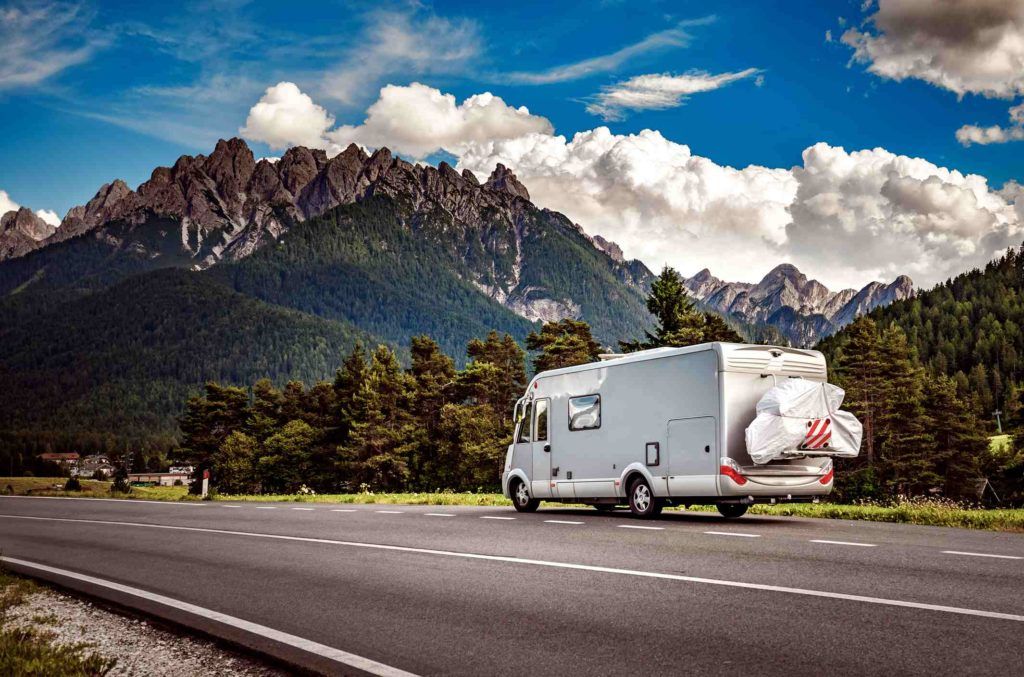
Campervan layouts – some things to consider
Before you begin looking at campers or motorhomes to hire or purchase, it helps to have a bit of an idea about the layouts and what is best for you.
The sleeping situation
Campervan beds can either be fixed beds, or seating that can be made into beds in the evening. Not only that, they can also be high with a ladder, like a bunk bed. For example the bed may be on top of the drivers compartment, as in the photo below. That window is where the bed is.
If you’re young and agile then climbing the ladder into bed is not so difficult. However if you’re not…
The size of the beds is also important. Ben is a big guy. Not only that, he overheats at night. Our beds in Luigi were too narrow for us both to comfortably sleep. Our campervan had a second ‘bunk style’ bed at the back and I slept in that one. When we decided to sell Luigi, we knew that we wanted a bigger bed that we could share.
Cooking in a campervan
So, I cook. I like cooking, we eat pretty healthily, it’s important to me. When we campervanned around New Zealand, our campervan fridge was so small we had to shop every second day. Luigi had a bigger fridge but it still wasn’t ideal. When we upgraded to the caravan, a big fridge was a must.
Cooking in a big campervan or motorhome is much easier than cooking in a small one. That doesn’t mean though, that cooking in a small campervan is impossible. You find your own tips and tricks and ways of making it work. You will however have to get used to going back to basics, as in a smaller campervan there is not a lot of room for a variety of pots and pans and certainly none for different kitchen equipment and things like blenders or slow cookers. Even if you had the bench space, you won’t have anywhere to store them.
Privacy.. what’s privacy?
The smaller your campervan the less privacy you’ll have. Conversely, the larger your campervan or motorhome, the more privacy you’ll be able to niche out. If you’re travelling with friends, go bigger.
In a very small campervan you won’t have any room division. If you have a toilet, it will most likely be a cassette toilet, which is like a small box that has a hole with a seat around it. With no division of the room, peeing becomes a pretty public act.
The larger you go in size, the more likely it is that you’ll have a separate ‘toilet’ room. So that’s something. You may also have a door or divider that breaks the camper into smaller sections. Our caravan now, for example, has the main living space, then a sliding door that closes off the bedroom and bathroom together.
Heating and air conditioning – yes!
If you’re travelling Europe in the shoulder seasons than maybe you can get away without heating or air conditioning, but in the height of either winter or summer, you’re going to want them, trust me.
We were in Croatia in the height of summer with our air conditioning free campervan. There was literally a night that all 3 of us (including our dog Whiskey) slept outside because it was so, so hot. 2 days later we left Croatia for Romania which is a few degree’s cooler during the day, but much cooler overnight.
Our caravan now has both good heading and good electricity. Having done two winters in the caravan I’m confident saying that you won’t survive a European winter without heating.
After campervanning around New Zealand we wrote an article on things to consider when choosing a campervan , have a read and it’ll help you to think about layouts and facilities that are important to you
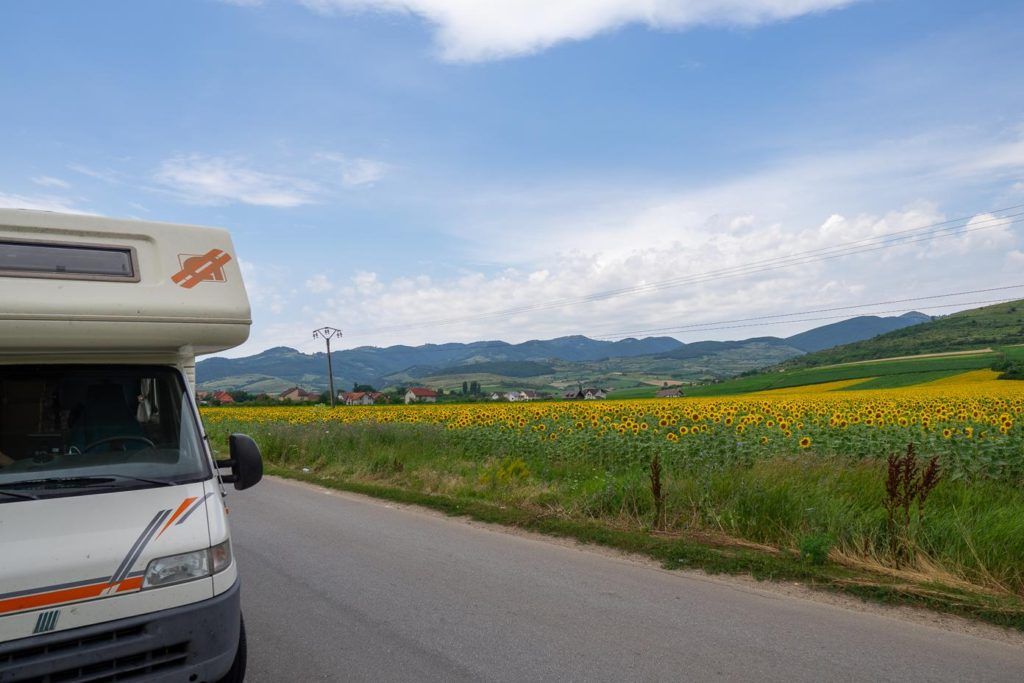
Buying or renting a campervan, motorhome or caravan in Europe
Hiring a campervan in europe.
Advantages of hiring or renting a campervan to travel Europe
- Quick and efficient, faster and easier than buying
- Everything is taken care of for you
- Easily available to non EU citizens
- Comes (almost) fully stocked
- A great way to try different models ‘before you buy’
- If you breakdown or have an accident the company will help you
- More convenient for a short trip
- Renting a more luxury model for a shorter time is cheaper than buying a brand new luxury motorhome
Disadvantages of hiring or renting a camper or motorhome
- The primary disadvantage is the price as it will be more expensive in the long term.
Expert tip : We always use Motorhome Republic to hire our campervans. It’s a great platform listing all the companies and their available vehicles so you can compare and find the perfect motorhome for you.
Buying a campervan in Europe
If you’re a European citizen you should have no problem buying a campervan or caravan in Europe. We’d recommend doing your research and possibly hiring a campervan for a smaller trip before you commit to purchasing one, just so you can really test it out. You may find something is important to you, when you hadn’t thought about it previously.
If you’re not an EU or UK citizen, it can be more difficult to buy a camper van as you’ll need a fixed address somewhere in the EU or UK in order to have the vehicle registered and insured. The good news is that there are ways to do it and we’ve met people on the road who successfully managed it.
I have to confess we’ve never had a problem buying our campervan or caravan in Europe as Ben is from the Netherlands. Obviously then, I haven’t had to use any of these services. I’ve done my best to research this section for you and point you in the right direction but I can’t make any personal recommendations as we haven’t done it or dealt with any companies relating to this.
For a complete guide to buying a motorhome in Europe as a non resident , you can check out our complete guide.
3 ways to buy a campervan in Europe for non-EU or UK residents
- Purchase your campervan in the UK using a relative or friends address.
Apparently the UK is the most relaxed country in Europe when it comes to registering vehicles for non-UK residents. You will need a UK address, however this can be a friend or family member. If you buy a camper direct from a dealer, you may be able to use their address for the registration of the vehicle.
Be aware that if you buy a vehicle in the UK it will be a right hand drive. This is different to the rest of Europe who drive on the left hand side. It’s not only the steering wheel that is different. The door to the campervan or motorhome will also be ‘on the wrong side’. If you stop your right-hand drive car on the side of the road in mainland Europe, you’ll likely be stepping straight out into traffic.
2. Buy your camper in the Netherlands or Germany
Campervanning and motorhoming are HUGE in the Netherlands and Germany, as it is in most of Europe. Both countries have businesses that will act as ‘middle people’ in the sale process. Some of the businesses will sell their own campers. Other businesses operate a sort of ‘fixer’ type situation. If you find a campervan online that you like, for a fee, they’ll go and inspect it for you. They’ll help to handle the sale transaction, the registration and insurance. Of course you pay for all of their services.
3. Buying a campervan in France.
Euro Camping Cars in France have established a unique and perfectly legal system for helping non-Europe residents buy a campervan or motorhome in France. Again, I haven’t done it, but it is legal, and many people have had great success. Their website explains everything you need to know about their services.
Consider looking for companies with buy back schemes
You’ve found a way to legally buy your campervan or motorhome in Europe as a non-resident. You’ve travelled around and loved every minute of your road trip. Now what? What do you do with your camper when it’s time to go home?
Firstly, you will need to sell your camper in the same country from which you purchased it. This will save you a lot of hassle. Secondly, how do you sell it quickly and easily so that you’re not sitting for another few months waiting to get your money back?
A buy back scheme is a great option. It simply guarantees that the place where you purchased your campervan, will buy it back from you at the end. They will obviously pay a reduced price. The longer you drove it, the more kilometers you did, the less money you will likely get back.
In which country should you hire or buy your campervan?
If you intend on buying, then obviously you’ll be restricted to the options and countries in the section above.
When you hire a campervan you’ll have plenty of options and can essentially hire a campervan to be picked up in any country. Consider your road trip itinerary before you make any decisions. You’ll want to know where you intent to start your trip. Also be aware that in most instances, you’ll need to return your camper van to the place where you picked it up. This means your trip will need to be a loop, or a general shape with a last minute dash for the starting place.
Insurance is necessary to travel Europe in a campervan
Insurance is mandatory in all European countries, and it’s the best thing you can pay for and not need. When you hire you campervan you can be assured that the company will offer you proper insurance for the vehicle.
One thing to take note of are the countries that are covered under your insurance. If you get your insurance in a Schengen country, the Schengen area is covered. However not all non-Schengen countries are covered under every policy. You’re best to confirm this when you get insurance otherwise your insurance card will tell you. Most western European countries use insurance cards that look like a credit card with your details on it and these will be valid in all countries except the ones that have a little x through them on the card.
If you try to enter a country outside of the Schengen area that is not covered by your insurance, you’ll simply need to ‘buy’ insurance at the border.
Be mindful that a little dent in a campervan, however unlikely, can quickly result in a very high repair bill. Be sure that you either buy the insurance excess, pay the excess upfront or you have coverage through your travel insurance to avoid huge issues in case of an accident.
Road side assistance
If you’re hiring your campervan, your hire company will usually assist you with any issues such as breakdown or accidents. If however, you have purchased your campervan and it’s insurance, you’ll usually deal with the insurer for damage and road side assistance if you break down. And trust me, road side assistance is helpful.
When we hit an enormous pothole in Romania and Luigi (our campervan) totally shut down on the side of the road, we were grateful for the road side assistance who found the nearest garage for us and organised someone to come and help. When they couldn’t fix him, they loaded Luigi onto the back of a flat bed truck, with us and our dog Whiskey still sitting inside! It was a slightly nerve wracking drive as we swayed and bounced our way into the nearest city on the back of the flatbed truck. An hour after that we were on our way again. Everything was handled by road side assistance.
Make sure you have refillable gas bottles, and enough of them, to get you through a decent period of time. Gas can be difficult to find, especially in some countries, so don’t let your bottles get completely empty before refilling them. If you have a lot of your items running on gas it’ll obviously go faster.
In the summer months, we only use gas for cooking and for our fridge while driving. A bottle can easily last us a few months. However our heating in the caravan runs on gas. Last winter, we sat for a week in -14 degrees. We obviously had the heating on the whole time and a gas bottle would last us 3-4 days! We would change it every 3 and run a full one overnight so we knew that it wouldn’t run out while we were sleeping. In the morning we’d reconnect the almost empty one to use the last of the gas when we were awake and could notice the heating was off.
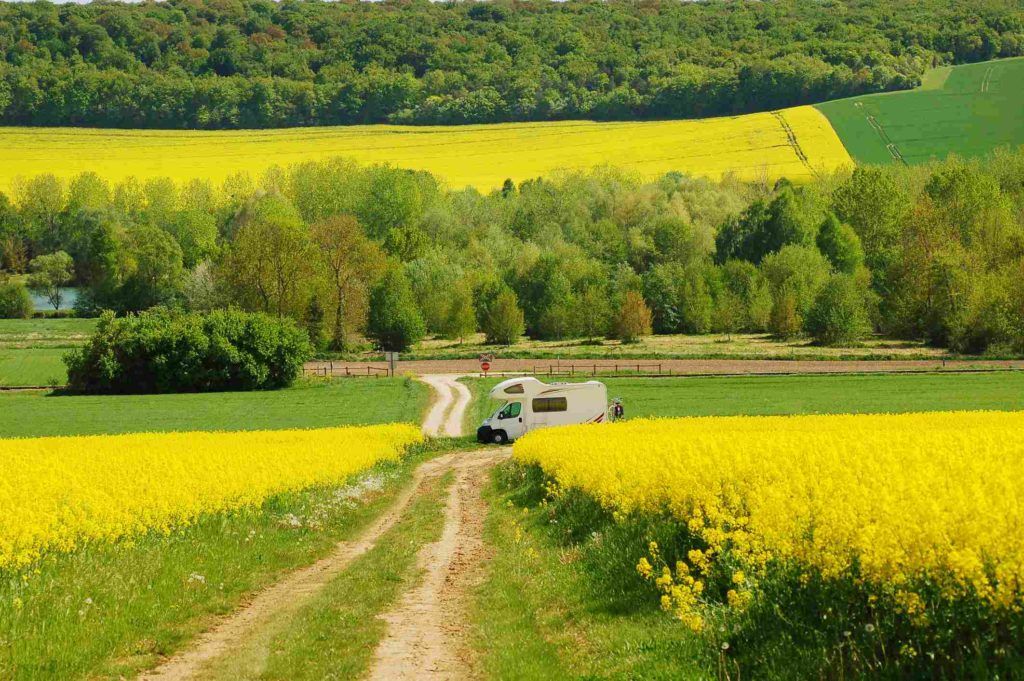
Gadgets and helpful items for Campervanning in Europe
Having a good navigation system is really helpful in getting around. It’ll save you a lot of time and effort in doubling back and getting lost. Not only that, the larger your campervan or motorhome, the more helpful a sat-nav can be. Get one where you can enter the dimensions of your campervan and it will (for the most part) avoid sending you down narrow one way streets.
Of course you’ll still need to use your own judgement and common sense. Look out for sign posts and information and change your direction early if you think you’re heading somewhere where you’re not going to fit!
12V USB Port Adapter
You’ll need to be able to charge your phone and/or sat-nav while driving. This adapter goes in the old cigarette lighter hole and will keep everything charged while you’re navigating. There’s nothing worse than running out of battery half an hour before you’re supposed to arrive at a new destination.
An inverter
If you have electronic devices such as laptops and camera’s you’re going to want an inverter. An inverter takes the energy from the campervans engine and converts it to electricity you can use to power your devices. You’ll especially need this if you want to stay off the grid and wild camp.
Motorhome, campervan or caravan awning
An awning is really useful on a nice day to protect you from the hot sun. Many campervans will come with a built in awning that you roll out. If you hire a campervan it may come as an add on that you’ll need to rent separately. When we bought our caravan there was no awning, so we simply purchased one that slides onto the caravan and can stay there permanently.
A water filter
We had travelled for quite a while without a water filter and it didn’t seem to bother us until we spent a few weeks in Istria, Croatia, and the water tasted horrendous. We have refillable water bottles we take everywhere, rather than buying plastic, and we were really having a hard time drinking the water there. At the time, as a quick solution we bought a cheap small filter which helped… enough.
Bicycles come in handy when you’re campervanning in Europe. It’s much easier to jump on a bicycle and cycle to the shops than it is to pack up the whole camper or motorhome and go. Bicycles are also a great way to get into a city or a green zone. You can park the campervan somewhere safe and easy and ride the bike in. It’s really common to see motorhomes with bicycles on the back for this reason.
The Gross Vehicle Weight of your motorhome or campervan
Aside from the dimensions of your camper, you’ll want to take note of the gross weight of the campervan or motorhome. It will have a maximum weight that you’re allowed to carry. The more ‘stuff’ you load in, the heavier you’ll be. When you’re working out what to pack, try to remember that just because you have some space doesn’t mean you should fill it. Leave some space so you can collect things as you go.
Essential Apps to download to your phone
Apps to find camping places.
Park4Night ( park4night.com ) an app that is fantastic for helping you find free overnight parking near you.
Apps to make life more enjoyable on a road trip
- The Kindle App will allow you to download books so that you’re not having to try and buy them as you travel
- Borrowbox is an app that is used by some libraries, it allows you to borrow E-books for free
- Audible – You pay for books you download on audible but you own them
- Spotify – It’s worth the small monthly investment to have some good road trip music
Connectivity and WIFI throughout Europe
Let’s face it, life is a lot easier if you have internet. Especially when you’re heading into new countries and unknown territory. It’s also helpful if you want to keep in touch with loved ones. I remember solo backpacking in Cambodia and my dad freaking out because I wasn’t replying to his text messages. I was at Angkor Wat at the time and 1000 year old temples don’t often have WIFI. Needless to say, I bought a sim card the next day.
If you stay at camp grounds they will often have internet although how good it is will vary considerably. If you need good internet, I’d recommend getting a dongle and using pay as you go rechargeable data like this. Three is a fantastic company with good reception throughout a lot of Europe.
Campervan and motorhome security – How to keep your belongings safe
Generally speaking, I would say that when you’re travelling in Europe, your at no greater risk for theft or a break in than you are in your home country. That being said, we’ve never had any problems and maybe someone who has experienced a break in might disagree. As everything you presumably want and need is inside the campervan, it’s understandable to be worried.
I was never really worried in camping places, but I was more concerned when we had to park the campervan in an isolated place. This happens say, when you’re going hiking and you drive to a remote car park, or, it happens when you want to see an old city and you can’t get parking so you end up parking down some random backstreet. It’s the only place you’ll fit.
There’s different strategies and tips, and everyone’s opinion differs. Some say leave all your blinds open so everyone can see if someone is in there. Others say leave them closed so the potential robber can’t see whether YOU’RE in there or not.
At the end of the day, I always carry our most valuable items on me. Passports, laptop, camera, phones etc, all go in my day bag if we leave the campervan in a remote place.
The other option is to purchase additional door and window locks.
Driving in Europe
Driving is different in Europe in that you’ll be driving on the right hand side of the road. Other than that, it’s not that dissimilar to driving in countries like America and Australia.
In western Europe in particular, the roads are pretty good and you shouldn’t have any issues, however the further east you move, the worse the roads become, I think I mentioned the pothole in Romania that stopped our camper in it’s tracks.
Do you need an international driving permit?
Anyone who’s drivers license has been issues outside of Europe should get an international driving permit . Although it’s not mandatory in all European countries, some countries do require it, alongside your normal drivers license.
Green Zones
Green zones are environmental zones, usually in cities, that restrict entrance to cars that do not meet emission requirements. Some places ban diesel vehicles all together, others may allow you to drive there provided you have received a green sticker indicating you’ve past an inspection. The reality is that if you’re in a large diesel motorhome, you’re probably not allowed in the green zone, and even if you were, you’d never be able to park in there.
As a general rule, avoid green zones, or park the camper somewhere safe and ride a bicycle or take public transport into the city if you want to go.

Petrol/Gas stations
By far the most expensive place to buy fuel is along the highways. If you need to fill up, go a little further in to a town, away from the motorway and you’ll find it to be a lot cheaper.
I’ve said it a few times already, but trying to park a large motorhome can be stressful. Some tourist sites will have large carparks, catering to the community campervanning Europe, but not all of them will. It is difficult for anyone to park in a city, let along a vehicle that’s twice as long as a normal car.
Reverse parking, or even just reversing a large campervan or motorhome can be difficult and many people find a reversing camera to be of great use.
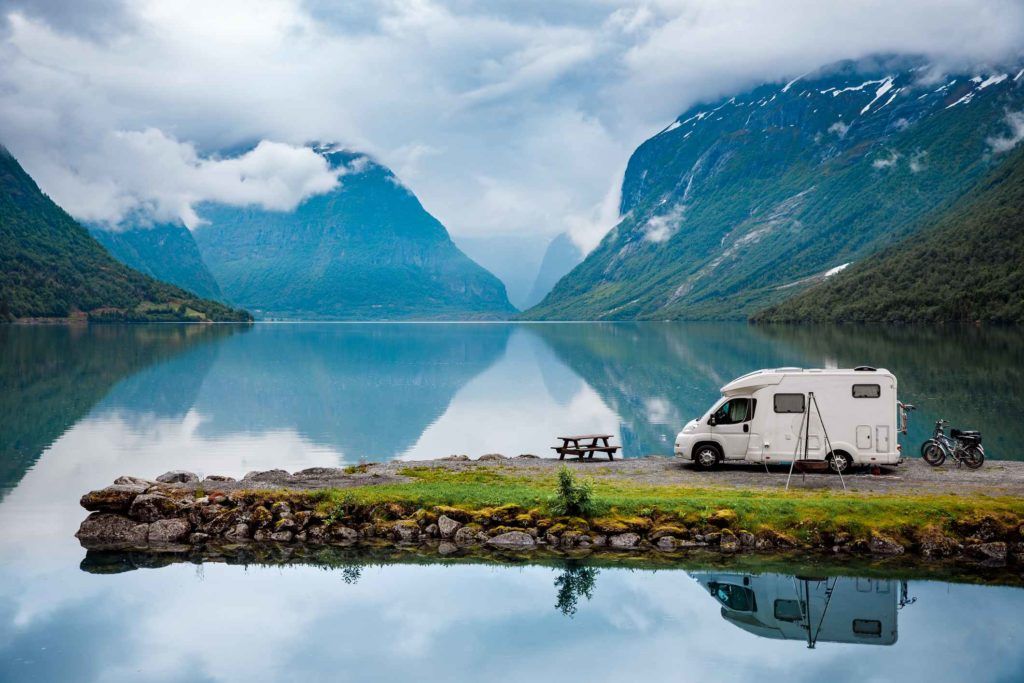
Other factors to consider when travelling Europe by campervan
Road and safety equipment.
Most European countries have mandatory safety equipment that you’ll need to carry on you at all times. If you hire a vehicle, make sure that they supply you with everything you need such as fleurescent orange vest and safety triangles. Winter tires are a legal requirement in most countries during the cold season. You may also need snow chains if you plan on going into the mountainous areas in winter.
If you buy a campervan you may need to source the safety equipment for yourself if you didn’t receive it.
Vignettes and road taxes
Vignettes are stickers that you add to your windscreen in certain countries to show that you have paid for the privilege of using their roads, mainly highways. The countries that use vignettes are
- Czech Republic
- Switzerland
You can usually buy a vignette at border crossings or at petrol stations close to the borders. You must have one or you can be fined.
Road tolls and a toll pass
Many countries have tolls their motorways. If you’re spending a decent amount of time in a country that has tolls, and offers a toll pass, it can be an easy way to avoid the long lines that sometimes occur at the toll way.
Security, Safety and emergencies
To be perfectly honest, we’ve never felt anything other than safe and secure in Europe. The only concern we ever really had was when we couldn’t find anywhere decent to park the campervan. It was sometimes necessary to park in places that we were unsure about. Other than that, most countries in Europe are safe and other people at the campervan sites are just doing what you’re doing and trying to enjoy life.
If however you have an emergency, the emergency number in Europe is 112.
Winter in mountainous regions of Europe
If you plan on driving in the mountains in winter, you’ll probably require snow chains. Make sure you know how to fit them properly. If you’re hiring a campervan, the hire company should show you how to do this.
Blood Alcohol Concentration
It’s important that you know the legal Blood Alcohol Concentration (BAC) for each country that you go through as it varies between them. While some countries have 0.05, others have a legal BAC of 0, meaning you can’t drink at all before driving.
These are really the main things that you’ll need to consider when planning to travel Europe in a campervan but don’t let it stress you out. Make sure you cover the basics and the rest you can deal with as you go. You’ll love the freedom, I promise.
Where to stay with your caravan or campervan in Europe?
Campervan parks.
There are quite a few options for places to stay overnight with your campervan. We stay at campervan parks, also known is holiday or vacation parks. Here you have access to facilities such as showers and toilets, and washing up and laundry rooms. It is possible to find some incredible campervan parks throughout Europe.
Overnight parking places
Many countries have over night parking places where you can stop if you’re just driving through. While some are nicer and designed for tourists, others are essentially truck stops, but will do the job. They’re free if you don’t want to pay. You can find these on the park4night app that I mentioned above.
In France you’ll find Aires de Service, or aire de camping car, which are places that you can stop for the night. They cost anywhere from free to €15. For an extra fee you may be able to dump your grey water and fill up your fresh.
Wild camping
Wild camping, known as freedom camping or free camping in other places, is not so common, but fairly easy to do in Europe. This is where you stop somewhere that is not a designated camp site, for example, in the forest. To do this you’ll need your campervan to be fairly self sufficient. You’ll also need to check the laws of the country you’re in as it is illegal to wild camp in certain countries.
ACSI card for discounted camp grounds
If you’re travelling in Europe in the off season, this card gives motorhomers, campervanners and caravaners great discounts on campsites and is well worth getting. As mentioned, only if you’re travelling in the off season.
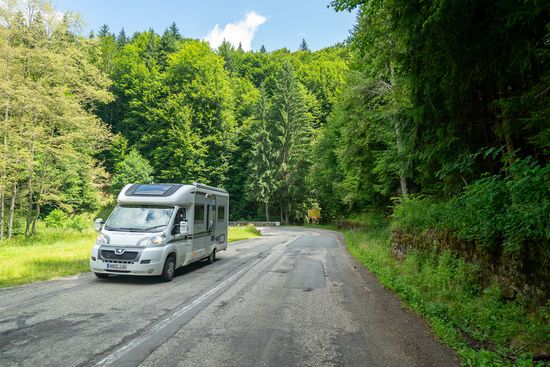
Where can I travel with a campervan in Europe?
Everywhere! In reality, you can travel across most of the continent in a campervan, motorhome or caravan. Europe has open borders so you can freely move throughout the region. Once you’ve crossed the border into one country, you’ll need to abide that it’s rules and regulations. I’ll cover that more below.
Europe by campervan: Travel Routes and Itineraries
Where to begin your road trip, or hire your campervan or motorhome.
Where you begin your trip and collect your camper is up to you. It makes sense to fly in to Europe and collect your camper from the same place. The exciting thing is that the best place to begin depends on your itinerary. Where do YOU want to begin your European adventure?
How to plan a European Campervan Route or Itinerary
Planning a route or itinerary for Europe, or for any road trip is quite a personal experience. You can either plan everything out, from where you plan to stop, what you plan to see and how many days you intend to stay. Or, you can leave it fairly open. I prefer to leave it open and really just plan the main stops. With plenty of space to move in between.
Before you leave home you’ll probably want to have at least a general route or itinerary planned.
European seasons
Europe is huge and the climate varies greatly across the continent, but also across the seasons. You’ll definitely want to factor this in during the preparation phase.
Cooler seasons
November to April are the winter months. These can be difficult for campervanning due to snow and ice on the roads. Not to mention that the temperature can get well into the minuses. It is possible, however you’ll need to be prepared.
If you want to travel in the winter, there are a few countries more suitable. For example, the south of Spain and parts of Croatia, Montenegro and Albania have a milder winter. Whereas central Europe, the Scandenavian Countries and those to the far west have bitterly cold winters. Not ideal for a campervan.
When campervanning in Europe in the winter, you won’t have as many accommodation options as many camp grounds close for the season. Those that remain open will usually have less facilities available.
Warmer seasons
Generally speaking, most people will campervan Europe during the warmer months. May to October are great months, with June, July and August being peak season.
From mid spring to mid autumn, the weather vary’s from balmy to hot, making the summer peak seasons for travellers. The coastline along the bottom of the European continent is buzzing as thousands flock to coastal towns.
Although it’s a great time of year to travel, summer in Europe poses it’s own challenges. The coastal areas of all countries are incredibly busy with both overseas and European travellers alike. Prices are also their highest at this time.
For motorhome or campervan travellers, you’ll need to consider whether you get air conditioning. Our first campervan in Europe did not have air conditioning. At the height of summer, on the Croatian coast, Ben, Whiskey and I all slept outside on the ground. It was just too hot to bare. Two days later we left Croatia for Romania which is a few degree’s cooler over night.
Peak periods
Europe is home to some of the worlds largest events, think Tour De France, the Dutch Keukenhof, or Germany’s Oktoberfest. Thousands of travellers flock to these area’s in the lead up to these events. You’ll need to be prepared if you want to join them. Otherwise you’re probably best to stay away from those areas at those times.
Another issue can be the ‘school holiday’ period, during summer in Europe. Popular campervan parks can book out months in advance.
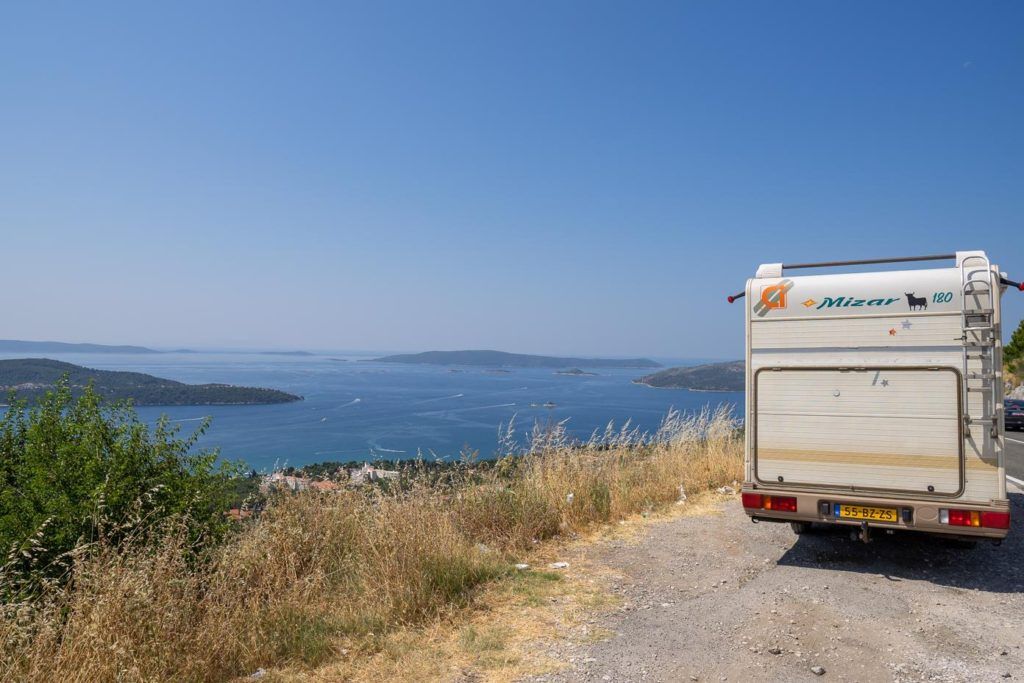
Using ferries on your European road trip
A great way to get from A to B without driving the long way, or simply to get on and off an island, like England, Ferries are part of most peoples campervanning experience in Europe. Connecting countries like the UK with France, Spain and the Netherlands, and Italy with Greece, Turkey or Croatia, it’s a fast and efficient way to travel.
Depending on the size of your motorhome or campervan and the distance you need to travel, you can pay anywhere from a €200 to €1000 euro per trip.
Using google maps to plan your European Campervan adventure
Get comfortable using google maps route planner when you’re planning your trip. I really like it because it gives me distances and times for travel. For example, I might decide to leave one place and drive to the next, The distance always looks so small on the map but google maps says it’s a 9 hour drive! Then I can try to find a place to stop in between for the night or find something that we might want to see or do for the day.
You can also download offline maps which helps if you think you might be going somewhere with no internet access.
It’s a really useful tool.
Costs and budget for travelling Europe in a campervan
Ultimately your budget will reflect your personal travelling style. It is heavily influenced by how many attractions you visit or how often you eat out compared to cooking in the campervan. Accommodation costs will vary from person to person, for example staying in high end campsites every night will be more expensive than wild camping, which is free. Your campervan hire or purchase price will be your most expensive initial outlay.
Some necessary and regular expenses are
- petrol or diesel for the campervan
- campervan site fee’s
- Admission fee’s to tourist attractions
- Gas for gas operated cook top or heating in the campervan
- Laundry facilities (sometimes you have to pay at the camp sites)
- European road tolls
- European Vignettes (see below)
- Public transport if you leave the campervan at the campsite
Apps for tracking your spending
It’s really helpful to keep track of how much money your spending. It disappears so quickly when you’re paying little bits out here and there. Petrol, gas, the camp ground for the night. Keeping track as you go means you’ll make it comfortably to the end of your trip rather than running out half way through.
Two great apps you can download to your iPhone are Trabee Pocket and Trail Wallet. They are both pretty similar and will help you keep track of your spending in each country. You can also track in that countries currency AND your home currency. This is really useful if your mental conversion is not so good, like mine!
Transferring Money
If you’re needing to transfer money around, make sure that you either have your own wifi device, like a dongle, or you use a VPN to protect your banking data.
What do you mean some countries don’t take Euro’s?
Yep, just to confuse things, some countries in Europe don’t take Euro’s. This is easy enough to deal with as simply going to an ATM or taking a small amount of the other currency with you, will solve the problem.
Countries that don’t accept euros are
You’ll need to organise these things before you leave for Europe
Your passport and any necessary visa’s.
Your passport itself is fairly easy. You just need to have one, and it needs to have more than 6 months validity, and enough pages to be stamped.
Visa’s can be a little bit more tricky depending on what citizenship you have, and how long you intend to travel. Make sure you check your visa requirements and organise your visa in advance.
Read : Passports and Visa requirements for campervan travel in Europe
Drivers licence
It seems only logical that you’d take your drivers to Europe if you intend to drive a campervan, doesn’t it? Make sure to check that your license is sufficient though. You may find that you need to obtain an International Drivers License before you go. And if so, you’ll need to have that on you too.
Travel Insurance for travelling Europe in a campervan
Travel insurance is one of the things that we never, ever leave home without. It’s really easy to have the ‘It won’t happen to me’ attitude, but the reality is that ‘it’ can happen to anyone.
Make sure that you book good travel insurance before you leave. We always use World Nomads. We’ve dealt with them personally, when I fell sick in Vietnam and needed treatment in Cambodia and then also in Thailand (very long story there!).
World Nomads were fabulous and we were really impressed with their service and speed. They called a couple of times just to check up on me and make sure we were ok. They also paid out almost all of my medical expenses, despite the fact that we were really delayed in sending them all the information. I mean, we literally sent the bills months after the event. I was convinced at that point that they wouldn’t pay, but voila. We’re very happy with them.
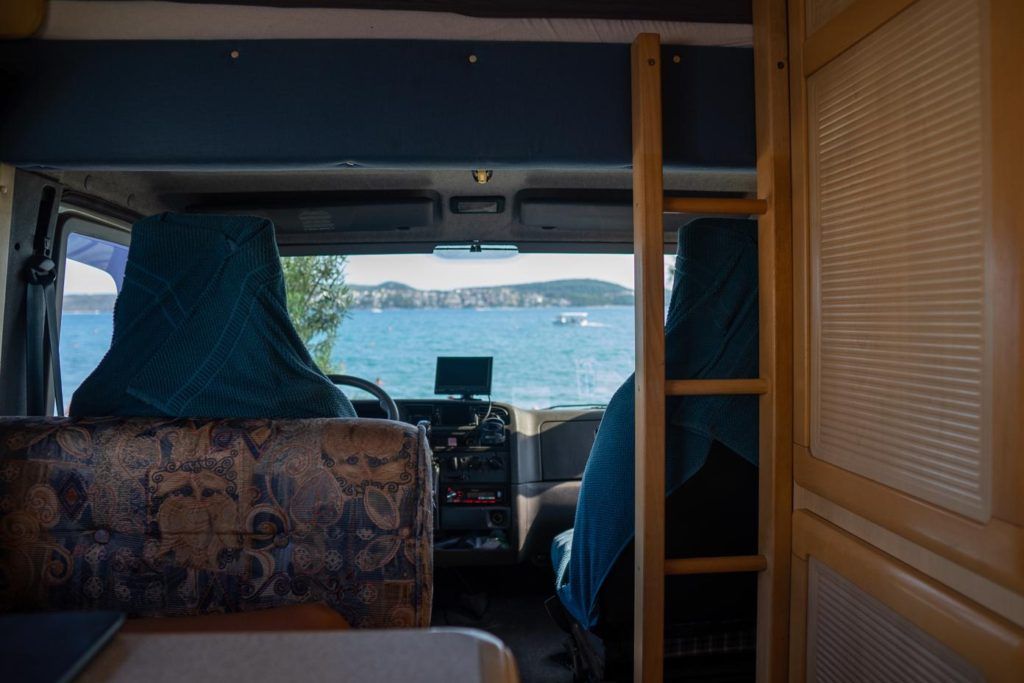
Paperwork that you’ll need to carry with you
Before you set out, you’ll want to make sure you have copies of all necessary paperwork. This includes
- Campervan or caravan and car insurance paperwork. Make sure you have the original, some countries won’t accept copies or photos from your phone.
- A rental contract or purchase contract proving your right to the vehicle
- Your travel or health insurance information
- your original birth certificates and marriage certificate. These are not so easy to get on the fly if you need them
- your drivers licence
- Your pets health check certificates and proof of rabies vaccination. You’ll need this even if you’re from a country that doesn’t have rabies. If you enter a rabies risk zone your pet won’t be allowed back into the rabies free area without one.
- Details of anything you’ve booked in advance including campervan parks, tours, tourist sites or public transport.
Van life – What’s it really like?
We absolutely love the freedom and sense of adventure that comes from living life in a camper. The idea that you can pick up and go anywhere. That you can see something new and different. We’ve been able to see some incredible places and have wonderful experiences. Not to mention adopting our dogs from Croatia. We wouldn’t have been able to do that if we didn’t have our own home on wheels.
The challenges of van life
That being said it’s not always sunshine and rainbows. There are challenges to van life as much as there are to any other lifestyle. Adjustments need to be made to how you life. The smaller the camper, the more adjustments are required to make van life enjoyable.
It involves some downsizing
You need to get used to public toilets, the occasional cold shower and cooking with minimal equipment. Packing everything away every time you move can be a bit annoying but you do get in a good rhythm with it. Forgetting to lock a cupboard door is fun when stuff flies out while you’re driving. Generally, if you’re a minimalist or can get buy without ‘all the stuff’ then you’ll have no problem.
I love our life in our little home and I have absolutely no problem what so every with living in a smaller space. I have everything that I need and the space doesn’t bother me at all.
It can be tiring constantly moving
We sometimes struggle between moving and staying still. If you find a really good camping place it’s really easy to settle down for a while as opposed to keeping moving.
When things go wrong there’s no escape, your camper is your home AND vehicle
There are times when things go wrong with the camper. Like the time our wheel bent, yes, our wheel bent. We were about to leave Romania and head back to the Netherlands. We decided to make a push for it but the vibration got worse and worse. The first night we stopped in Hungary for the first night, then in Germany, and then made it home, but oh wow did we have headaches.
You may have the odd sleepless night
And, as much as we like to think they are, motorhomes and campervans are not sound proof boxes. There’ll be the occasional night you don’t sleep because the people next to you have music playing, or are sitting at their table outside your window talking. We were at a campground just outside Bucharest. Which, unbeknownst to us, was right beside a large venue which was holding a wedding reception. Hardcore dance music blared inside the campervan, it was so loud we couldn’t have heard our own music if we’d put it on and turned it right up. Everyone was in the same boat because we were packing up our campervan at 6 am, and so were all the others. No one had had a wink of sleep.
The other side to this is thunderstorms. Heavy rain or wind on a campervan or caravan roof can sound thunderous. Sleeping during really big storms can be difficult. And if a huge storm hits during the night and your awning is out, watch out!
How do relationships survive van life?
To be honest I think that depends on what the relationship is like to begin with. Ben and I have travelled together for years so we’re used to always being together. We don’t really have any issues with being together all the time. That being said, sometimes it’s nice to have some privacy, or a moment to yourself.
Our main arguments these days are about the toilet. After all this time he still argues every time I tell him that the toilet needs to be emptied. E-V-E-R-Y time. You know in relationships you have your roles. There are certain things one person always does and certain things the other always does. He always does the toilet, its just the way it is. The thing is, I always have to tell him it’s full. He never just notices and empties it. I notice it and I tell him. This is what we argue about!
Other ways van life can affect relationships
As a little side note, it’s important that you factor your relationship in when you choose a campervan. With our first campervan we had to sleep in separate beds because the beds were too narrow for us. We also had a fairly small table that had two bench style seats opposite each other. The seats were not wide enough for us to sit comfortably side by side. I mean, we could, but we were bumping elbows a lot.
Not only were we sleeping separately, we were always sitting opposite each other. It didn’t really do a lot for the romance.
When we bought our caravan we knew we wanted one with a big bed, as well as a larger seating area where we could sit side by side.
In conclusion
So, that’s a lot, right? While there’s a lot to know and certainly to do before you leave on you camper van or motorhome road trip around Europe, once you set off, it gets a lot easier. After a week or so the day to day basics become routine and you’ll find your rhythm.
I want to hear from you
Don’t be shy. If you’ve made it to the end of this guide on campervanning Europe then you’re ready to go. Drop a comment and tell me your plans. Also feel free to ask any questions you might have. You never know, maybe they’ll help someone else too.
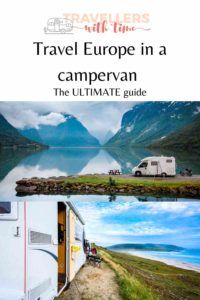
About Christine
Christine and her partner Ben have spent the last few years traveling through New Zealand and then Europe by campervan. They travel with their dog Alisa, who they adopted in Croatia. You'll find them exploring old cities, hiking through National Parks, and taking unforgettable road trips.
2 thoughts on “How to travel Europe in a campervan, motorhome or caravan”
Hi! Can you park for free-boondock with caravan? Im from Croatia and i see motorhomes park in city centar regulary im in Istria,but never see caravan park like that.I see them only in supermarkets parking or shoping centar parking. But can leave caravan somewhere in Forest and leave with you car is this possible? Sorrry abou my English! Thank you!
Hi Daniela, I’ve never tried it in a caravan so I can’t be sure, but I think there would be some problems with boondocking in a caravan. Some of the issues I can think of are – Safety and security – You’d need to make sure that the caravan can’t be stolen – you could use a Hitch lock, which prevents someone else from connecting their car to your caravan and towing it, there are also wheel locks, and then things like extra door locks and alarm systems – Leveling a caravan is more difficult, so if you want to camp in the forest you’d need to find a place that has flatter ground from the start – It will be more difficult to move a caravan if you need to make a quick exit – either for safety reasons or because you’ve been asked to move. – You probably don’t have a waste water tank so you’d need to find a way to collect your waste water so that it doesn’t flow out into the environment.
Those are just a few reasons I can think of. Maybe some of our readers have more experience with boondocking in a caravan?
Leave a comment Cancel reply
- You are now viewing the UK site, for Quirky Campers NZ click here
Campervan hire for this weekend – SAVE 10%
- Cream of the Quirk
- Just for Two
- Pet Friendly
- Festival Friendly
- All-Electric
- Offices on Wheels
- Last Minute Discounts
- Long Term Discounts
- Booking Conditions
- Buy a Campervan
- Sell Your Campervan
- Quirky Converters
- Register Your Services
- Rent out your campervan
- Gift Vouchers
- Conversion Guide
- Ooni Pizza Ovens
- Virtual Workshops
- Accessories
The Ultimate Guide to taking a Campervan to Europe
27th June 2024 Laura Hammond -->
Quirky Campers Guide to Campervan EU Travel
You can take a campervan or motorhome to the EU – all you need is the right paperwork, information and gear. Taking a campervan road-trip through Europe is the holiday bucket list dreams are made of, but it can seem daunting at first. This comprehensive and easy to use guide will tell you exactly how to travel to Europe in a campervan. Quirky Campers have been running for over ten years, and in that time we’ve amassed expert knowledge on all things campervan. We want to share that knowledge and experience with our customers so that you can enjoy the freedom and excitement of campervan travel in Europe.
Why Travel to Europe in a Campervan?
Taking a road trip in a campervan offers freedom, fun, and a stress-free holiday. You can bring your pets, the whole family, and even the kitchen sink along with you. Packing is a breeze when you can travel with everything you need. As you drive through Europe, you can enjoy French patisserie in the morning and Italian pizza in the evening. Explore the mountains and lakes of Switzerland, and the deep forests and castles of Germany—all at your own pace, without the rush of check-in and check-out times, or the chaos of summer in airports. Experience all of Europe at your fingertips with the freedom of the open road.
Where in Europe can I travel in a Campervan?
Europe and the European Union are distinct entities. It is important to check your insurance and plan ahead to ensure you only travel in countries where your insurance and breakdown coverage are valid. If you’re renting a campervan from Quirky Campers – discuss your travel plans with the van owner ahead of your trip to be sure you’re covered the whole time. The countries in the European Union include:
- Austria
- Republic of Cyprus
- Czech Republic
- Finland
- Ireland
- Netherlands
Plan ahead and do your research for a smooth and stress free road-trip. Ferries are usually best booked in advance, as is Le Shuttle (Euro Tunnel), plan for delays and arrive early for any border crossings especially in summer and high seasons.
How much does it cost to travel Europe by campervan?
Travel costs can vary widely based on factors such as the length of your stay, the distance you plan to travel, where you plan to spend the night in your van, and whether you cook in the van or dine out. However, you can plan a trip to suit any budget. Your main expenses will include:
- Insurance
- Breakdown Cover
- Ferries/Le Shuttle
- EU Travel Pack
- Travel insurance
You can keep costs low by:
- Buying food at local supermarkets
- Booking transport such as ferries in advance
- Prioritising slow travel
- Staying at Aires or free parking
If you plan on hiring out a campervan from Quirky Campers, your insurance and breakdown cover is included in the cost – all you need to pay for is the EU Travel Pack (£30.00) plus fuel, travel insurance and the cost of the ferry/train over to Europe.
Which Campervan should I Choose?
When choosing a campervan for a trip to Europe, it’s essential to consider your specific needs, whether you’re travelling with companions, and the destinations you plan to visit. Here are some key factors to keep in mind:
Purpose of the Trip
- Adventure and Outdoor Activities : If you’re an active holiday-type and plan to get outdoors with activities like hiking, surfing, or biking, ensure the campervan has ample storage for your equipment, for example Quirky Campers has a whole section of Campervans with Bike Racks.
- Relaxation and Comfort : If your trip is more about relaxation, consider a campervan with extra amenities like a TV, bathroom, outdoor furniture or an awning.
Number of Travelers
- Family Travel : For families , a larger campervan with enough beds, seatbelts, and storage space is essential. Look for models with family-friendly features like Isofix, games, hammocks and a spacious dining area.
- Couples or Solo Travel : Smaller campervans can be more economical and easier to drive. Consider a compact campervan that still offers all the necessary amenities but gives you more freedom.
Travel Destinations
- Urban vs. Rural : If you plan to visit cities, a smaller campervan will be easier to manoeuvre and park. For rural adventures, a larger van with off-road capabilities might be more your style. If travelling in cities you may need to pay emission zone fees – so include this in your budget.
- Climate : Depending on the climate of your destination and the season you’re travelling in, you might need a campervan with good insulation, heating, a fan or air conditioning.
- Off-grid or Hook-Up : Research the availability of campsites along your route and what amenities they have to offer. Some areas might have well-equipped campsites, while others may require more self-sufficiency. Consider Whether you’re planning to stay at campsites all the time and want a campervan with an electric hook-up or if you’re planning to go off-grid you’ll need to consider how much power you’ll be using and need a van with solar panels for example.
Amenities and Features
- Sleeping Arrangements : Make sure the campervan has enough comfortable beds for all travellers.
- Kitchen Facilities : All Quirk Campers come with a well equipped kitchen so you won’t need to worry about taking kitchen goods with you. But if you’re a chef extraordinaire you may prefer a campervan with an oven rather than just a hob, or even outdoor cooking facilities.
- Bathroom Facilities : Depending on your comfort level, you might want a campervan with an onboard toilet and shower.
- Storage Space : You’ll want a campervan with enough storage for all your belongings, especially if you’re travelling with sports equipment or kids. If you’re a minimalist packer you may be able to get away with a more compact campervan.
Driving and Handling
- Size and Maneuverability : Consider how comfortable you are and how experience you have with driving large vehicles. A more compact campervan can be easier to handle and park. You can also choose vans on the Quirky website that have extra features such as reverse sensors or parking cameras.
- Fuel Efficiency : Long trips can be costly for fuel, so consider how far you need to travel – remember larger and older campervans aren’t going to go as far as fast as a car.
- Insurance and Breakdown Cover : Always double check that your insurance and breakdown cover are valid in all the countries you plan to visit.
- Rental Costs : Campervan rental prices can vary significantly. Compare different models and companies to find the best deal for your budget.
- Additional Costs : Consider costs for fuel, campsite fees, tolls, and parking.
- Seasonal Pricing : Prices can fluctuate based on the season, with peak travel times typically being more expensive.
By carefully considering these factors, you can choose a campervan that perfectly suits your travel plans and ensures a smooth and enjoyable journey through Europe.
Requirements for taking a hired campervan to the EU*
- Vehicle on Hire Form (VOH)
- EU Travel Pack
EU Breakdown Cover and Insurance
- Travel Insurance
- Passport
- Visa (Only required for UK Passports if you are spending more than 90 days in the EU
- If travelling with pets – Pet Passport and Health Documents (AHC- animal health certificate)
*Check the website of local authorities for country/state/city specific requirements before you travel, these are subject to change.
Requirements for Taking your own Campervan to the EU*
- V5C Log Book
- EU Travel Kit
Paperwork for taking a campervan to Europe
To take a campervan into the EU on hire you need an VOH certificate, EU Travel Pack and EU breakdown cover and insurance.
Vehicle on Hire Certificate (VOH)
If you rent a campervan from Quirky Campers you will need a vehicle on hire certificate, this is a form that is created and filled in by the van owner and tells the authorities that you are hiring out this campervan with their permission. This should be done ahead of your booking start date and will be purchased by the owner of the van. However, it’s your responsibility to tell the van owner that you are going to Europe so they can organise this ahead of time. Most EU Friendly vans on our website have an ‘EU TRAVEL PACK’ you can choose as an add on – this includes the cost of the VOH certificate and the EU Travel Pack.
EU Travel Pack or European Driving Kit
To drive in most European Countries you are legally required to have an EU Travel Pack in the vehicle. This pack provides you with safety equipment you need in case of breakdowns on the road. They must contain the following:
- Headlight beam benders
- First aid kit
- Warning triangle
- Hi-vis vest
We also recommend:
- Breathalyser/alcohol test (recommended but not mandatory)
- Spare bulbs (recommended but not mandatory)
- Snow chains (if visiting in the winter in some areas)
Any campervans or motorhomes travelling in Europe need EU breakdown cover and insurance that covers travel in Europe. If you hire a campervan from Quirky Campers this will be organised for you by the van owner – as long as you tell them ahead of time you are planning to travel to Europe. If you are taking your own vehicle you may need to keep proof of these in the van with you along with your MOT paperwork.
V5C Vehicle Log Book
The V5C is your vehicle log book – this proves you own the vehicle and must be with you in the van when you travel into Europe.
Driving in Europe Tips and Tricks
- Before you begin your journey be sure to check the driving laws of any country you are going to.
- Most countries in Europe drive on the right hand side – check ahead for each country you are visiting.
- Road signs will also be different in every country you go through – take a look before hand to familiarise yourself with important road signage.
- In Portugal it is illegal to use a dash cam, and in France it is illegal to drive while using headphones or earphones – make sure to check any local driving laws when choosing your route.
- Some countries will have Emission Zone Charges for driving through cities or towns – either avoid these or check online to pay the charges and avoid fines. In France to drive through certain areas you need a CritAir or ‘clean air’ sticker – which tells local authorities what the vans emission level is and what the charges will be.
- Toll roads can make long journeys much quicker in Europe – however you will normally need to pay the charges within 24 hours of using the tolls to avoid fines.
- Be aware of the speed limit – most countries in Europe us KM/H.
- Know your van height (including any solar panels/fans on top) – many car parks will have a height restriction, know your van height and you won’t be scraping your solar panels off on a barrier!
Where can I Camp?
Campsites .
Europe has endless campsites that you can stay in, from large holiday parks with facilities like pools, restaurants and play areas for children to minimal back to basics campsites immersed in nature. Many campsites offer Electric Hook-ups for use if you’re staying in one place for a long time, or laundry and waste disposal facilities. Not all campsites accept campervans, and many popular campsites get booked up in peak seasons so check ahead to make sure you’re booking the right ones.
Aires De Service
Aries are overnight parking stays that motorhomes and campervans can make use of. Most are free or have a small surcharge and have basic facilities. These are mostly found in France but can also be found in Switzerland and Italy.
Wild/Free Camping
The benefit of travelling in campervans and motorhomes is the freedom to park up where you can and still have your bed with you. Many people wild or free camp parking up in areas and sleeping for the night. The rules around wild camping vary depending on where you are, always check local signage, laws and rules before staying over. Apps like Park4Night or Search For Sites can be very useful in finding park ups. But most importantly leave no mess behind and park responsibly!
EU Travel Friendly Campervans For Hire
Are you ready for the road-trip of a lifetime? Our collection of EU friendly ready to hire campervans all come with insurance, breakdown cover and of course the absolute freedom of travel on the open road. Go ahead, make your dream holiday come true and book in today!
Daffy – Hire From London
Are you ready to take this little slice of sunshine for a spin? Daffy is a one of a kind, heavenly crafted campervan, located in London. Daffy expertly intertwines several styles to create a stylish and bright atmosphere. From a wooden panelled ceiling to geometric soft furnishings, Daffy really will stand out on any instagram feed. A snug L shape sofa transforms into a cosy double bed by night, the perfect set up for a romantic getaway.
Air Conditioner | Audio Inputs | Extra Storage | Festival Friendly | Inverter | Kitchen | Sink | Outside Shower | Pet Friendly | Radio | Refrigerator | Stove | EU Travel Allowed
Gigi – Hire from Longhope
Get ready to be blown away by Gigi, the lightest and brightest van for all the family. Fitted with a remarkable 6 belted seats and enough space for 2 adults and 4 children, what more could you possibly need for your best holiday yet? Waking up every morning to Gigi’s spacious and airy interior will have everyone starting their day with a skip in their step. Crack some coffee on the hob, get the kids around the table for a fully cooked breakfast and prepare for a day of new discoveries.
Audio Inputs | Dining Table | Festival Friendly | Heater | Kitchen Sink | Levelling Jacks | Radio | Refrigerator | Solar | Stove | Fixed Bed | Parking Space | Sat Nav | Reverse Sensors | Reverse Camera | EU Travel Allowed
Eartha – Hire From Hailsham
There’s no better way to explore this Earth than in Eartha. Nestled in the South Downs National Park, Eartha is only 11 miles from the sunny seaside town of Eastbourne, where you can enjoy breathtaking views of dramatic Beachy Head white cliffs. Her earthy tones provide a warm and inviting atmosphere for couples on a romantic escape. Her L shaped seating area transforms into a cosy double bed where you can enjoy breakfast in bed.
Audio Inputs | Heater | Inverter | Kitchen Sink | Outside Shower | Radio | Refrigerator | Solar | Toilet | Reverse Camera | CD Player | EU Travel Allowed
Vanessa – Hire From Rowlands Castle
Vanessa is a beautiful campervan perfect for those who want to combine comfort and luxury. Her whitewash interior and dark wood panelling provide a cosy and homely atmosphere in which two adults can make memories and explore the world.
Air Conditioner | Audio Inputs | Ceiling Fan | Dining Table | Heater | Inverter | Kitchen | Sink | Outside Shower | Radio | Refrigerator | Solar | Toilet | 6ft+ Bed | Fixed Bed | Parking Space | Sat Nav | Reverse Sensors | Reverse Camera | CD Player | EU Travel Allowed
Are you ready to take a European road-trip in the campervan of your dreams? Check out our handcrafted selection of campervans for hire today and book in for a bucket list holiday!
Related posts.

16th August 2024 Laura Hammond -->
Quirky Camper’s Guide to the Best Campsites in Yorkshire 2024 About Yorkshire Beautiful, scenic Yorkshire is the largest historic county in England, renowned for …
- campervan owner
- collections
- conversion tips
- holiday tips
- photography
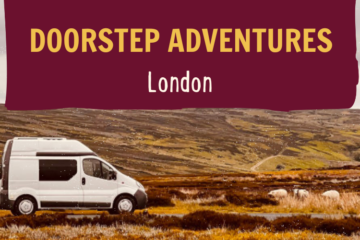
1st August 2024 Laura Hammond -->
Stay local and uncover the wonders of your area with doorstep adventure itineraries from Quirky Campers. What better place to find adventure than right …
- door step adventure
- local travel
- travel tips
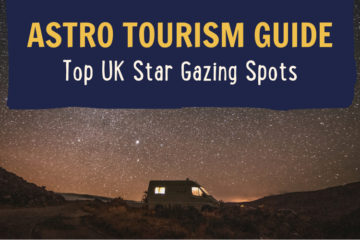
31st July 2024 Laura Hammond -->
A Beginners Guide to Astro Tourism and the Best Spots in the UK for Stargazing 2024 is set to be an extraordinary year for …
Search Quirky Campers
Search campervans for hire.

The Ultimate Guide to Touring Europe in a Motorhome
Planning to tour Europe in a motorhome? Before you hop into that idea, you may need to familiarize yourself with the benefits of recreational vehicles or RVing. Why would you want to choose a motorhome over other traditional options? Do you want the total freedom it provides? Or does its unique accommodation satisfy you?
In addition, you need to assess how motorhome-friendly European tours are. Yes, using your campervan in Europe is quite different than your usual weekend RVing. It requires better planning and a world of essentials. If you’re really into this kind of trip, you better keep your eyes on the road to stay safe . Here’s an article to guide you in your RVing in Europe to take your smooth-sailing ride after you step on the gas.

What To Consider Before Starting The European Tour
Motorhome features.
First and foremost, you need to pick a motorhome. You may consider your needs first based on the number of passengers and the length of the trip. For these concerns, you may think about the type and quality of beds of the camper vans that’d accommodate you.
In most cases, beds turn into living rooms in an RV. There are standalone beds too. In choosing the bed type, you may dwell on the idea of determining whether or not you like the convertible or not. In addition, there are motorhomes with bunks, ideal for kids and teens.
Yet, most adults hate this feature. So, it’d be better to ask the passengers which type would they prefer. Other things to look at are the seating, kitchen and available appliances, and bathroom. If you haven’t chosen yet, you may go to stores offering RVs for hire, such as wilderness.co.nz/motorhome-hire-nz and others for a lot of camper vans to choose from.
Camping Costs
Like any RV tour, you’d always consider the expenses in gas, food, and other essentials. Generally, gas prices in Europe are higher than in most countries. If you want to cuts costs in this aspect, you may choose a smaller camper van. Ideally, couples could opt for compact vans for this purpose.
Apart from this, you would need to have a budget for your cooking needs. In many camper vans, propane tanks are used. The food and similar expenses differ in each European country. Food prices in Southern Europe are typically lower than in the North.
Roads and Routes
To save money, most campers in Europe take back roads. Usually, highways have road tolls that add up to expenses. Apart from the savings, backroads offer better landscapes where campers could stay in.
Regarding your stay, may it be on your own or with a partner, the easiest way you could get into Europe for RVing purposes is through short-term visa-free stays for 90 days. European Visa-exempt program allows this option for foreigners, but only for visits in the following countries identified as members of the Schengen Area:
- Czech Republic
- Netherlands
With this option, you may plan to take a Schengen country for a 90-day trip and move to a non-Schengen country for the next 30 days. Then, you may go back to a Schengen-covered country for another 90 days. Having this in mind, you could have a planned route before your much-awaited RVing.
However, by 2023, travelers would need to apply for European Travel Information and Authorization System (ETIAS) to comply with the continent’s new travel guidelines. With this protocol, travelers need a valid passport and an approved ETIAS visa waiver to gain entry.
Seasons for a European Motorhome Trip
Generally, any season offers the best RVing experience for campers. Yet, many camping enthusiasts suggest the following months, as they’re known to have the lowest camping population and ideal temperature.
April to May: During these months, campground prices are generally cheaper. In addition, most residents are inside their homes, so there are fewer people camping, especially in Continental Europe.
November to March: This stretch is ideal for Southern Europe. Most campers head South because of the freezing temperature in the North during the winter season. Yet, the campgrounds are open and fabulous in these months.
June to August: This may have the most pleasant temperature and campgrounds. Yet, it’s also the most populated as to the number of campers.
Final Thoughts
Suppose you’re already familiar with motorhome trips and the necessities for your ultimate European tour. Now, you may start to pick which places you’d go first. Ideally, most campers choose Croatia because of its picturesque scenery and rich culture. In addition, it’s smaller compared to other countries, making it preferable to beginners.

Another good destination is the United Kingdom. This country has a lot of camper-friendly roads and villages. Other places to choose from are Tuscany, Italy; Bavaria, Germany; and the Czech Republic. Before you continue, keep in mind that European countries have different laws for RVing and driving. You may need to be familiar with these rules before setting off for your European journey.
More Destination articles you might enjoy

Meghan Waters Mbaye
Leave a reply cancel reply.
Your email address will not be published. Required fields are marked *
This site uses Akismet to reduce spam. Learn how your comment data is processed .

Community Features
Get traveling, backpacker 101.


Our Two Week Europe Roadtrip Campervan Itinerary – Switzerland, Italy + Slovenia
Two weeks in europe.
This past May/June, we spent two weeks travelling from the UK through Europe with the goal of ending up in Slovenia (before sadly, heading home). I’ve wanted to visit Slovenia for SO long, but to me, it always needed more than just a long weekend trip to the capital, Ljubljana, as there’s so much more to explore in the country. So, we decided to head there in the campervan instead.
We didn’t know if we’d be pushing it to head down there in just a few days, and yes, some of the drives from each place were around 4hrs long, with the average being about 2.5hrs of driving each day. But it was so worth it, and we got to see everything we wanted!
We’ve shared more in depth posts about each place we visited which you can find here , but I thought we’d recap it for anyone just wanting a quick read!
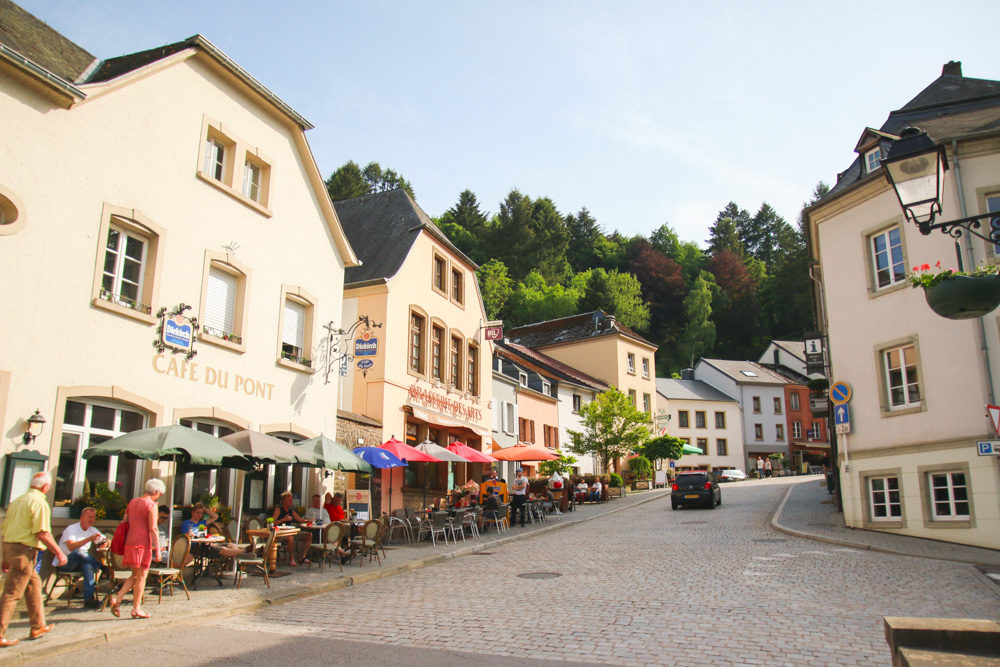
Day 1 – Vianden, Luxembourg
We got a late night ferry from the UK, arrived at 2am to our campsite nearby and woke the next morning with a 4hr drive to Vianden in the north of Luxembourg. We arrived late afternoon after a late start recovering from the tiring day we’d had finishing the van the day before and arriving so late that morning.
The town was filled with quaint, pastel coloured buildings that we wandered the streets for a while exploring, before heading up to the viewpoint on the chairlift. We definitely recommend that, where you can see both views of the town below, and Vianden Castle. If you have time, you can take a walk over to the castle too! We headed back down, had some drinks at a bar by the river while we found a campsite for the night.
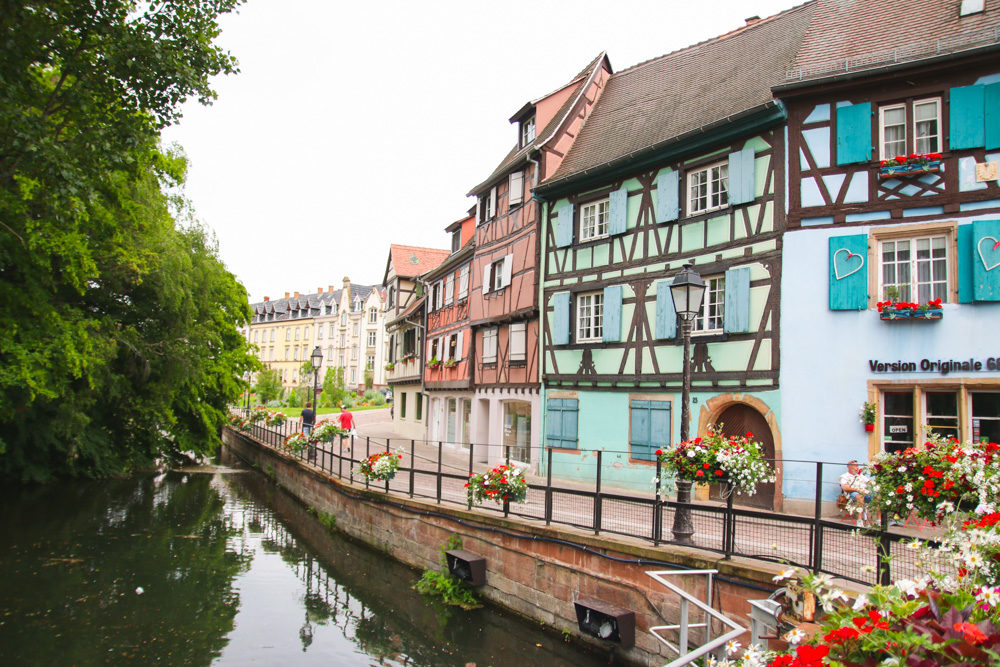
Day 2 – Colmar, France
The second day saw us driving 3.5hrs south into France to visit the old Alsacian towns of Colmar and Eguisheim. We spent the first part of the afternoon exploring Little Venice, before heading to explore more of the Old Town and stopping for some lunch. It’s such a cute little town to explore, lined with the river and definitely worth a stop.
Afterwards, we drove 10 minutes outside of the town to visit the old cobble-stone village of Eguisheim. Built in a circular style, the village was filled with colourful wooden beamed houses, just like Colmar but on a much smaller scale. We definitely preferred it over Colmar, and although it’s not in Provence, reminded us of a real life Beauty and the Beast style village!

Day 3 – Interlaken, Switzerland
The drive from Colmar to Interlaken was one of the easiest and most scenic drives of the trip, passing through hundreds and hundreds of tunnels (don’t Switzerland love their tunnels?!). It was also the most expensive 24hrs of the trip, and although it was so beautiful to explore, we couldn’t wait to leave because we just hadn’t budgeted for that level of spending haha!
We headed straight for Grindelwald, and took the (super expensive) cable car up to First. We hung around for a little while, admiring the views and watching all the activities you could do up there, wishing we had the $ to afford some of them, like the karting down the mountain, but we just stuck to the only free one up there of the cliff walk. The views were nice, but I actually preferred them from below the mountain, filled with ski shacks and greenery, with towering mountains all around!
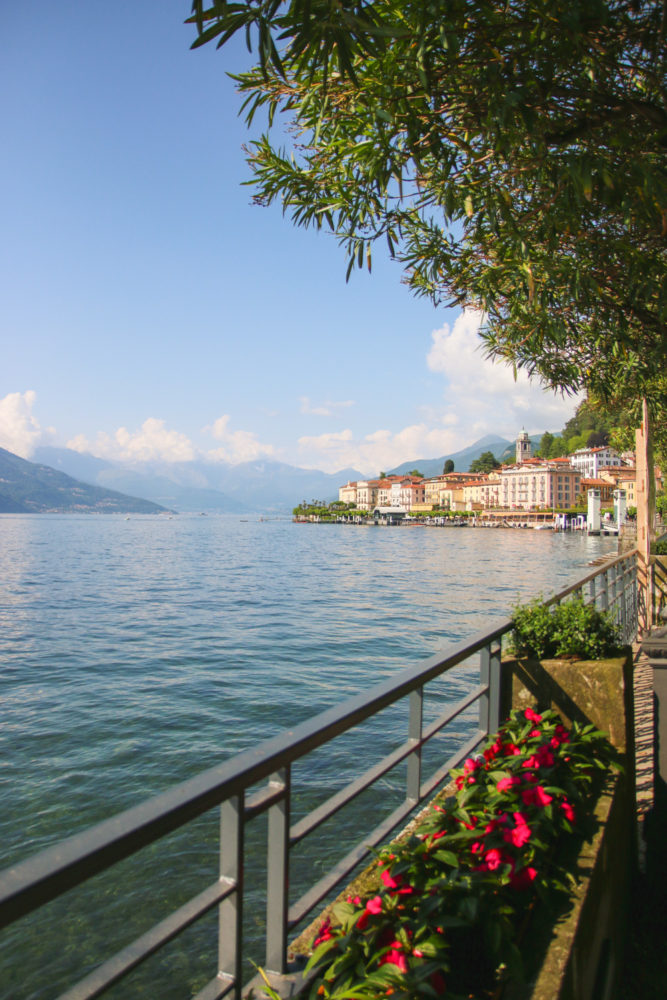
Day 4 – Bellagio, Lake Como
We headed into Italy on the 4th day, and those Italian roads and drivers are insane! We took the winding cliff and lakeside roads from Como to Bellagio, where we explored the town, treated ourselves to some gelato, and found a cute little campsite for the evening with a traditional trattoria with it’s own private beach area at the side of the lake where we settled down for the evening with a freshly baked proper Italian pizza, while we watched the sun set.
We didn’t really do much this day, but the views were amazing, and that campsite and pizza were honestly so good! It was a nice chilled day after all the walking we’d been doing the previous few days.

Day 5 – Sirmione, Lake Garda
This was one of my favourite stops of the trip, and somewhere that I’m dying to head back to at some point to see more of, because we just didn’t have long enough to see all of the things that we wanted to in the day that we spent there. Ideally we’d have spent 2-3 days driving along the lake, but with the two weeks that we had we could only really stop at one town.
So we chose Sirmione, as it’s one of the larger towns with so much history and so much to see. From beaches to swim in the warm lake water (and thermal springs), to old castles and ancient ruins to wander around. We spent a good few hours here, and then had the most chilled evening spent parked up for the night in the carpark right on the shore of the lake!
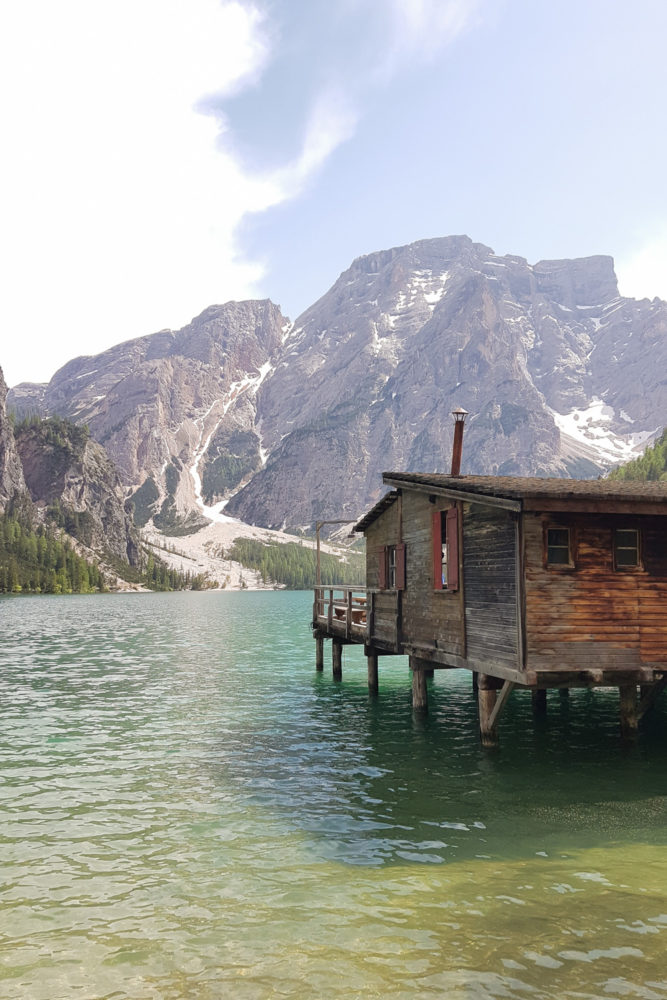
Day 6 – Lago di Braies, The Dolomites, Italy
Day 6 was another chilled day headed north from Lake Garda to Lago di Braies in the Dolomites of Italy. We got stuck in major traffic just outside of Garda because of a huge accident, but we finally arrived in Lago di Braies (also known as Pragser Wildsee) in the afternoon. Sadly, half of the lake was closed off for filming so the famous boathouse wasn’t open and we were quickly shuffled away by security so that filming could start.
By the time we walked to the far end of the lake, which was closed due to safety reasons from landslides, they’d shut off a whole other section of the lake for filming as we were headed back so we didn’t have the best experience here. That along with mega expensive parking for the campervan left us in a pretty bad mood about the whole thing. But, we found a campsite and spent the evening having a good clean up of everything, got all of our clothes washed and just chilled in the van with the rain rolling in.
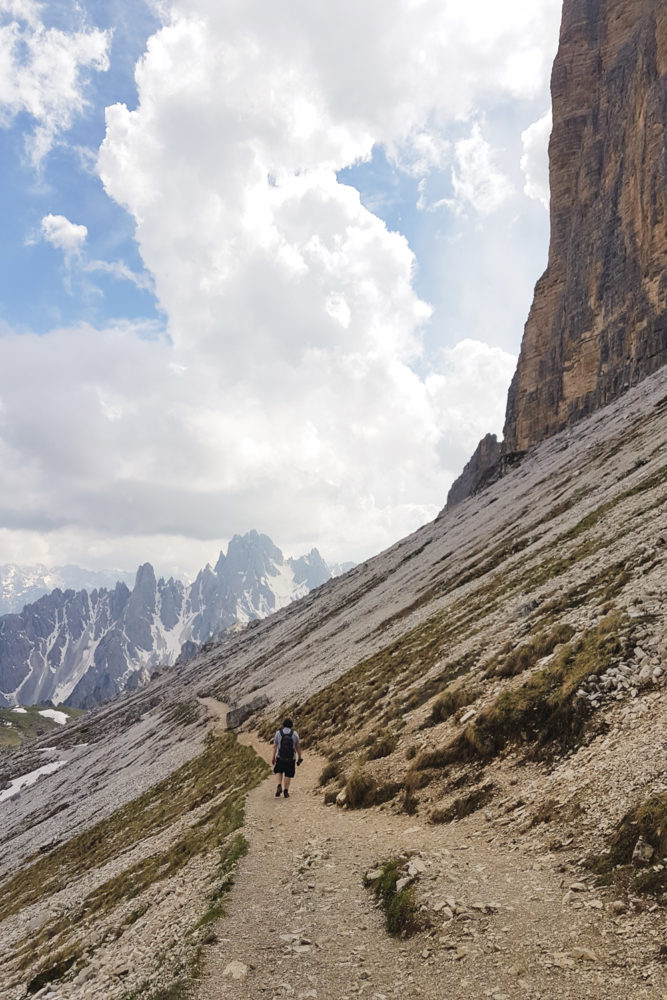
Day 7 – Tre Cime di Lavaredo
So we kind of did a huge detour on the whole trip because I really, really wanted to head to Lago di Braies, and the Tre Cime di Lavaredo, which was a good few hours north of the rest of the journey. But it was SO worth it. Tre Cime di Lavaredo turned out to be our favourite stop of the entire trip, and a night that we’ll never forget. And we *almost* didn’t head up there because we found out that morning while researching about it, that the road to the carpark was a toll road and would cost us €45 for the campervan!
We headed up anyway, and man was that road steep! I hated it, but the views from the top were amazing and I’m so glad we did it. We headed straight out to do the circular walk, which is actually pretty flat for the most part, but as the trail had only opened 5 days before we arrived, the snow hadn’t been cleared on the second part of the trail yet, and so to me, it was too dangerous to traverse the tiny slushy path that everyone else had made to get across, so we turned back. The views were incredible though, and you can stay overnight in the carpark, so we did just that to get our moneys worth! We couldn’t get over those views!
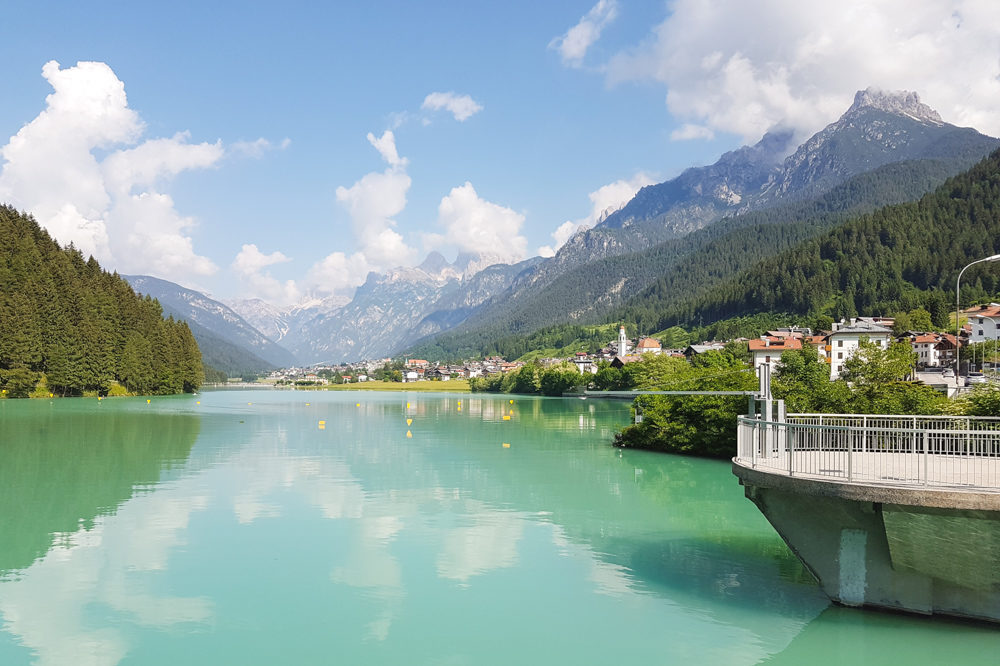
Day 8 – From Italy to Slovenia
Not every day goes to plan while you’re travelling right? Well, our day driving from The Dolomites of Italy to Slovenia didn’t quite go to plan. The roads up there in the Dolomites are insane, so the journey took double the amount of time than Google told us, but we did drive past some amazing views! It was crazy hot and humid and we were so over driving for the day. We headed to the coast of Slovenia, but as we arrived at Koper, they were shutting all the roads off into the main town faster than we could get in, so we scrapped that idea and headed to Piran instead.
Well that was a disaster too, because Slovenia is not very campervan/motorhome friendly, and all the parking was height barriered or full. So we scrapped that and headed to an aire that we found at the Marina. Well, go read the blog post to see how that one turned out haha!
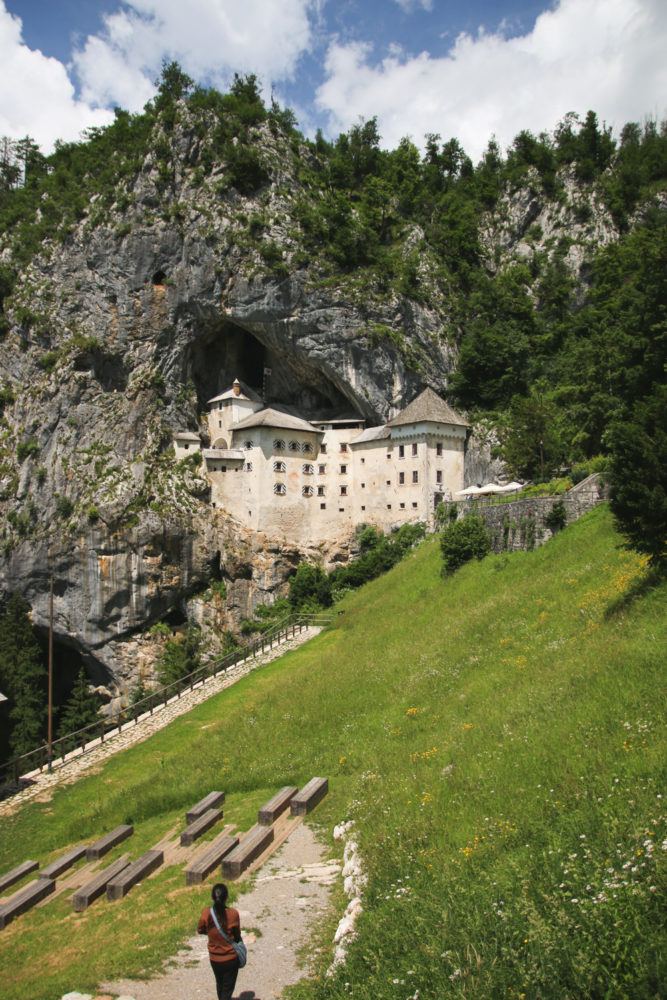
Day 9 – Predjama Castle & The Soca Valley
We headed back inland to explore more of Slovenia, and our first stop was to Predjama Castle. An old castle built into a huge cliff face and cave system. It was definitely worth a stop, and although we were unsure of whether to go inside the castle, because of mixed reviews online, we’re so glad we did (get the audio guide – it’s free)!
We then headed to somewhere I’ve been dying to visit for years! The Soca Valley. Just look at the colour of that river! We found a campsite right by the river, chilled out for a while and then went for a short walk to the Slop Kozjack waterfall, which passes right by the river. Definitely worth stopping by if you get the chance!
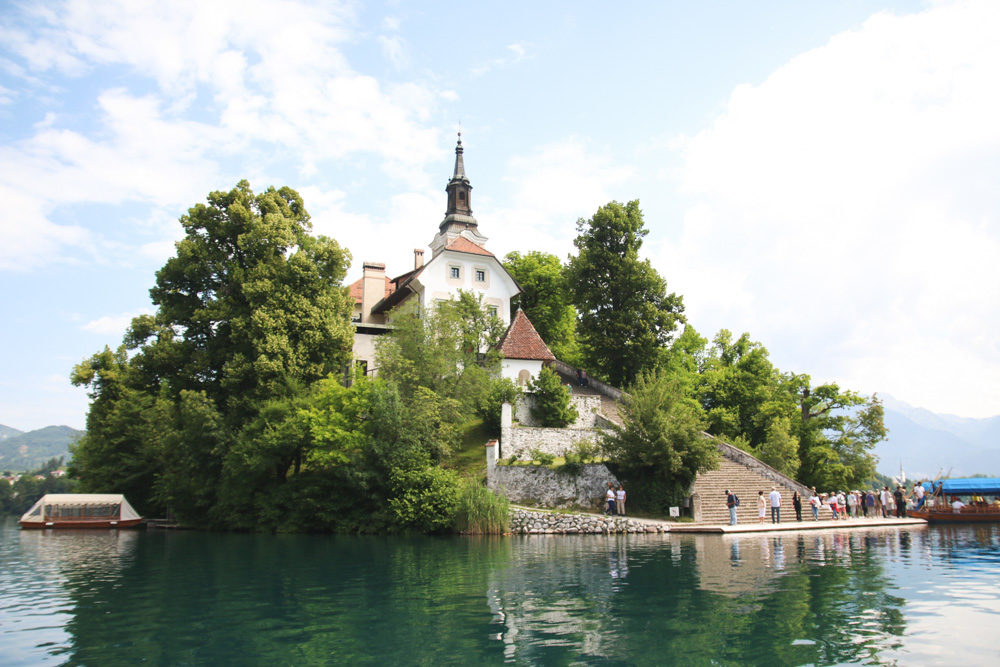
Days 10 + 11 – Lake Bled
This was the main reason we headed to Slovenia on this roadtrip! Ever since I first saw photos of the tiny island sitting in the middle of the lake, I knew we had to go there. It definitely didn’t dissapoint! We spent the afternoon walking around the lake (it’s only 6km) and taking in all of the views, before crashing for the night. It was SO hot and humid that we basically just didn’t want to move!
The next day, we hired a row boat and paddled out to the famous island. What an experience that was haha! There’s not much to do on the island, but it’s well worth a little paddle out and around it if you have time. There’s quite a bit to do at Lake Bled, so you can easily spend a couple days here.
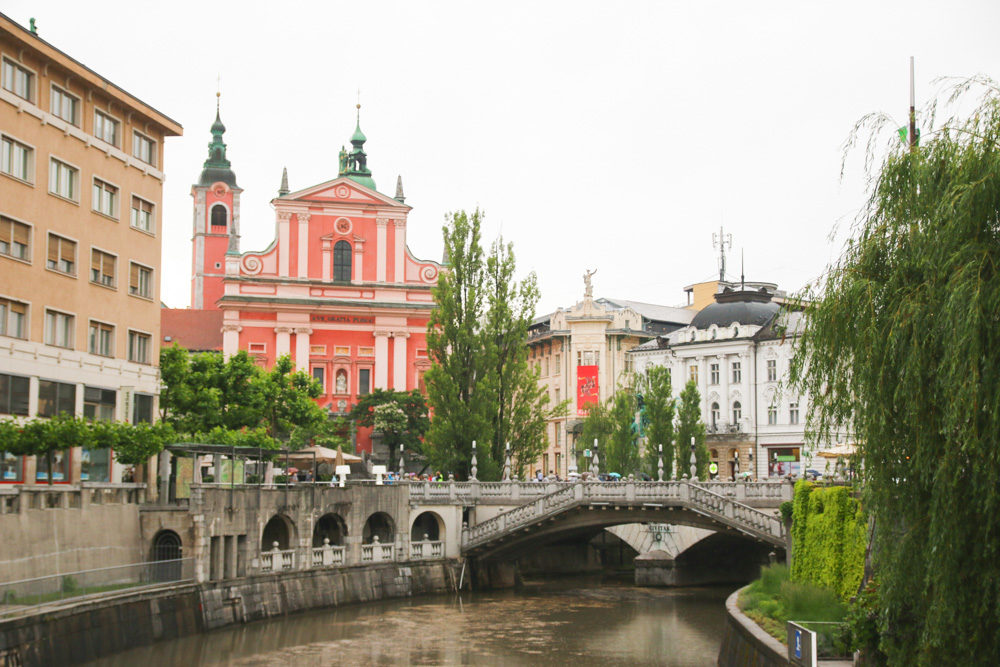
Day 11 – Ljubljana
After hiring a rowboat to paddle out to Bled Island, we hopped in the van and drove to the nearby train station to head to Slovenia’s capital, Ljubljana (pronounded Loo-blee-ah-nah). Being a city, we knew parking the van would be difficult, so we decided the best and easiest option would be to head there on the train. It only took an hour, and Shane got a nice rest from driving (he fell asleep). We arrived to torrential rain and the worst thunderstorm we’d ever seen.
It eased off after a while of hiding under the train platorms, so we headed out in search of food and sights. It’s such a lovely city to explore, and being so small, it really doesn’t feel like you’re in a city centre at all. We didn’t get to see everything we wanted though, as we found our missing cat (she was missing for just over a year), and my mum called to confirm it was her. So we cut our day there short and headed back to the van to make a start on heading home early to see her! So after this point the trip was a bit of a rush, with long, long driving days. But we would have had a few extra days exploring Austria and Germany.
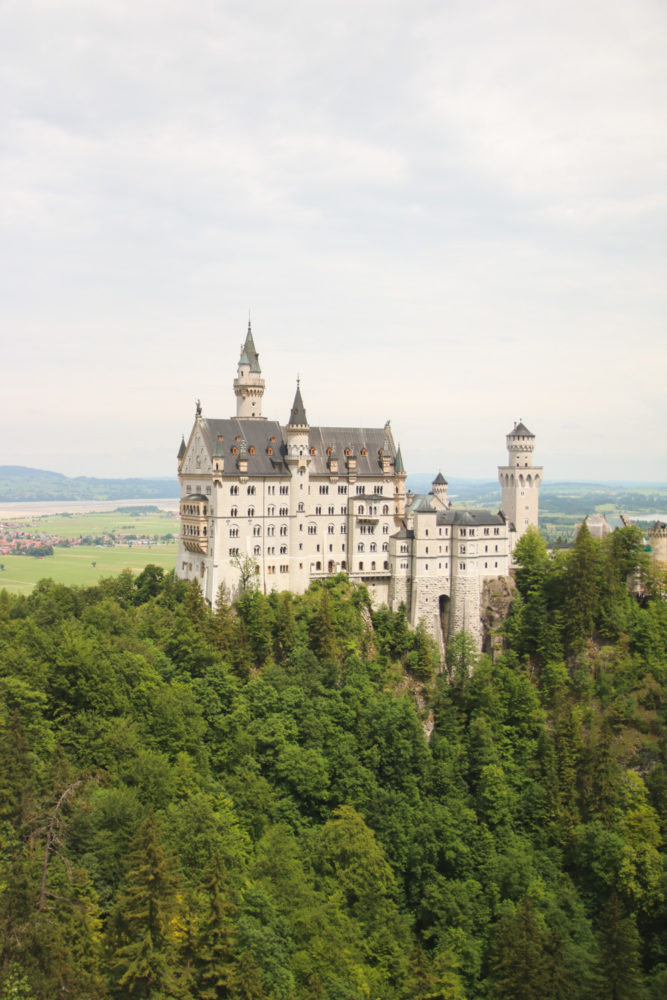
Days 12-14 – Hallstatt, Neuschwanstein + the Journey Home
So ideally, day 12 would have been us driving from Lake Bled to Hallstatt in Austria, exploring the town for a couple hours, heading up the gondola and then taking a slow drive towards a campsite near Neuschwanstein. But instead, we drove to Hallstatt, couldn’t find parking, gave up and headed towards Neuschwanstein and just chilled for the afternoon/evening.
Day 13 was spent at Neuschwanstein Castle and the nearby town of Fussen. We loved the exterior of the castle, but honestly, the inside was a letdown. Save your money and go for a hike in the woods surrounding the castle to get the best views instead, as you can access all of the surrounding area for free (you only need to pay car parking). Fussen was such a lovely little town, filled with pastel buildings! I wish we could have stayed longer, but we had a long 8hr drive back to Luxembourg that evening, ready for our drive back to Calais the next morning for our ferry that afternoon!

So, that’s our entire two week itinerary. You can read the full posts on each day for more detail. We absolutely LOVED the trip, and although we had to cut the trip short (which we were SO ok with), we wished that we had those extra few days to see more of Austria and Germany.
I created a little Google Map below, which you can open to see the trip in more detail, including details of each campsite/parkup we stayed at throughout the trip, all of the places we visited for sightseeing and the entire journey. Just open it up for more details, or you can even save it to your own maps for future reference!
We’ll be doing a full Q&A post soon, answering loads of questions about the trip, like how much it cost us, where we loved the most, which country was the most accomodating for campervans (and which wasn’t). So, if you have any questions you want us to answer, just leave us a comment below and we’ll include it in the post!
Where’s your favourite roadtrip you’ve done in your van so far?
Watch all of the Vlogs!
You Might Also Like...

Two Weeks in Slovakia, Austria + Germany in a Campervan – Our Itinerary

Europe Roadtrip Day 9: Predjama Castle & The Soca Valley
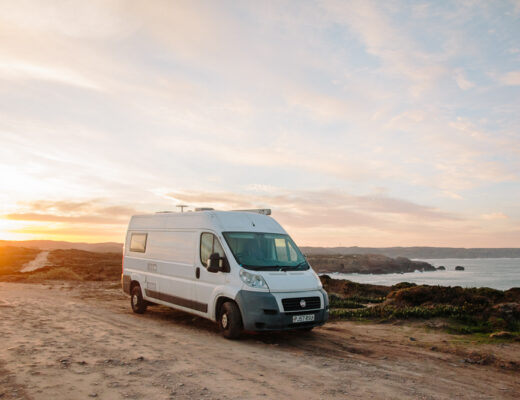
Our Two Week Spain + Portugal Itinerary in a Campervan
No comments, leave a reply cancel reply.
Save my name, email, and website in this browser for the next time I comment.
This site uses Akismet to reduce spam. Learn how your comment data is processed .
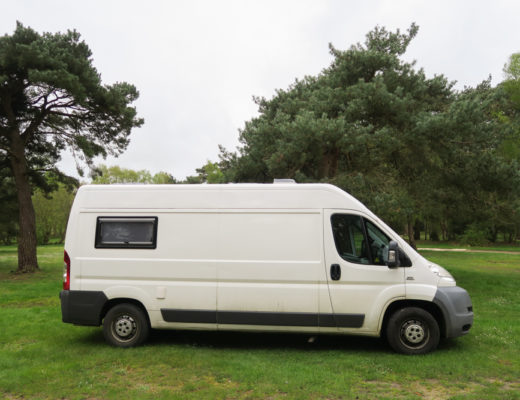
Should I build a Campervan?
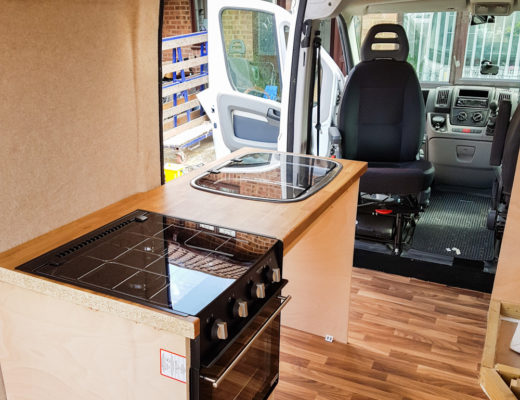
Van Conversion - Building the Kitchen

VW Camper Hire Blog
For Everything VW Campervan!

Top Ten European Campervan Road Trips
If you are thinking about planning an road trip across Europe in a campervan then the choice of adventure is huge. From Norway all the way down to Sicily, there plenty of routes to choose from so here are our Top Ten European Campervan Road trip Routes. With so much to explore, you’d be silly not to make the most of our holiday campervan hire .
1. Switzerland, France, Italy
Starting in Geneva, you will head south along the shoreline and enter into France. Then this 500 mile route will take you on a journey under the world, the Mont Blanc tunnel is a 7 mile track under the highest of the Alps where you will emerge in Italy. Continuing south from Turin, visit Florence then wind back up north of the Alps via the historic city of Milan.
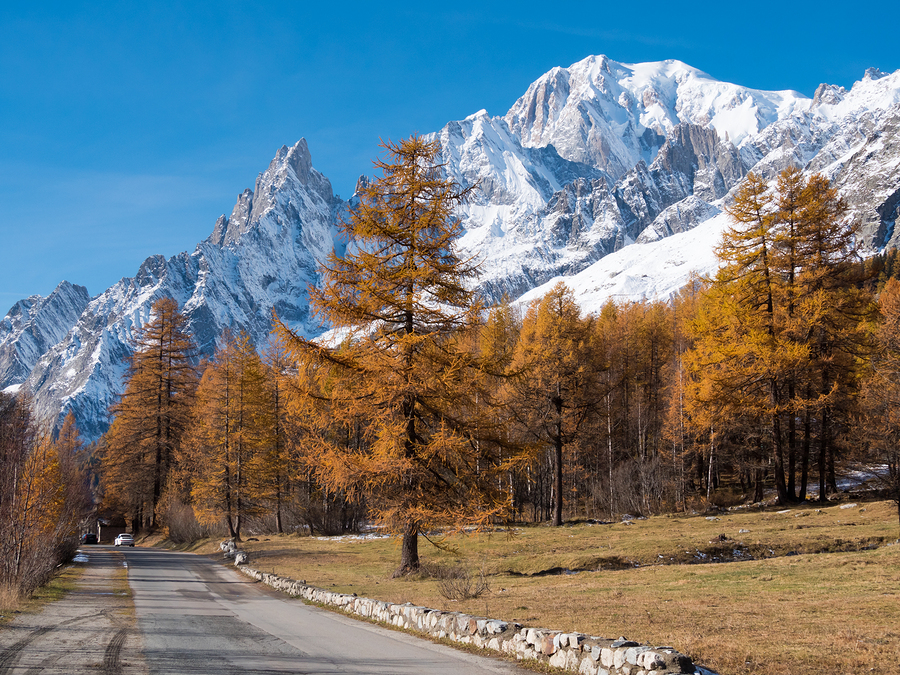
2. Bergen to Oslo, Norway
This 800 mile route has a variety of beautiful scenery like green meadows that give way to spectacular mountains, coastal towns and rocky shoreline. Keep a sharp eye out for elk they are plentiful in the area where they make the deep woods and pristine fjords their home. Make time to visit historic Bergen before the trip and take a cable car ride up the mountain.
3. Costiera Amalfitana, Italy
This fun route visits 13 different Italian towns along a picturesque seashore that was included on the world heritage list in 1997. Full of small fishing villages and historic landmarks, this route is perfect for those who want a relaxing trip. Don’t miss the medieval castle in Maiori or the Roman ruins in Minori or the Emerald cave in Conca dei Marini.

4. Ruta de los Pueblos Blancos, Spain
This popular tourist route will take you through the Sierra de Cadiz Mountains and the Sierra de Grazalema Natural Park. Be sure to visit Arcos de la Frontera recognized as one of the most beautiful villages in Spain. Be sure to visit the Moorish castle and the Roman ruins.
5. Ring of Kerry, Ireland
This is a popular circuit around the Iveragh Peninsula. You will circle steep mountain slopes and experience lush green valley’s while crossing over rivers and lakes and passing by beautiful sand beaches and rugged coastlines. There are many interesting stops along this route, whether you are interested in churches or castles or waterfalls.
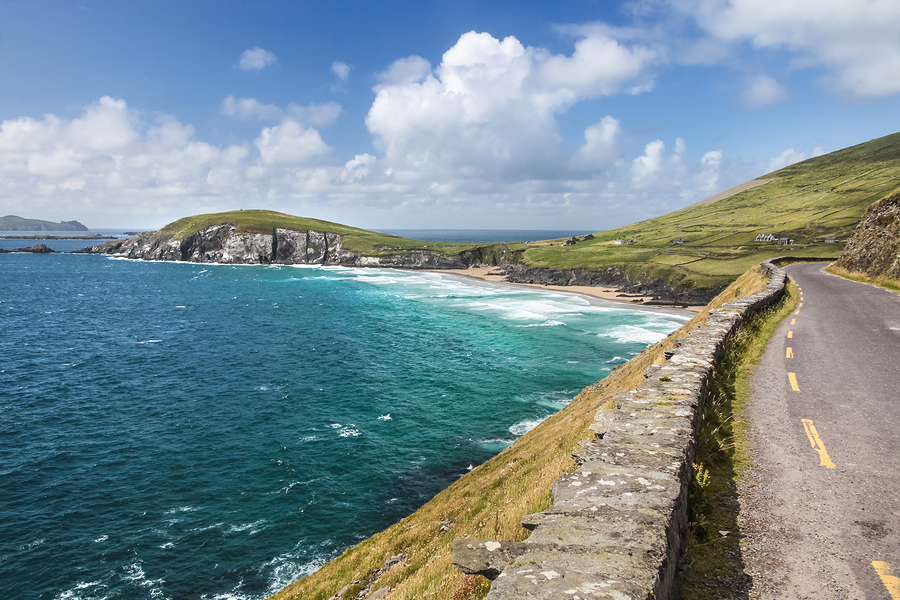
6. Trans Romania
The Transfagarasan crosses the Fagaras Mountains and is a popular tourist route for foreigners interested in exploring the legend of Dracula. Don’t miss the Poienari fortress which was the main residence of the Transylvanian leader Count Dracula.
7. FurkaPass / Central Swiss Alps
You may have heard of the Furka pass if you are a fan of 007. This pass was the site of the famous car chase in the James Bond movie Goldfinger. A don’t miss feature of this drive is the Rhône glacier you can park and take a short hike to the glacier where you can actually explore the inside of the glacier itself.

8. Col de la Bonnette / Alps Maritimes
The Col de la Bonnette is probably one of the most well-known roads in the tops as it is the highest road in Europe. You will enjoy the stark contrast of the natural environment that evolves from lush green fields to a barren, craggy mountaintop. This is also the area where the Tour de France passes.
9. Grossglockner Hohenalpenstrasse, Austria
This route begins in Oberes Nasfeld and continues to Franz-Josefs-Hohe. A variety of landscapes: meadows, prairies, and the mountainsides are yours to enjoy during your drive. Not to be missed is a spectacular view of the Pasterze glacier at the end of the road trip.
10. Pas de Calais – across the coast
Pas-de-Calais is bordered in the North by the English Channel and to the northeast by Belgium with Picardy the the South. One of the prettiest drives in northern France you will experience classic rural roads and wide sand covered beaches. You will see ancient churches, tree-lined boulevards full of boutiques and eateries, and a historic fishing port.
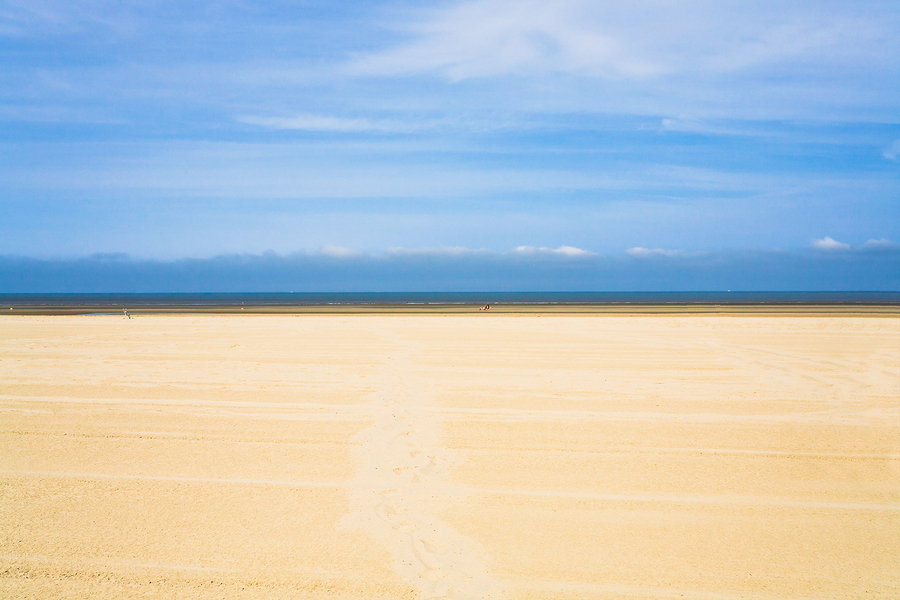
- Latest Posts
- Boardmasters Festival 2018 – Don’t Miss Out! - November 14, 2017
- SheltaPod Campervan Awnings - October 23, 2016
- The Best Beautiful Beaches in Dorset - March 30, 2016
- ← VW Campervans in the Snow
- Scotland’s North Coast 500 – the UK’s Route 66 →
Vanessa James
Vanessa loves alls things VW and has a passion for travelling around Europe in modern and retro campervans.
You May Also Like
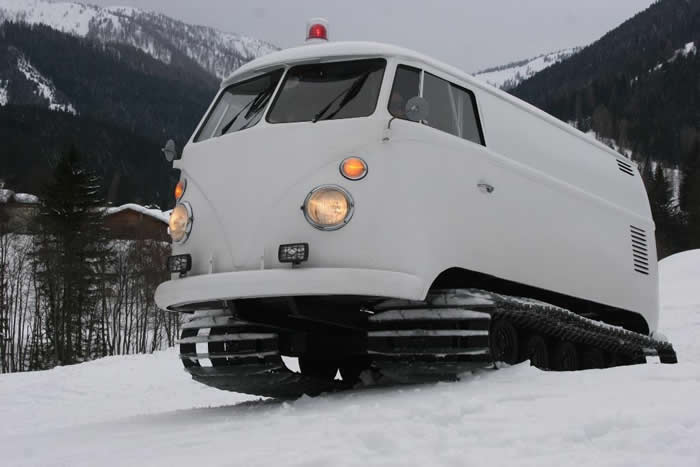
VW Campervans in the Snow

Top 10 Tips for a Successful VW Campervan Adventure

Bertie has been reupholstered for 2014
Leave a reply cancel reply.
Your email address will not be published. Required fields are marked *
This site uses Akismet to reduce spam. Learn how your comment data is processed .

- Home take me
- Travel Guides
- Itineraries
- Travel Tips
- North America
- About me learn more
- Contact get in
Europe Road Trip from The UK – A Magical 10 Day Motorhome Itinerary!
Last Updated on 7 November 2022
*This post may contain affiliate links , which means that if you decide to make a purchase through one of these links, I will receive a commission at no extra cost to you! This allows me to continue bringing you valuable content for free and any purchases you make via these links are gratefully appreciated. Please refer to my Disclosures for more information.*
Fancy an enchanting road trip to some magical towns and cities.
Motorhome, RV, Campervan… call them what you will, but jumping in one and hitting the autobahns for a road trip through Europe is one of the best ways to explore the continent! They are literally homes on wheels that allow you the freedom to go (nearly) anywhere your heart desires. And what better contenders for a 10 day driving holiday to Europe than Germany and Belgium? On this Europe road trip from the UK, you will visit 2 of Belgium’s most charming cities and 6 of Germany’s most beautiful small towns (including a real hidden gem) which make for some of the most unique places to visit in Europe! So you can expect a complete overdose of storybook charm, but who could ever get bored of these uniquely enchanting settings, ay?

Tip: There are various opportunities for cycling on this Europe road trip itinerary. So be sure to strap your bicycles to the back of your motorhome otherwise you’re going to miss out on some real good stuff!
Note: Just because this is a motorhome itinerary, there’s nothing stopping you from using this if you’re looking for car road trip ideas for Europe. Instead of staying in the campsites, just book yourself into a hotel for each of the overnight stops.
Road trip to Europe itinerary overview
Tip: When you’re road tripping in Europe, to avoid unexpected charges set your satnav to avoid toll roads if this option is available to you. Or do your research beforehand so you know where they are!

Spanning ~1,650km (~1025 miles), beginning and ending in the French port of Calais (which is very accessible from the UK) and broken down into manageable chunks for daily driving, this campervan route around Europe will take you to some stunning cities in Belgium and beautiful medieval towns in Germany near the Rhine, Moselle and beyond across 10 days. And to avoid backtracking and effectively utilise your time on the continent, it’s a fairly circular route (just like this 7 day motorhome itinerary for Scotland )!
Note: This European road trip route includes both on and off site options for overnight parking. On site means on a campsite where there are facilities. Always check which months these are open as some campsites close off peak, and pre-book if possible. Off site means not on a campsite, so there may be no facilities, and availability cannot be guaranteed. Do your own research prior to departing for up to date information.
Know before you go
Always check the entry requirements for the country you are visiting to see if you will need a Visa to enter, and that you have enough validity left on your passport.
Always have a good level of travel insurance for every international trip. This is a non-negotiable part of any trip abroad, as the unexpected can happen.
When is the best time to visit Western Europe?
Western Europe is a year-round destination. But dependent on your personal preferences, there may be some times that are better to visit than others. For example, during the European summer holidays which span from around late June-August, prices may be inflated and roads can be busier. During this time, it is advisable to book everything you need to in advance, and give yourself extra time to get from A to B. If you don’t want to find yourself stuck in traffic on a hot summers day, perhaps avoid these months. May-early June and September can be good options for a road trip of Europe.
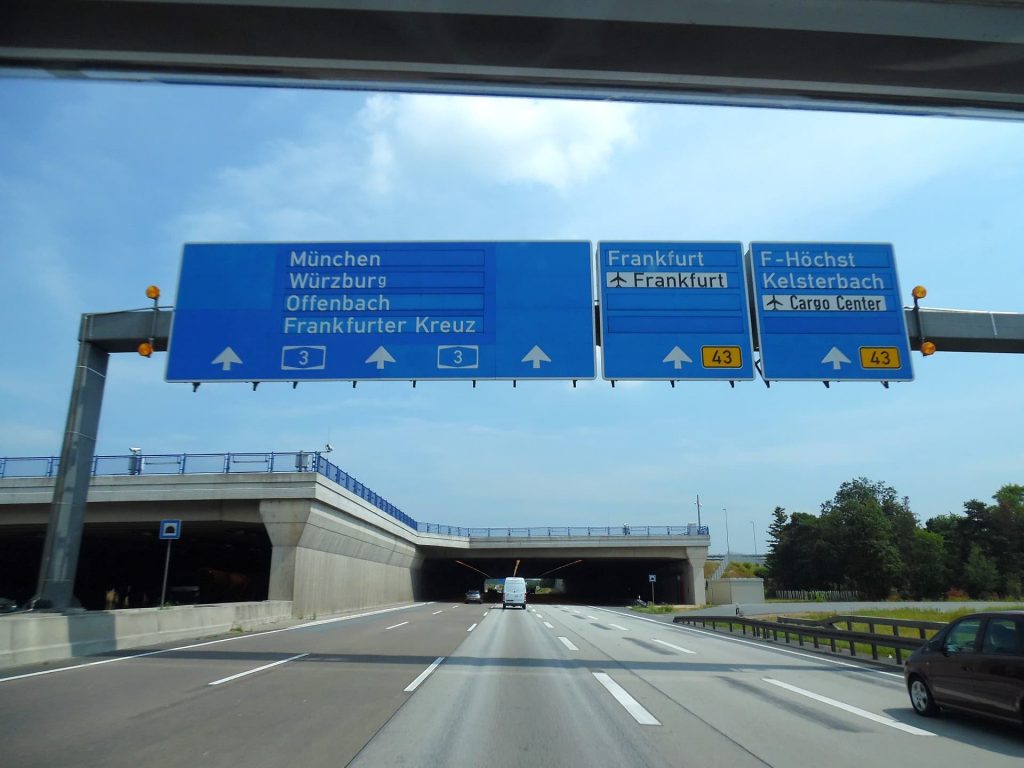
Tip : Visiting Europe off peak is one of the top tips on how to travel cheaper in Europe !
Can you drive from the UK to Europe?
Yes, absolutely. Although not across the channel unless you’ve got a super villain car-boat hovercraft type vehicle. The best way to reach Europe from the UK by road is to get the ferry from Dover or the Eurotunnel from Folkestone to Calais in France. There are other ports that you can use to reach various countries in Europe (e.g. France, Belgium or The Netherlands) which may be easier if you live in other parts of the UK, like Poole, Portsmouth, Hull, or Newhaven.
Tip: Research ferry prices and don’t assume that the port closest to you has the cheapest fares. Sometimes it works out cheaper to drive to a UK port that’s a little bit further from you (like Dover, because of the frequency of crossings available)!
What currencies do I need?
The currency in United Kingdom is the Great British Pound (£) – you will probably inevitably have this already as this is a road trip itinerary for Europe from the UK, unless you are using this as an add on for a United Kingdom itinerary!
The currency in France (where you will arrive), Belgium and Germany is the Euro (€) .

Day 1 of Europe road trip from UK
Get outbound ferry from the port of dover, uk, to calais, france, and then drive to antwerp in belgium, useful information for day 1.
Total distance: Calais to Antwerp is ~204km (~127 miles) Overnight stop: Camperpark Vogelzang , Antwerp (kind of like a grassy parking area for motorhomes that’s well located to explore Antwerp)
Morning itinerary for Day 1
Arrive at the Port of Dover, UK, and embark on the 1.5 hour journey across the English Channel to Calais, France. Once you reach solid continental ground, drive ~204km (~127 miles) to Antwerp, Belgium. Antwerp is the capital of the diamond trade and is much more than just an industrial port side city – it’s a cosmopolitan place boasting a maze of medieval architectural delights! Park up at Camperpark Vogelzang which will be your first overnight stop on this road trip through Europe from the UK.
Tip: As a general rule, early morning ferry crossings (I’m talking before 7.00am) are usually cheaper than one’s that depart at a more humane time. So if you want this trip to be kinder to your wallet, rise and shine early! I always book with P&O Ferries from Dover to Calais (and vice versa), but DFDS operate this route too.
Afternoon itinerary for Day 1
After lunch, jump on your bicycle and use the extensive network of cycle paths to navigate your way into the city centre. Spend your afternoon sightseeing in Antwerp – trundle the pretty cobbled streets of the Old Quarter, see the 16th century guild houses which line the Great Market Square (Grote Markt), and wander the renowned Antwerp docks! Once you’re all tired out from exploring, head back to camp and settle in for an early evening (it’s likely to have been a long day)!

Tip: If you don’t have any bicycles with you (which I highly recommend you do because there’s some fantastic cycling opportunities on this motorhome itinerary for Europe), you can use public transport to get from Camperpark Vogelzang into the city centre.
Day 2 of Europe road trip from UK
Antwerp, belgium to linz am rhein, germany, useful information for day 2.
Total distance: ~261km (~162 miles) Overnight stop: Wohnmobilstellplatz am Rhein , Linz am Rhein (GPS coordinates are 50° 33′ 44″ N 7° 16′ 48″ E or search the name on Google Maps) – off site parking on the side of the River Rhine a stone’s throw from the Old Town, limited parking spaces, train nearby so can be noisy
Morning itinerary for Day 2
Today you will travel from Belgium across to German soil – the land famous for beer, Bratwurst, cuckoo clocks and lederhosen’s! Rise and shine early this morning and hit the road bound for Linz am Rhein, Germany. Linz am Rhein is a charming town located on the banks of the roaring River Rhine, and is the first of the most beautiful small towns in Germany you will visit on this road trip through Europe! Aim to reach Wohnmobilstellplatz am Rhein by lunchtime, so you have the whole afternoon for exploration!
Tip : There are only a small number of campervan spaces at Wohnmobilstellplatz am Rhein, so you might want to have a plan B just in case you can’t park. Each time I’ve visited there’s been vacant spaces, but failing to plan is planning to fail as they say.

Afternoon itinerary for Day 2
After you’ve refueled with food, spend some time wandering the cobbled streets of Linz am Rhein. The Old Town is full of half-timbered wonky buildings that are adorned with striped shutters, and has its own pretty little market square decorated with fountains. You’ll also find some unique shops and quaint cafes here too. And don’t miss The Neutor – a preserved tower of the old city wall fortifications which rises high above the town. After an afternoon strolling, retire back to your motorhome for dinner with a view over the busy River Rhine!
Tip: There’s a Linz in Austria too, so make sure you include the ‘am Rhein’ bit. Otherwise your journey from Antwerp is going to be hundreds of miles longer!
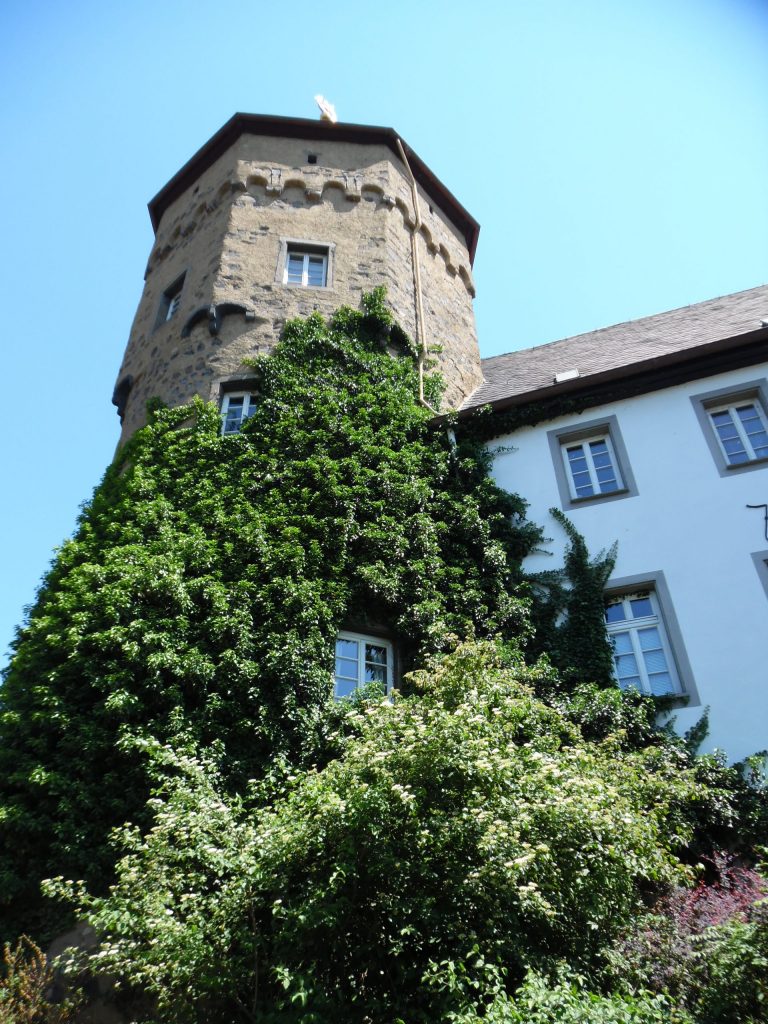
Day 3 of Europe road trip from UK
Linz am rhein to bacharach, germany, useful information for day 3.
Total distance: ~87 km (~54 miles) (follow the River Rhine) Overnight stop : The motorhome parking area adjacent to and managed by Sonnenstrand Campsite in Bacharach (just set your satnav for Sonnenstrand Campsite)
Morning itinerary for Day 3
Today, you will continue your journey down the mighty River Rhine and visit another of Germany’s magical towns. And there’s no need to get up at the crack of dawn today (unless you want too, of course) because the distance you’ll cover is much less compared to yesterday’s mammoth drive! After breakfast, enjoy the scenic route alongside the River Rhine, passing many vineyards and towns on the way (if you take the route through Koblenz and via Boppard you’ll pretty much follow the river the whole way). When you arrive in Bacharach, park up at the hard standing motorhome parking area adjacent to Sonnenstrand Campsite.
Tip : Many of the campsites in this itinerary were found using the Camperstop book , which is like the bible of European campsites and off-site parking spots and a trip planning tool I can’t plan travel without.
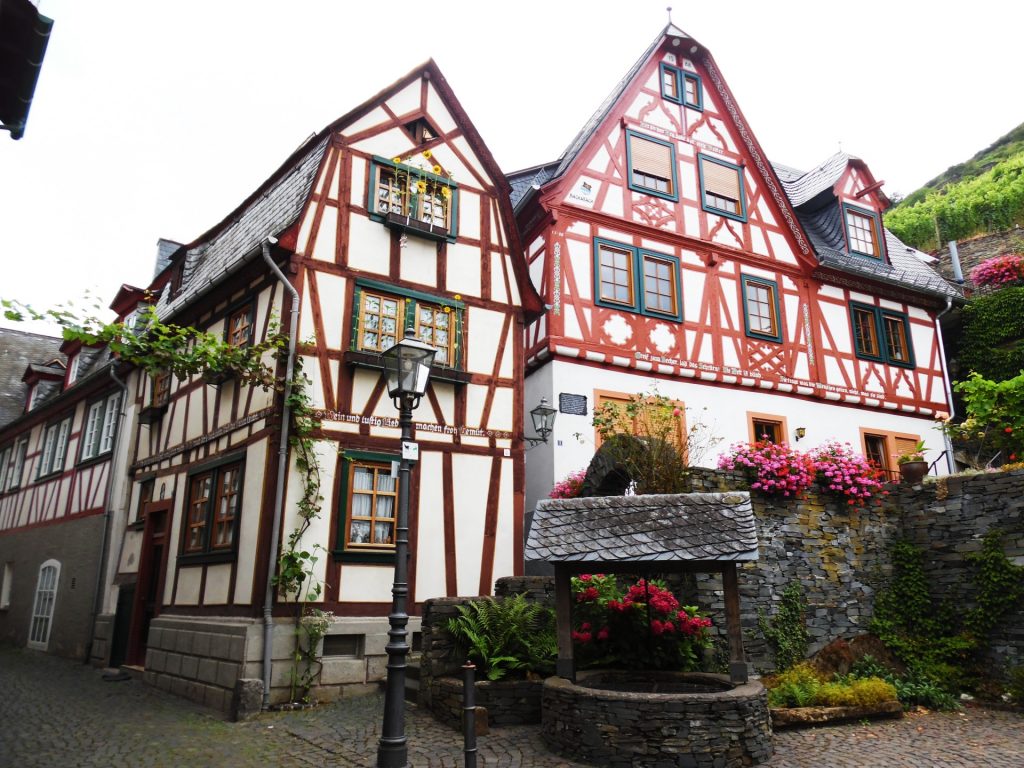
Afternoon itinerary for Day 3
This afternoon, spend some time wandering the quaint town of Bacharach. As you enter via the walls that conceal Bacharach, a medieval Old Town will unravel before your eyes. Full of half-timbered wonky buildings, cobbled streets, and crafty shops, Bacharach is a charming place to spend your afternoon. Wander up through the vineyards to Postenturm Tower for spectacular views over the town and Rhine valley. And afterwards, jump on your bicycles and head north alongside the river, following the flat paths to the nearby town of Oberwesel and then Sankt Goar (if you’re feeling energetic).

Day 4 of Europe road trip from UK
Bacharach to rothenburg ob der tauber, germany, useful information for day 4.
Total distance : ~255 km (~159 miles) Overnight stop : Any of the allocated motorhome parking areas surrounding Rothenburg ob der Tauber (P2 or P3) – these are equipped with toilets and electric hook up
Morning itinerary for Day 4
Today calls for another early start, so after breakfast hit the road bound for Rothenburg ob der Tauber. Rothenburg ob der Tauber is perhaps one of the most famous stops on the renowned Romantic Road – (one of the most well loved and best road trips in Europe)! This fairytale settlement has one of Germany’s best preserved medieval Old Towns, so it will come as no surprise that it’s a busy little place! It’s the most southerly point of Germany you’ll reach on this road trip around Europe, before you head west tomorrow and after start making your way back north. Park up at P2 or P3 (Rothenburg’s allocated parking areas for motorhomes) and get yourself settled in.
Tip: It can be good to try and get an early start on your daily driving, so you can maximise your time exploring each place of an afternoon. Plus, the roads are usually quieter in the mornings (aside from the work rush hour). But if you get tired, be sure to pull over for a rest.
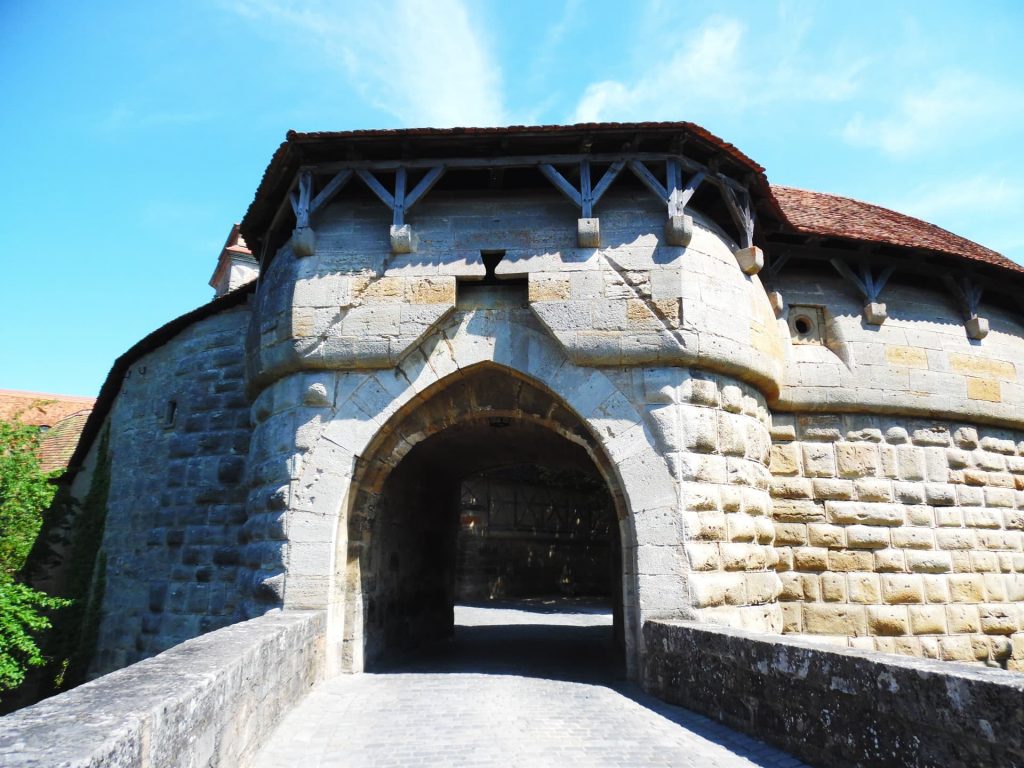
Afternoon itinerary for Day 4
This afternoon is your chance to step into a real life children’s storybook and enjoy some sightseeing in Rothenburg ob der Tauber. The Old Town is purely enchanting and is bound to captivate your imagination, and visiting is definitely one of Europe’s bucket list experiences! Go wherever your curiosity takes you but be sure not to miss walking around the city walls for picturesque vistas across the terracotta roofs that fill the Old Town! Take another wander after sunset once the many tour groups have departed and calm prevails, before heading back to your van!

Tip: Rothenburg ob der Tauber has some year-round Christmas shops which sell some of the most beautiful festive decorations you’ll ever see, like Kathe Wohlfahrt . If you’re a Christmas fanatic (like me) you’ll definitely want to visit one of these!
Day 5 of Europe road trip from UK
Rothenburg ob der tauber to ladenburg, germany, useful information for day 5.
Total distance : ~176 km (~109 miles) Overnight stop: Wohnmobilstellplatz Ladenburg
Morning itinerary for Day 5
Today it’s time to head off the beaten path, and drive west across to a little settlement called Ladenburg. It might not be one of Germany’s most well known historic towns, and you may have never heard of it before. But sometimes places like these turn out to be real hidden gems, and Ladenburg is no exception to the rule. So on morning 5 of your Europe road trip from the UK, head from Rothenburg ob der Tauber to Wohnmobilstellplatz Ladenburg. Wohnmobilstellplatz Ladenburg is a quiet spot beautifully situated just outside the quaint town of Ladenburg in amongst the fields, with easy access to an abundance of flat cycle paths.
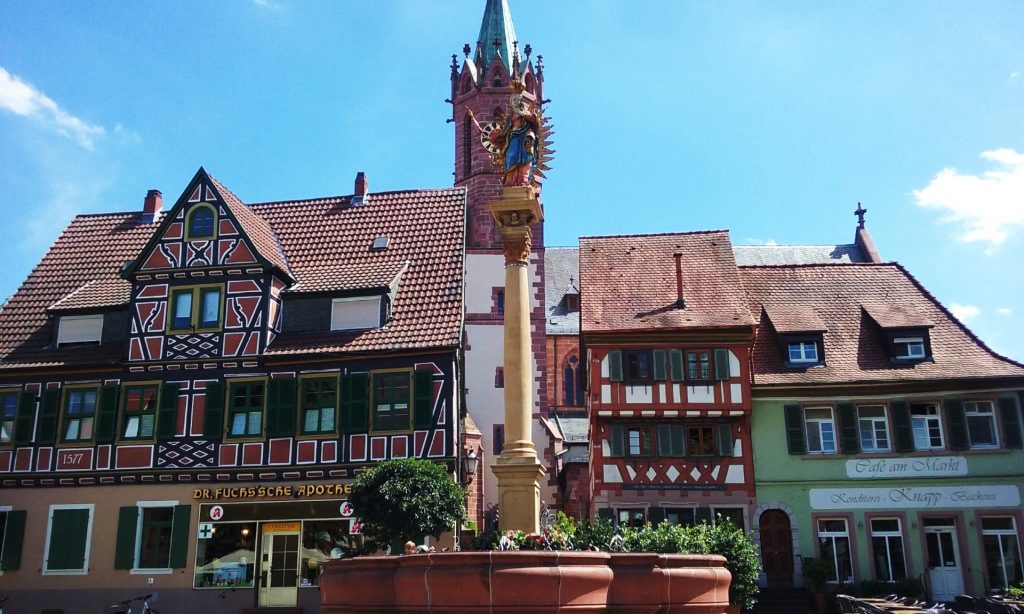
Afternoon itinerary for Day 5
After lunch, spend your afternoon enjoying the peace and quiet of Ladenburg. Wander the through the medieval Old Town, where the streets are lined with half-timbered wonky houses, cobble stones, statues, fountains, and little independent shops. Be sure not to miss the market square, with St Gallus Church in the backdrop. After you’ve strolled through Ladenburg, jump on your bicycle and enjoy the flat cycle paths that crisscross the fields (it’s a cyclers paradise). Navigate your way south by following the Neckar River to the University famed town of Heidelberg. Then, after you’ve enjoyed a bit of Heidelberg and seen the The Karl Theodor Bridge, cycle back to camp!

Day 6 of Europe road trip from UK
Ladenburg to cochem, germany, useful information for day 6.
Total distance: ~174 km (~108 miles) Overnight stop: Moselle riverside parking (GPS coordinates: 50° 9′ 10″ N 7° 10′ 6″ E)
Morning itinerary for Day 6
After breakfast, depart from Ladenburg north through Germany to Cochem. Cochem is a beautiful town located alongside the Moselle River, and is surrounded by rolling vineyards. One of Germany’s best loved medieval towns, Cochem is overlooked by Cochem Castle and has a perfectly preserved and pedestrianized Old Town, hidden away behind fortified walls and gates. It’s a stunning place to stop on any European road trip given its indisputably picturesque location.

Afternoon itinerary for Day 6
Once you’ve found your overnight stop, enjoy some lunch with a view. Then, wander into Cochem to explore the Old Town, and be sure to head up to the castle for spectacular views down through the Moselle too. Cochem is another prime location for some cycling, given the abundance of flat paths which span the Moselle River, so dedicate some time to this before settling in for the evening!
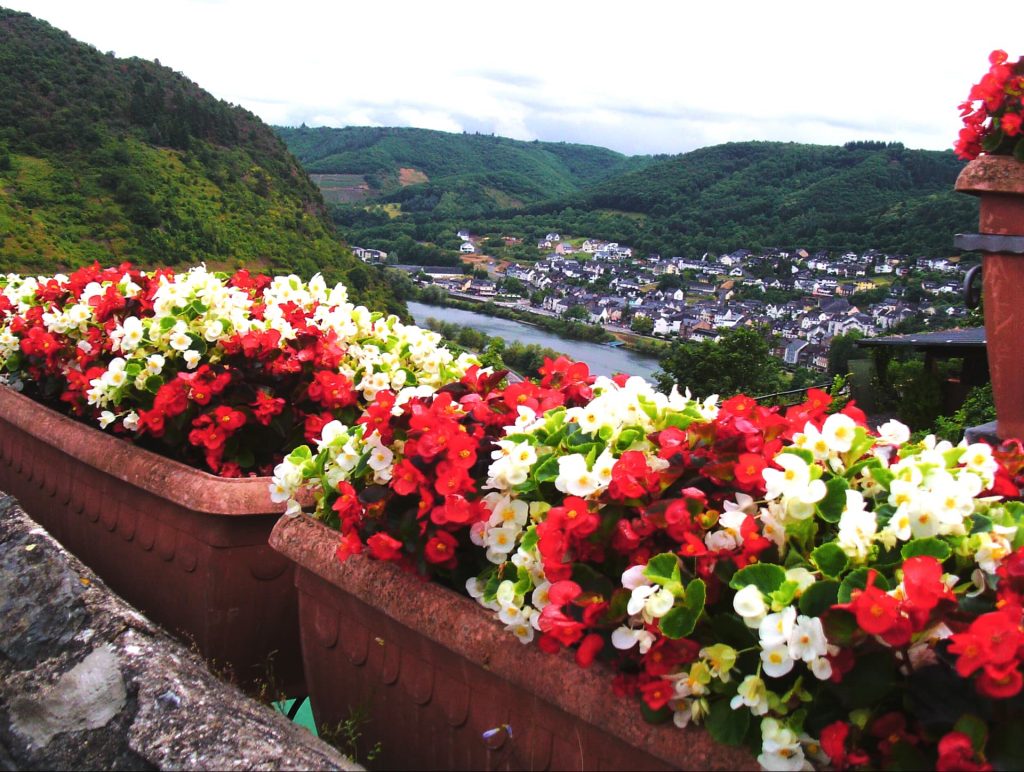
Tip: There are various spots that allow overnight parking for motorhomes in Cochem should you not be able to get into the one listed above, as the town is another well loved stop on motorhome routes through Europe.
Day 7 of Europe road trip from UK
Cochem to monschau, germany, useful information for day 7.
Total distance: ~111 km (~69 miles) Overnight stop: Campsite Perlenau , Monschau
Morning itinerary for Day 7
Today, continue north up through Germany to the tiddly town of Monschau which lies very close to the border with Belgium (and a short drive to The Netherlands too). As the distance from Cochem to Monschau is a bit shorter at than some of the other distances you have driven, you can afford to leave a little later if you wish to enjoy the serenity of the Moselle River a bit longer. Head towards Campsite Perlenau in Monschau which will be your overnight stop tonight.
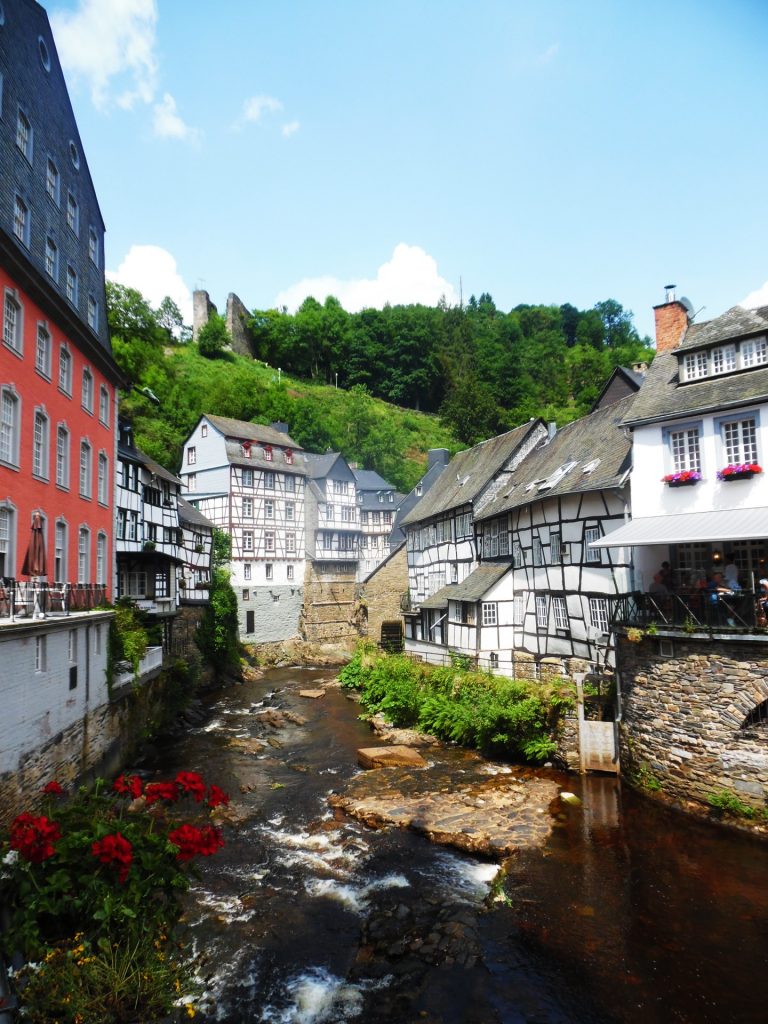
Afternoon itinerary for Day 7
Once you’re parked up and settled in, wander or cycle into Monschau. Monschau is crammed full of traditional half-timbered houses, little shops, and cobbled streets, and is a sociable town with many quaint cafes. Immerse yourself in the magical aura of the town for the afternoon, as this is the last German town you will visit on this road trip to Europe from the UK! Perhaps sit for a while and soak up the medieval atmosphere which permeates the narrow streets, whilst enjoying a cold German beer!
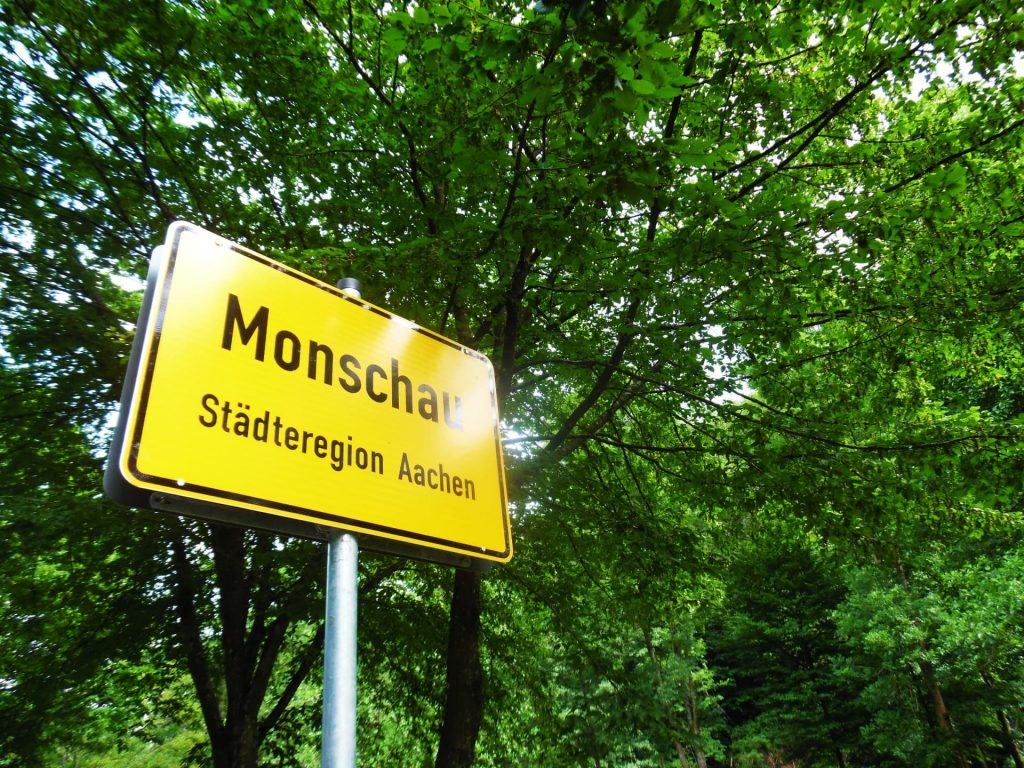
Day 8 of Europe road trip from UK
Monschau to bruges, belgium, useful information for day 8.
Total distance : ~249 km (~155 miles) Overnight stop: Parking Kanaaleiland , Bruges (GPS coordinates: 51° 11′ 44″ N 3° 13′ 35″ E)
Morning itinerary for Day 8
On Day 8, it’s time to wave goodbye to Germany and hop over the border back into Belgium. As you are nearing the end of your Europe road trip from the UK, it’s time to work your way back towards the Port of Calais in France. But before it all comes to a sad end, visit the the UNESCO World Heritage Site of Bruges. Bruges is a city in Belgium that is world renowned for it’s beauty – think canals, horse and carts, cobbled-streets, Gothic architecture, museums, red bricked medieval step roofed houses, Belgian waffles, and an overload of chocolate shops!
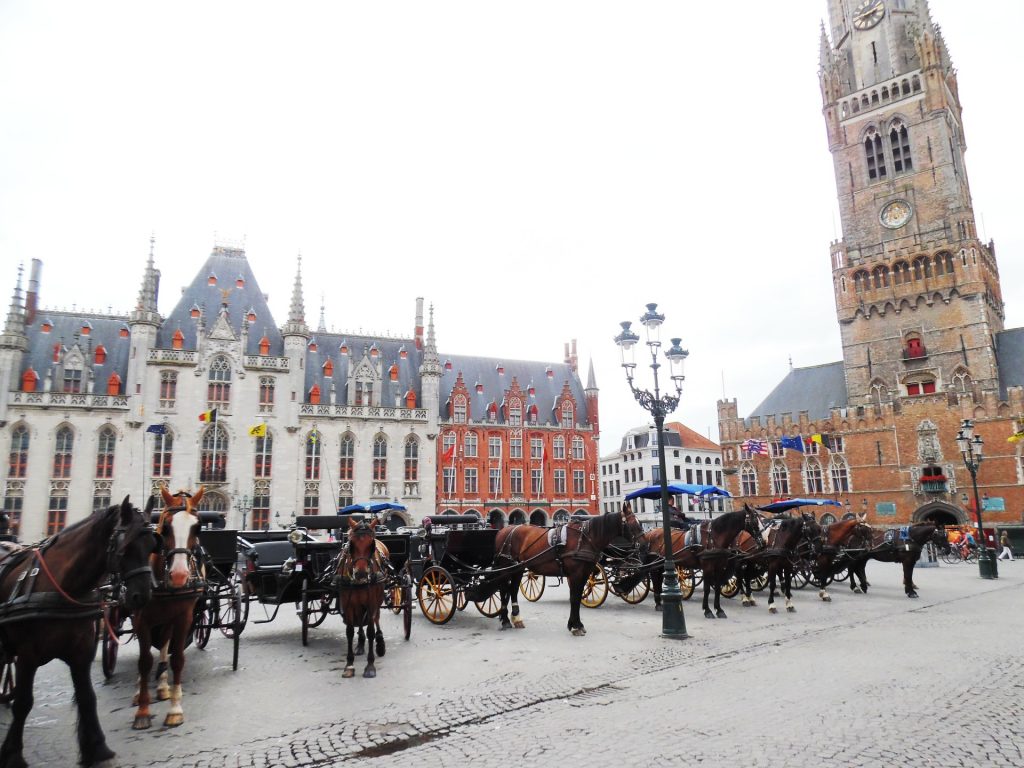
Tip: Slow and steady wins the race when you’re driving a motorhome through Europe, especially if it’s a larger one. Keeping a steady speed on the autobahns can be more economical on your fuel tank and therefore should save you some money!
Afternoon itinerary for Day 8
Park up at Parking Kanaaleiland – a designated parking area in Bruges for motorhomes, with electric hook up. Parking Kanaaleiland is a stone’s throw from Bruges, so it’s only a short walk before you can spend some time uncovering the magic of the city. Grab a map from one of the tourist information centres and spend this afternoon wandering the many canals, lakes and squares of the city. Enjoy a Belgian waffle before heading back to your campervan for the evening, when you can figure out the things you want to see in Bruges tomorrow!

Day 9 of Europe road trip from UK
Spend the whole day in bruges, useful information for day 9.
Total distance: N/A – spend today in Bruges Overnight stop : Parking Kanaaleiland, Bruges (the same as overnight on Day 8)
Itinerary for Day 9
As Bruges is such a stunning place and a fairly large city, Day 9 of this 10 day road trip through Europe from the UK is designated to spending the whole day there. If you need to shorten this itinerary to a 9 day one, you could cut this day and head back to Calais for your ferry this morning. But I would strongly recommend you allocate yourself one whole day to explore the city, and stay overnight again at Parking Kanaaleiland. After all, Bruges makes for one of the best city breaks in Europe in it’s own right! Here are some suggestions for things to do in Bruges on Day 9:
- Unleash the bicycles from the back of the van and head off across the cobbles, exploring both the inner and outer canals
- Take a boat ride around the canals
- Visit a museum or a chocolate shop
- Find one of the windmills of Bruges
- Stroll Minnewater Lake
- Explore the historic centre of Bruges and lose yourself in the many narrow lanes that join onto the main streets
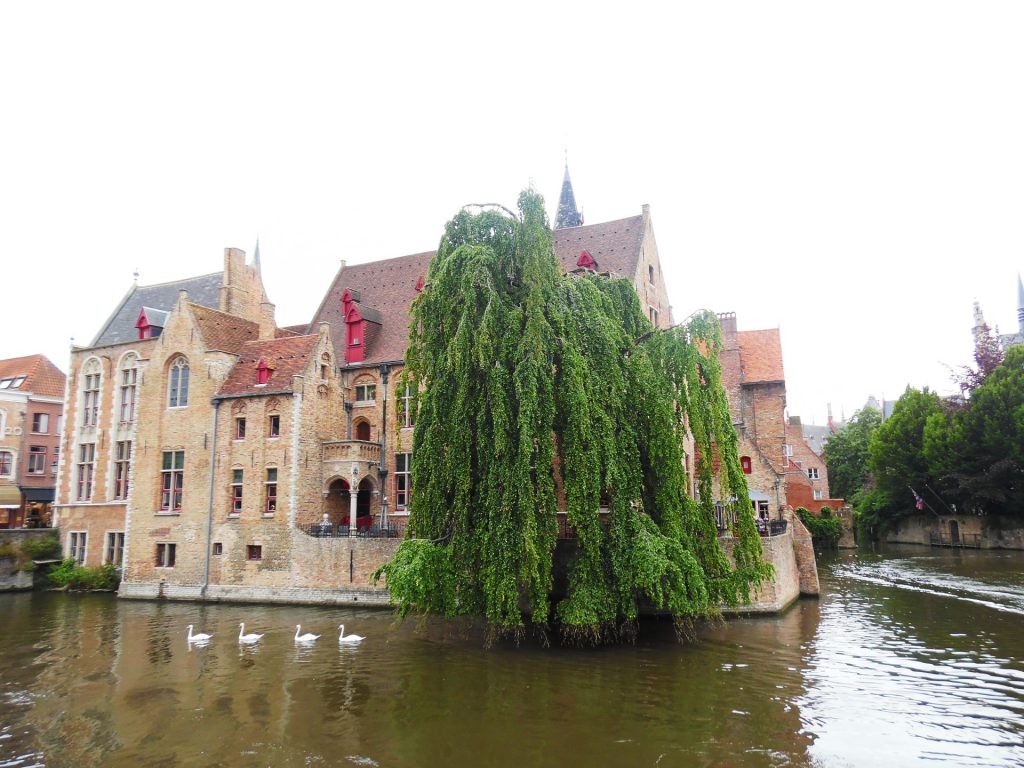
Tip: Make sure you have a bicycle lock with you. There are an abundance of places you can lock your bike up in Bruges, if you wish to stop and take a wander.
Day 10 of Europe road trip from UK
Drive from bruges to the port of calais, france, for return ferry to dover, uk, useful information for day 10.
Total distance : ~113 km (~70 miles) Overnight stop : N/A – you have reached the end of your 10 day Europe road trip from the UK
Itinerary for Day 10
You have reached Day 10 of your 10 day motorhome itinerary for Europe and it’s time to return back to the UK. As with your outbound trip, it’s usually cheaper to get an early morning ferry from Calais to Dover. Bruges is very accessible to Calais, making it a good place to stay the night before your return journey home. You can stay in Calais overnight on Day 9 if you wish to be even closer to the Port of Calais. This is down to your personal preference, and Bruges makes for a lovely place to end your trip!
Tip: If you decide to follow this road trip itinerary for Europe and stay overnight in Bruges on Day 9, make sure you give yourself ample time to get to Calais for your return ferry home the next morning. The journey time usually takes less than 2 hours if traffic is light!
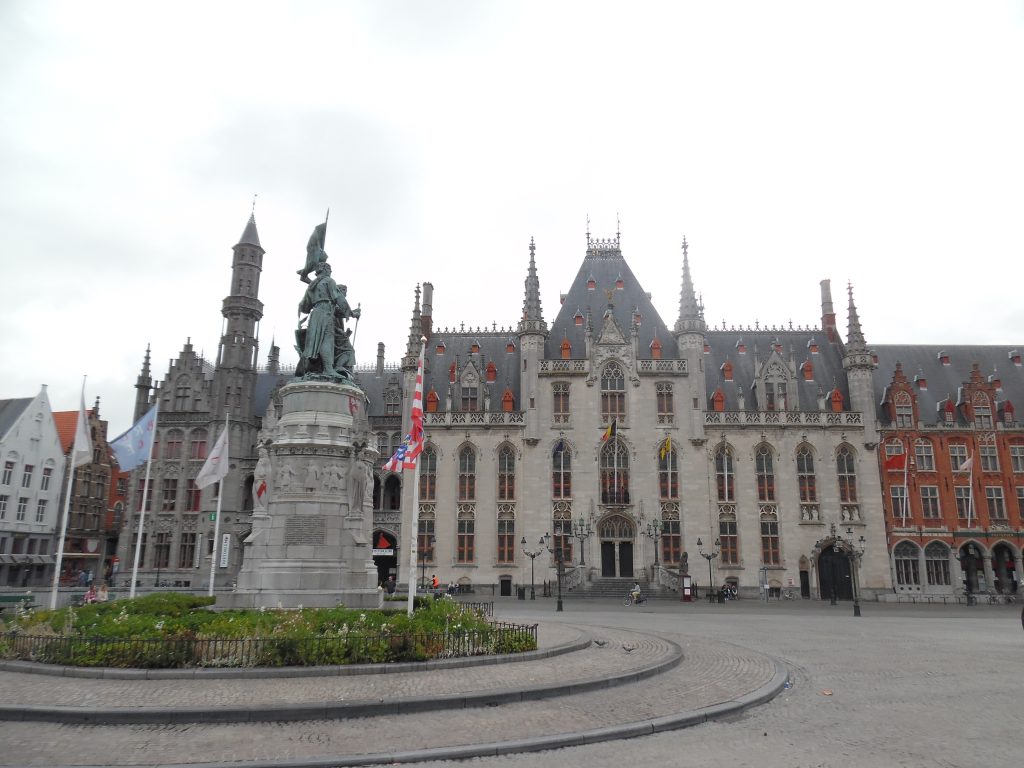
Europe road trip itinerary summary
There are many great campervan routes around Europe you can take, but this one is perfect if you are departing from the UK and only have 10 days to spare. You will visit some enchanting towns and cities, in all of their half-timbered glory (you might have guessed by now that this is a key component of any quintessential German town)! The continent is really well equipped for the road trip lifestyle, and it’s great transport links make it a fantastic destination for a Europe road trip from the UK!
Pssst… sharing’s caring! Pin this post using one of the images below, so you can find it easily later!
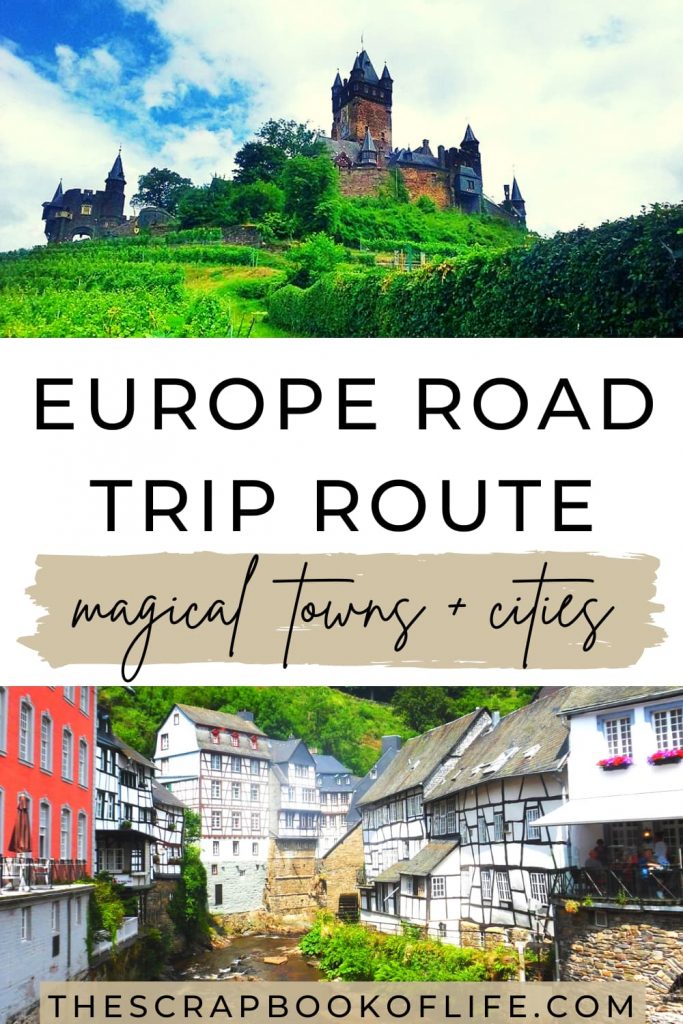
The Scrapbook Of Life
Posts by The Scrapbook Of Life
You Might Also Like

12 Absolute Best Things To Do In Tirana, Albania
![campervan tour europe route 5 Days In Slovenia Itinerary [No Car] – Magical Lake Bled & Ljubljana!](https://thescrapbookoflife.com/wp-content/uploads/2023/08/Lake-Bled-1-560x747.jpg)
5 Days In Slovenia Itinerary [No Car] – Magical Lake Bled & Ljubljana!
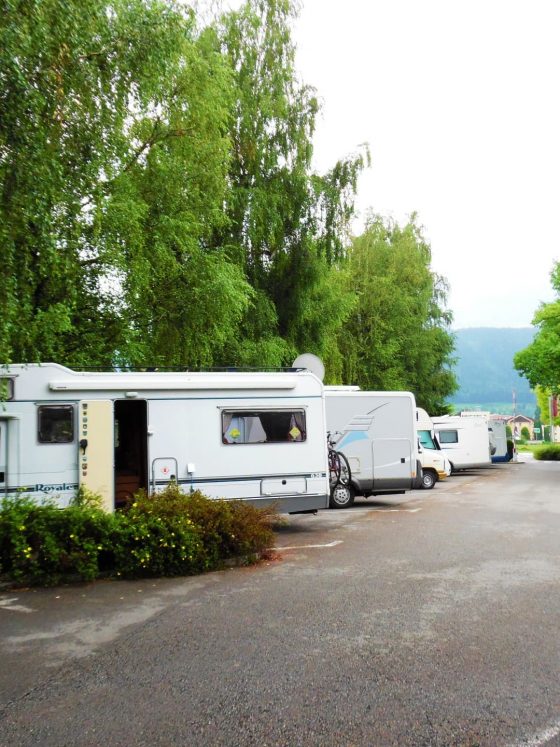
Europe In A Campervan – 11 Things You Must Know Before Your First Trip

Ljubljana Airport To Lake Bled By Bus – Easy Guide With Photos
![campervan tour europe route 3 Days In Krakow – Very Best Krakow Itinerary [Eat, See & Do] + Exact Cost!](https://thescrapbookoflife.com/wp-content/uploads/2022/11/IMG_4112-560x747.jpg)
3 Days In Krakow – Very Best Krakow Itinerary [Eat, See & Do] + Exact Cost!

Krakow Airport To Old Town By Train – Simple Step By Step Guide & FAQs
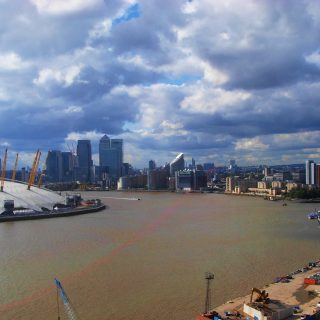
3 Days In London – An Itinerary For The Perfect Weekend Break + FAQs
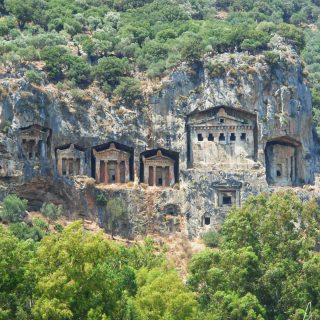
17 Unique Places To Visit In Europe You Must See!
We use cookies to ensure you get the best experience on our website.
5 Routes for Taking Your Campervan Around Europe

1. La Route des Grande Alpes
This route, officially known as D902, is definitely a must-visit! Stretching from Lake Geneva to the Mediterranean Sea, this road trip would grant you the chance to compare and contrast lifestyles in the mountains and the Mediterranean. This route is one you cannot miss if you’re taking an RV around Europe. The best part? The route has several mountain passes, and sections of the road have been used in the Tour de France. These spectacular views don’t have to be viewed from behind the windows of your car- you can ride a bike along these beautiful paths and get lost in the beauty of mountainous nature.
Distance: 617 km
Start: Thonon-les-Bains
End: Menton
Day 1: Start in Thonon-les-Bains, and drive to Annecy through Morzine. Although Annecy isn’t along La Route de Grande Alpes, it’s fairy-tale-like aesthetic is something that cannot be missed.
Driving time: 41 minutes
Day 2: Head from Annecy to Bourg Saint Maurice, a small town nestled in the heart of the French Alps. Although notorious for skiing in the winter, this quaint town offers numerous outdoor summer activities, such as watersports. It is also a popular destination for hiking and biking.
Driving time: 1 hour 32 minutes
Day 3: From Bourg Saint Maurice, drive down to Lanslebourg. Here, you can take a hike along Mont Cenis, where you can follow a pass that leads you to Italy! This pass was built by Napoleon in the early 19th century, so be sure to appreciate the history of the path as you enjoy the scenic views!
Driving time: 2 hours 25 minutes
Day 4: Leave Lanslebourg and drive down to Briançon, the highest city in France at an altitude of 1,326 meters! This commune is rich with history, and boasts of 18th-century structures and UNESCO world heritage sites around the city, something you should not miss!
Driving time: 1 hour 30 minutes
Day 5: Head to Barcelonnette from Briançon. Although small, Barcelonnette is a town present for centuries, dating back to the Roman Empire, so be sure to ask locals about the history of the town! Barcelonnette also lies on the Ubaye Valley, making it an area rich with plants and animal species.
Driving time: 1 hour 37 minutes
Day 6: Arrive at Valberg, a small resort village. Although the village is rather small, there is much to see and do within the area. If you’re in the mood to continue to explore nature and hike through breathtaking trails, pay a visit to Mercantour National Park. For those of you that wish to explore historical sites, Entrvaux is a medieval village that’s an 11-minute drive away. You’ll get to see some remaining structures and appreciate the historical architecture.
Driving time: 1 hour 46 minutes
Day 7: Drive down to Saint-Martin-Vésubie from Valberg. This small commune is a hotspot for nature lovers, hosting a range of parks. If you wish to learn more about the native wolves that roam around the surrounding forest, Parc Alpha is the perfect place to expand your knowledge about them. Ski resorts are a short 10-minute drive away from this small town, providing you with the chance to engage in numerous outdoor summer activities, such as ziplining.
Driving time: 1 hour 25 minutes
Day 8: End your road trip in Menton, a town known for its beautiful beaches and gardens with rare plants. Here, you can appreciate the Mediterranean culture France offers, and enjoy the stunning architecture the city has to have, whether it may be the pastel-coloured houses or the 17th-century church.
Driving time: 1 hour 55 minutes
- Roads in France are often subjected to tolls, so be sure to read about French motorway tolls and keep some change with you at all times!
- The roads are often closed during winter, meaning they only open from June-October, after all the snow has melted completely. However, roads may close earlier if snowfall comes earlier than expected.
- Although you may be travelling during the summer, it can get chilly in the mountains so be sure to pack an extra sweater!
2. Road trip along the coast of Portugal:
If you’ve ever wished to drive along the Atlantic coast and have the chance to visit a beach whenever you please, then this is the route for you! Portugal is home to some of the most beautiful beaches in the world, providing visitors with views they will not see anywhere else. This scenic drive along the Atlantic coast is arguably one of the most scenic motorhome routes in Europe. Aside from the fantastic nature, Portugal offers a unique culture influenced by empires that previously occupied the land. So pack your bags and get ready to explore Portugal’s wonders and eat (lots of) pastel de nata!
Distance: 818 km (roughly)
Start: Viana do Castelo
End: Tavira
Day 1: Start in Viana do Castelo, and drive down to Porto. This coastal city is known for its production of port wine, so be sure to try some while you stop by! The city is rich with iconic sites, including palaces, churches, and aesthetic streets. Be sure to stop by Praia do Senhor da Pedra, a beautiful beach known for its small chapel built on a rock outcrop!
Driving time: 1 hour 10 minutes
Day 2: Leave Porto and drive down to Leiria, a city that is rich in history. Stroll through the Leiria Castle, which had 3 distinct building phases, and as a result, boasts of architecture from different time periods! Batalha Monastery is also a UNESCO World Heritage Site, so be sure to stop by for a visit. Once again, sandy beaches are just a short scenic drive away from the city.
Driving time: 1 hour 48 minutes
Day 3: Drive your motorhome to the iconic Lisbon, home to pastel-coloured buildings and historic monuments. There’s so much to see and do in Lisbon, so you can always walk to iconic sites and explore the cobbled streets on your way there. Stunning coastal views can be found along the city, so be sure to grab some warm pastel de nata from a local bakery and sit down to enjoy the views!
Driving time: 1 hour 35 minutes
Day 4: Head down to Lagos. Because this is a longer drive, it would be recommended that you stop by Parque Natural do Sudoeste Alentejano e Costa Vicentina on your way to admire the nature Portugal has to offer. Soon after, you’ll arrive at Lagos, a town known for its Atlantic beaches and historic watchtowers. Be sure to enjoy the beaches around the area and soak up the rays of sun!
Driving time: 2 hours 50 minutes
Day 5: Drive east towards Tavira, a small on the Algarve coast. Aside from its famous beaches, Tavira is also home to many historic sites. Not unlike other parts of Portugal, it is home to churches, watchtowers and castles dating back as early as the 12th century. Be sure not to miss out on seafood and local meals while you’re there!
Driving time: 1 hour 10 minutes
- Portugal is relatively warm, with its average low temperatures reaching 15°C in January-March. This means you can take a road trip anytime throughout the year, and avoid the peak seasons in summer
- Sometimes having a motor vehicle isn’t necessary. Since public transportation is cheap, you can always leave your motorhome parked at a campsite and take a bus or train to the city centre!
3. Road trip across Netherlands and Belgium:
The best part about taking your campervan around Europe is travelling between countries with ease. In fact, travelling across countries makes you truly appreciate the uniqueness of each country’s culture, because although countries may be located similarly geographically, their lifestyles may vary drastically. The Netherlands and Belgium are prime examples of that. Both countries lie next to each other, and Flemish and Dutch are more similar than you would expect. However, you’ll encounter completely different experiences when visiting either country. And what better way to experience this than by taking this stunning motorhome route in Europe?
Distance: 331 km
Start: Amsterdam
End: Bruges
Day 1: Kick off your road trip by driving from Amsterdam to the Hague. Aside from being the political heart of the country, The Hague boasts of historic monuments and art museums. If you haven’t visited enough museums in Amsterdam, then be sure to visit those offered in The Hague! Should the weather permit, be sure to tour the canals of the city by boat! You can also pay a visit to Scheveningen Beach if you’re hoping to spend some time by the water and get a tan!
Driving time: 45 minutes
Day 2: Cross over to Belgium and stop by Brussels, the capital of Belgium, and another politically influential city. If you grew up reading the classic Asterix and Obelix, then don’t forget to visit the museum dedicated to the iconic comic series! The Grand Palace is yet another iconic monument you should not miss. Be sure to have a picnic at one of Brussels’ many parks and gardens!
Driving time: 1 hour 54 minutes
Day 3: Step away from the big city life and drive to the quaint city of Bruges. Here, you’ll find medieval buildings dotting the cobbled streets. This UNESCO World Heritage City has captured the heart of all its visitors with its historic charm. That being said, walking around the streets and appreciating the monuments you stumble upon is a great way to explore the city.
Driving time: 1 hour 17 minutes
- Amsterdam, The Hague, and Brussels are rather large cities. If you really hope to explore as much of each city as possible, extend your stay at each stop!
- Although it sounds too good to be true, there are campsites close to the city centre in most of the cities. However they are not the largest and may be booked out quickly, so be sure to make reservations well in advance.
- Do keep in mind that the streets (especially in the Netherlands) may be difficult to navigate with a larger vehicle, so it may be best to look for a campsite on the outskirts of the city and take a bus to the city centre.
4. Atlantic Roadway, Norway:
Although this road is only 8.3km long, it has been labelled as the world’s most beautiful drive. Known for its winding paths and scenic views, driving along this road is something you must check off your bucket list. However, because it’s only a short drive, you can always take your out for a few extra kilometres in Norway to truly enjoy the natural wonders Norway has to offer along one of the most underrated motorhome routes in Europe.
Distance: 305 km
Start: Åndalsnes
End: Oppdal
Day 1: Start in Åndalsnes, and drive down to Molde. This lakefront town has a lot to offer for visitors. At Varden- the Molde Panorama, you’ll have the opportunity to marvel at the sight of 222 mountain peaks. If you’re interested in visiting museums and experiencing the history of the town, be sure to visit the museums in the area!
Driving time: 1 hour 29 minutes
Day 2: Leave Molde and start driving along the Atlantic Road, where you’ll arrive in Kristiansund. There are designated places along the Atlantic Road where you can park your motorhome and take a moment to hike along designated paths and become one with the nature around you.
Day 3: Keep following Norweigan National Road 70 and head to Ålvundfjord. Along the way, you can admire the scenic views of the Norweigan Sea and elevated lands. If you’re in the mood to go for a pleasant hike, be sure to stop by Herresdalen for guided paths. Visit the old Tingvoll church on your way, which boasts of a beautiful interior.
Driving time: 1 hour 20 minutes
Day 4: Head down to Oppdal, a scenic mountain village rich with nature. Although the town is notorious for being a skiing destination, there is still much to be done during the summer. There is no shortage of hiking paths in the area. In fact, there are designated paths for hiking for those of you with children! If you want to admire nature without walking long distances, you can go on a safari and spot some native oxen or reindeer herds. Needless to say, there is no shortage of outdoor activities in this village.
Driving time: 1 hour 16 minutes
- Designate an extra day in case you encounter bad weather, even during the summer.
- Keep in mind that roads may be closed during the winter, from September until June.

5. Road trip across Germany on the autobahn:
Germany is a country rich with history and culture dating back thousands of years. If you’re taking an RV around Europe, make sure you don’t skip over this stunning country. Germany is famous for its autobahn, and what better route to follow? Contrary to popular belief, the autobahn is safer than you’d think- it’s even safer than freeways in the US! Police also have little tolerance for reckless drivers along the road, and are sure to make the roads safe for everyone. This means that you can travel along German safely at your own pace.
Distance: 936 km
Start: Cologne
End: Berlin
Day 1: Start your trip in Cologne and drive down to Düsseldorf, a city known for its art scene. The city is dotted with art museums, so be sure to pay a visit to a couple of them! If you’re in the mood for a beer or a cup of coffee, then be sure to visit Burgplatz.
Driving time: 43 minutes
Day 2: Leave Düsseldorf and head to Münster, a city famous for its 13th-century cathedral. Prinzipalmarkt is the historic marketplace of Münster shaped by historic buildings. Even if you aren’t a fan of shopping, it’s definitely worth a visit. If you’re interested in the Renaissance period, pass by the historic Burg Hülshoff, a castle that’s just 10 kilometres out of the city.
Driving time: 2 hours 5 minutes
Day 3: Head out to Bremen, the city that built Germany’s first coffee house in the 17th century. That being said, it’s only fair that you enjoy a cup of coffee at the Marktplatz, the central market square, where several monuments have been erected, one of which has been labelled as a UNESCO World Heritage Site under the same listing as the town hall.
Driving time: 2 hours 8 minutes
Day 4: Travel to Hamburg, a city crossed with hundreds of canals. The historic monument that dot the city are something you cannot miss, so feel free to wander along the streets and explore what the city has to offer. But be sure to pay a visit to Planten un Blomen, arguably one of Europe’s finest urban parks, which has a Botanical Garden from 1821 nestled at its centre.
Driving time: 1 hour 22 minutes
Day 5: After leaving Hamburg, start driving towards Rostock, a city situated around the Warnow River. During warmer seasons, be sure to stop by Warnemünde Beach and enjoy the sun! If you’re hoping to see some historic sites, then you’ve come to the right place! The defensive city walls were first built in the 1100s, and more than a kilometre of the wall remains intact. There are also historic cathedrals that dot the city, in addition to many museums that discuss the history of the area.
Day 6: Drive to Potsdam, a World Heritage city rich with palaces and royal parks dating back to the Prussian Kingdom. Sanssouci Palace is arguably one of the most iconic sites in the city, boasting beautiful architecture. In an unusual twist of events, you can view Dutch architecture in the Dutch quarter of the city, built in the mid-18th century.
Driving time: 2 hours 18 minutes
Day 7: Berlin, the capital of Germany, lies just a short drive away from Potsdam. Not unlike the rest of Germany, Berlin is rich in history. Be sure to pass by the Berlin wall memorial, and the German historical museum to better understand the stories of Germany’s past. The bathing lakes also provide visitors with a chance to step away from the bustle of city life and enjoy the sound of lapping waves.
Driving time: 44 minutes
- If you visit Germany in December, be sure to visit the Christmas markets each city has to offer!
- Traffic can build up on the autobahn at times, so be sure to head out early to avoid getting stuck on the road.

What are you waiting for? Pack your bags and hit the road for the trip of a lifetime. Europe is a continent consisting of established countries that have played important roles in the history of the globe, so don’t miss out on the chance to visit such places! Driving with a motorhome is the cherry on top of your road trip, so be sure to check out Goboony for campervan hire in Europe . In just a few clicks, you’ll be ready to go on a road trip of a lifetime!
Download the free e-book
All of these routes are covered in more detail in our free e-book, 5 Routes for Taking Your Campervan Around Europe , including a unique bonus route! Download this free e-book to discover our day-by-day itineraries and campsite recommendations.
Get this e-book

Campervans Available to Go Abroad

Rafaella Karadsheh
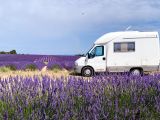
- Discover new destinations
- Learn about motorhome travel
- Receive exclusive discounts
Goboony uses cookies and similar technologies to provide our service to you. They also help make our communication to you easier and more personalised. With these cookies Goboony (and third parties), can track your internet behavior inside and outside Goboony. Some are necessary to help our website work properly and can't be switched off, and some are optional but support Goboony and your experience in other ways. Using cookies, we (and third parties) adapt our website, advertisements and communication to better suit your interests. You can accept the cookies by clicking on the button below. If you cookie-modal#acceptNecessaryCookies">refuse them we will only use functional and analytical cookies. Read our cookie policy .
- Sign up\Login

6x the most beautiful motorhome routes of Europe
Looking for inspiration for your next motorhome-trip? Take a look at one of these popular motorhome routes in Europe! From a motorhome-trip filled with castles and idyllic landscapes to the highlights of the French coastline, there's something for everyone. These are the six most beautiful motorhome routes in Europe!
The Romantic Road
Fan of castles, romantic landscapes and medieval towns? Then the Romantic Road is the perfect motorhome route for you! In 460 kilometers, you drive from Würzburg to Füssen. To admire everything, a duration of about 14 days is recommended, but of course you can take as long as you want. Along the way you will admire the medieval village of Rottenburg ob der Tauber. Time has stood still here, because cheerfully colored half-timbered houses are everywhere! Augsburg is also a must, it seems as if you've landed in Italy! You can admire the beautiful architecture from the Renaissance. The motorhome route through Germany is rounded off with a visit to the country's most famous castles: Neuschwanstein Castle and Hohe Sloss.
Here you will find a complete free itinerary of the Romantic Road .

- During the Romantic Road you come across beautiful castles!
North Coast 500
The North Coast 500 is the ideal motorhome route for those who want to discover the most beautiful spots of the Scottish countryside. And not only that, along the way you will also pass the most beautiful Scottish castles and various breweries where you can enjoy a local whiskey. The motorhome route is about 830 kilometers long - converted to just over 500 miles. A duration of 5 to 7 days is long enough to discover the most beautiful places along the route with the motorhome, but those who want to enjoy the beautiful landscapes for longer, can of course take longer. You start and end the route in Inverness, the 'capital of the Scottish Highlands'. Along the way you pass, among others, the hiking paradise Durness and the northernmost point of Britain: John o'Groats.
View the complete motorhome route here .

- In Scotland, you're bound to encounter a Scottish Highlander during your motorhome tour!
The best of Spain
Spain has so many beautiful locations, it's hard to choose which to visit during your motorhome journey! So why not visit all the highlights? This motorhome route will take you past all the country's beautiful spots: from the metropolis of Barcelona to the romantic city of Seville and the northern city of Santander. You literally cross the whole country! It is therefore recommended to take at least seven weeks to complete this itinerary. It is of course also possible to divide the route into two parts. One thing is certain: after driving this route by motorhome, you won't have missed a single highlight in Spain!

- Spain is full of beautiful sights, like the Plaza de España in Seville!
Margrietroute
The Margrietroute takes you along the most beautiful of Denmark. The route was named after Queen Margrethe II of Denmark's favorite flower, the daisy. The route is therefore clearly marked with the flower. The route is 3700 kilometers long in total. There is no fixed starting and finishing point. Very convenient, because if you come from Sweden with the motorhome, for example, you can jump in at Copenhagen! Copenhagen is one of the many highlights on the motorhome route. Here you can admire, among other things, the Little Mermaid, a statue as a tribute to fairy tale writer Hans Christian Andersen. And of course Legoland, Denmark's number one theme park, is not to be missed. Or visit historic Ribe, the oldest town in Denmark. Here you can read all about the most beautiful locations along the motorhome route.

- In Denmark you can admire the harbor in the capital Copenhagen during your motorhome tour.
The Grand Tour
If you want to enjoy the most beautiful Swiss landscapes, you can do so on the Swiss Grand Tour. The route is divided into 9 stages which in total make up a route of 1643 kilometers. You drive the route therefore in at least 9 days. Along the route you will find several (unexpected) highlights, including the wine region Lavaux. This is the largest wine region in Switzerland. 99% of the wines are destined for the interior and only 1% go abroad. So it is advisable to take a nice bottle of wine home with you! In addition, the sky-blue Lake Brienzer and the medieval city of Fribourg are a must to visit during the motorhome route.
Read all about the best stops along the motorhome route here . Would you rather go for a short motorhome route that can be driven in a couple of days or even a day? Then check out these five short motorhome routes : from the Grossglockner Hochalpenstrasse in Austria to the Trollstigen in Norway.

- The Grand Tour takes you past the most beautiful locations in Switzerland.
Normandy and Brittany
Normandy and Brittany are among the most beautiful regions of France. No wonder these regions are popular with motorhome owners! In Normandy you will find, among other things, the impressive gardens of the famous painter Monet. The house is also very colorful. No wonder his paintings are so colorful! On the way you will also pass by the Venice of Normandy, namely Pont-Audemer. Because of the many canals and half-timbered houses, you imagine yourself here for a moment in Italian spheres. If you travel on to Brittany, you will come across the impressive coastline of the Côte de Granit Rose. Rennes is also recommended, this is the bustling capital of Brittany. Here you will find a complete, free motorhome route through these beautiful regions, including motorhome stopovers!

- In Normandy and Brittany you will find several idyllic locations.
Would you like to visit an island with your motorhome during your visit to France? That's certainly possible! These 6 European islands can be visited by motorhome, including the French Île d'Oléron.

Related Products

Camperstop Europe - Motorhome guide
(Detailed) information about hundreds of motorhome stopovers throughout Europe, including travel & routing tips!
Related Articles

4x national parks in northern Spain!

Travelling to Alto Douro by motorhome!

6x staying the night on the Danish coast!

Where to go with your motorhome in August?

Back to the Middle Ages in Graz!
As a registered user you can make use of all the functionalities of Camperstop.com. Create an account or log in.
Guided RV tours through Europe and the British Isles

A Unique Switzerland Campervan and Road Trip Itinerary

I may earn income from affiliate links or partnerships in this post. I spend time to curate tours or products that align with my values. Thanks for supporting my work, at no additional cost to you.
Last updated on January 31st, 2023 at 02:00 pm

A re you curious about the best way to see Switzerland? Well, then, this road trip campervan itinerary is just for you! Ganesh and I took a lovely trip through Switzerland this spring with our trusty campervan. Living in Munich, I’ve visited Switzerland several times, but slower traveling with a campervan was ideal for seeing this picturesque country. Switzerland has some great campsites ranging from well-maintained holiday parks to more rustic farms, which are perfect for a campervan, tent, or those renting a cabin. We loved our campervan road trip itinerary, which allowed us to experience some of the highlights of Switzerland but also got us off the beaten path for unique experiences.
Switzerland is a gorgeous country that gives you a sample of the very best of Europe. With 4 national languages, including French, German, Italian, and Romansh, each region has a distinct flair. When you’re in the French-speaking cantons, you’ll find rustic chateaus and rolling vineyards. In the German region, you’ll find delicious cheese and towering mountains, and in the Italian-speaking region, there’s great food, and locals extend their hospitality. The diverse landscape, language, culture, and cuisine packed into a safe and easy-to-drive country make Switzerland the perfect destination for a European campervan road trip.

This campervan road trip itinerary for Switzerland is fully customizable, so whether you have 7 days or 14 days, you can pick and choose the best stops and campervan campsites that work with your schedule. Before you follow my itinerary, make sure you head over and save/read my post about the best driving and camping tips for a Switzerland road trip with a campervan, which includes essential planning tips, what to expect at campsites, and recommendations for where to rent a camper. For this itinerary, you can rent a camper from IndieCampers which is located in Zürich. For a more budget-friendly option, you can also rent RoadSurfer from Munich or Freiburg and enter Switzerland near Zürich or Basel. We are based in Munich and drive a RoadSurfer.

WHAT WE’RE COVERING
Stop 1: Zürich
Stop 2: Bio Farm in Neuchâtel
Stop 3: La Fouly Glacier Camping
Stop 4: Interlaken Lake Camping
Stop 5: Lauterbrunnen Waterfall Camping
Stop 5: UNESCO Biosphere Camping
Discuss and Share
- Unique road trip itinerary for exploring Switzerland by campervan
- Discover hidden gems and still see the highlights
- Focus on nature-based and agricultural camping
- The perfect way to see a new side of Switzerland
Stop 1: Zürich – 1-2 Nights
If you’re renting based on my campervan tips post, you have a variety of entry options. If you’re coming from Munich as we did, Zürich is a great first stop. Zürich has a special place in my heart. It was the first place in Switzerland I ever visited while backpacking Europe in 2010. While I’ve come a long way from only being able to afford to stay in a spaghetti factory on my budget (that’s a story for another time), Zürich remains one of Europe’s most impressive urban sustainability hubs. As a modern European city with an upscale hipster vibe, my favorite thing to do when visiting the city is exploring the more grungy and artistic side, which is often overlooked.

Where to Stay in Zürich
Fischers Fritz is the closest and most popular campsite for the Zürich area. However, it can get very crowded, especially during peak season. So, I would suggest parking near Zürich to see the city for the day and then heading to Camping Sihlwald to access a beautiful nature reserve. You could also choose Camping Strandbad Turlersee , which is right on a lake with access to walking trails, lake swimming, and nature.

Of course, you can also choose to stay at a hotel in the city and park the van with them if you want to enjoy the most of your urban setting. I always stay in a recommend 25 Hours Hotel which oozes unique Zürich charm. In fact, with these campsites away from the city, you could easily spend 2 days in the area – one exploring the nature reserves near your campsite and the other seeing Zürich.
Things to do in Zürich
Alternative Tour of Zürich – In Zürich, I always recommend the alternative side of things. I suggest you visit the industrial district, the viaduct, and Rote Fabrik, which houses locally-owned boutique stores, art galleries, bars, and restaurants. Of course, the Alt Stadt can’t be missed for its authentic European charm. If you’re camping at Frischers Fitz, you can even walk along the lake into the city, stopping at some of the sights along the way.

Embrace Sustainability & Nature – Zürich is one of Europe’s sustainability hubs. A few zero waste shopping centers are a great option for filling up your campervan with packaging-free products. This helps reduce your waste while on the road and honestly makes cooking so much easier. Sihlwald Nature Reserve has some easy hikes, and Thurlersee has a fantastic walking trail that circumnavigates the entire nearby lake.
Driving: Zürich -> Lac de Neuchâtel
The drive from Zürich to my recommended campsite in Neuchâtel is pretty short, which means there is plenty of time to explore some of the surrounding nature during your drive. I do recommend leaving the Zürich area early to get a spot at the campground I recommend for Neuchâtel. If you want another city break, you can hop over to Bern, but there are three impressive nature parks on your way, and I would suggest getting out and stretching your legs in one of them.
The largest of the three, Doubs Natural Park is a great place for hiking, biking, and cultural immersion. The park is known for its impressive sustainability practices balancing traditional lifestyle with conservation. The park is home to impressive biodiversity, including the endangered checkerboard flower (Fritillaria meleagris ). There are two hikes in the region and sections of a long-distance bike trail. It is recommended you stop at the visitor center for maps of the two hikes.

If you want more of a challenging hike or opportunities for wildlife viewing, then visit Thal Nature Park . Finally, in Jurapark Aargau, you’ll find some great themed walking trails for opportunities to learn about rural agriculture, biodiversity, and sustainable development in the region. You can even plan a route and drive through all three!
Stop 2: Bio Farm in Neuchâtel – 2 Nights
When we first entered the Neuchâtel region, I stuck my head out the window like a dog, gaping at the beautiful rolling vineyards. Each vineyard had an impressive château with a stunning lake view. If you are a big fan of wine, this is the place for you! After we checked into our bio farm accommodation and got the campervan set up, we offloaded the bikes and took off on a bike tour through the vineyards. There are plenty of spots to taste wine and many mountain ruins to visit along the bike trails if you don’t have a bike or don’t like wine, no worries.
On our second day, we also took time to stroll through some nature trails and poked our heads into small towns filled with museums, cobblestone streets, and boutique shops. We spent two nights here fitting in everything we wanted to do but also scratched the surface. You could easily spend three nights at a more relaxed pace and have the opportunity to see more castles and museums and enjoy long hikes. If we were to stay longer, we would have left the bio farm and checked into a campsite along the lake for a change of scenery. You get a taste of the very best of Switzerland in this hidden gem of a region. Whether you prefer to spend the day indulging in a wine tasting in a French-style wine cellar, cooling off by the lake, or have an action-packed day with hiking and biking, there is something for everyone.

Where to Camp in Neuchâtel
The Coue: One of the reasons we choose this region is because of a specific camping spot. The Coue is a family-owned bio-farm near the sleepy town of Travers. This exclusive and off-the-beaten-path spot was a highlight of our Swiss campervan road trip. They don’t take reservations, so I recommend adjusting your itinerary to visit on weekdays or arrive just after check-in (around 2:30 pm). As soon as they open their gates, you can drive in and see if they have space for your campervan. Those on a road trip without their campervan can book one of the eco-pods or treehouse accommodations, which must be booked ahead of time on AirBnB.

We loved relaxing on the farm, watching the chickens, goats, sheep, horses, rabbits, and baby cows frolicking – they legit had baby cows frolicking through the campsite. There is a small shop with local beer, cheers, wine, farm-fresh eggs, and daily bio-baguettes. You can even order some pizza and have a sit-down dinner if you need a break from camp food. The bathrooms and showers were comfortable and clean. While this campground is marketed as a great place for kids, with a play barn and farm animals, we enjoyed our time as an adult couple. The farm is located on one of the main bicycle routes, and you can easily walk to Travers, a quaint town.

The owners both spoke French. Whether they spoke much German (our second language) or English wasn’t apparent. Ganesh got by with his basic French, and they never offered to switch to another language. If The Coue is full, you can try Hotel Camping Sutz, TCS Camping Gampelen Neuenburgersee, or any of the dozens of sites available in Neuchâtel.
Things to do in Neuchâtel
Wine Tasting: As you drive along Lake Neuchatel and Lake Bieler, you’ll be tempted to stop at every vineyard you see. We visited Château d’Auvernier, which was an excellent decision. This gorgeous winery offers a fantasy wine tasting, exploring their wines from traditional Chardonnay to premium Pinot Noir. You can even tour the wine cellar or take a moment to enjoy the sweeping views.

Explore Auvernier : After (or before) your wine tasting, I recommend just wandering the charming cobblestone streets of Auvernier. This small village has cute local shops and restaurants, medieval structures, and colorful doors framed with wisteria.

Bike Tour : If you’re like us and brought your bikes, I recommend doing a bike tour in the region. From the Eco farm campsite, you can quickly access a trail that runs from Travers to Les Verrières, a hilly but relatively easy ride exploring smaller towns and farmland and runs along a scenic river. There are chances to get off and do small nature walks to add some steps to your day. You can also do the wine road, which runs along the lake and take you from the winery to the winery for a day of biking and wine tasting.

Museums and Castles: If you prefer a little more hustle and bustle, you can head into the main capital to see the impressive Neuchâtel Castle. You can book an afternoon tour of the castle for about 5 CHF. There are also dozens of castles in the region, so if you are castle obsessed, this is the place to go bananas. Before or after your castle visit, explore the capital city. There are about 25 museums and dozens of castles in theCanton, so this is an excellent place for history buffs.

Driving: Lac de Neuchatel -> La Fouly
The next stop after Neuchatel is La Fouly, a mountain town surrounded by glaciers. Of course, we took our time getting there because there is plenty to see along the way. The beauty of a Swiss road trip with your campervan is stopping wherever your heart desires, so feel free to stop as you please or follow along with our recommended stops.
Montreux is a great option to stop for lunch. We’ve been eating most of our meals in our campervan, but we liked to stop for lunch at a restaurant on transit days. There are some great lakeside options along Lake Leman, like Le Fouquet’s or more casual eats. Don’t miss Château de Chillon , which is the castle that inspired Prince Eric’s castle in the Little Mermaid. If you prefer a quieter and more relaxed lunch stop, I can recommend La Terrasse du Port in the small harbor town of Port-Valais.

Pissevache is a stunning waterfall you’ll see on the side of the road. If you want to hop out and take a look, it’s a great place to stretch your legs.
Amphithéâtre Romain: We stumbled on this hidden gem of a Roman ruin and were so excited we did – as Ganesh loves ruins! There is free parking across from the ruin, and the ruin itself is free to explore. It’s not much, but it is a reminder of the expanse of the Roman empire. If you’re into St. Bernards and kitschy tourist stops, there is a St. Bernard museum at the same stop, which honors the legacy of St. Bernards in the region. We didn’t visit the museum as it was not our cup of tea, but it looked cute.

Enjoy the last stretch on your way to La Fouly. You’ll be heading up the mountain through winding roads and alpine farmland. Be prepared for narrow and winding roads, switchbacks, and the possible cow crossing, depending on the time of year.
Stop 3: La Fouly, Camping Among Glacier – 2 Nights
La Fouly is a mountain town that operates as a ski resort in the winter. This tiny yet charming village is an excellent hub for camping among glaciers and scenic hiking in the summer. Once again, we planned this stop around a campsite. I mean, who doesn’t want to camp among glaciers? We arrived later in the afternoon after spending the day sightseeing during our drive. We checked into our campground and found the perfect spot that suited our needs. Once settled in, we took off on a very short 1km educational trail walk before hunkering down at camp. Since it was rather chilly in spring at the high elevation, we cooked a hot meal, busted out the wine and whiskey, and allowed ourselves to take in the glacier views.
The next morning we woke up and headed out to hike, taking in the 360 mountain views. We packed lunch for the hike and took our time observing the flora. After another relaxing night, we got up early before packing up and hitting the road again. You probably don’t need more than two nights here, as the activities are limited and it is a very small area.

Where to Camp in La Foley
Camping Des Glaciers : The highlight of this stop is the campsite, where you camp among glaciers. You check in, order your morning baguette, and find an available pitch that suits you. We were traveling off-season, so we got an entire field to ourselves. You can choose a plot on a grassy field or rocky terrain underneath the glaciers. Each campground section has a bathroom, dishwashing station, and laundry sinks. Not every spot has power, so ensure your cord can reach the green power supplies. The bathrooms and showers are pretty good, but they aren’t close to some pitches. We made sure to stay near one as I frequently pee at night. Reception has great tourist and activity advice to help you plan your active outdoor holiday. There’s also a nice playground and cabins for rent.

Please offset your Switzerland campervan road trip itinerary through carbon offsetting with Swiss-based MyClimate or carbon-capturing with Tomorrow’s Air so we have glaciers to continue to camp underneath.
Things to do in La Fouly
Hiking, hiking, and more hiking: La Fouly is a hiking region, so you’re in the right place if you enjoy hiking. There are a handful of trailheads starting at the visitor center. We had planned on making the Chemin du Bouquetin trail. This is a more challenging day hike where you can hike up and down the mountain in a circular route or ride the gondola up and hike down for a more accessible option. However, when we arrived, there was still quite a lot of snow in the higher elevations, and the cable car wasn’t operating, so we opted for a lower elevation, Chemin du Bisse . This was a circular 5-6k trail that allowed for great views and a bit of forest traversing. We lost the trail through and ended up making out own way. Another lower elevation option is the Chemin des Places which takes you more through the forest. The region also has longer multi-day hikes such as the St. Bernard Trail and Tour du Mont Blanc.

Mountain Biking and ‘Extreme’ Sports: The region is ripe for mountain biking, paragliding, mountaineering, and mountain climbers. If you are more of an adrenaline junkie, you will certainly get your fix in the La Fouly region.
Nature Walk and Tree Tops: For those looking for a softer adventure, there are many nature-based options, including a zipline and tree obstacle course, which is part of the campsite. Also starting at the campsite is the Charlotte the Marmot nature trail. This trail is marketed for kids, but honestly, even as adults, we enjoyed learning about the region’s ecosystem. This light walking trail meanders through the woods, and you’ll learn about the wildlife and nature in the region.
Driving: La Fouly -> Interlaken
The drive from La Fouly to your next stop in Interlaken is a bit longer, but there are many great stops along the way. I’ve provided two options, plus an overall itinerary variation so that you can tailor the drive and next stop based on when you are traveling or your interests.
St. Bernard Pass is a must-do for those on a summer campervan road trip. The pass is hailed as one of the most amazing drives in the world. The easiest way to make the drive is to navigate to St. Bernard Hospice, but make sure you take the correct route, as there is an express tunnel to Italy or a scenic drive. You want the scenic drive. The pass is only open June-October, and you’ll want to check road conditions before you head out. If you reach the hospice and lake, there are hiking opportunities with St. Bernards, lunch, and views of high alpine lakes and mountains. For tips on mountain passes with a campervan, head over to read my Swiss campervan tips.

The Cheese Trails: If you are traveling during the offseason, like us, I recommend heading straight to Gruyère Pays-d’Enhaut Nature Park . This is a lovely area known for its long history of cheese making. You’ll find plenty of great stops for cheese and scenic hikes. Better yet, you can even hike the Cheese Trails and follow in the footsteps of mountain people who used to carry cheese from village to village. I recommend hiking sections of the Via Le Gruyere AOP for more leisurely walks ranging from 4km – 10km; however, if you prefer to swing by a fromagerie and pick up some cheese for the road, then F romagerie Bio des Moulins is the best place.
It is important to support bio-farming and agriculture in Switzerland to protect pollinators and healthy crop yields for the future .
I thought a few campsites in this nature park looked nice. You could certainly stop and camp in this region for the night if you want more time to hike the cheese trails and learn about agriculture in the region.

ALTERNATIVE ROUTE : We prefer to visit Zermatt for our skiing holidays, so we skipped the Matterhorn on this campervan itinerary for Switzerland. If you have your heart set on seeing the Matterhorn, this is the perfect spot to divert, driving from La Foley to the Zermatt region. I recommend camping at Camping Attermenzen, which views the Matterhorn for one night, before reconnecting with my itinerary in Interlaken. However, you’ll see plenty of impressive mountains and glaciers in Lauterbrunnen on my itinerary.
Stop 4: Lake Camping at Interlaken – 2 Nights
The Interlaken lake region is world-famous for its stunning lakes and scenic mountain views. After a long day of driving, we arrived at our lakeside campground in the late afternoon. We had enough time to check in, grab a spot on the water, and head out for an evening nature walk. The campground connects with the Weissenau Nature Reserve. The reserve was set up to protect rare nesting birds and restore their natural habitat. We lucked out; since we visited in May, the baby chicks had just hatched, and we spent hours bird-watching and taking photos.
Eventually, we made our way to the Weisenau Castel Ruin and the Thunersee Viewpoint. The following day we inflated the paddleboard and spent most of our time on the lake, paddling, picnicking, and exploring the nature trails connecting the camp to Interlaken. We stayed here for two nights and felt we had enough time to enjoy the region. However, you could easily stay longer and explore Interlaken.

Where to Camp in Interlaken
Camping Manor Farm is a superb location. The facilities were a bit dated, and the better spots could get grabbed up during peak season. However, we snagged a pitch right on the lakefront during the shoulder season and enjoyed a primarily crowd-free stay. The campsite has access to a nature reserve, ferry terminal, walking trails, ruins, Interlaken, observation decks, and more. The receptionist spoke English and was very helpful with tours and ideas in the region. The camp does require a J plug if you need electricity, but you can get one from reception for a deposit. There was a bar and restaurant available, but we made most of our food in our campervan, so we didn’t try it out.

Things to Do in Interlaken
Nature, Birding, and Ruins: Spring is the best time for birding, but there are opportunities for bird viewing throughout the summer. Historically the Thurnsee was an important lake for transportation, and over the years, humans built up the shores with fortresses, housing, and shipping terminals. This had an unfortunate impact on wildlife, as birds no longer had marshy areas for nesting. To rewild the region, the nature reserve was set aside to restore the marshy wetlands. Dozens of rare bird species moved back in. From your campsite, you can walk the reserve length, stopping to view birds from observation decks and with binoculars.

At the end of the nature reserve are ruins of an old fortress. It is free to enter, and you can go to the top for a stellar lake view. Make sure you go to the Thunersee View Point for the best view of the lake. It is a great spot to watch the sun begin to set before heading back to camp. The Lombach nature walk is a very easy trail that starts at the camp. The trail is flat and only runs for a few kilometers, making it a very accessible nature walk.

Lake Activities: If you brought your SUP, kayak, or any other boating activities (unfortunately, there are no rentals), then you can enjoy the proximity to the lake and spend the day SUPing. If you don’t have anything to take to the lake, picnic and spend the afternoon relaxing on the lakeshore.

Explore Interlaken: Interlaken is primarily a region but also a town nestled between two lakes. The town itself is a bit overrated, but there are a few things worth doing, most notably the funicular to the Harder Kulm observation deck.
Take the Ferry: If you want to explore more of Thunersee without your car, the ferry system is the perfect way to do so. I recommend taking the ferry from your campsite to Beatushölen Sundlauenen for a scenic viewpoint. There is then a walking trail along the cliffside that will take you to Merligen. From there, you can catch the ferry back to camp.
Driving: Interlaken -> Lauterbrunnen
If you didn’t take advantage of the ferry system to circumnavigate Thunersee, then today is a great day to drive the route. We circumnavigated the lake visiting the viewpoints and stopping in Thun. We parked for 2 hours and did a lovely walk along the river, visiting the Jakobshübeli observation deck and the Thun castle. We didn’t spend too much time meandering as we wanted to get to our next camp and explore the Lauterbrunnen region – a definite highlight of our Swiss campervan itinerary.

Stop 5: Lauterbrunnen, Camping Under Waterfalls 2-3 Nights
Lauterbrunnen is really the crem de la crem of this itinerary. The campsite we picked is literally at the base of several of the iconic waterfalls in the region. On top of that, the area is a home base for visiting Jungfrau, a towering glacier-filled mountain and Europe’s highest train ride.
We arrived in the later afternoon and geared up for a panoramic hike of the valley. After making our way through fields of wildflowers, cow pastures, and scenic compounds, all surrounded by powerful waterfalls and gigantic mountains, we ended up in downtown Lauterbrunnen. We grabbed a few drinks at the Hotel Horner and met some friendly locals before heading back to camp for the night.

Where to Camp in Lauterbrunnen
Camping Jungfrau: The campsite is large and modern, with ample pitches and rentals for all campers. The front desk was so friendly and gave us tourist information, we would even buy our Jungfrau tickets from then on another day. Most amenities were still closed due to the pandemic, but the campsite had a rec room, a small store, and plenty of fun in-house activities. Once we checked in, a camp employee escorted us to our spot. They gave us additional space on our pitch to follow covid requirements, so we had a whole row to ourselves. The bathrooms and showers were some of our best on this trip. From our camp spot, we could see multiple waterfalls and often fell asleep to the sound of cowbells and water crashing against rock. The campsite was close to town, the train station, and the waterfall experience, and overall had a good vibe.

Things to Do in Lauterbrunnen
Panorama Valley Walk: When you check into your campsite make sure to ask for a little map of the area. The map will include a 5km circular route around the valley. We were able to do this in just over an hour and it was fairly easy, but offered stunning views and a quiet intimate look at life in the valley.

Trümmelbachfälle: If you love waterfalls, this is the place for you. One massively powerful waterfall has carved out a channel through the mountainside, effectively creating 12 smaller waterfalls in a unique cave system. There is an entrance fee, and kids under 4 are not allowed in, even with an adult. There are thousands of stairs, dangerous water, and steep drop-offs. Once you pay and enter, you can take an elevator up, but if you’re physically able, I suggest the stairs. After 12 waterfall views, you’ll reach the top with absolutely breathtaking views of the valley. It’s no wonder Tolkien was inspired to create Rivendell after visiting.

Jungfraujoch: Visiting Jungfrau is a full-day adventure. You can buy tickets from the camp reception and catch the train from Lauterbrunnen station. The train ride alone takes almost two hours, and you must change trains once as you climb to the top of Jungfrau. Once you arrive at the top, you can explore the ice museum and exhibits. You can enter an observation deck, learn about glaciers, drink prosecco on ice, or if you’re prepared for hiking in the snow, you can even venture out to a hut for lunch before slowly working your way back down the mountain.

Cable Cars, Hiking, and Endless Views: The Lauterbrunnen valley teems with gondolas, hiking trails, observation decks, and just views for days. You could spend an entire week or more traversing the region and taking photos. Ask your receptionist for recommended hikes and routes based on your interest to make the most of your stay.
Grindlewald: While I suggest just staying in Lauterbrunnen and soaking up the region, you can access the popular Grindlewald from Lauterbrunnen by taking some gondolas and train. Grindelwald is picturesque and offers more alpine views.
Driving: Lauterbrunnen -> UNESCO Biosphere Entlebuch
Once you leave Lauterbrunnen, you’ll want to take the driving route along Brienzersee and then take the mountain pass called Panoramastrasse near Giswil to reach the UNESCO Entlebuch. The mountain drive is slow going, so take your time and use the scenic pull-outs for photos, or get out and stretch your legs at any of the countless walking and hiking trails. If any of the tourist offices are open, perhaps you can stop in and get some help planning your time in the region.
Stop 6: UNESCO Biosphere Entlebuch
This is the perfect spot for UNESCO and nature lovers alike. Entlebuch is a role model for UNESCO sites fostering gentle tourism to protect nature while revitalizing rural communities. The management model of Entlebuch is so successful it is renowned among UNESCO sites winning awards. Unfortunately, when we visited, many things were closed from the pandemic, but there were plenty of hiking opportunities regardless. The UNESCO site was founded to protect unique alpine marshland (moors) and stunning geological features (karst) while preserving traditional lifestyles.

Where to Camp in Entlebuch
If there is room at the inn, and you enjoy rustic and rural camping, then I hope you consider camping at Hof Grosschreie. There are only two places, and the owner is a full-time farmer, but camping here is a genuinely unique agricamping opportunity. You’ll get local knowledge about the best things to do in the biosphere and be able to buy direct from the farm. Even though the camping experience is more off-the-beaten-path, there are still facilities and even a little BBQ pit for cooking. If there isn’t room at the farm there’s a handful of campgrounds like Camping Thorbach and stellplatz (parking lots) in the area.
Things to Do in Entlebuch
Hire a Local Excursions Guide: Local guides can help introduce you to the area while sharing their years of knowledge on excursions such as bat viewing. You can even sign up for courses including mushroom collecting, painting, or yodeling classes. The courses are temporarily on hold, but when they resume you can learn about them online.

Hiking and taking a dip in the Kneippe: There are countless regional hikes. Your campsite or visitor center can help you find a route ideal for your fitness level, or you can explore some options here. After a hike, it is common in the Alps to cool your feet off in cold water. If you end your hike near the Kneippanlage Schwandalp , then you can enjoy this tradition if you’re brave enough to get in!
Environmental Education: If you want a more gentle day focused on learning about the biodiversity of the marshland, then check out the newly opened large moor path. With loads of informational signs, you’ll take extra steps and learn about alpine marshland. We have similar ecosystems here in Germany, which are some of my favorites.
Marbachegg: Take a gondola to the top of Marbachegg, where you can picnic, take a food tour, paraglide, or try mountain co-karting.
Driving: UNESCO Biosphere Entlebuch -> Zürich
Your unique and off-beat itinerary for Switzerland is coming to an end :(. From the Biosphere, you can drive back to Zürich. Along the way, you can take the gondola to the top of Mount Pilatus for views of Lucern. If you want more city breaks, then Lucern has plenty to offer.
Alternative Routes and Options
Of course, there are several opportunities to expand your trip. Instead of returning to Zürich, you can navigate down to Lugano via the Gotthard pass – another of Switzerland’s famous passes. I’ve driven to Lugano on a separate trip itinerary, and the drive is stunning. You can easily find camping spots using tips from my Switzerland campervan road trip tip post. Some ideal places for camping would be in the Naturpark Beverin or continue to the Appenzell District to see the Wildkirche. From there, you could continue back to Germany, if you’re based in Munich, like us, head back to Zürich, or drop down to Italy for my Italian Campervan Itinerary (coming soon).
Finally, suppose you want to keep following my European campervan itineraries into Spain (coming soon). In that case, you can reverse this unique campervan itinerary, dropping into France after staying at La Coue eco-farm.
I hope this alternative and off-the-beaten-path campervan itinerary for Switzerland helps you plan an epic road trip. With a focus on nature and hidden gems while still seeing the highlights this itinerary offers a fresh look at Switzerland.
- What part of this road trip itinerary looks the most exciting to you?
- Let me know if you have any questions to help you plan your dream campervan road trip through Switzerland

About the Author: Susanna Kelly-Shankar
Related Posts

Explore the Chartreuse Mountains in the French Alps

Copenhagen Rewards Sustainable Travel with CopenPay

Monfragüe National Park in Spain Guide for Nature and Birding
19 comments.
This is what offbeat travel is all about – the special experience. I have followed your journey on Instagram and it was satisfying to read through it in detail. You came across some really special places and all of it is so stunning.
Thanks for following along on Instagram! I really enjoyed seeing a different side of Switzerland with the campervan.
Switzerland is heaven! I have been there once and I think one can never get enough of the beauty.
It is hard to forget the beauty of Switzerland. You’ll have to return and see a different season – it’s beautiful in summer, winter, and even the shoulder seasons.
What an amazing road trip! I would love to do this. A very useful guide and itinerary, so saving this just in case I ever get the opportunity.
I hope you are able to visit! Seeing it all by campervan on a road trip is a great way to experience Switzerland.
I had no idea they made wine in Switzerland! This sounds like an amazing road trip!
Yeah, they make some great wine! Their shared border with the wine regions in France and Germany means they produce some great quality wines! A great reason to visit.
Okay, camping on Lake Interlaken would be a DREAM! I visited that area of Switzerland for 2 weeks and completely fell in love with it. Now, I love camping just as much so having both of those experiences together would be incredible! Thanks for sharing!
Yeah, it really was the perfect area to go camping. Many of the campsites are right on the shores of the lake.
Wow, this looks like an amazing trip! I love the mountains in Switzerland, and this looks like a great way to see the scenery. The Lauterbrunnen waterfall looks amazing!
Oh my gosh, that view of the waterfalls in Lauterbrunnen, Switzerland was jaw-dropping. It was a walking distance away from our campsite, which made it even more special.
I remember this from your Instagram’s stories! This looks like a fantastic itinerary; the landscapes in Switzerland are straight out of a dream, so beautiful!
Hi, this itinerary is inspiring, thus I will follow quiet the same route. Do you have the estimation of driving distance (in kms) for this itinerary? I would love to know it, to arrange my booking plan of the campervan. Thank you very much
Hey Mita, since we had our campervan on a long-term lease and were paying by the year, we didn’t keep a close eye on kilometers, especially since we drove in from Germany. I also have a few variations listed in the itinerary, so it depends on if you go to Zermatt, the St. Bernard Pass, or want to explore the eastern part of the country. I suggest you plug in the stops you want to make in Google maps and use the multi-destination feature or run the itinerary by the campervan rental company to ensure you are covered. Hope you have the best time in Switzerland.
Hi again, Mita, I just did a rough calculation, and this road trip was about 700-800 kms. But, again, the number greatly depends on the route you choose, and any alternative stops or detours you might make. It is an excellent reminder to keep track of stuff like this for the blog, and I’ll look at updating the post with an interactive map.
An schedule for a campervan road trip in Switzerland may be found in this post on the Curiosity Saves Travel blog. The author offers advise on selecting a suitable campervan, mapping out your travel route, and reserving campsites based on their own experiences and those of other travelers. Anyone considering a road trip through Switzerland in a campervan and looking for advice from a seasoned traveler should read this piece.
Hi, can you please recommend campervan rentals based on your experience?
Hey there, the campervan company we used while living in Europe is mentioned in the post itself under “where to rent a campervan” including a link to their site. We used RoadSurfer. Hope you have a great time in Switzerland!
Leave A Comment Cancel reply
Notify me of follow-up comments by email.
Notify me of new posts by email.
This site uses Akismet to reduce spam. Learn how your comment data is processed .
Copy my trip: Ultimate Switzerland road trip

Aug 26, 2024 • 0 min read

Lonely Planet Marketing Coordinator, Aoife Breslin just got back from a road trip through Switzerland and they loved it. Aoife Breslin for Lonely Planet
Lonely Planet’s Aoife Breslin is just back from a week of road-tripping around Switzerland. She shares some of her top tips and insights on exploring the country by campervan.
As a 'van life' newbie, I was initially skeptical that it might not live up to the hype, but I couldn't have been more wrong. The convenience of having a home on wheels provided a level of freedom and flexibility I've never experienced while traveling before. This mode of travel allowed me to adapt my itinerary on the fly, whether pulling over at roadside lakes for an impromptu swim or stumbling upon charming little villages that we would have otherwise never known existed. The ability to explore at our own pace and discover hidden gems along the way made the trip truly unforgettable.
Here is a snapshot of what I got up to in Switzerland !

Where did you stay? And what was the vibe?
Switzerland has a well-known reputation for being expensive , so you’re probably wondering how three 20-something-year-olds could afford a week in this pricey paradise? The answer: rent a campervan . By combining accommodation and transport into one cost, we saved money while enjoying an unforgettable adventure.
Traveling this way allowed us to experience Switzerland's stunning beauty at our own pace, from waking up to majestic mountain views and enjoying breakfast by tranquil lakes to taking spontaneous detours through charming villages.
We rented our campervan, the Family Finca, from Roadsurfer in Zurich . It comfortably fits three adults, making it the perfect home for our week-long vacation. Their professional and responsive service was a lifesaver. When we punctured a tire mid-week of the trip, they had us back on the road within an hour, ensuring a stress-free trip.
Switzerland offers an abundance of campsites, but booking in advance is wise, especially during the high season. A standout campsite was Camping Gletscherdorf Grindelwald , where the sunrise over the mountains created unforgettable mornings. Its proximity to the town center and train station made it convenient for daily excursions and dining out. Another favorite of mine was Easybuchen Camping Eichholz in Bern , a well-organized site with excellent facilities like a restaurant, kitchenettes and free train tickets into the city center. Its location along the River Aare provided perfect opportunities for swimming in crystal-clear waters and relaxing on lush green banks.

What was your route?
After flying into Zurich, we started our journey with a delicious breakfast at Babu’s Bakery and Coffeehouse before picking up our campervan and heading to Lucerne . Arriving in the historic city center, we explored medieval architecture, exploring iconic landmarks like the Chapel Bridge and the Water Tower.
Our next stop was Interlaken for two nights, where we swam in the clear waters of Lake Thun, indulged in gelato and chocolate at Vittorio Vanini , and fell in love with the quaint town of Brienz . We then spent three nights in Grindelwald , a place that instantly became my favorite when I met a man from my hometown of Donegal working in a local souvenir shop. Grindelwald was truly special – whether it was the breathtaking views from the First Cliff Walk, sipping wine while admiring the mountain scenery or witnessing snow in the summer, every moment was unforgettable.
We wrapped up our adventure with a quick visit to Bern to see the city's sights and sneak in one last swim in the River Aare.

Most scenic experience of the trip?
A day at Lake Oeschinensee felt like I was stepping into a real-life postcard of alpine perfection . Nestled in the Bernese Alps, this lake is a hidden gem surrounded by towering peaks and forests, which offer breathtaking views at every turn.
We started our adventure with a scenic gondola ride from Kandersteg, a charming town just an hour's drive from Interlaken. After reaching the top, we did a short hike through the forest, where we were met with even more incredible Swiss landscapes. Upon reaching the lake, nothing could have prepared me for the sight that awaited us: the sun shining down on the snow-capped mountains, which reflected perfectly on the turquoise water of Oeschinensee, felt surreal to me.
My Irish bones were well-equipped for the cool temperatures of the Swiss lakes, so we spent the day swimming in the crystal clear waters of Lake Oeschinensee. As a traveler who finds joy in nature's raw beauty, spending the day sunbathing, swimming, and picnicking by the lakeside was nothing short of perfection.
From the gondola station, you will be met with a variety of hiking trails to suit every preference, making it an ideal day trip for families , seasoned hikers or anyone simply looking to immerse themselves in nature. With a regular tram service to and from the gondola station, this destination is easily accessible, ensuring that everyone can enjoy the area's breathtaking beauty.

What was your favorite activity?
Seeing snow in the middle of summer is a rare experience – unless you're visiting Jungfraujoch . Often referred to as “The Top of Europe,” this experience must be ticked off your bucket list when visiting Switzerland . Standing at an altitude of 3454m, Jungfraujoch offers an adventure like no other. The journey begins with a steep gondola ride, followed by a scenic train trip through tunnels carved into the mountains, before your arrival at the snow-covered peaks of Jungfraujoch.
The crisp alpine air, the dazzling brightness of the snow, and the sheer magnitude of the surrounding peaks create a sense of being on top of the world. Beyond the stunning views, Jungfraujoch offers a range of attractions, from the Ice Palace , where intricate ice sculptures are displayed, to the Sphinx Observatory, providing an unparalleled viewpoint.
Top tip: Consider purchasing the Good Morning ticket package , which allows you to arrive between 7 and 8am. Not only is this option more affordable, but it also lets you experience Jungfraujoch before the crowds arrive around 9am.

I lived in activewear while in Switzerland
The country is a hub for outdoor enthusiasts, so it is important to be kitted out in the right gear. As Switzerland has a diverse climate, we were surprised to be met with sunshine and warm temperatures for most of the trip; wearing breathable and comfortable clothing allowed me to still do all the exploring I wanted to.
Along with your clothing choices, I would recommend a good pair of walking shoes. Whether or not you’re planning to hike , Switzerland’s picturesque cities are best explored on foot.
Top Tip: If you are planning to visit Jungfraujoch, the “Top of Europe,” be sure to bring a coat. Temperatures dropped drastically during our visit. We went from 28 degrees of sunshine at ground level to 5 degrees with snowfall within just an hour.

Best tip for someone who wants to plan the same trip?
When planning a road trip through Switzerland, take driving time into account . While you can't go wrong with your chosen destinations, minimizing driving time can enhance your experience – especially if you aim to be active throughout your trip. I found that keeping each drive to under two hours worked best for maximizing time spent exploring rather than on the road. My longest journey in a single day was a three-hour round trip.
Our route: Zurich, Lucerne, Interlaken, Grindelwald, Bern, and back to Zurich!
Explore related stories

Destination Practicalities
Aug 27, 2024 • 5 min read
Pick the perfect time for your visit to New Zealand with this seasonal guide.

Aug 26, 2024 • 8 min read

Aug 26, 2024 • 19 min read
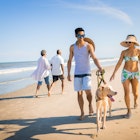
Aug 26, 2024 • 5 min read

Aug 26, 2024 • 21 min read

Aug 26, 2024 • 7 min read

Aug 24, 2024 • 7 min read
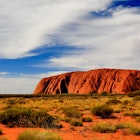
Aug 24, 2024 • 10 min read

IMAGES
COMMENTS
Our campervan trip through Europe confirmed something we already knew: that it's very easy to travel between European countries. A 100 kilometers drive can bring you to a different cultural and diverse community. Next to this, we had a few other learnings as well.
Route: Milan - Genoa - Cinque Terre - Pisa - Florence - Siena - Rome - Naples - Amalfi. Suggested duration: 3 weeks. Overall length: 1000 km (14 hours of driving) Budget: €€€. Italy is one of the best destinations to enjoy the European summer and one of my favorite European campervan routes.
Motorhome logbook (the REAL one- not a copy) If the vehicle is company-owned, hired or leased, you need a letter from the company stating their permission for the vehicle to go to Europe. MOT (date of) Driving licence- yes, your UK driving licence is legal in Europe but you might need an International Driving Permit.
As a bit of inspiration for your next adventure, we've put together this list of incredible motorhome routes across Europe. 1. Follow the Nibelungs through Germany. The Rheinische Sagenweg is one of Germany's most spectacular tourist routes. It follows the Rhine river, traversing around 580 km between Dusseldorf and Mainz.
Check out our motorhome touring guides for the most popular European countries, where you'll find information about driving, motorhome services, camp sites, wild camping spots, suggested routes and top destinations. Be inspired by stunning landscapes, mountains and coasts and incredible road trips.
6 Finland Up To Nordkapp. Image by Kosti Keistinen from Pixabay. A road beside a water body in Helsinki, Finland. One of Europe's most scenic caravan journeys is arguably traveling up through Finland to Norway. This route takes one through the boreal forests of Northern Europe and even through Santa's North Pole Village in Lapland.
The cost of hiring a motorhome in Europe varies depending on the size of the motorhome, rental duration, and season. On average, prices can range from €100 to over €200 per day. It is advisable to shop around for the best deals and consider off-peak season rentals for lower prices. 16.
Europe Motorhome Tour & Itinerary. No time to research? Don't worry, we've got that sorted! Grab our three month flexible itinerary, packed with campsites, attractions and insider tips. Go on tour knowing your route and stops are planned, with driving routes and campsites marked out for you on your interactive map.
These are dedicated campervan parking spaces with varying facilities. Run by the town municipalities or privately owned they are often free or cost a couple of Euros per night. Some of the privately owned ones can have more facilities and will charge more (Up to £20 depending on where they are located.) Campsites.
Consider wild camping in Norway, one of the most beautiful, and legal, places to camp freely in your motorhome. 6. Route Napoleon, France. Opened in 1932, the Napoleon road trip itinerary follows the route taken by Napoléon Bonaparte in 1815 on his march from Elba to Grenoble.
German Half-Timbered House Road. The German Half-Timbered House Road - one of the most important holiday and cultural routes. This was established in 1990 when the establishment of the first regional route "Von Hann. Münden to Alsfeld "was launched. Austrian Romantic Road.
Europe by campervan: Travel Routes and Itineraries Where to begin your road trip, or hire your campervan or motorhome . Where you begin your trip and collect your camper is up to you. It makes sense to fly in to Europe and collect your camper from the same place. The exciting thing is that the best place to begin depends on your itinerary.
The first step to touring Europe in a motorhome is to prepare your van. It's essential to ensure your vehicle is in tip-top condition and adequately prepared. Here's a comprehensive guide to getting your van road-ready for the big adventure: 1. Mechanical Check-Up.
Prioritising slow travel. Staying at Aires or free parking. If you plan on hiring out a campervan from Quirky Campers, your insurance and breakdown cover is included in the cost - all you need to pay for is the EU Travel Pack (£30.00) plus fuel, travel insurance and the cost of the ferry/train over to Europe.
Apart from this, you would need to have a budget for your cooking needs. In many camper vans, propane tanks are used. The food and similar expenses differ in each European country. Food prices in Southern Europe are typically lower than in the North. Roads and Routes. To save money, most campers in Europe take back roads.
Day 2 - Colmar, France. The second day saw us driving 3.5hrs south into France to visit the old Alsacian towns of Colmar and Eguisheim. We spent the first part of the afternoon exploring Little Venice, before heading to explore more of the Old Town and stopping for some lunch.
From Norway all the way down to Sicily, there plenty of routes to choose from so here are our Top Ten European Campervan Road trip Routes. With so much to explore, you'd be silly not to make the most of our holiday campervan hire . 1. Switzerland, France, Italy. Starting in Geneva, you will head south along the shoreline and enter into France.
Road trip to Europe itinerary overview. Day 1: Outbound channel crossing from Dover, UK to Calais, France and drive to Antwerp, Belgium. Day 2: Antwerp, Belgium to Linz am Rhein, Germany. Day 3: Linz am Rhein to Bacharach, Germany. Day 4: Bacharach to Rothenburg ob der Tauber, Germany. Day 5: Rothenburg ob der Tauber to Ladenburg, Germany.
Route. Day 1: Start your trip in Cologne and drive down to Düsseldorf, a city known for its art scene. The city is dotted with art museums, so be sure to pay a visit to a couple of them! If you're in the mood for a beer or a cup of coffee, then be sure to visit Burgplatz. Driving time: 43 minutes.
Margrietroute. The Margrietroute takes you along the most beautiful of Denmark. The route was named after Queen Margrethe II of Denmark's favorite flower, the daisy. The route is therefore clearly marked with the flower. The route is 3700 kilometers long in total. There is no fixed starting and finishing point.
European Motorhome Tours Start Page. Guided RV tours through Europe and the British Isles. Truely experience the diverse European cultures, history and food. 24 years of fun filled tours and great memories! Travel with the experts with hundreds of happy customers. Let us make your overseas motorhome adventure the trip of a lifetime!
Stop 1: Zürich - 1-2 Nights. If you're renting based on my campervan tips post, you have a variety of entry options. If you're coming from Munich as we did, Zürich is a great first stop. Zürich has a special place in my heart. It was the first place in Switzerland I ever visited while backpacking Europe in 2010.
What was your route? After flying into Zurich, we started our journey with a delicious breakfast at Babu's Bakery and Coffeehouse before picking up our campervan and heading to Lucerne. Arriving in the historic city center, we explored medieval architecture, exploring iconic landmarks like the Chapel Bridge and the Water Tower.
Route. Day 1: Start your trip in Cologne and drive down to Düsseldorf, a city known for its art scene. The city is dotted with art museums, so be sure to pay a visit to a couple of them! If you're in the mood for a beer or a cup of coffee, then be sure to visit Burgplatz. Driving time: 43 minutes.